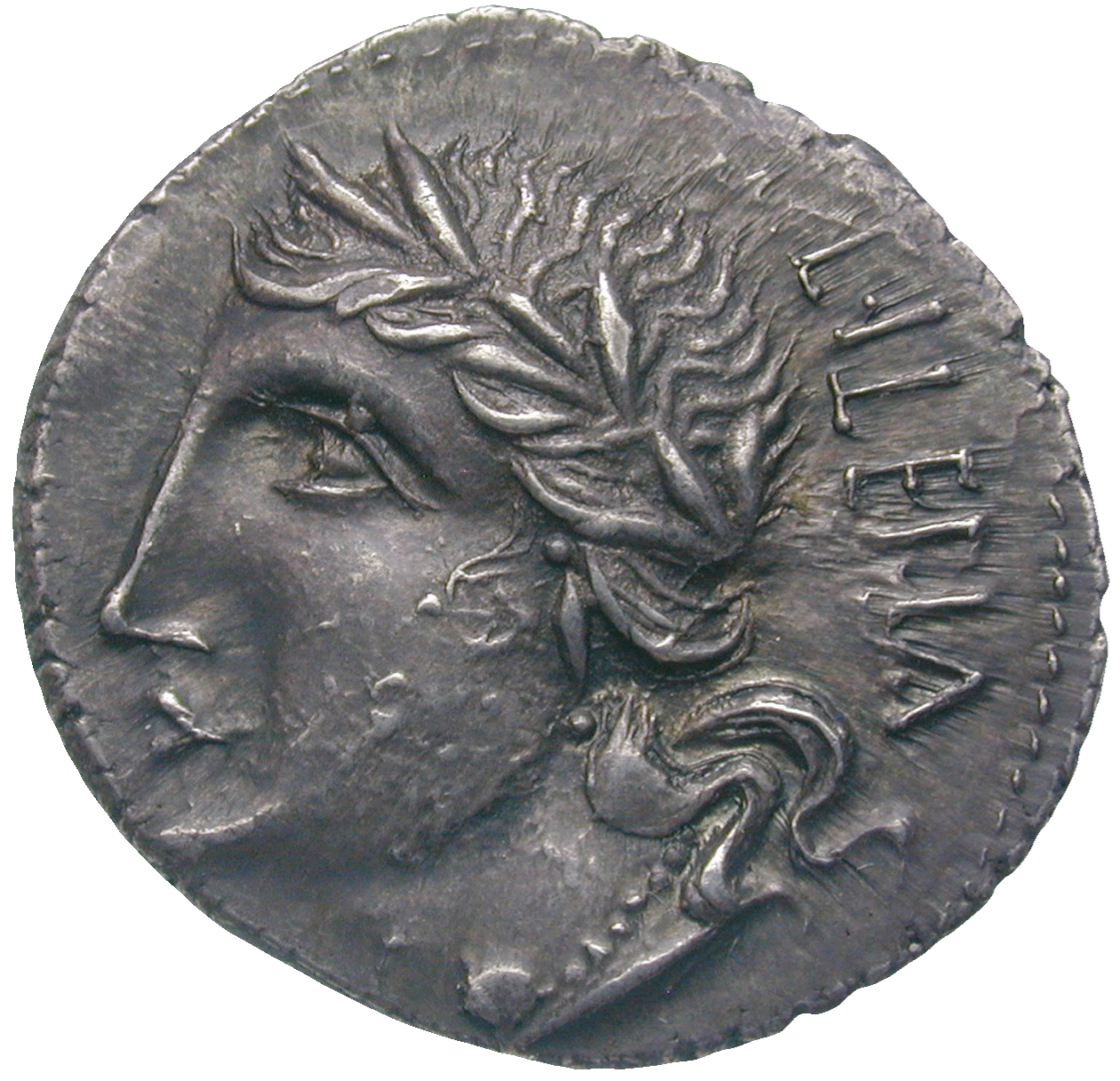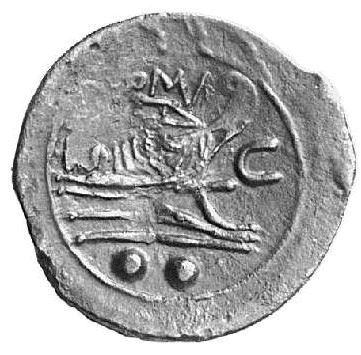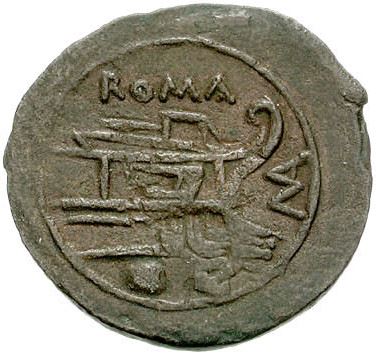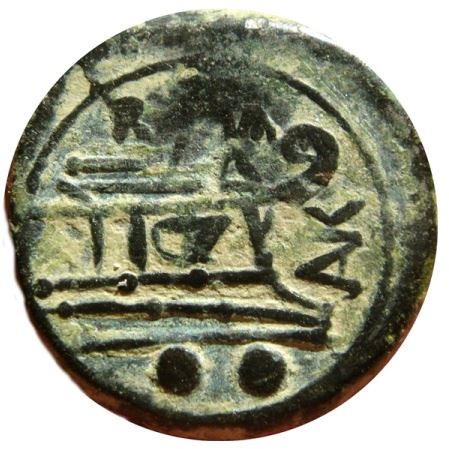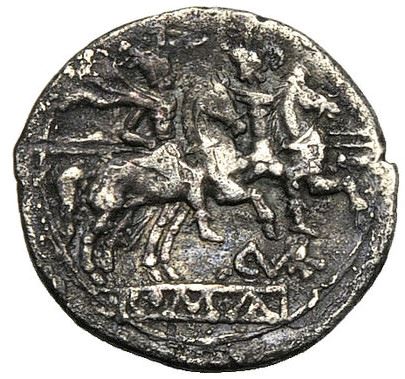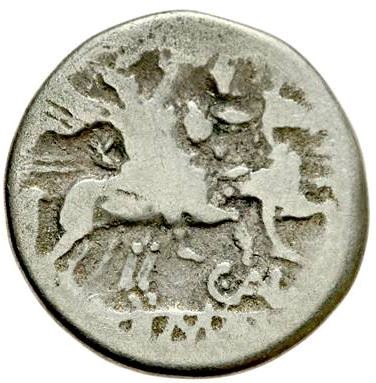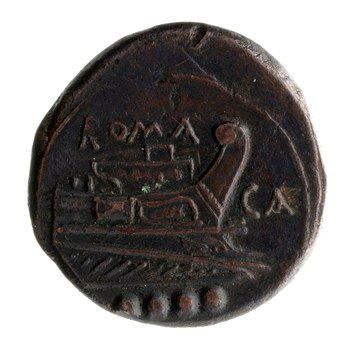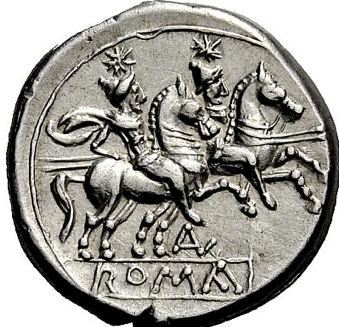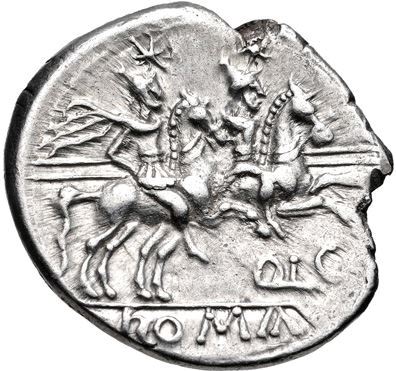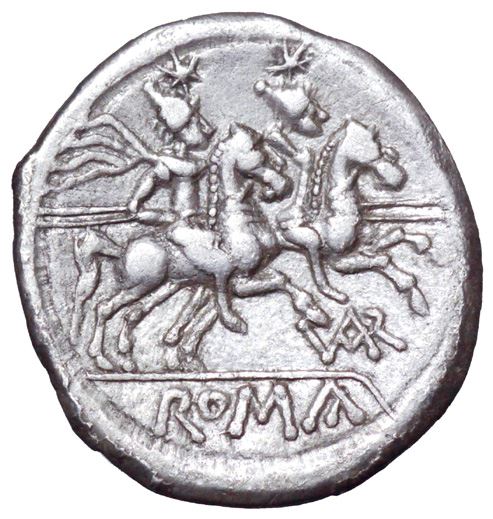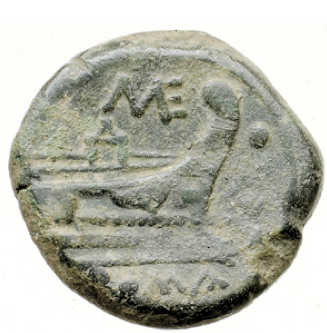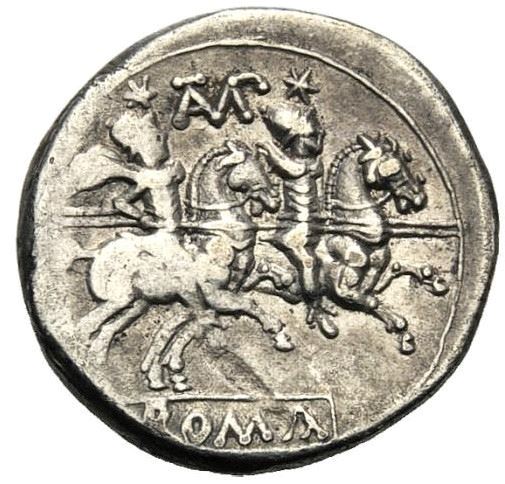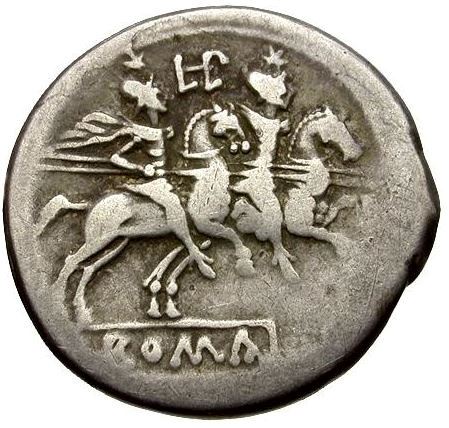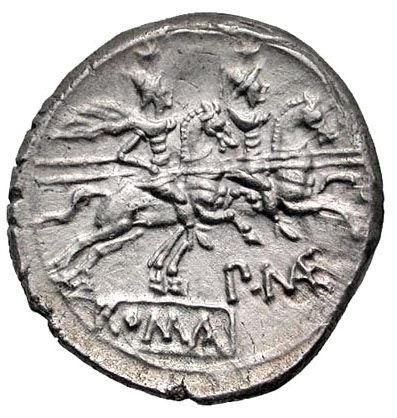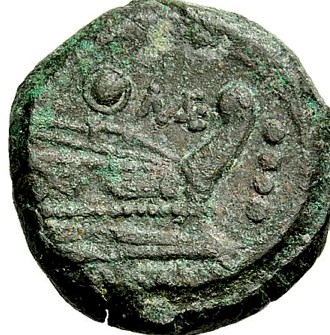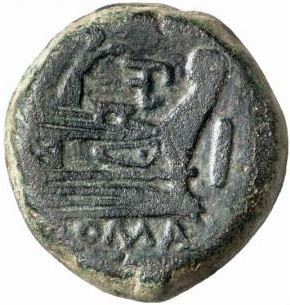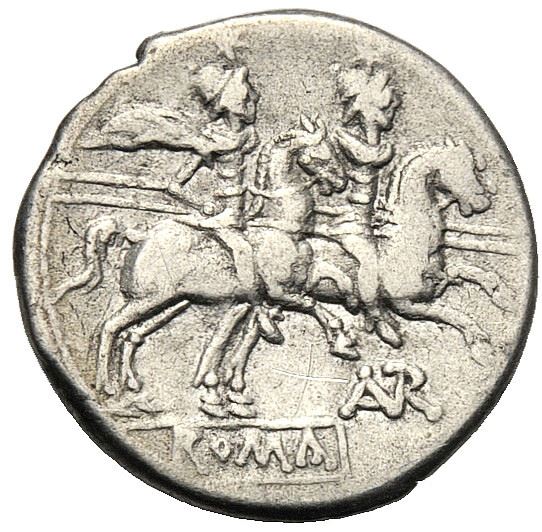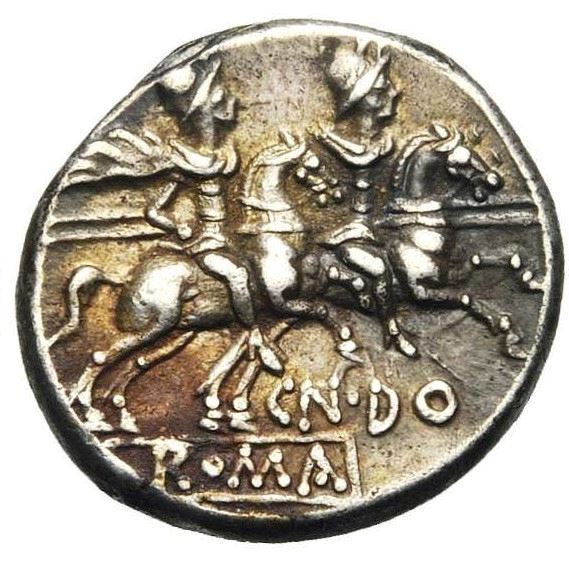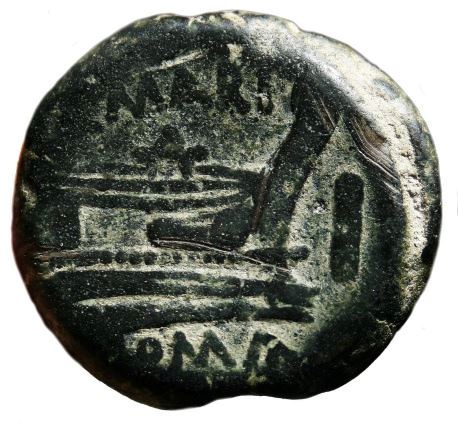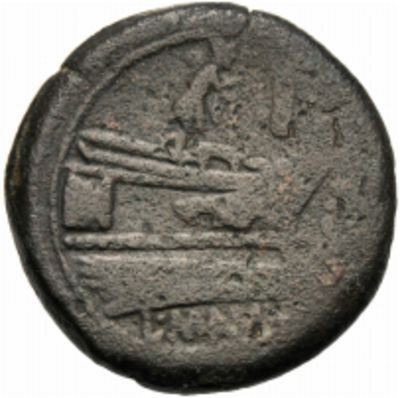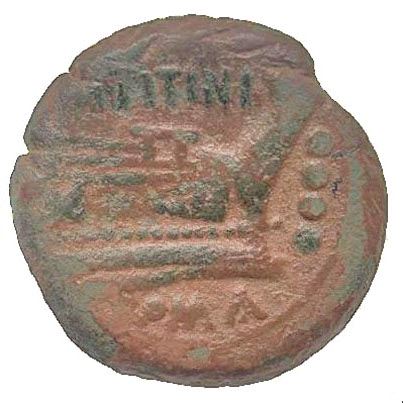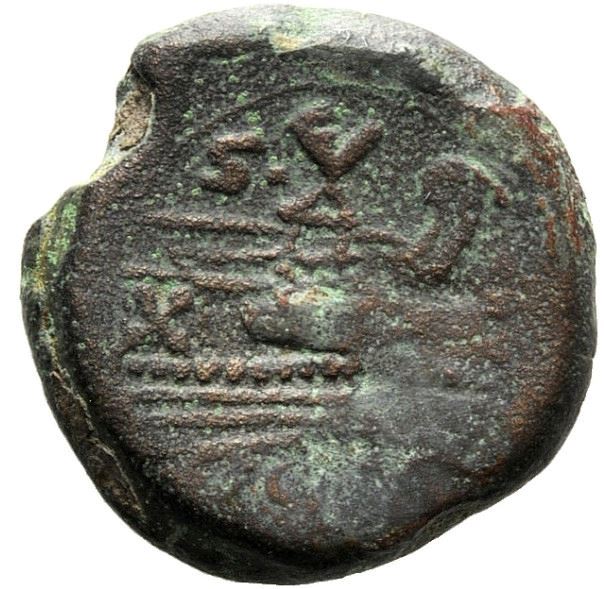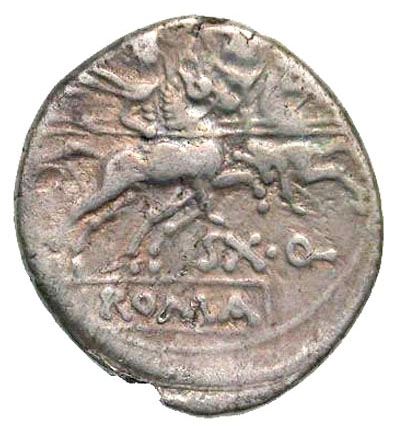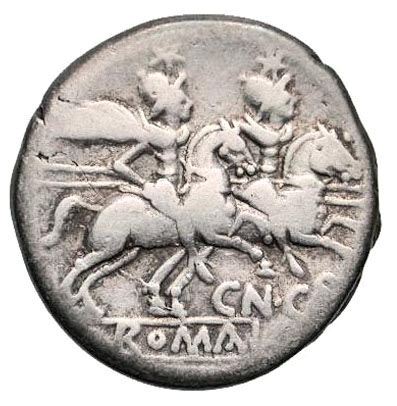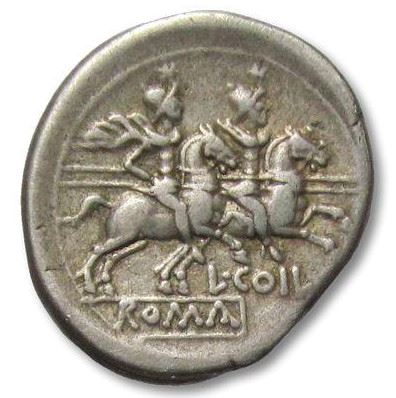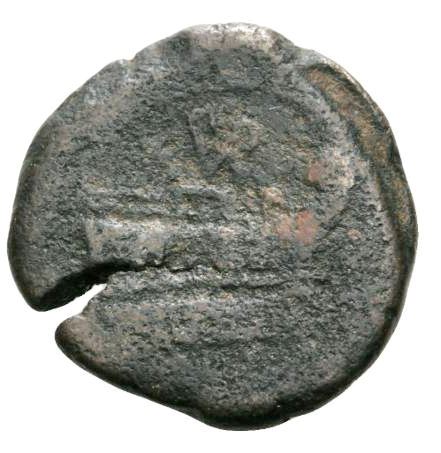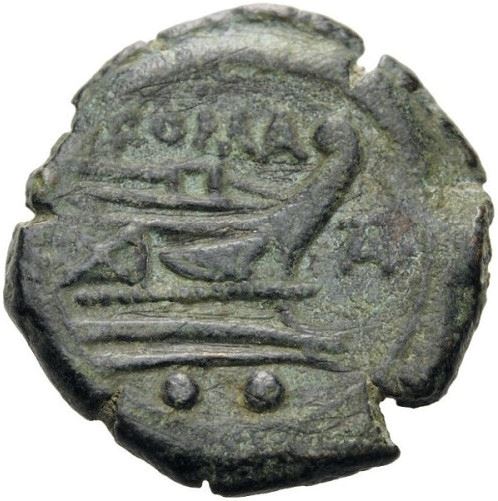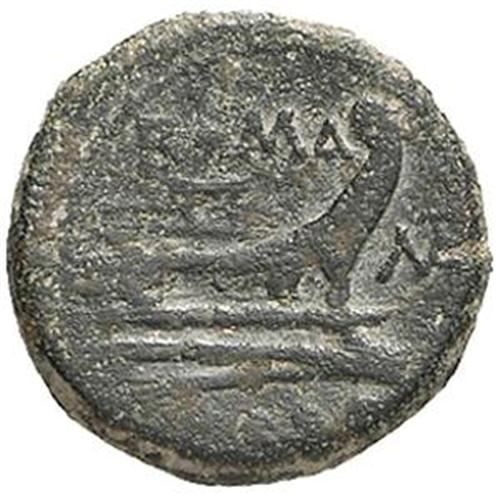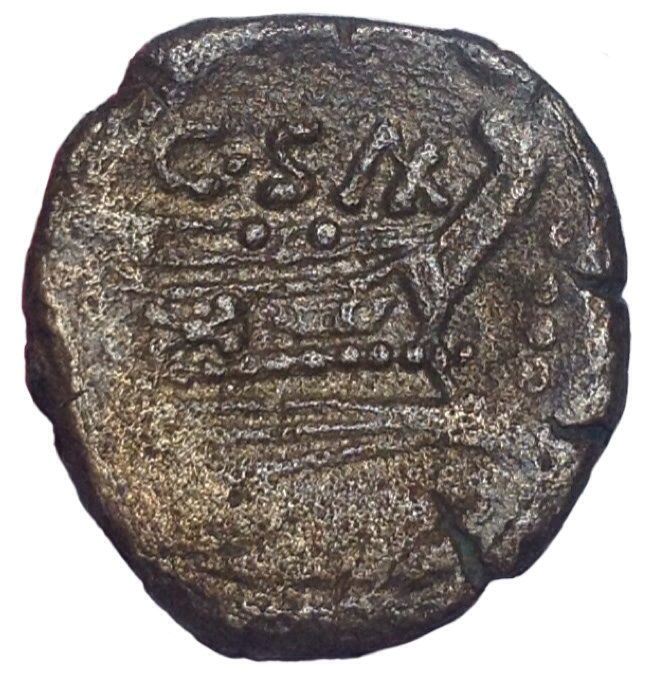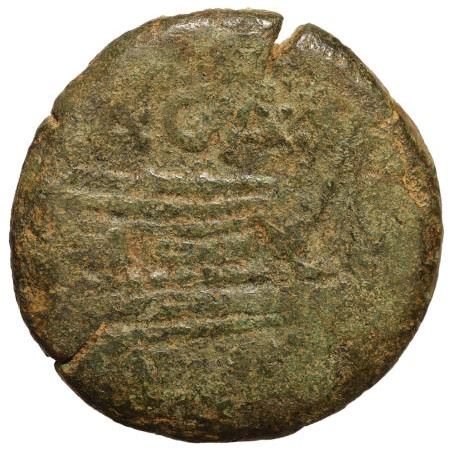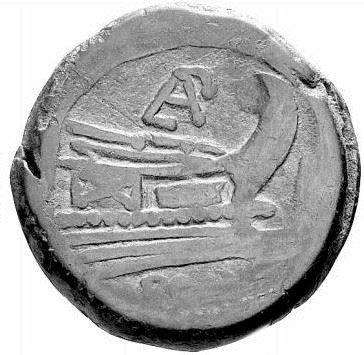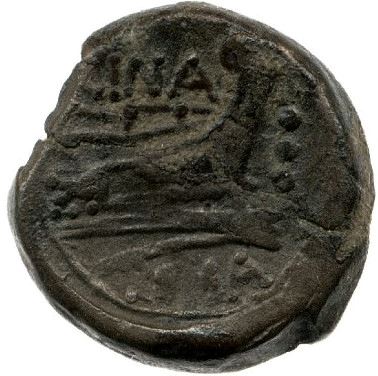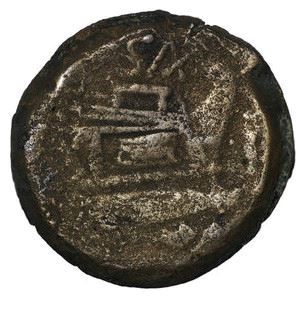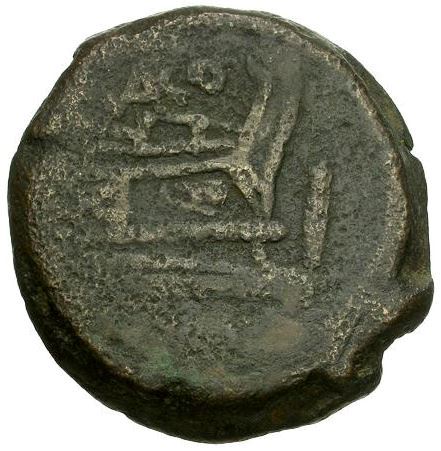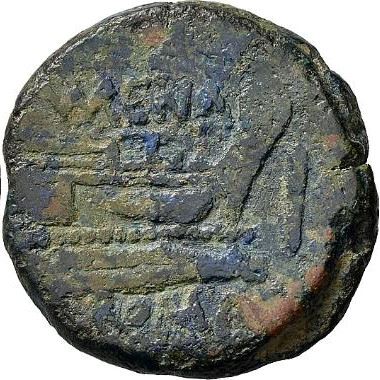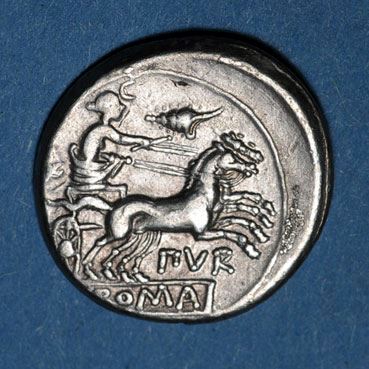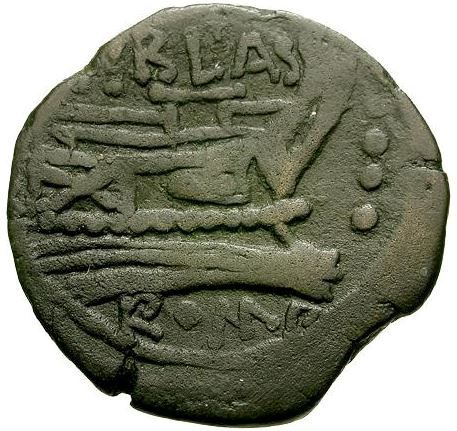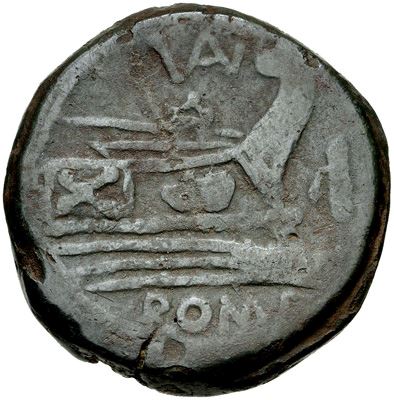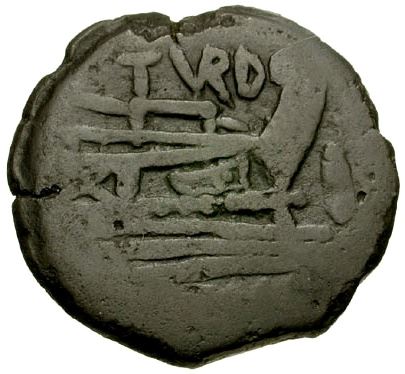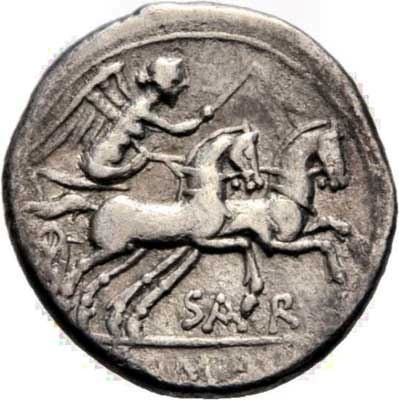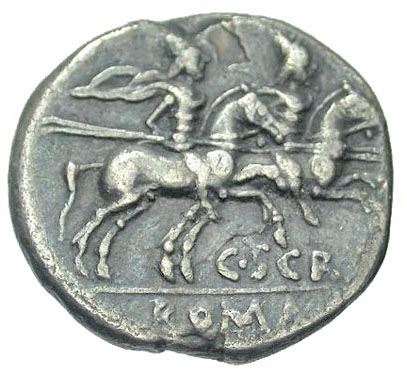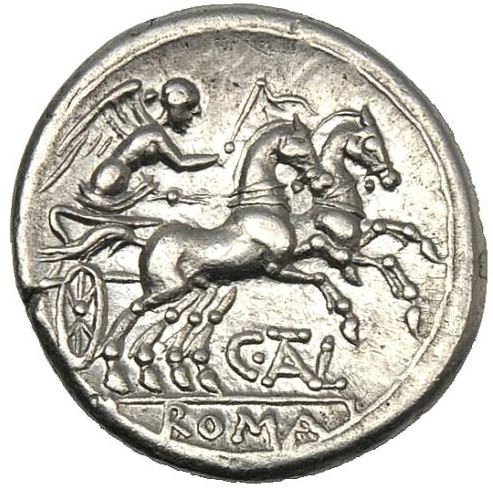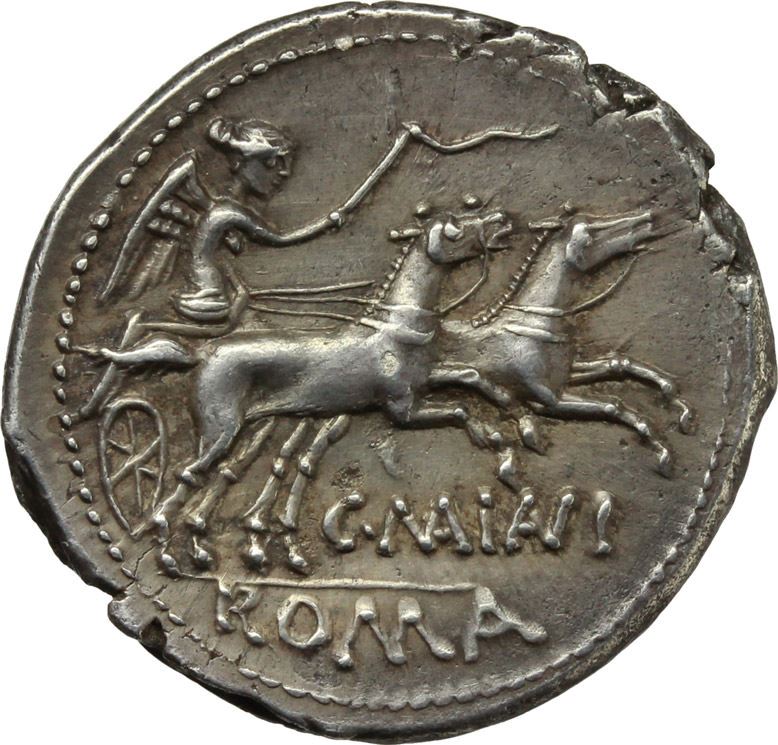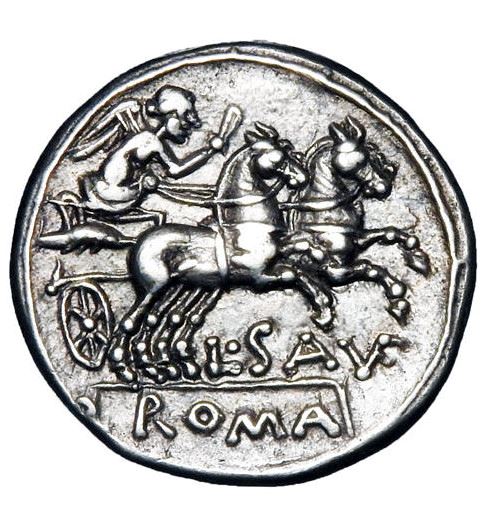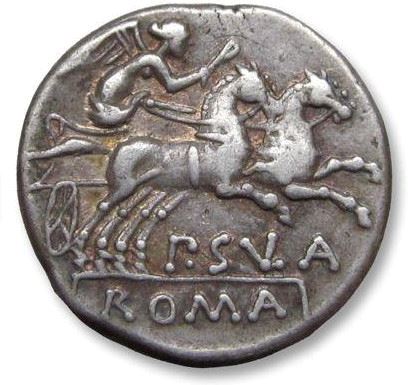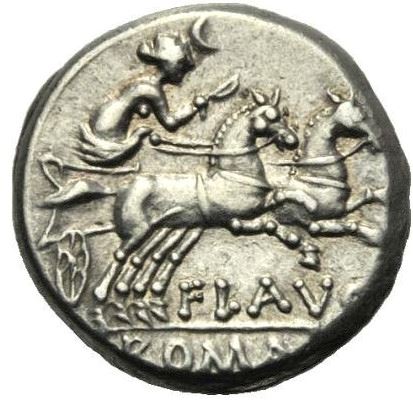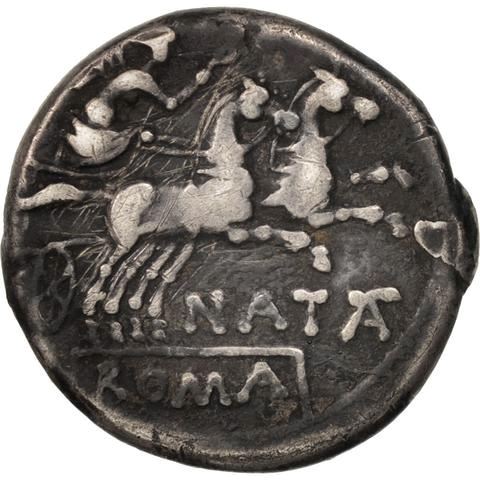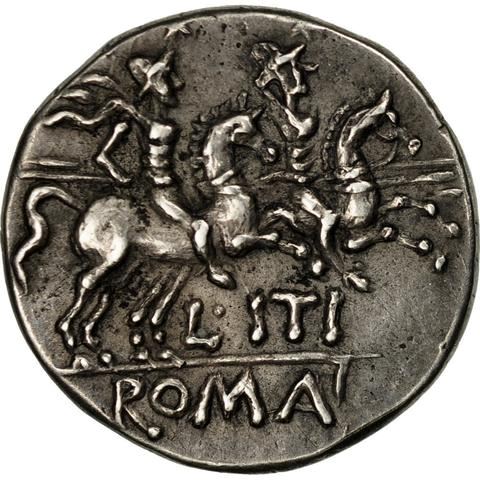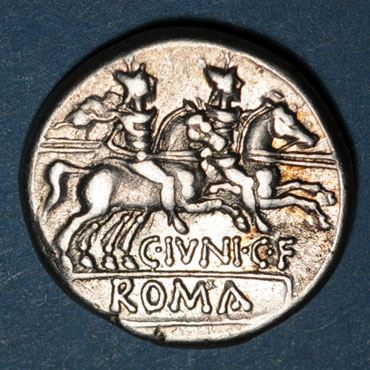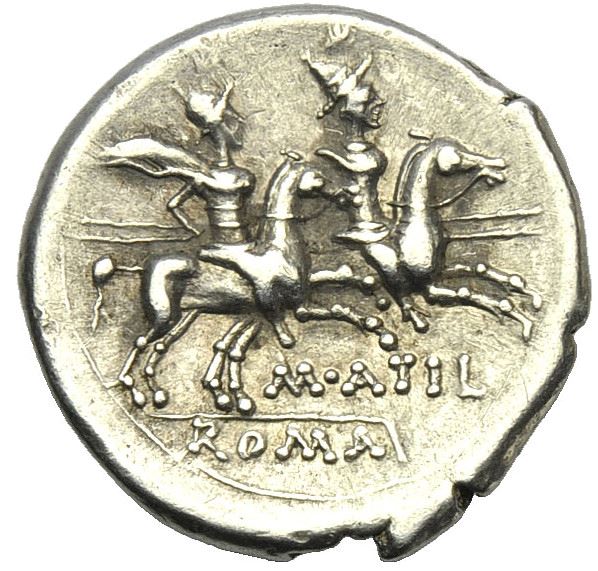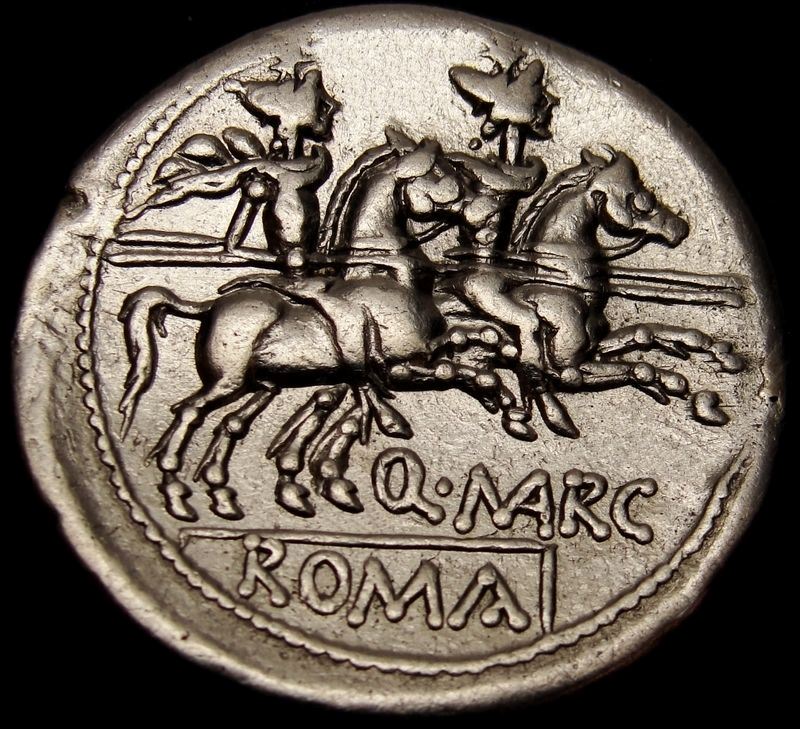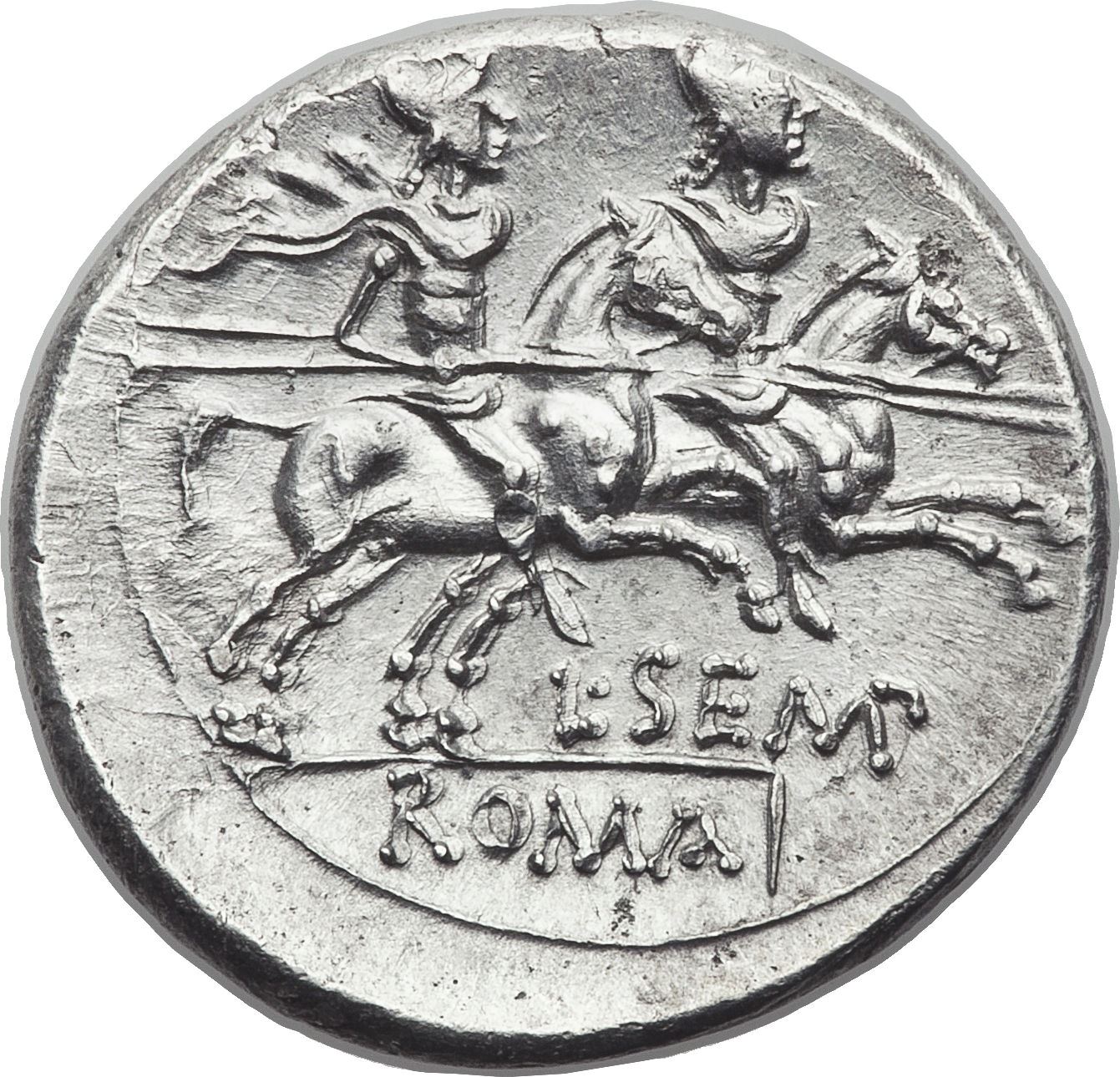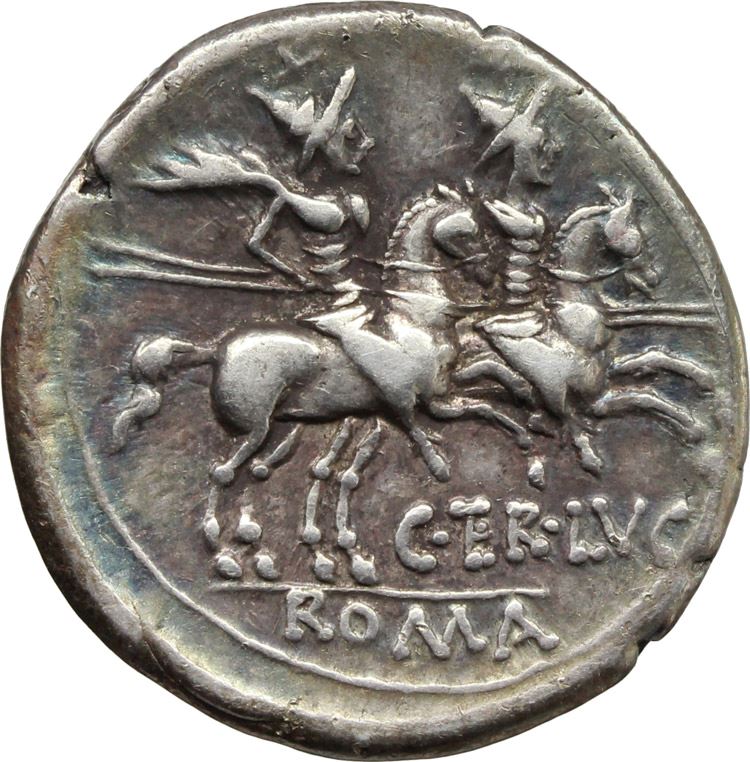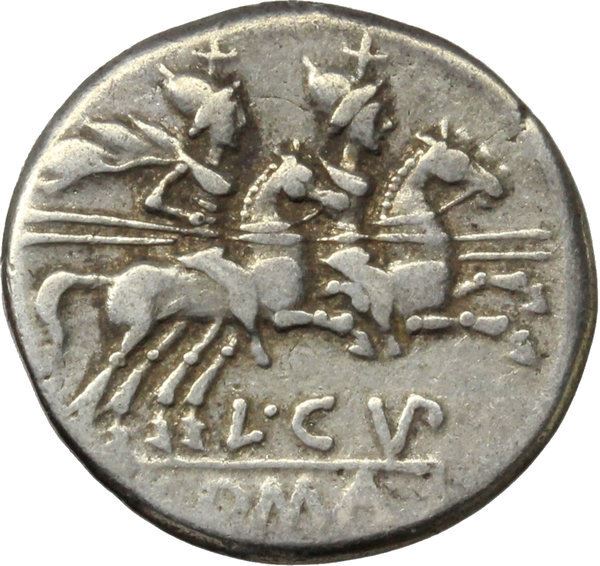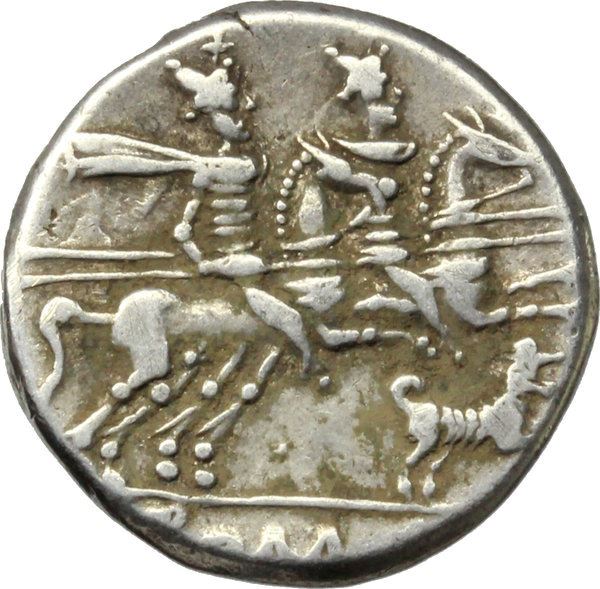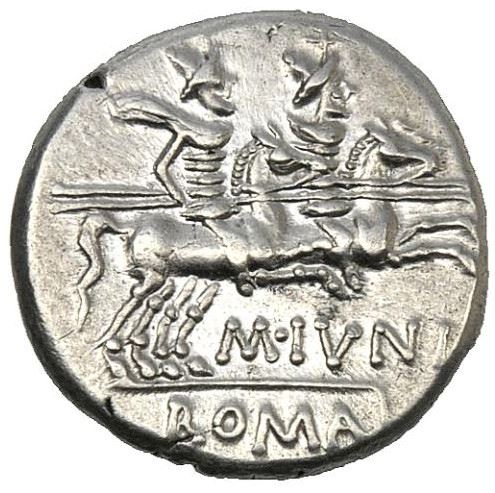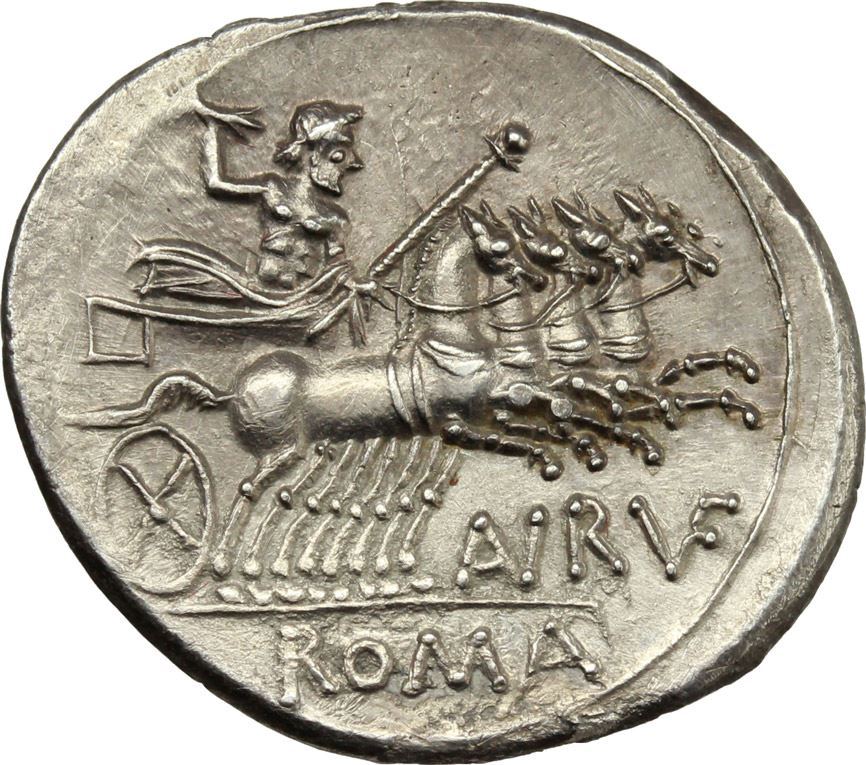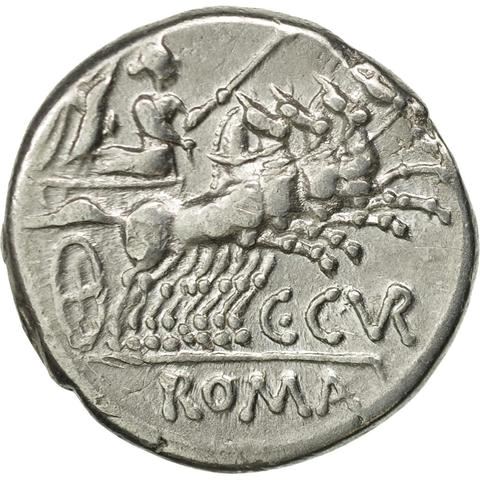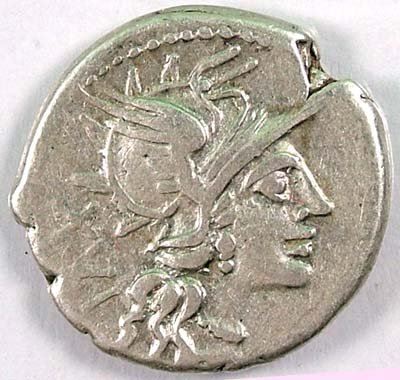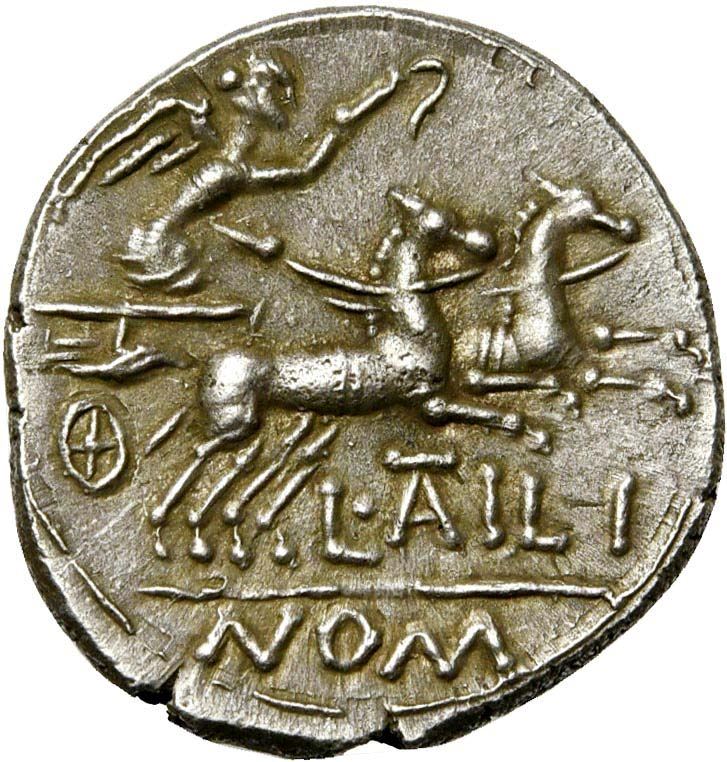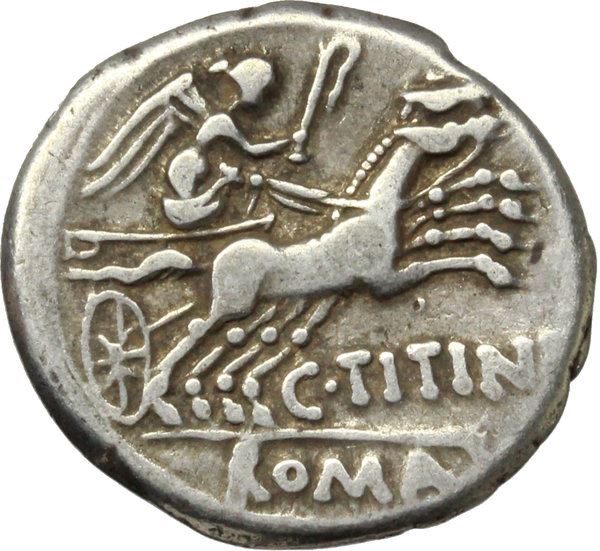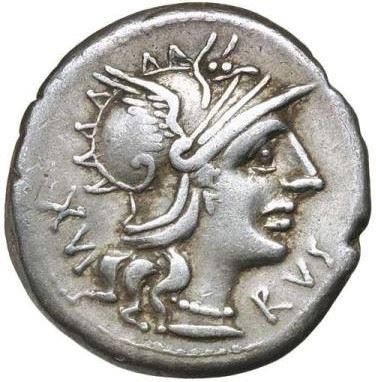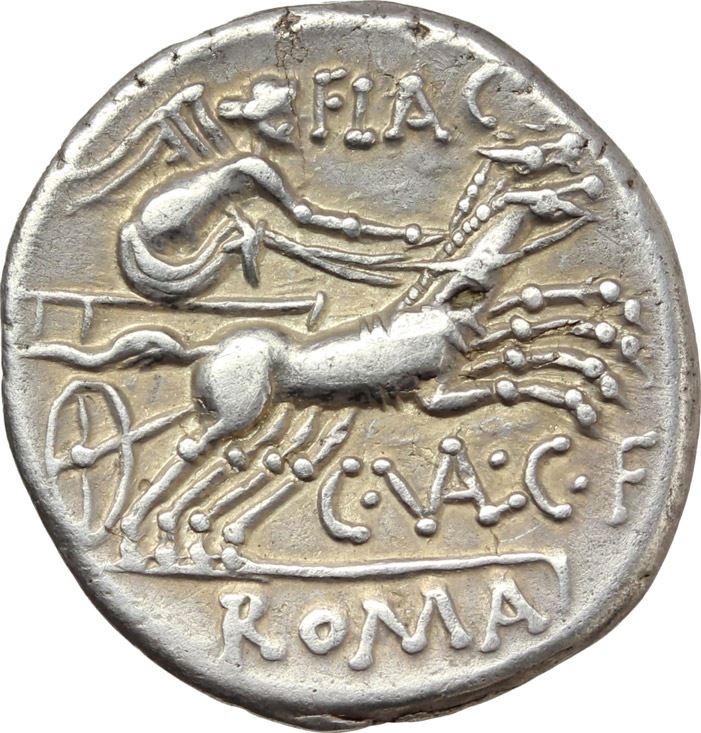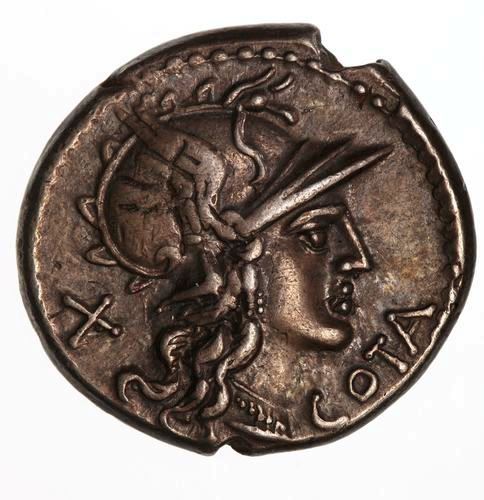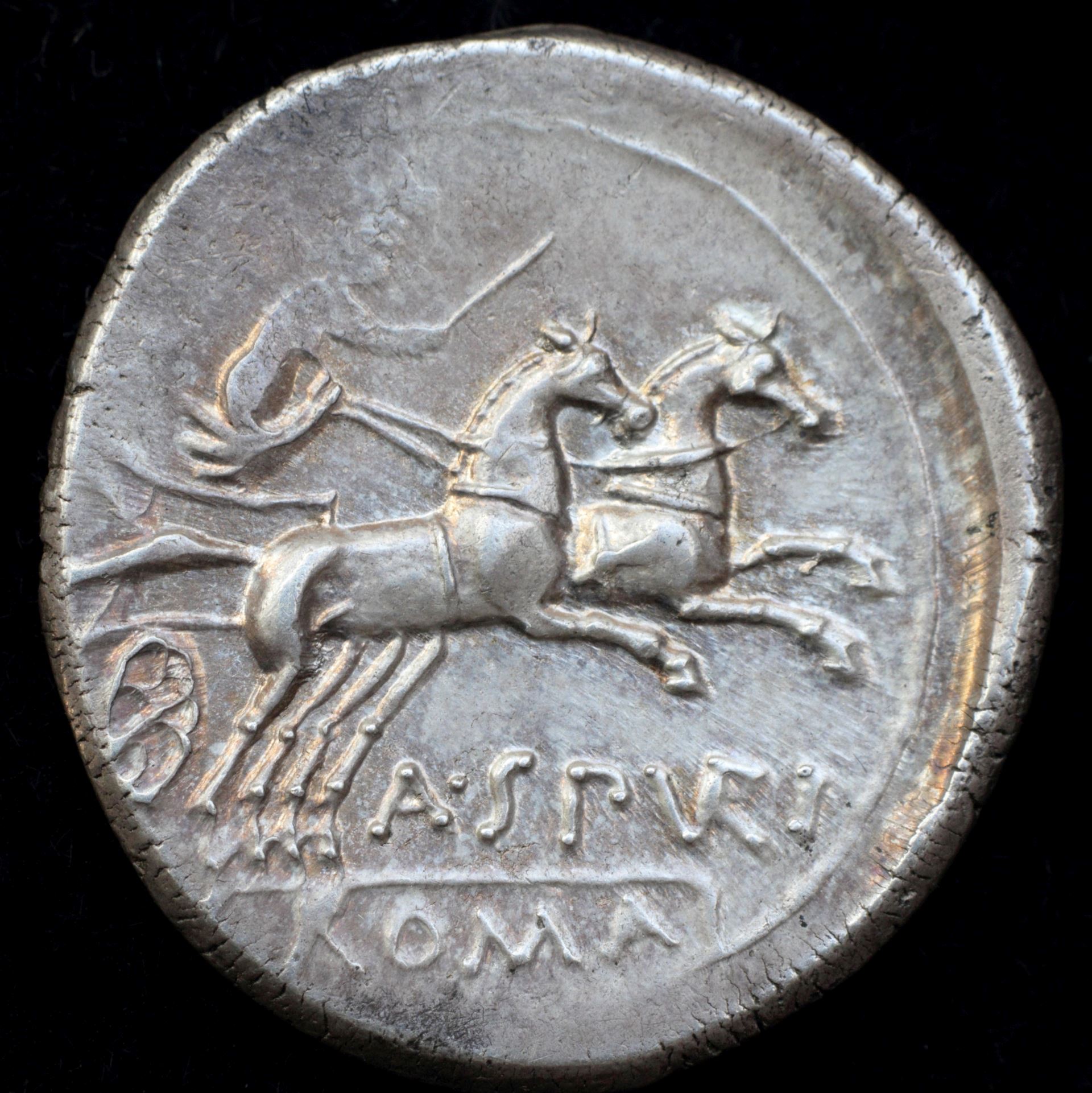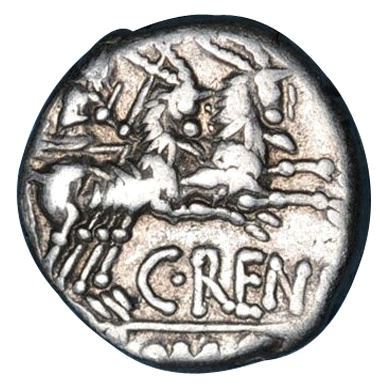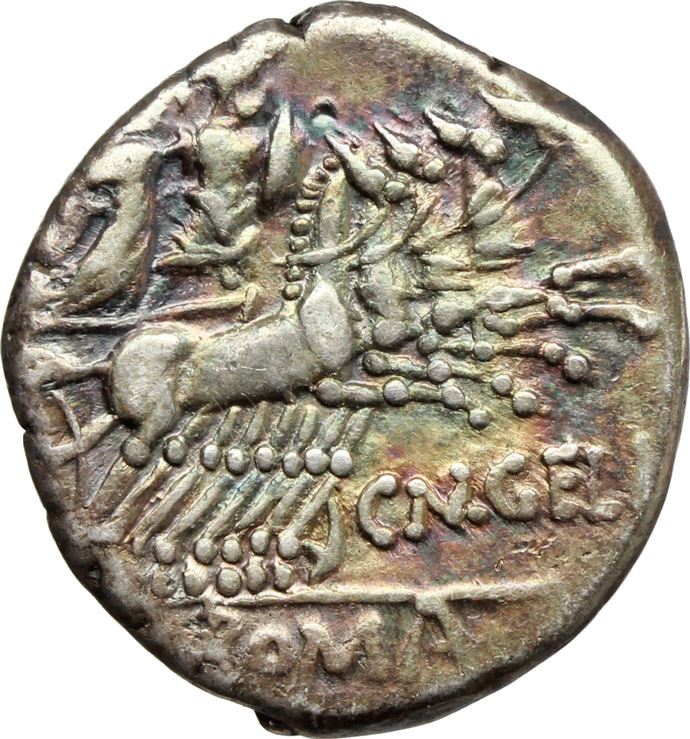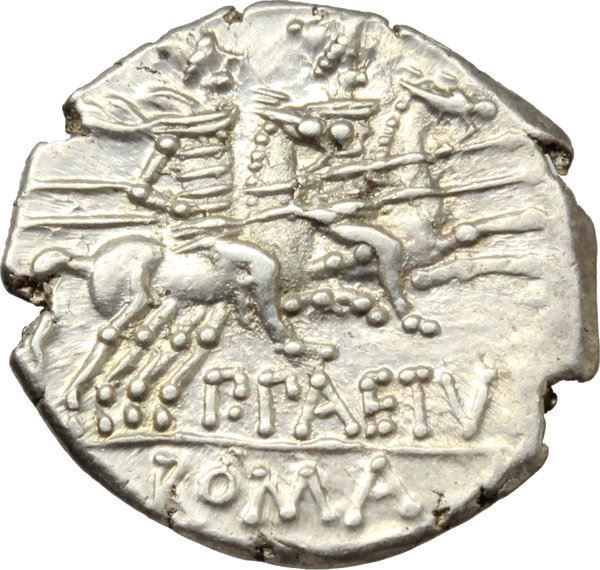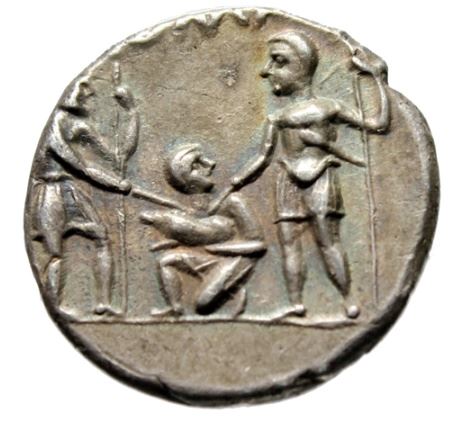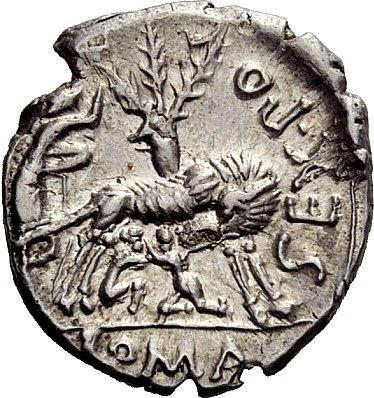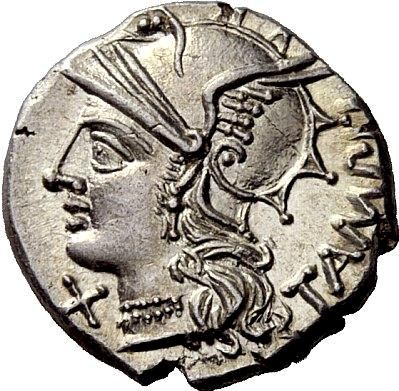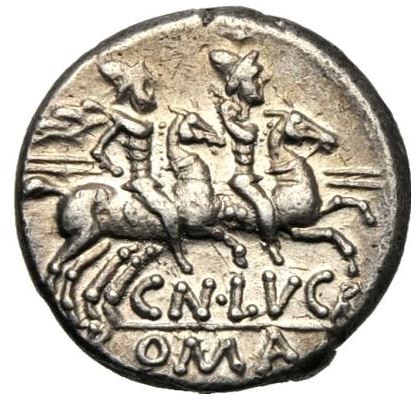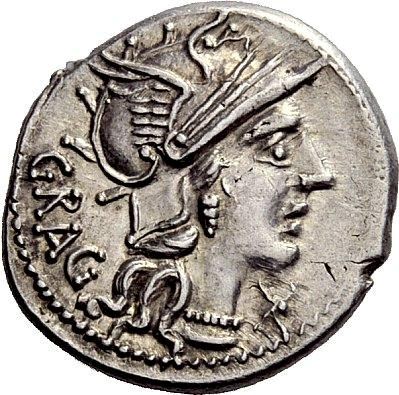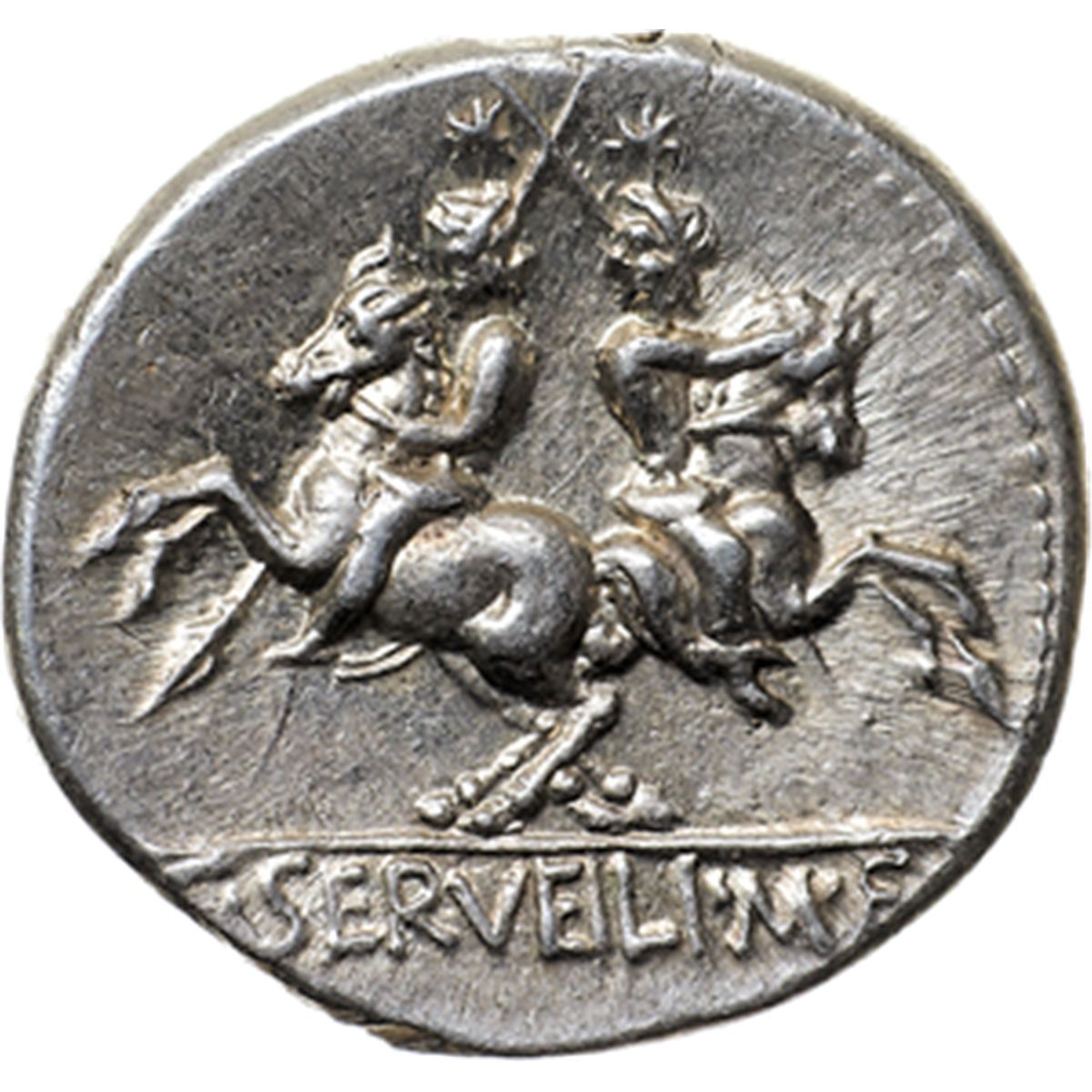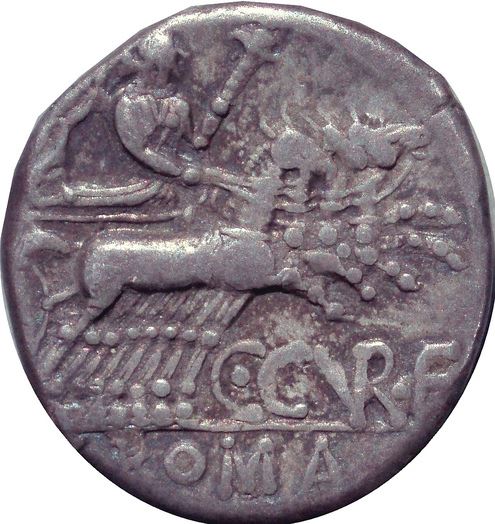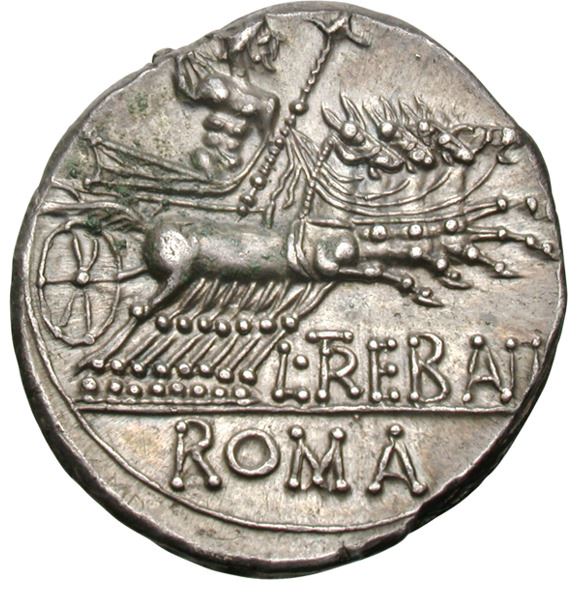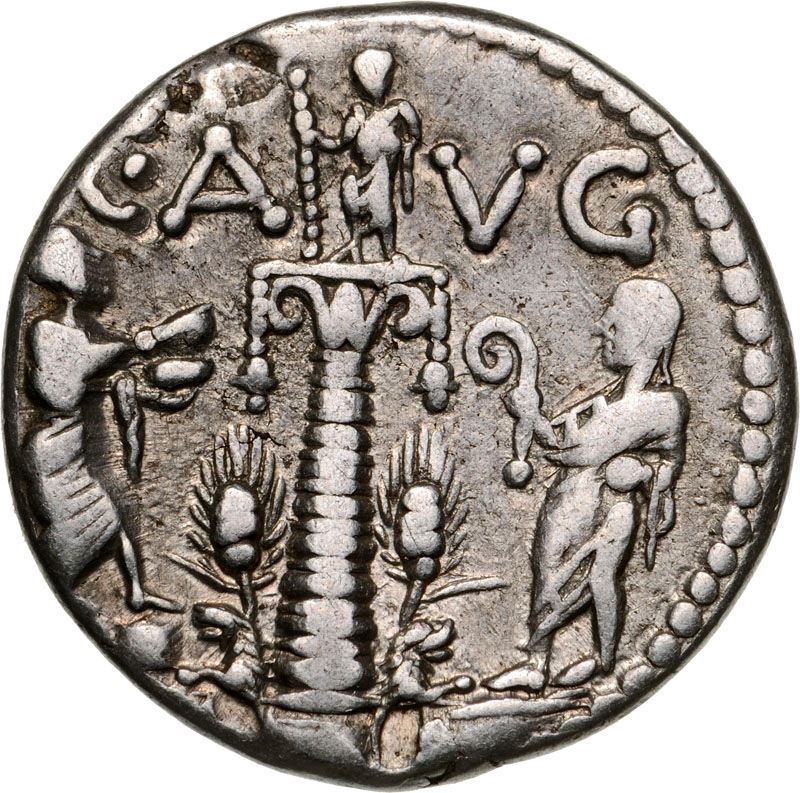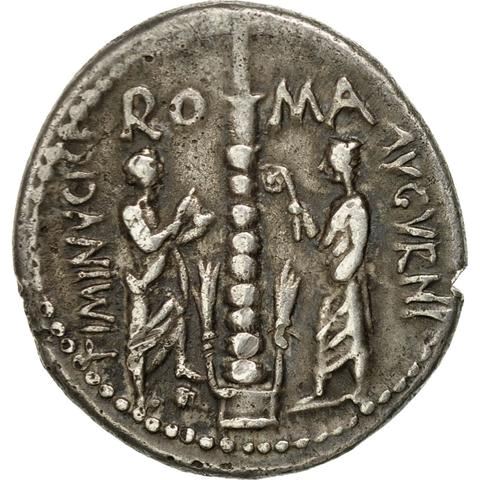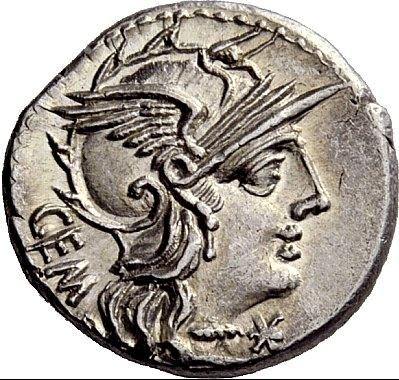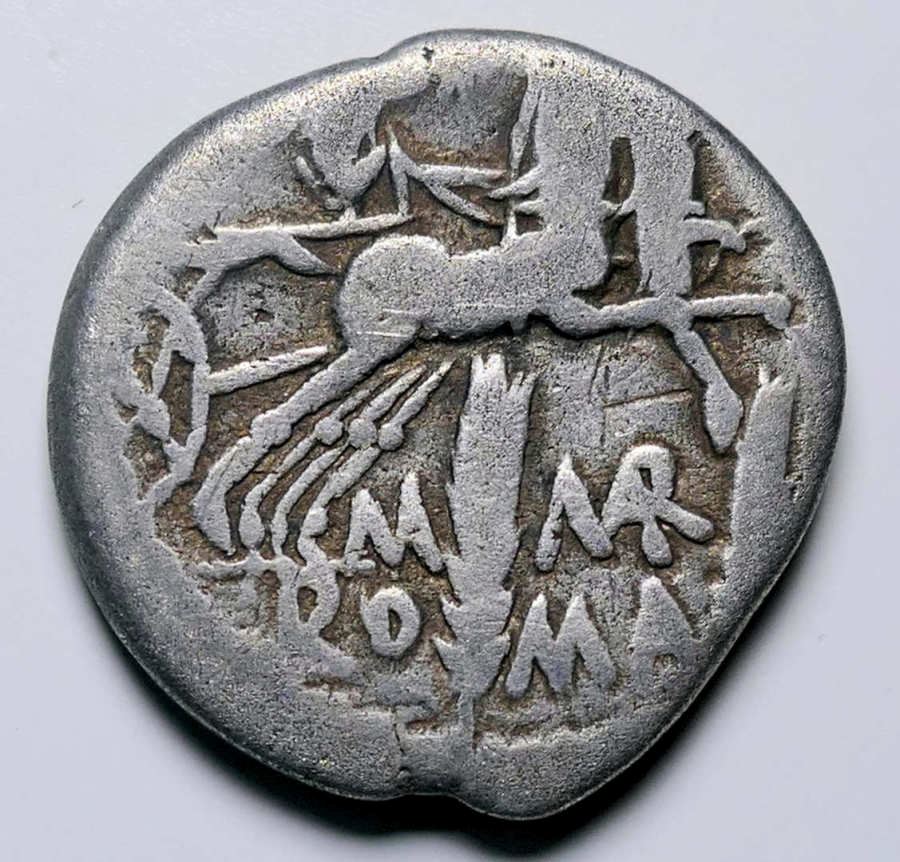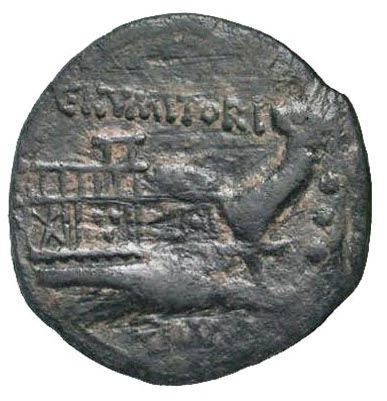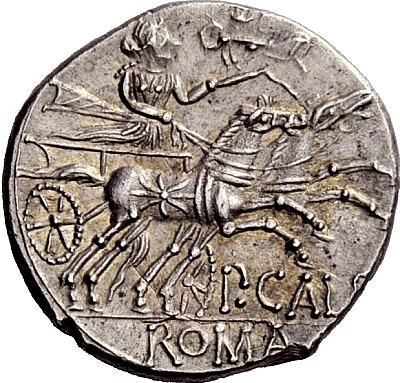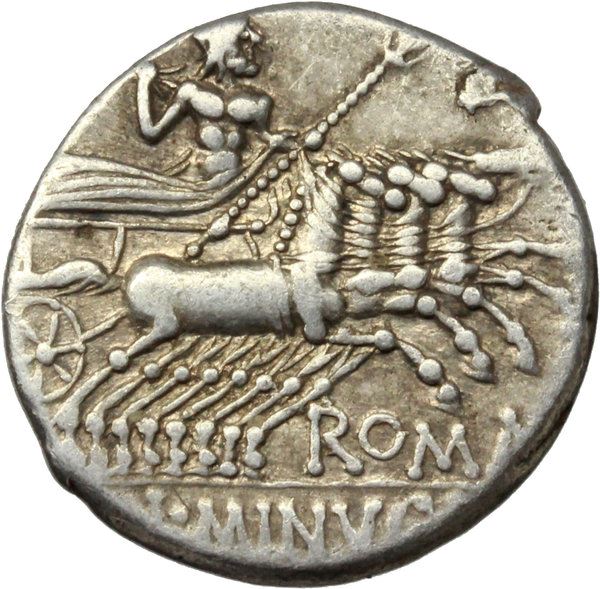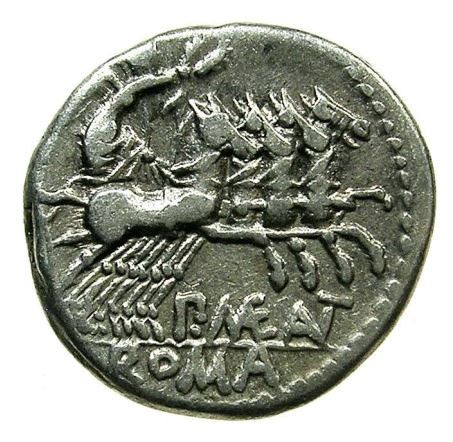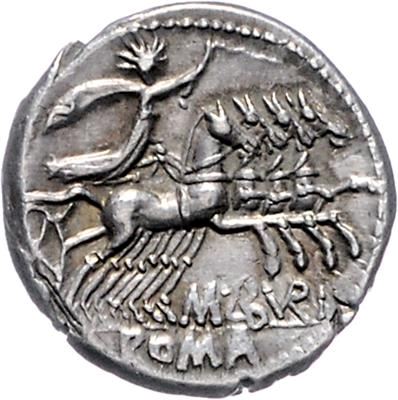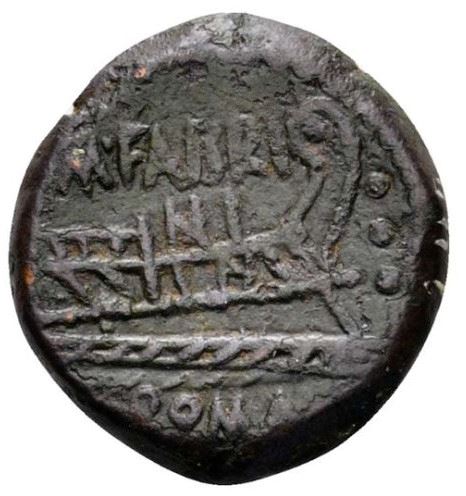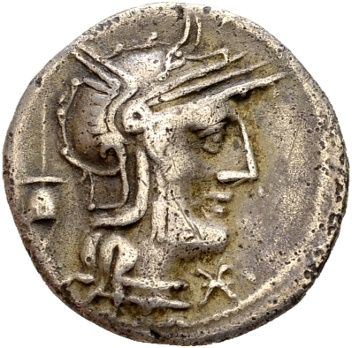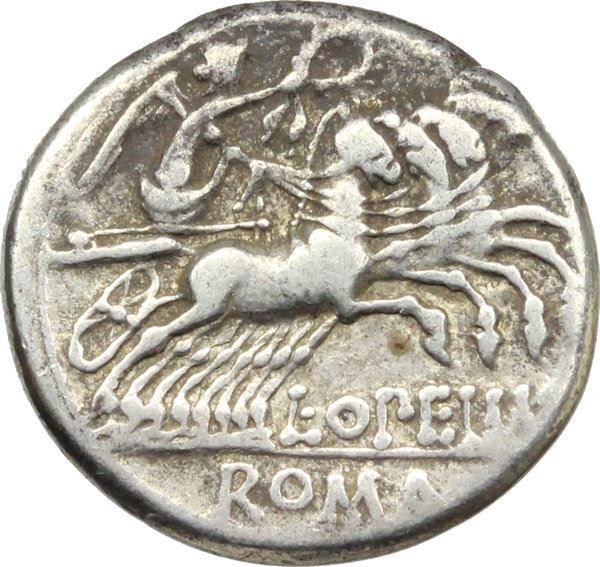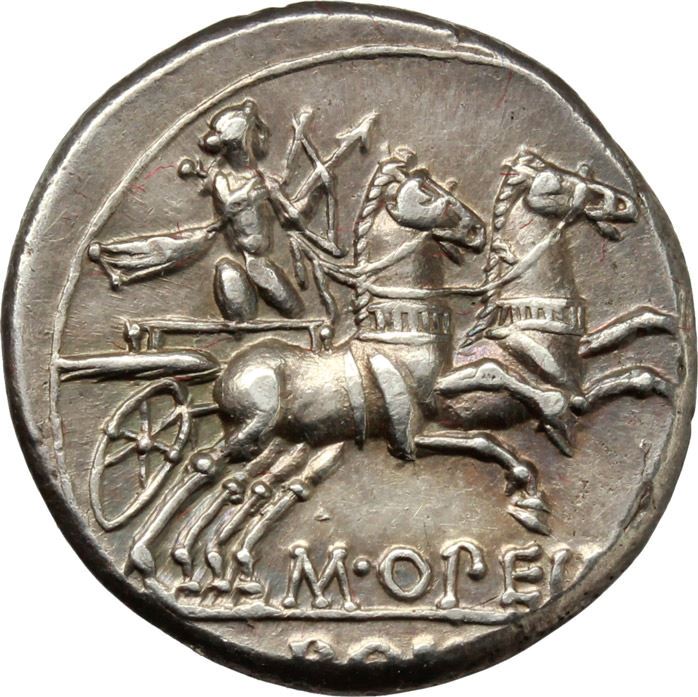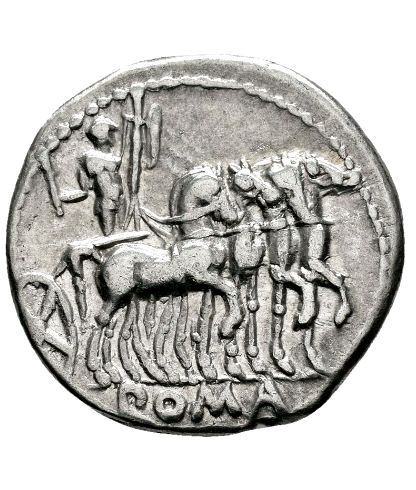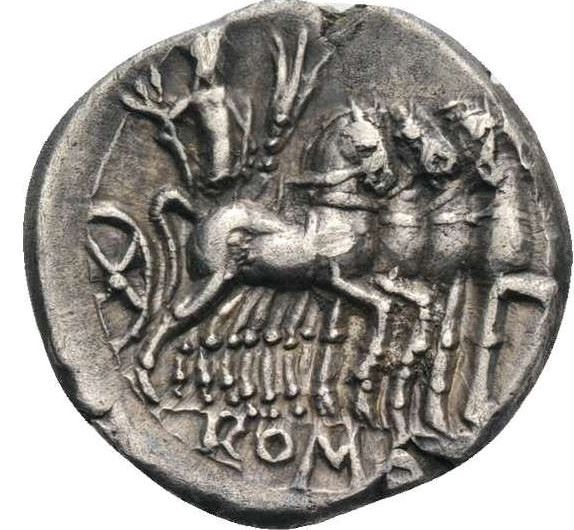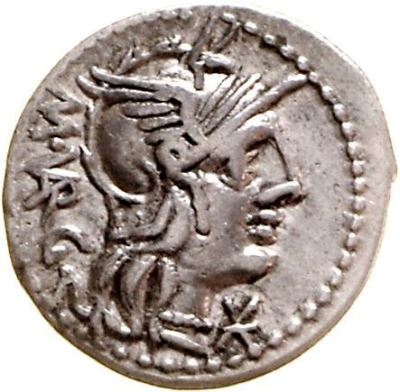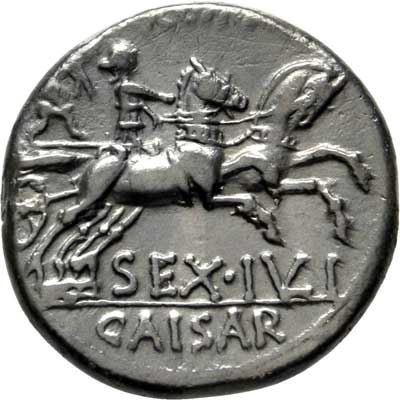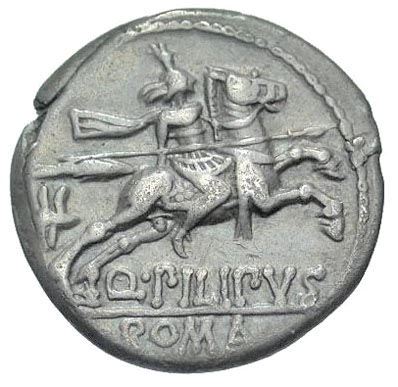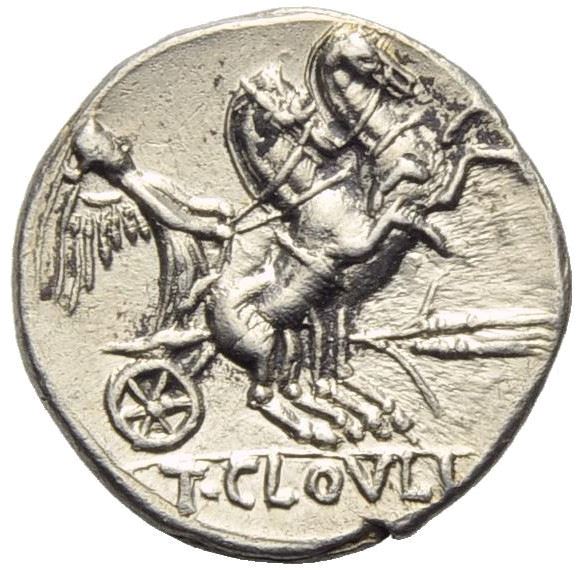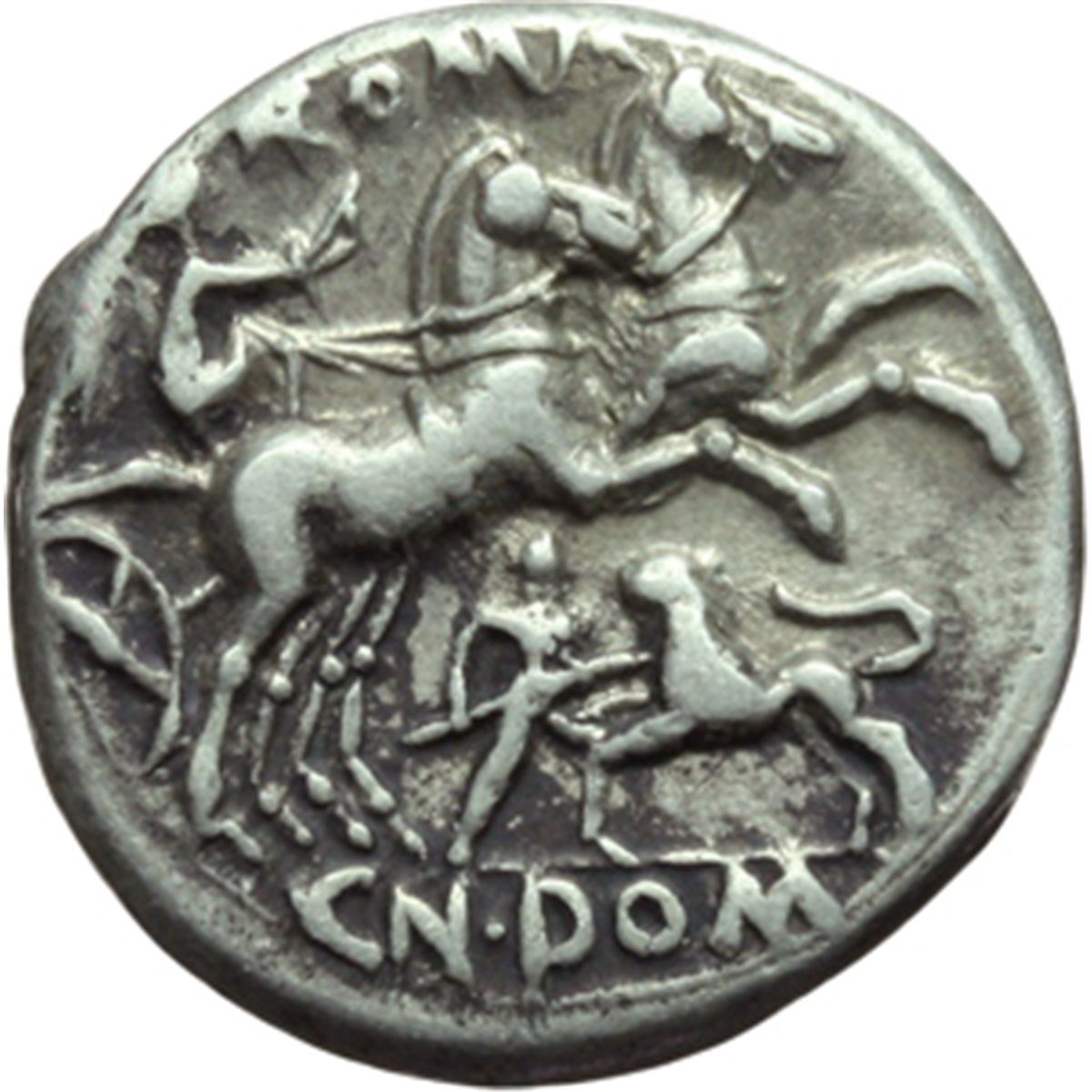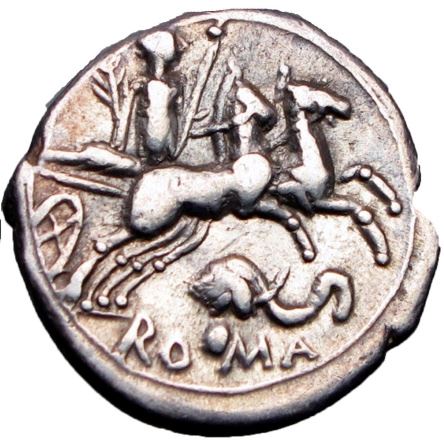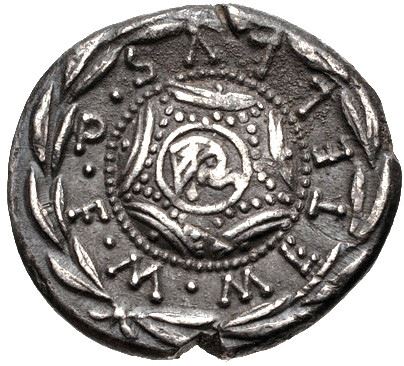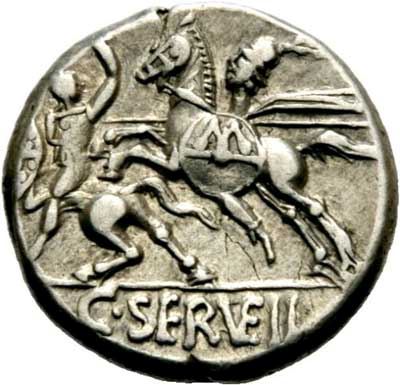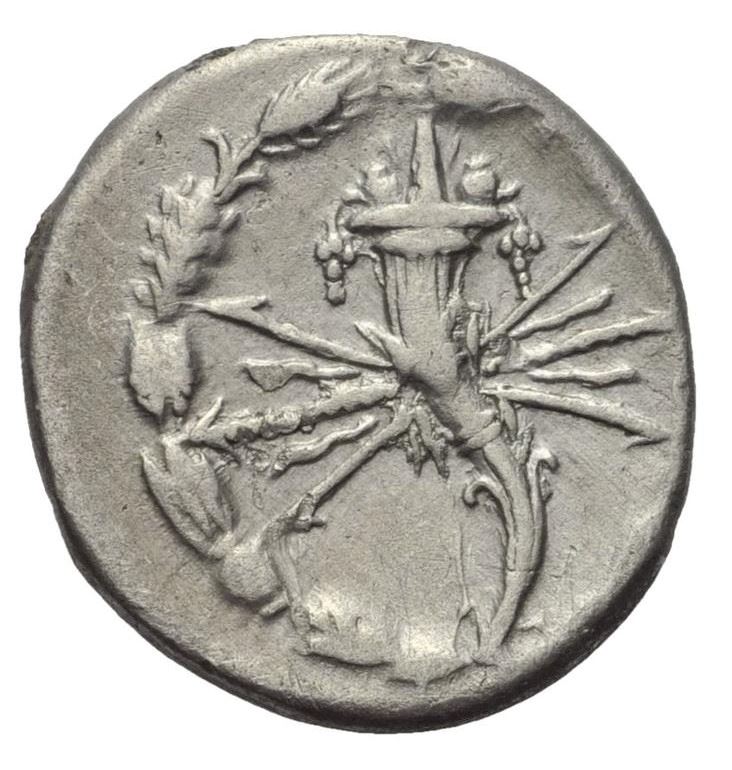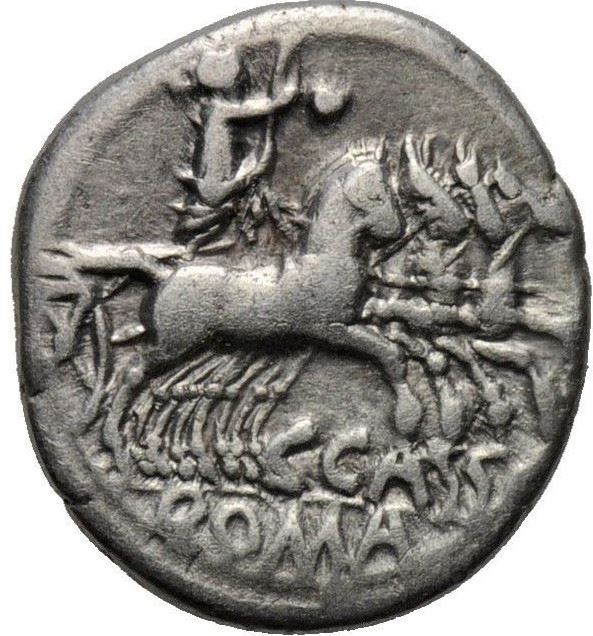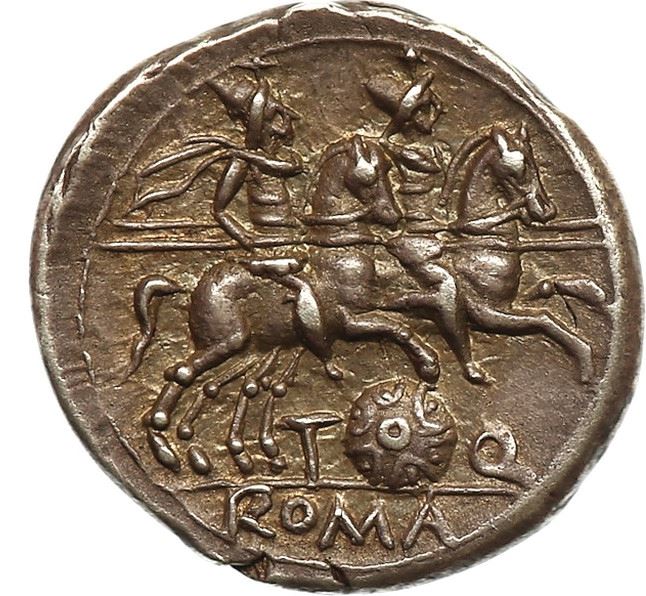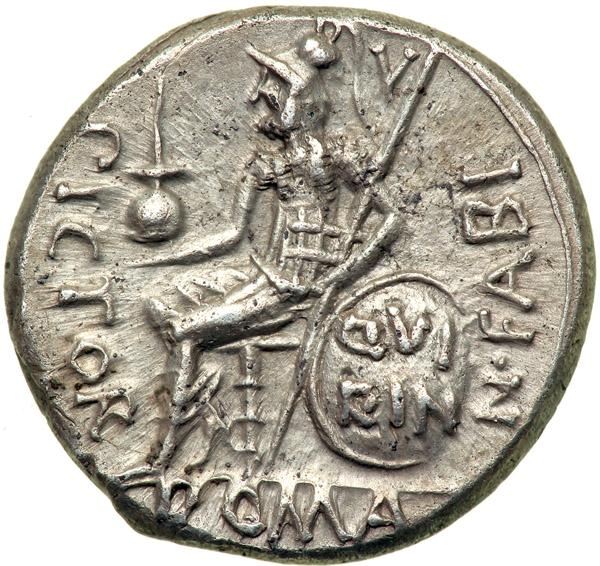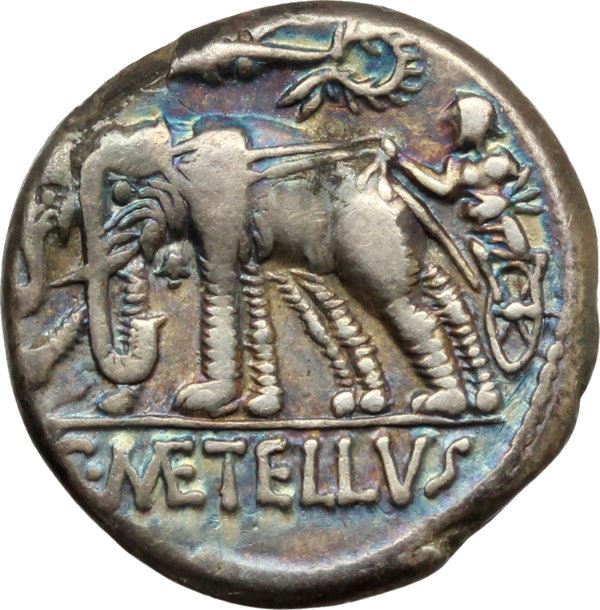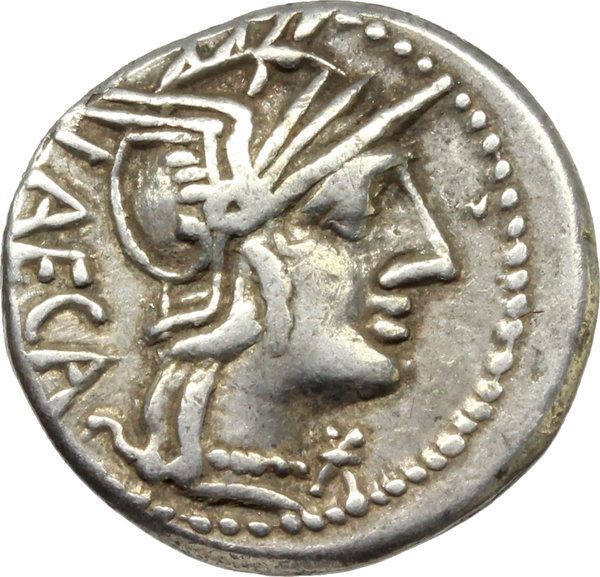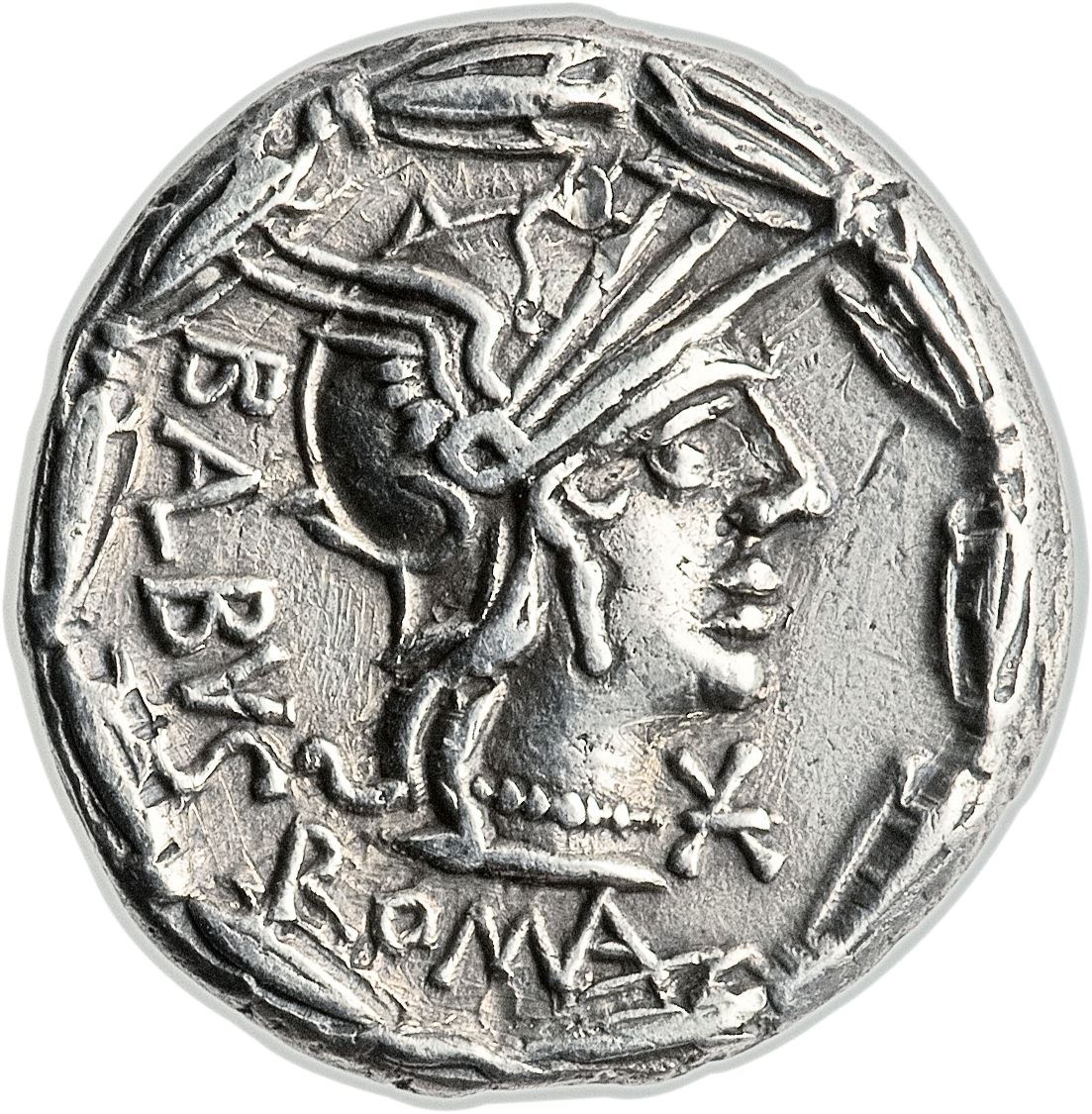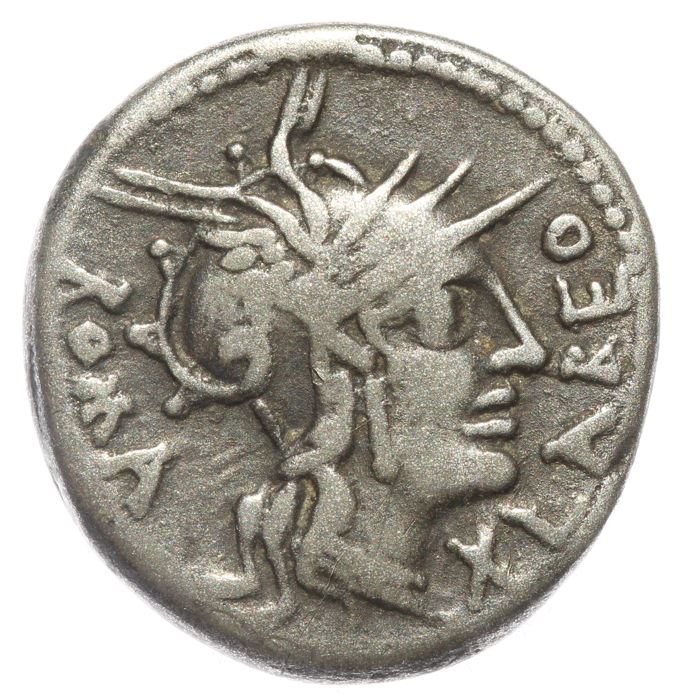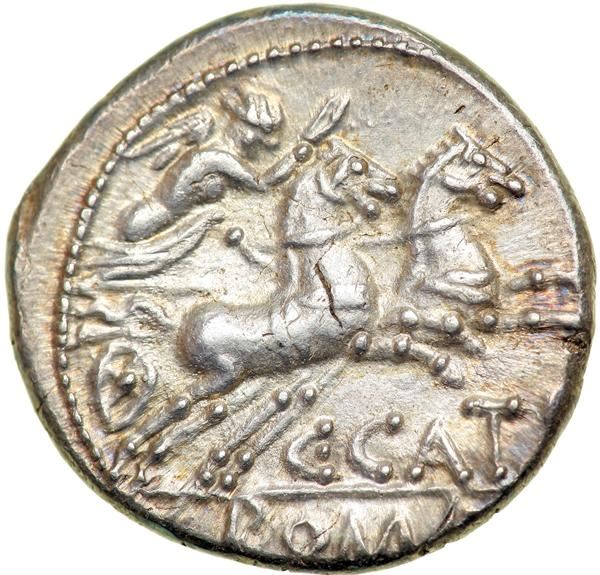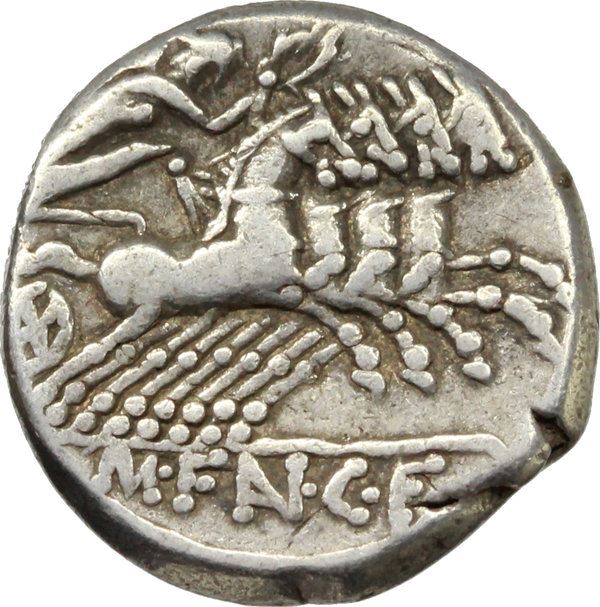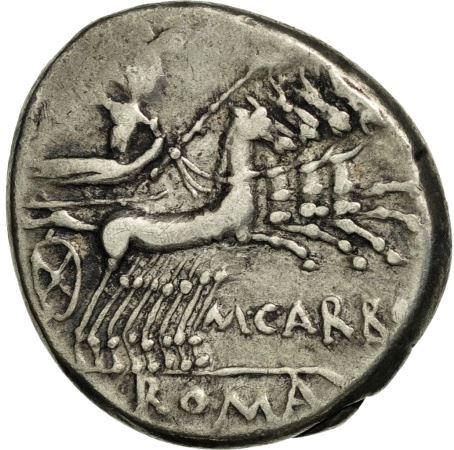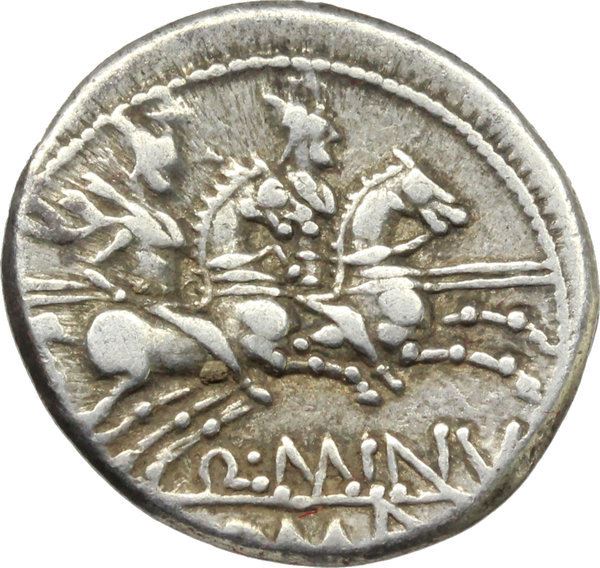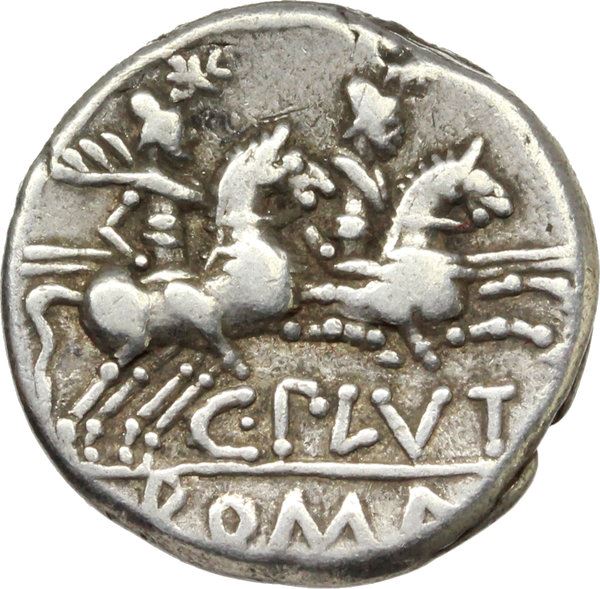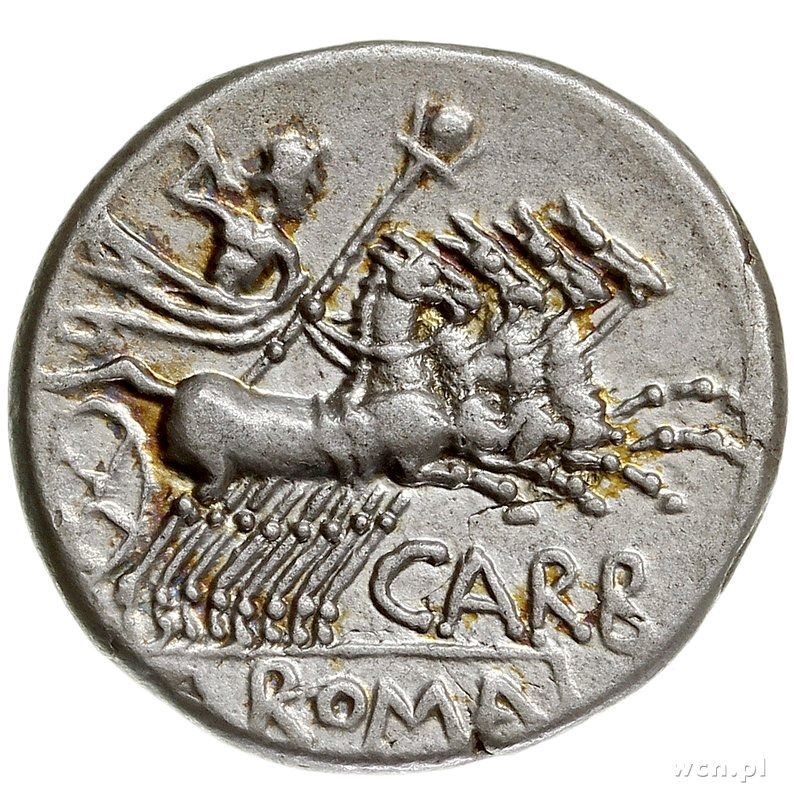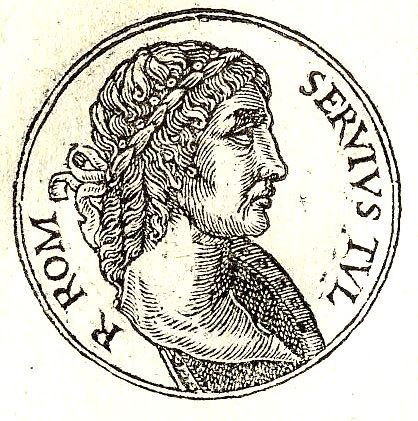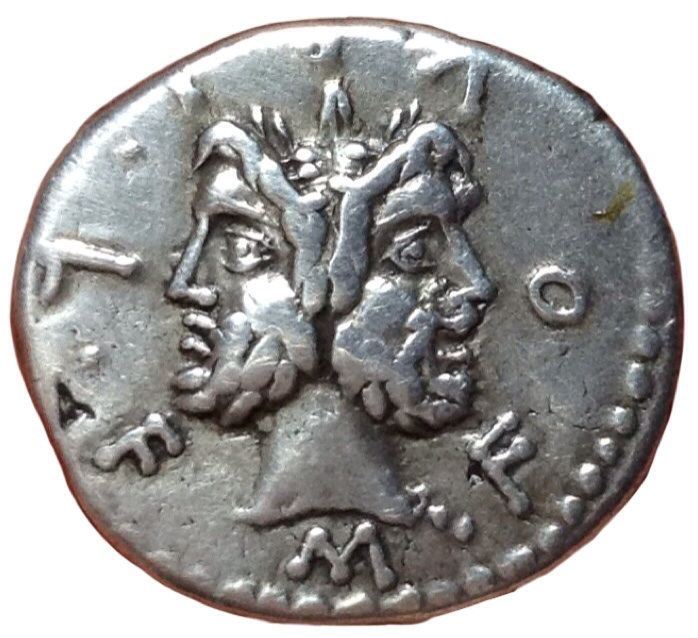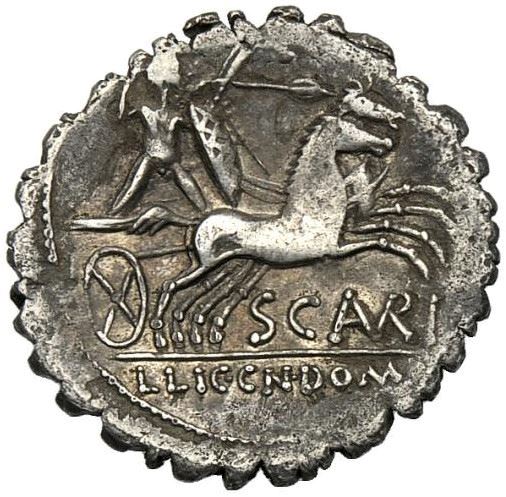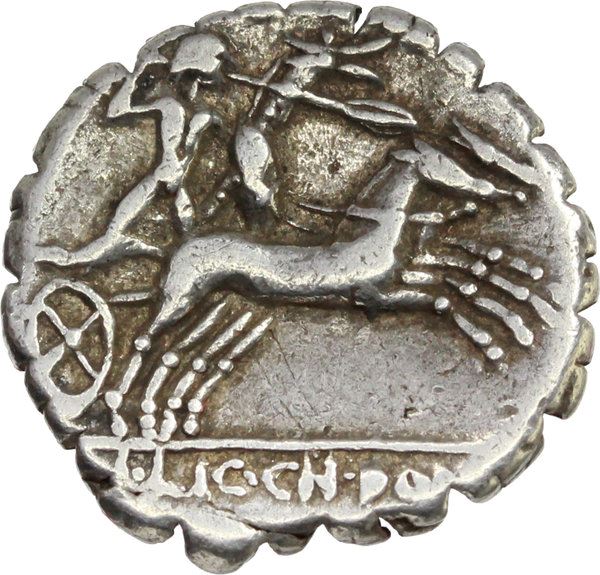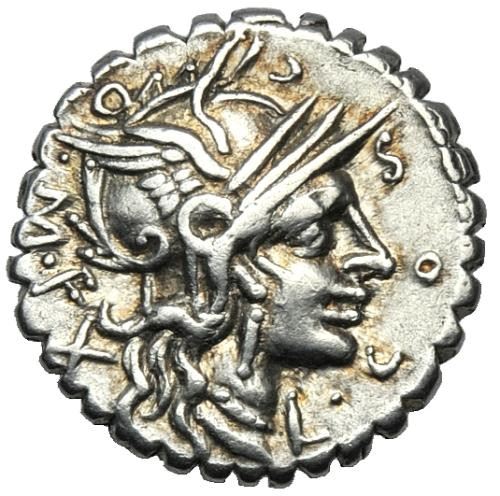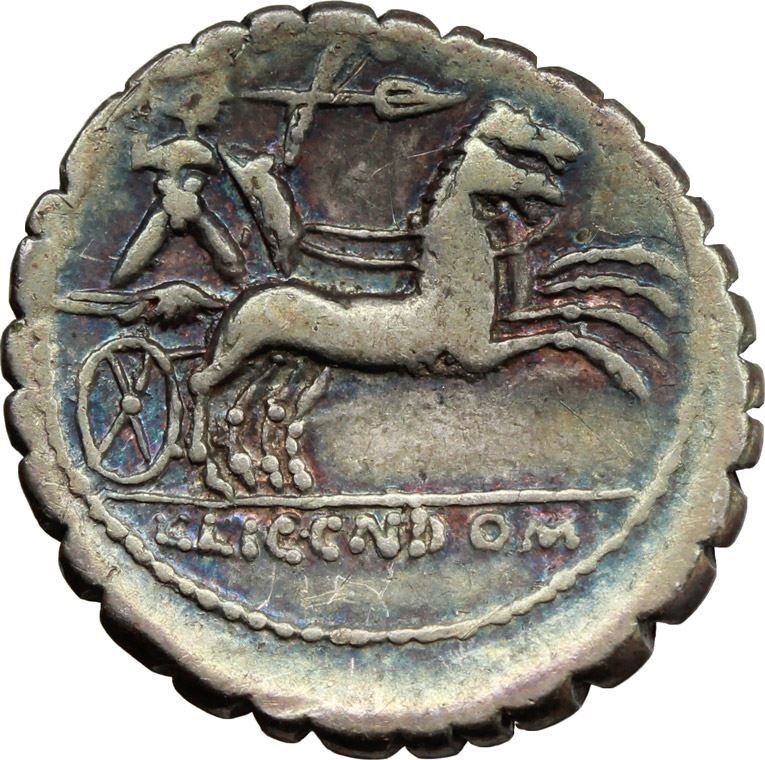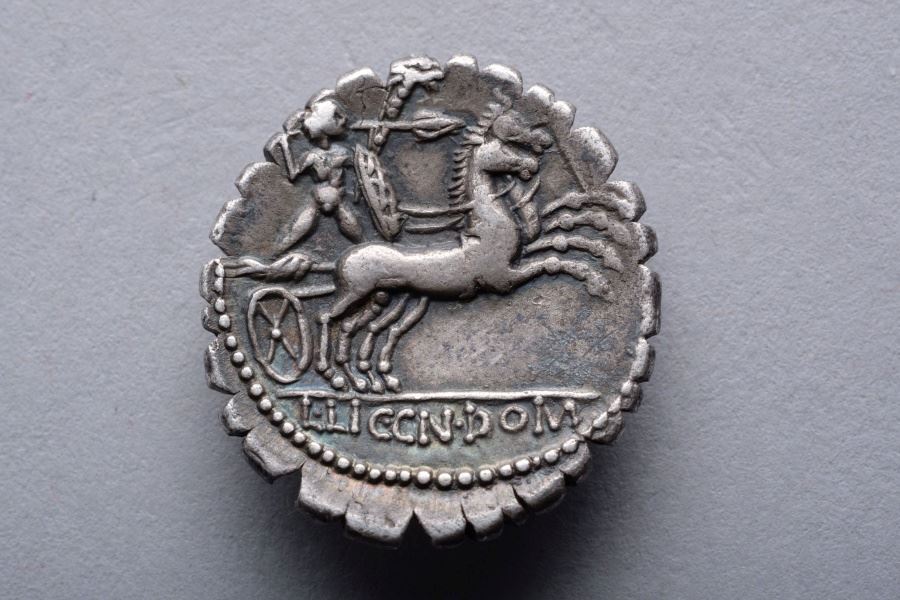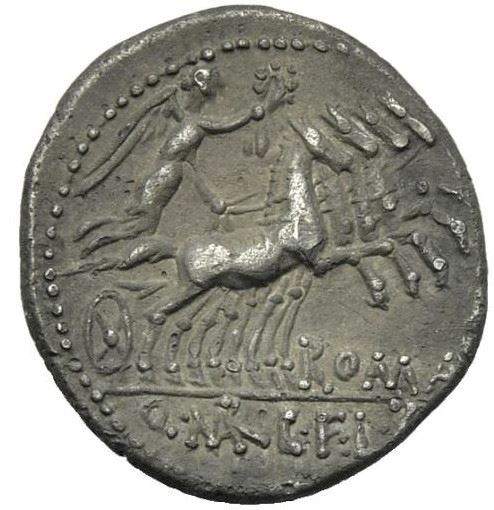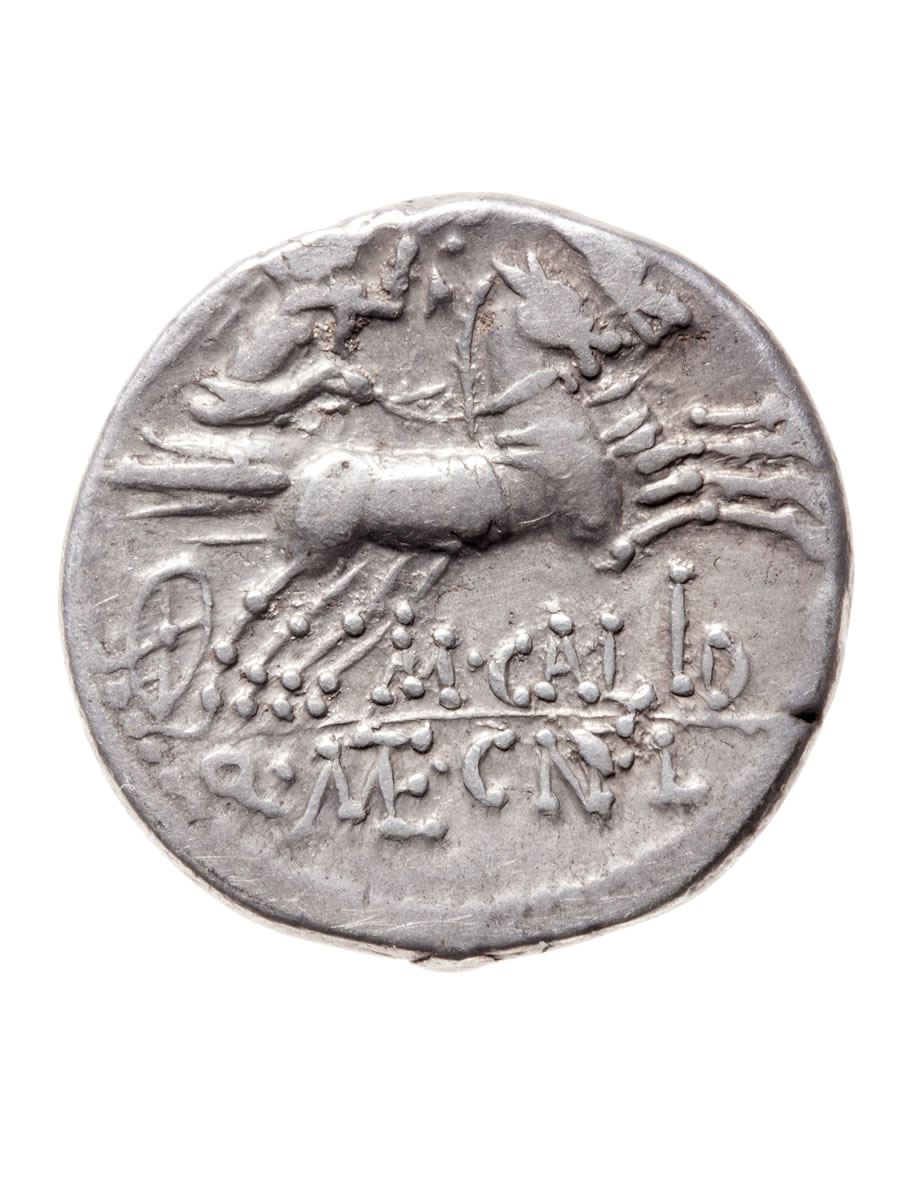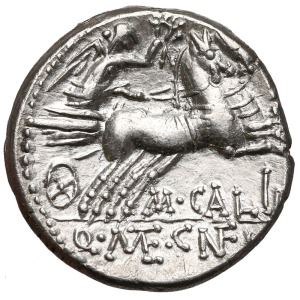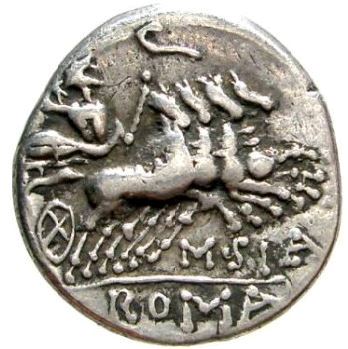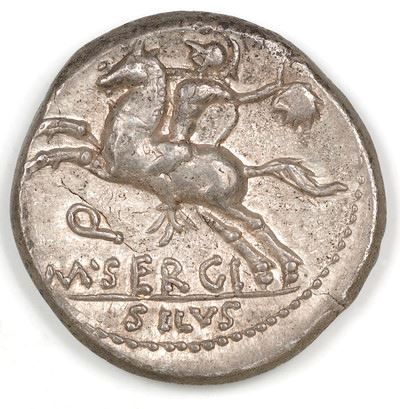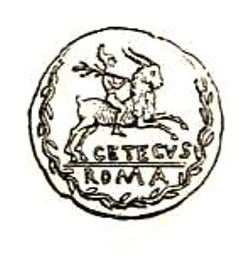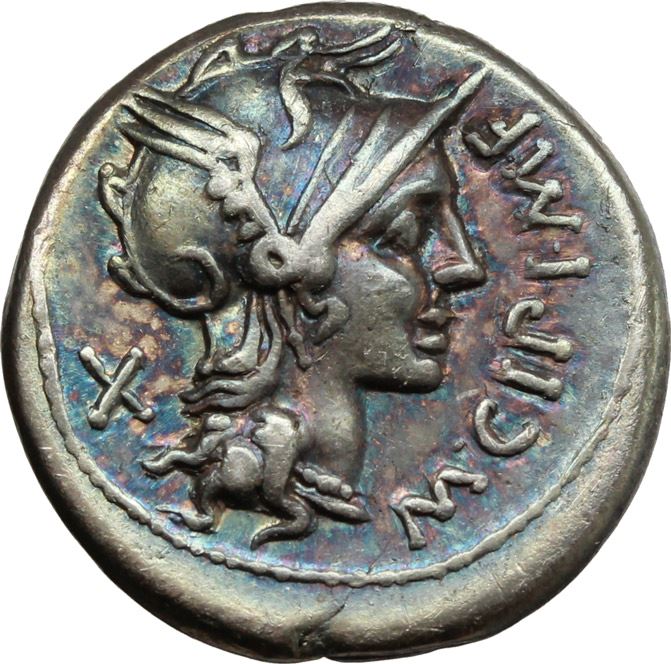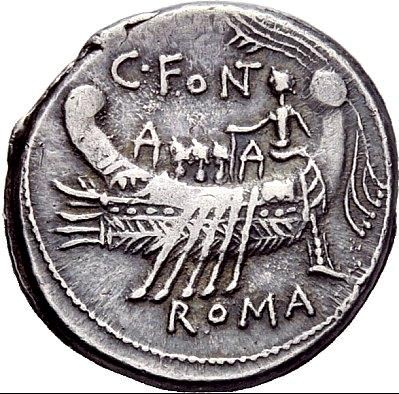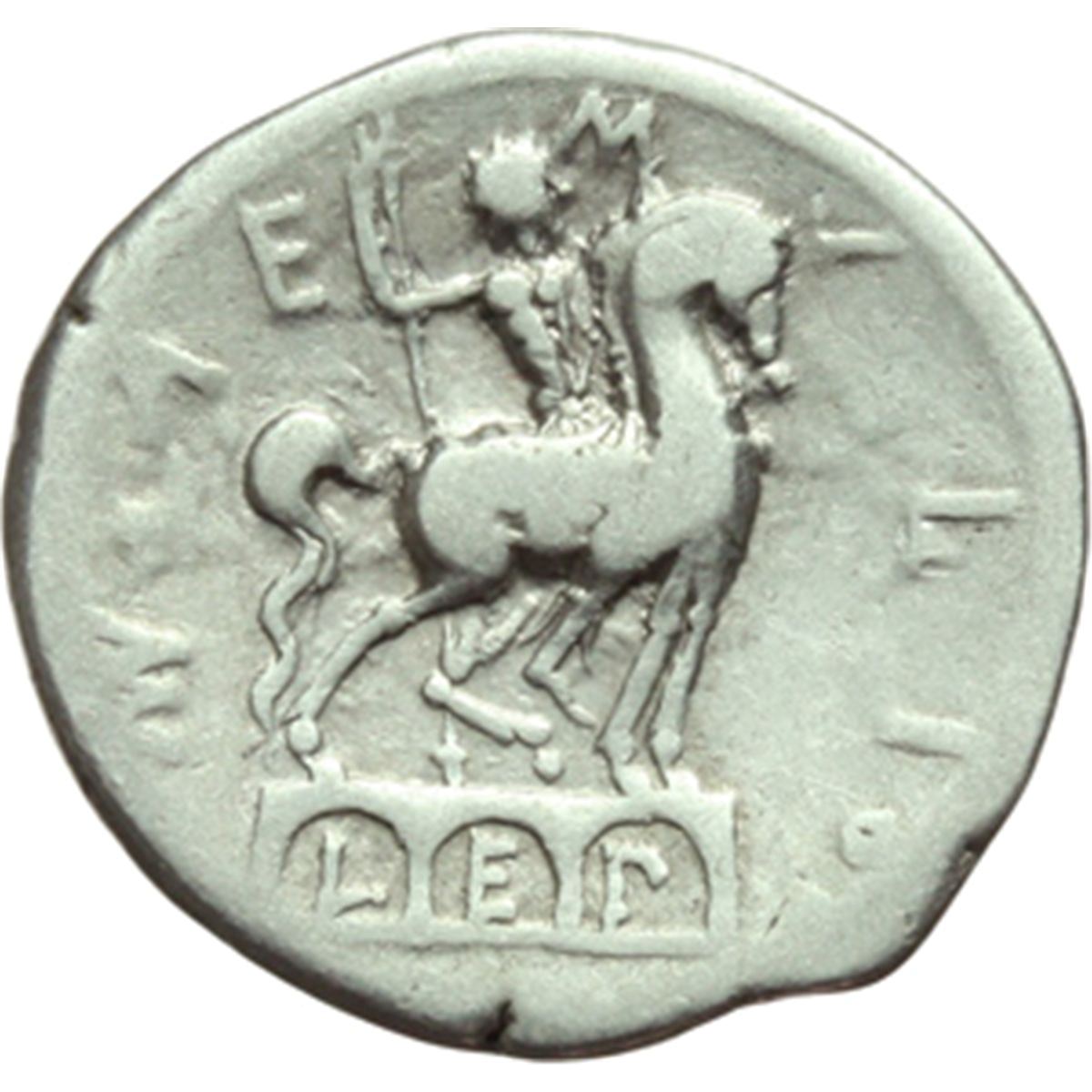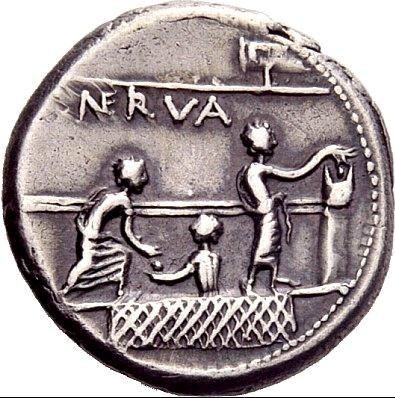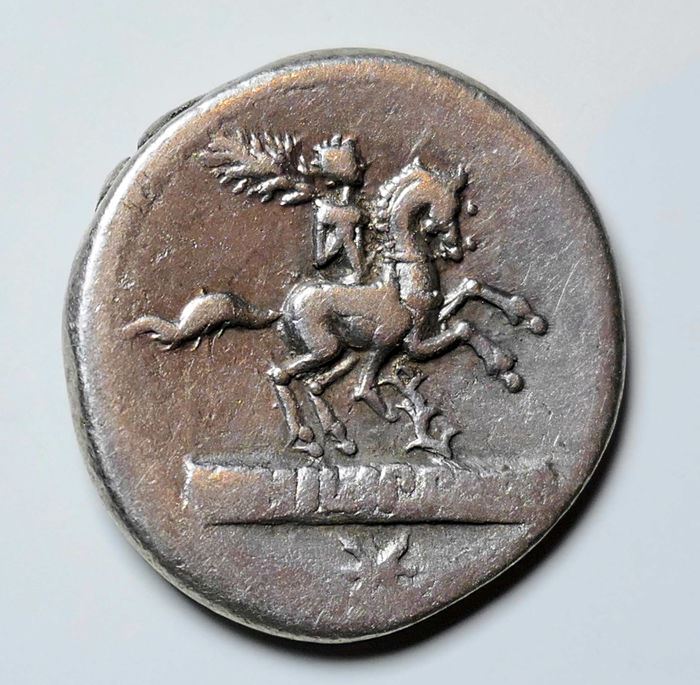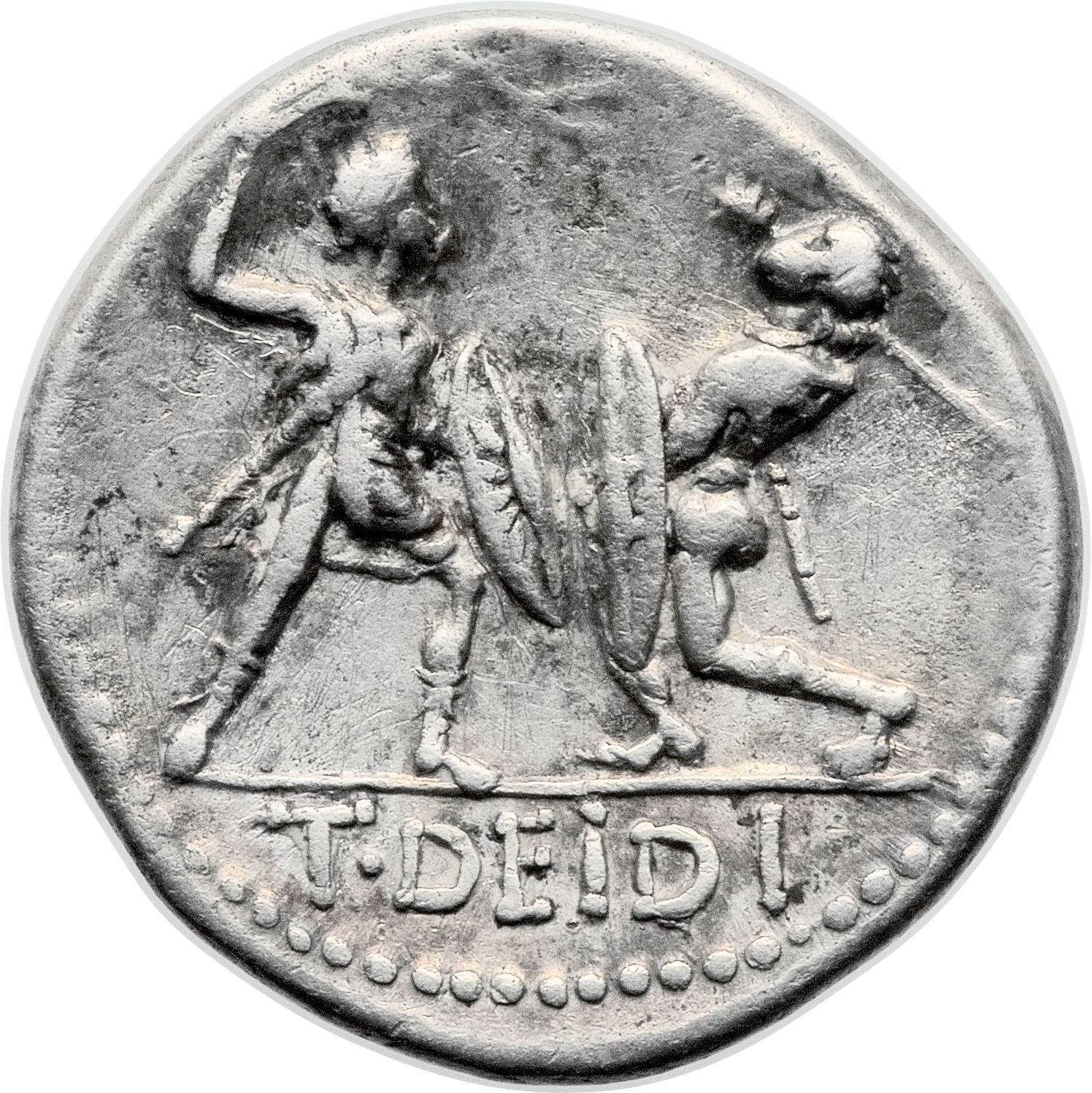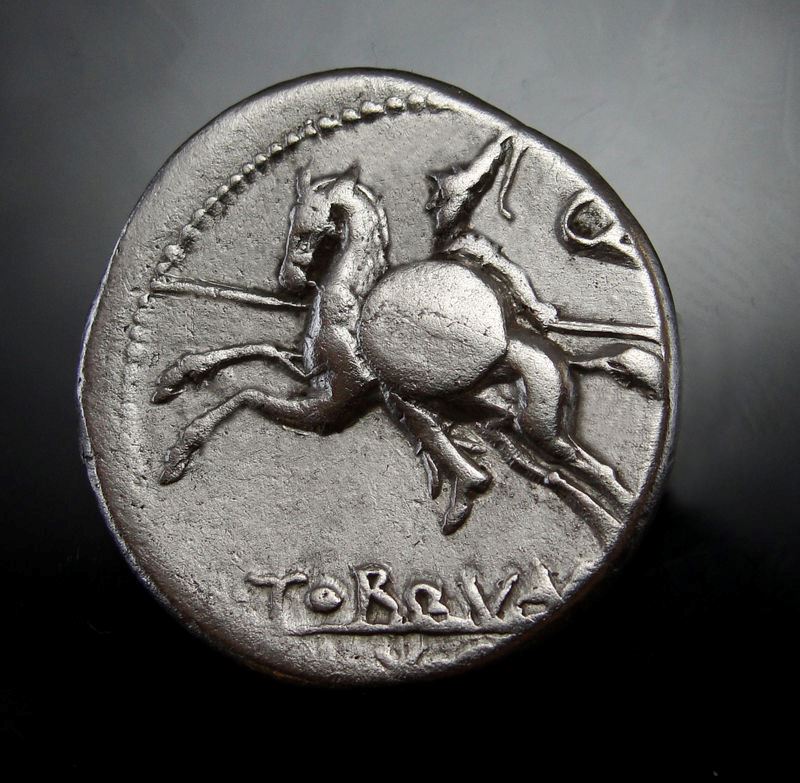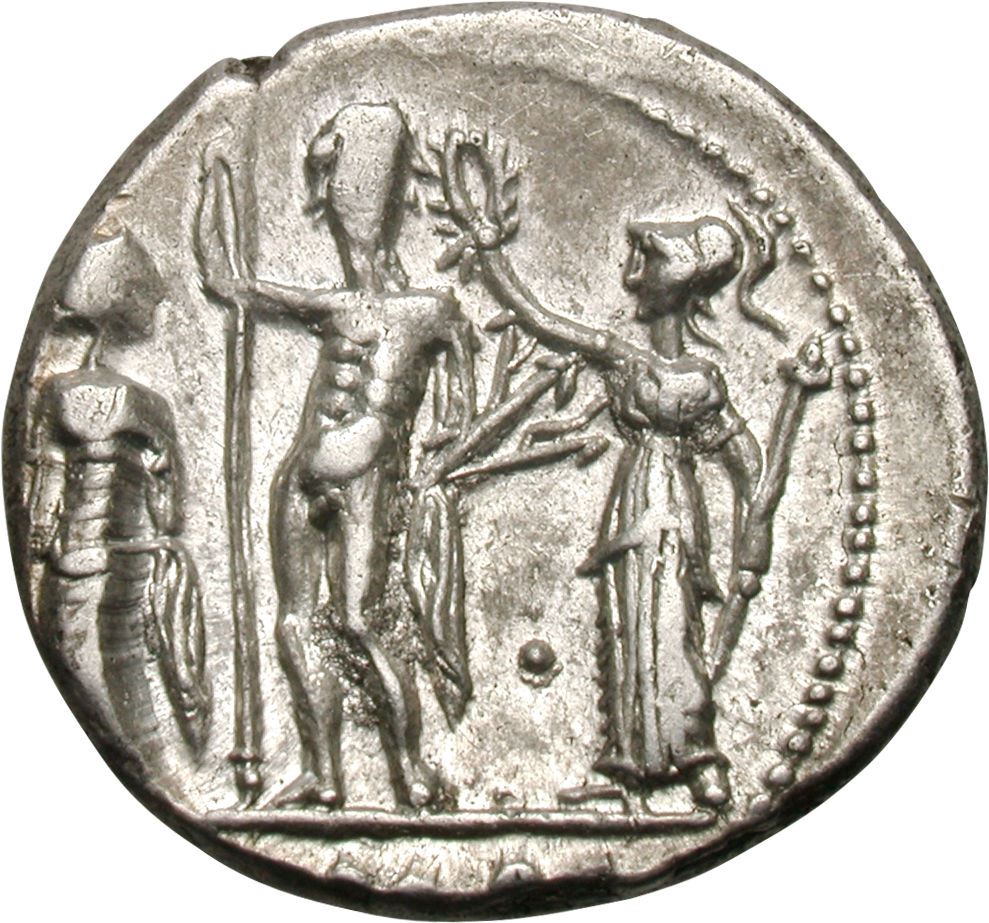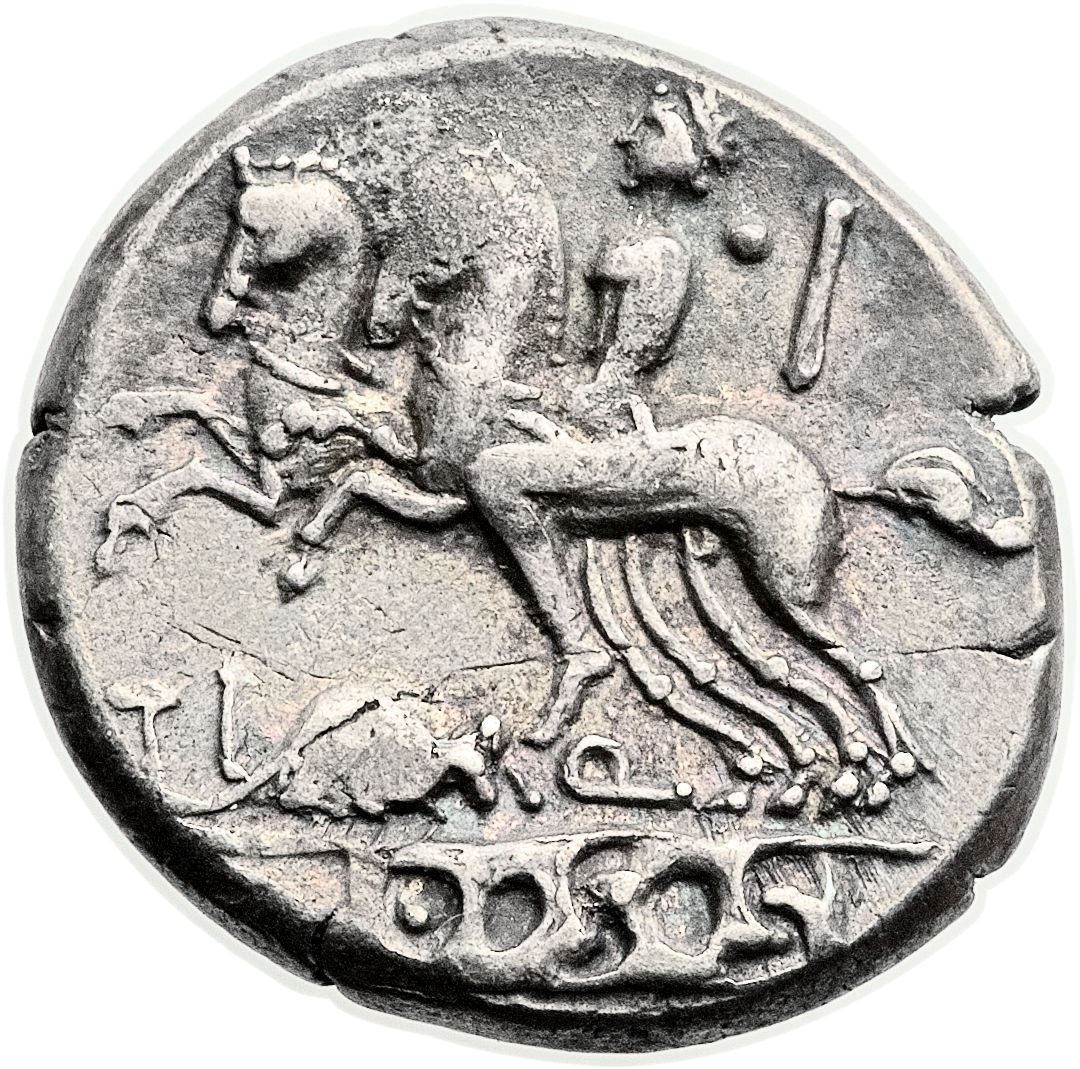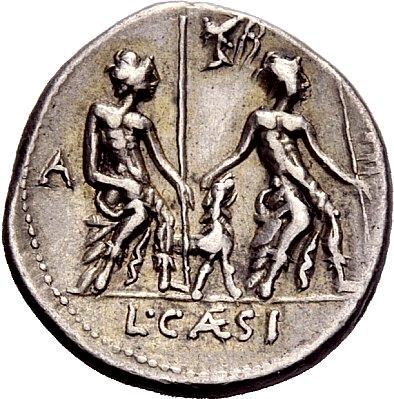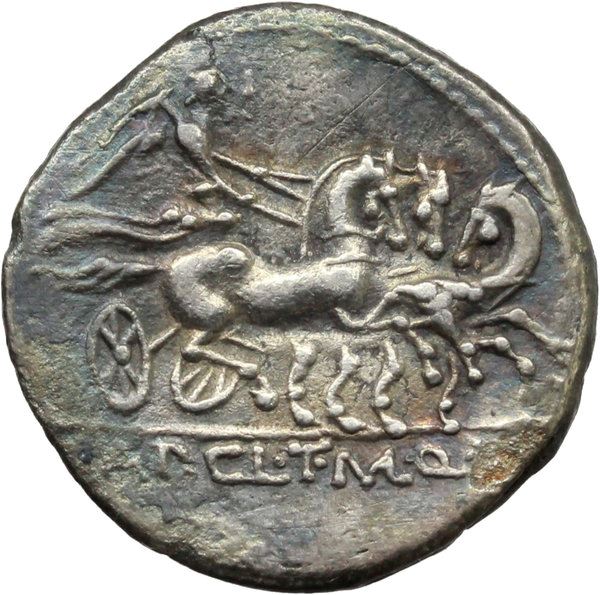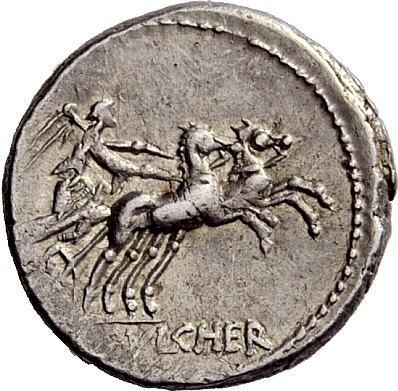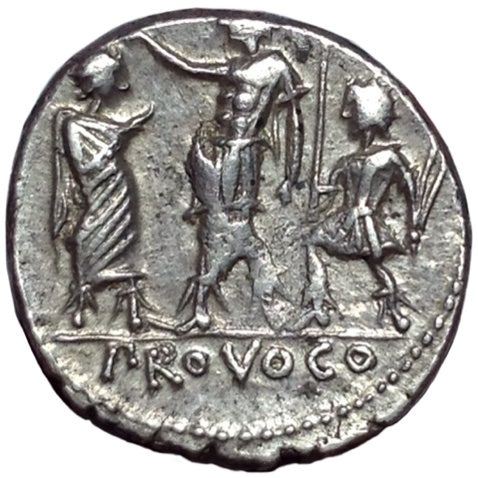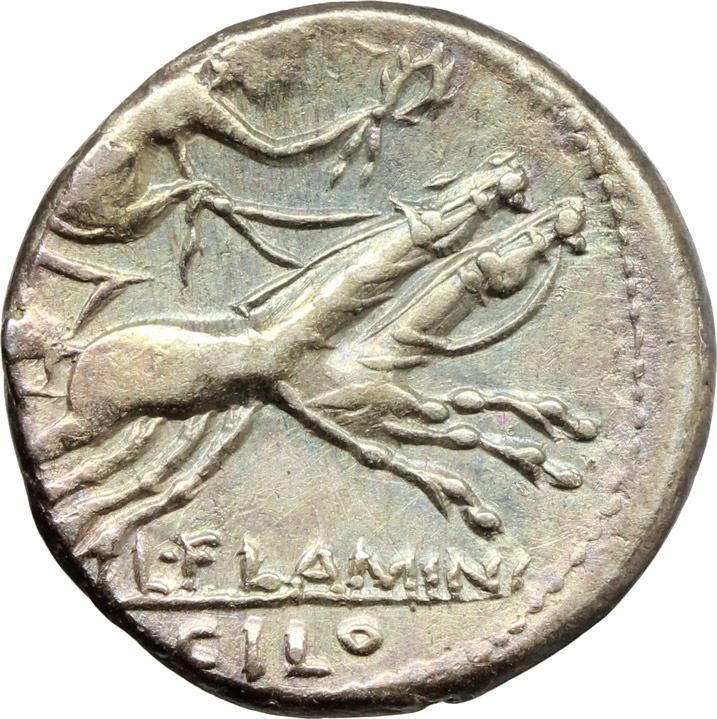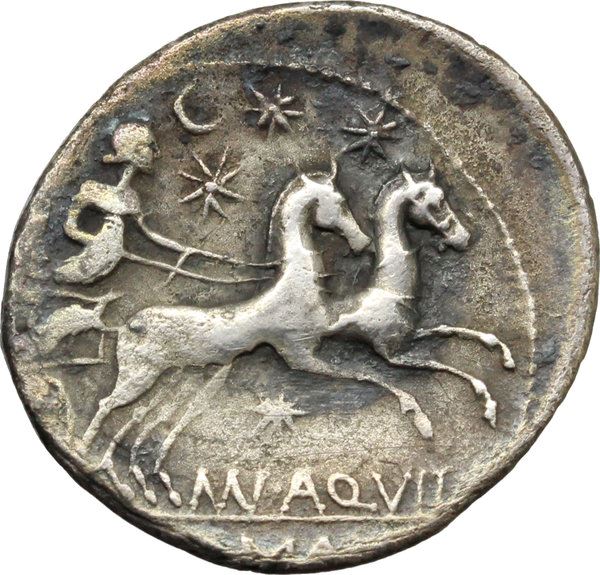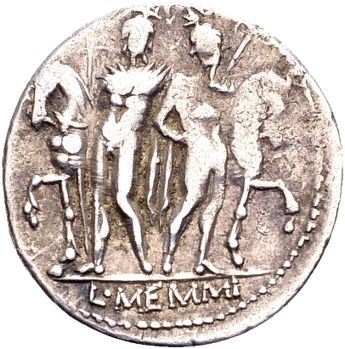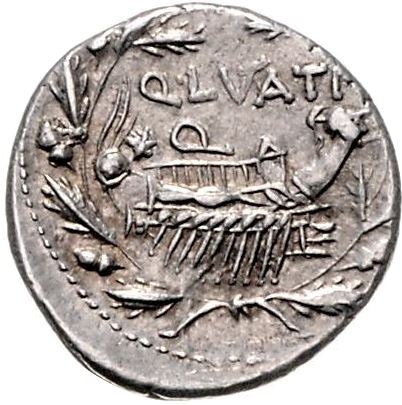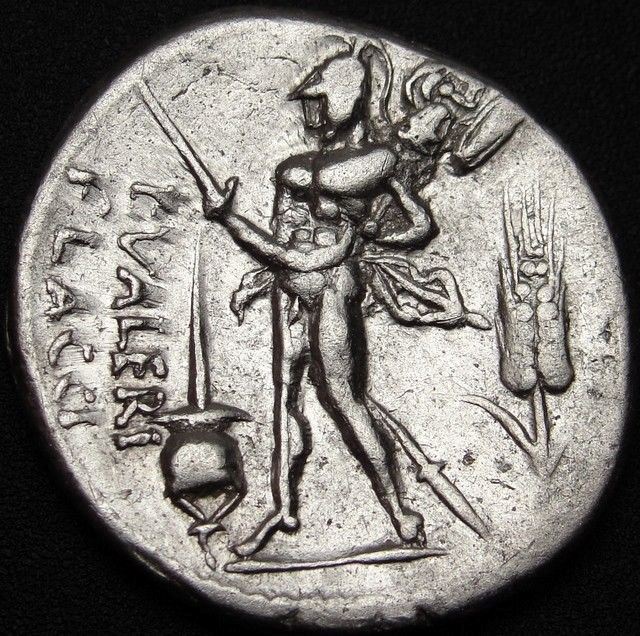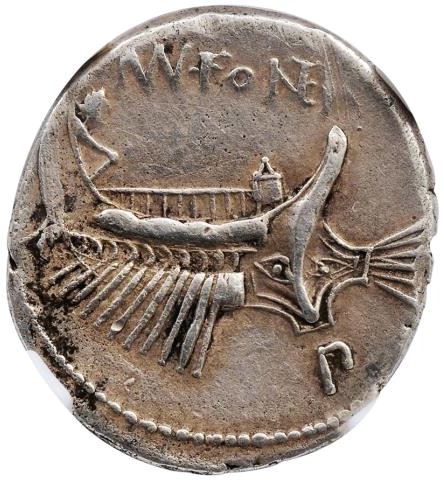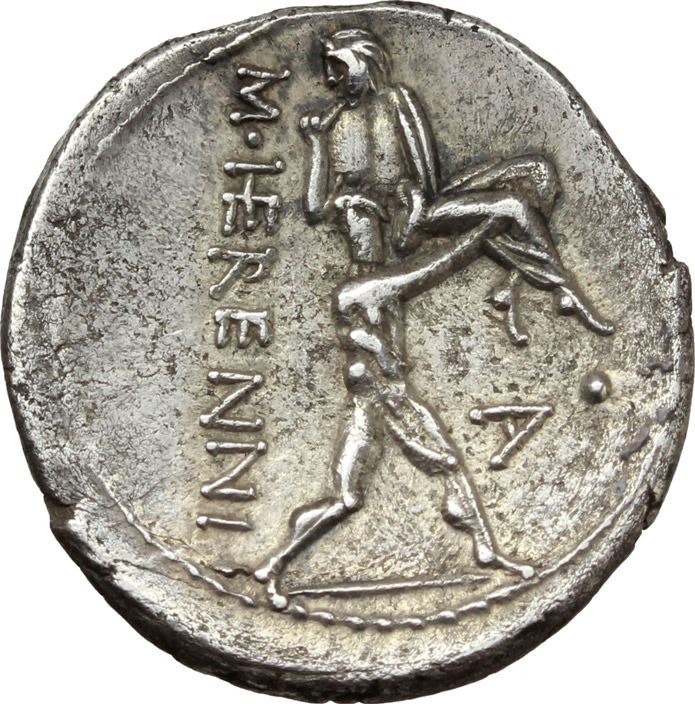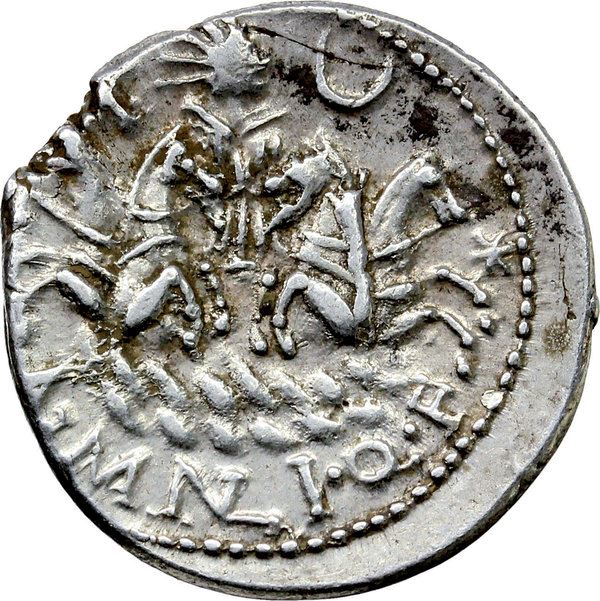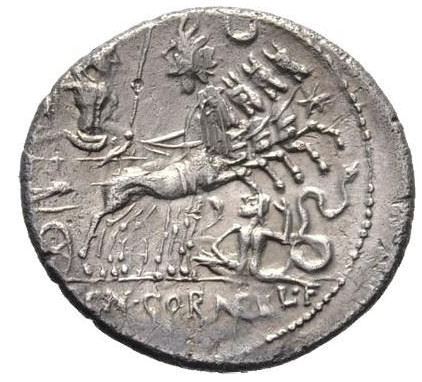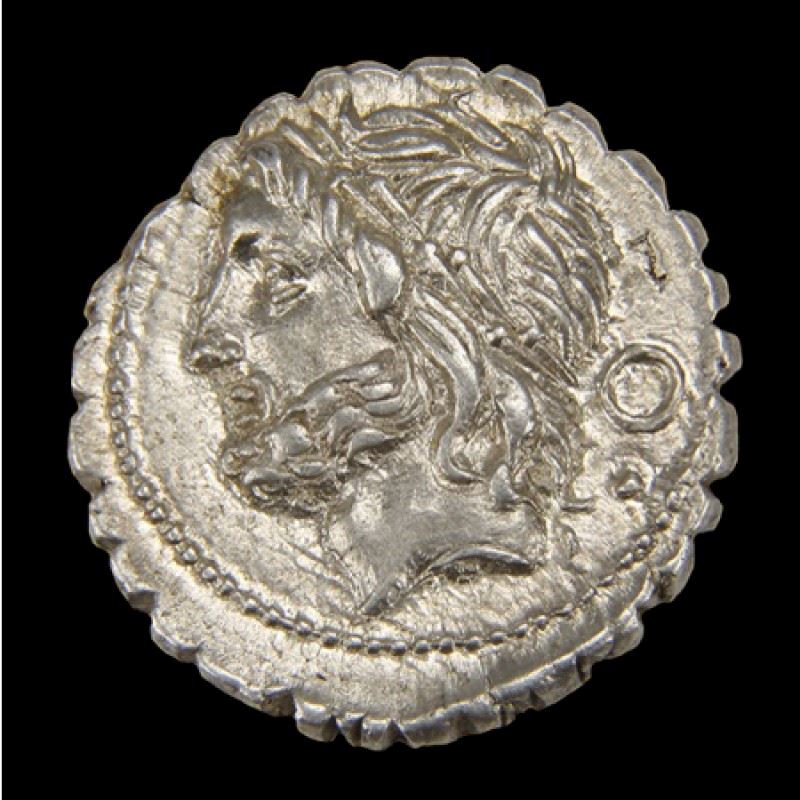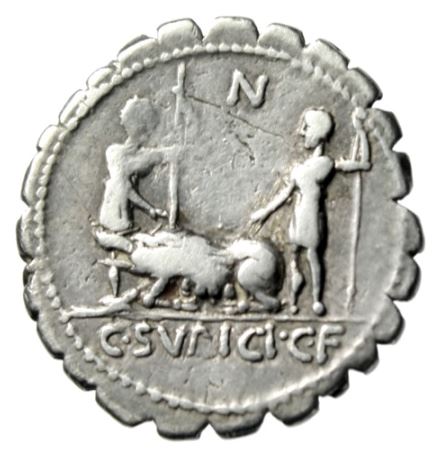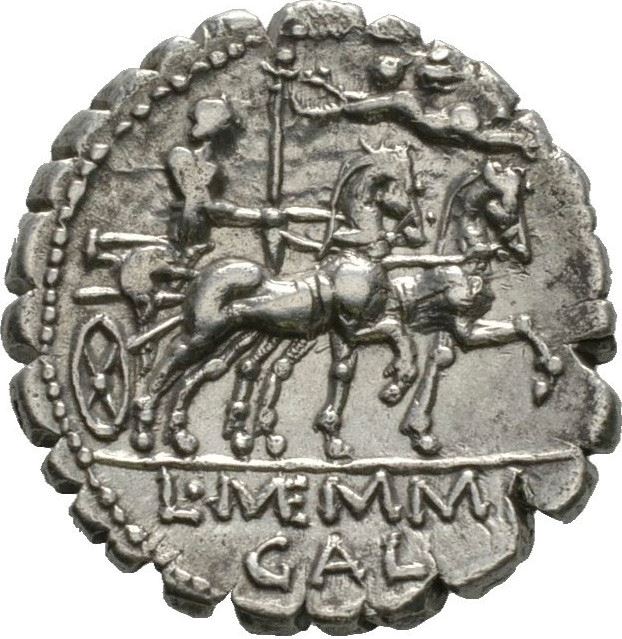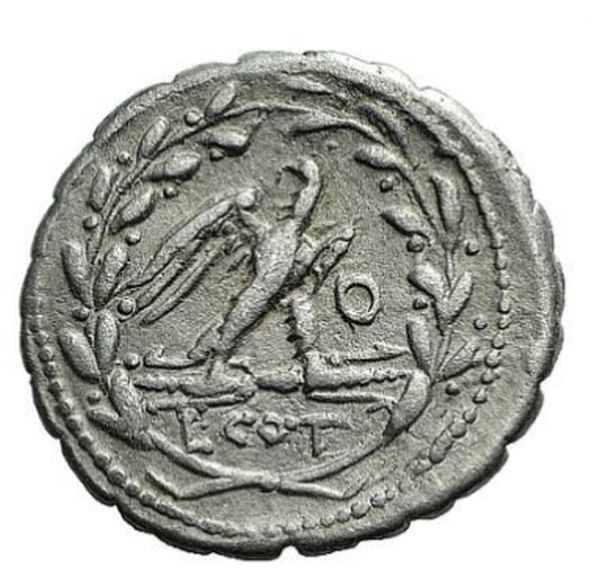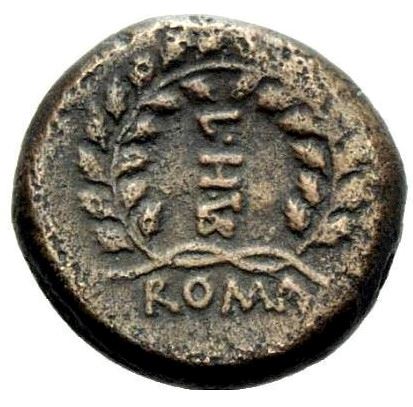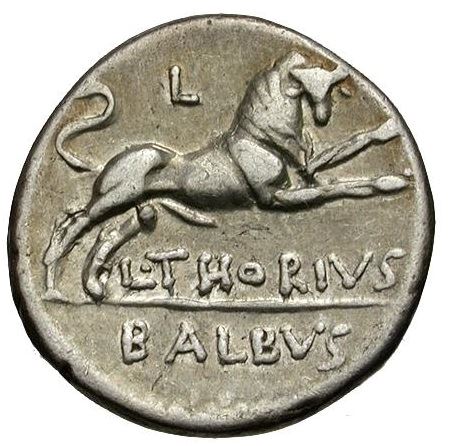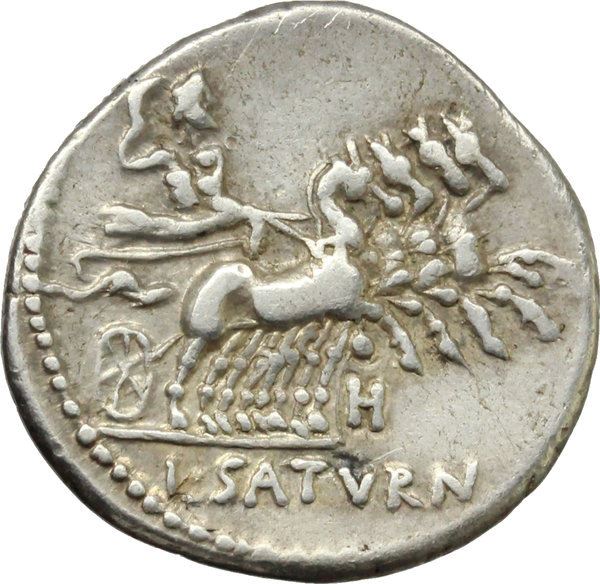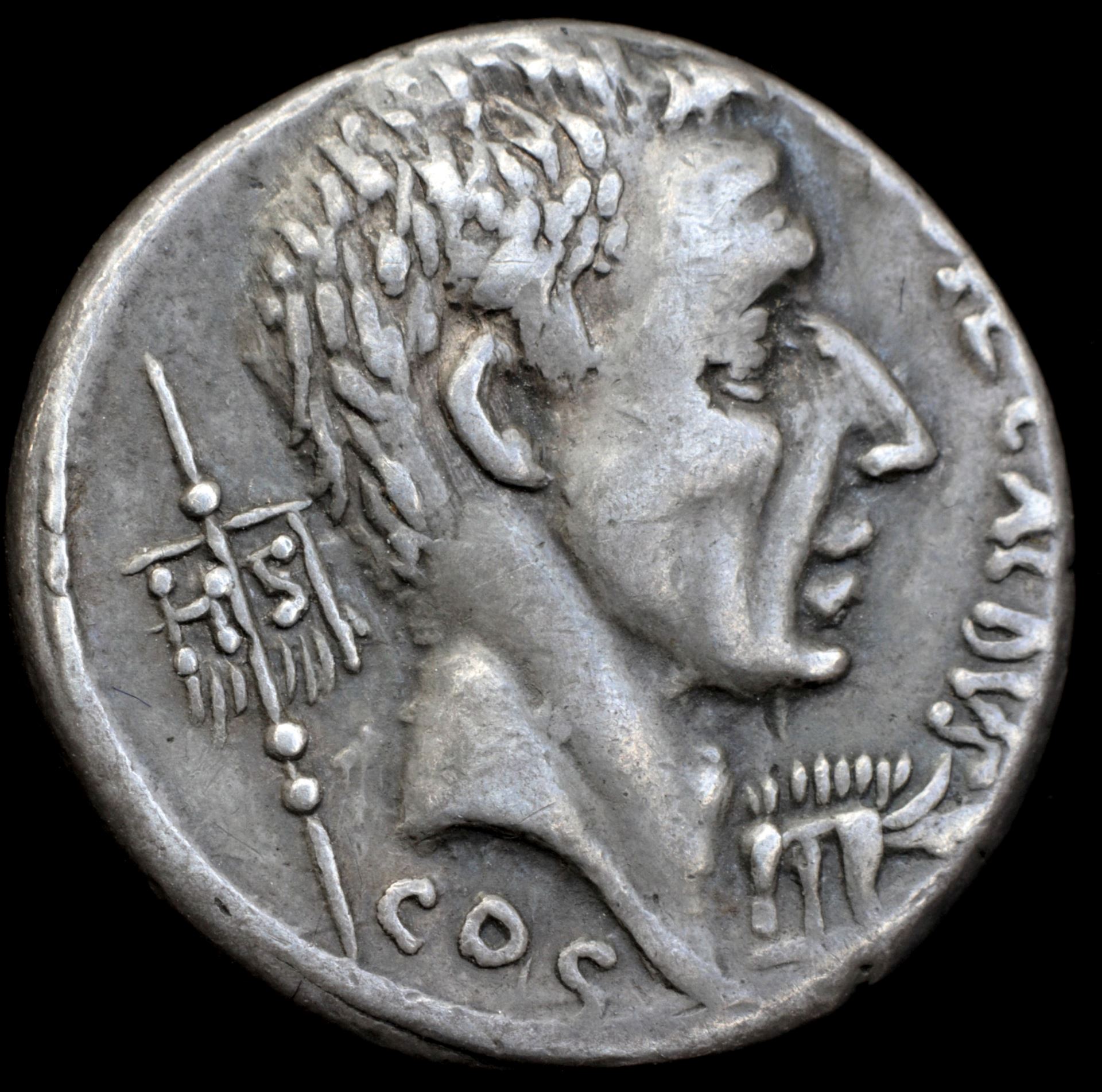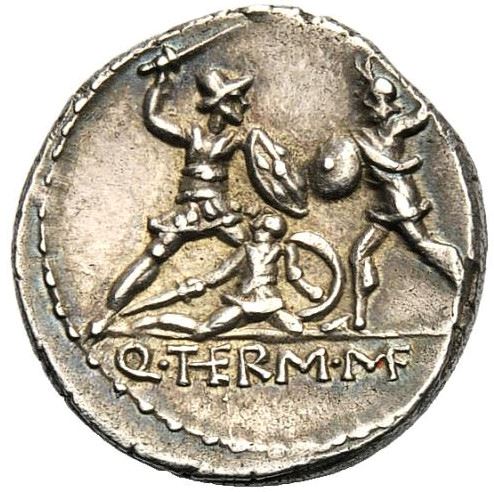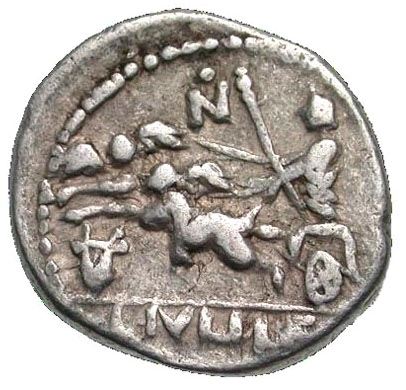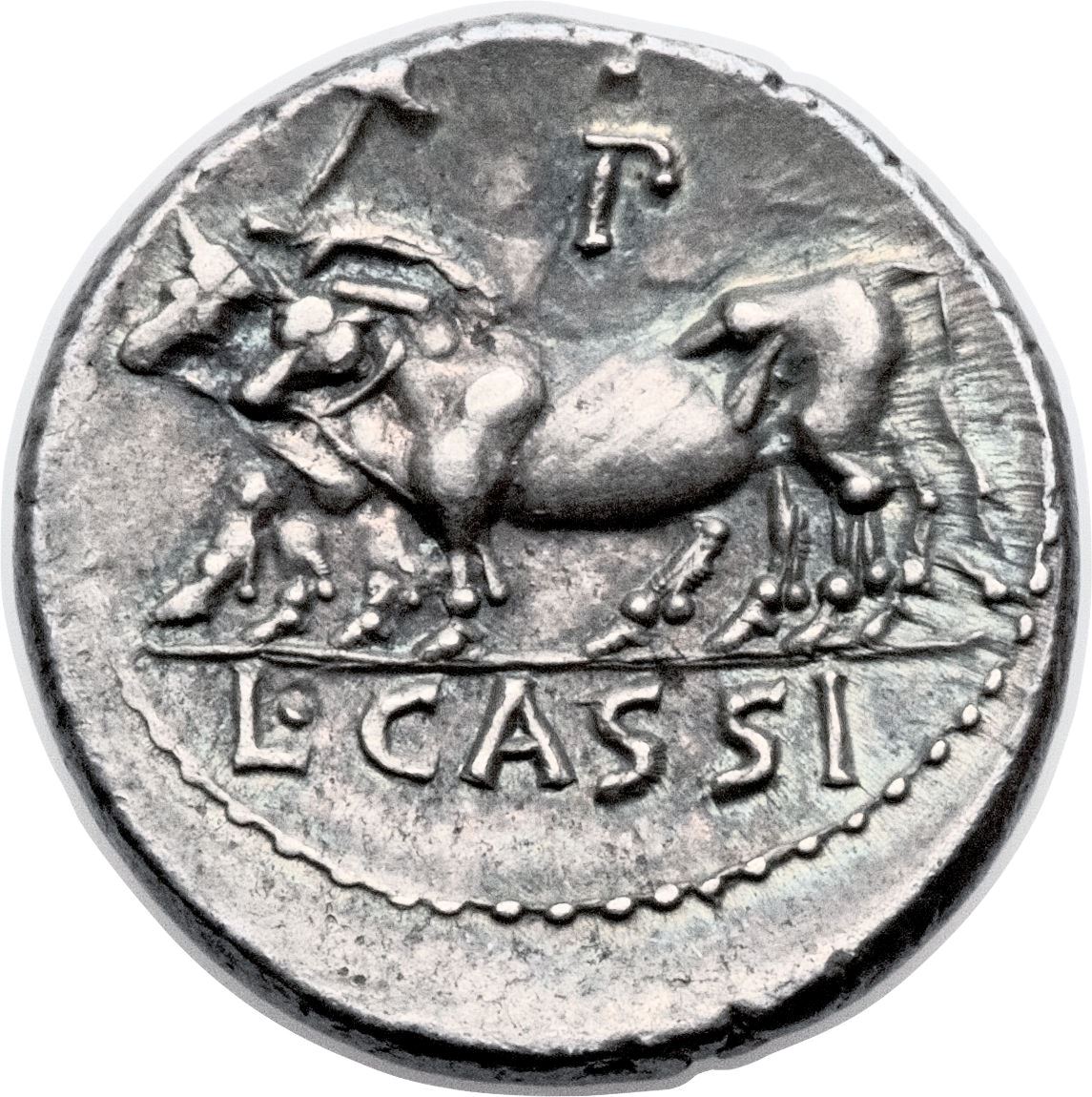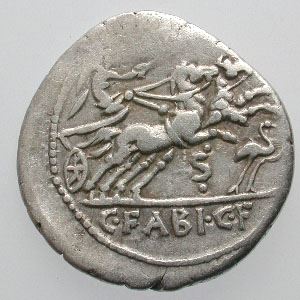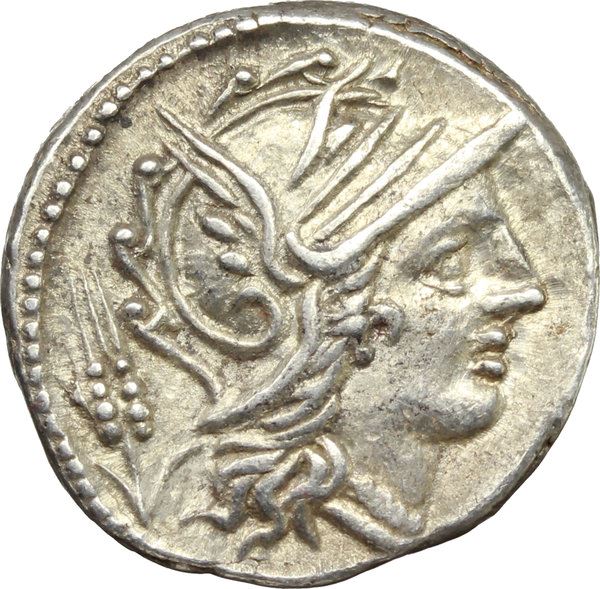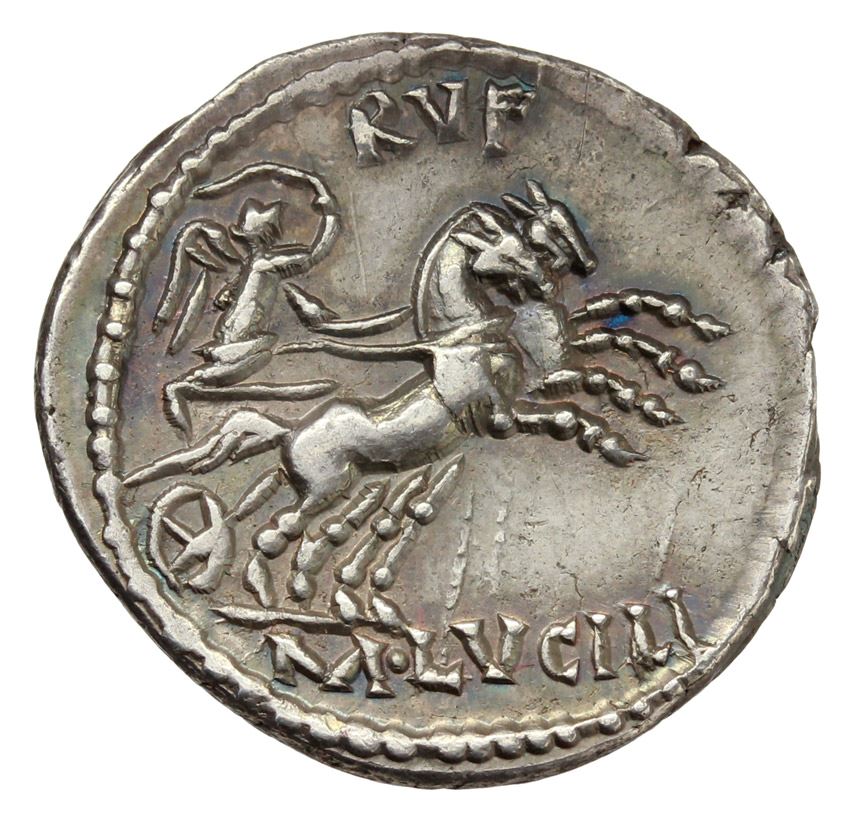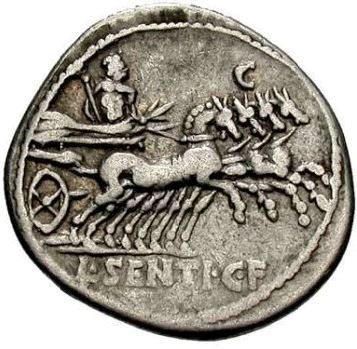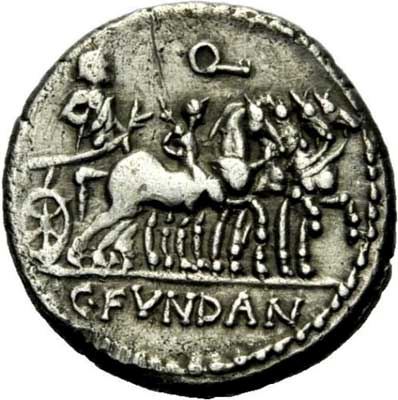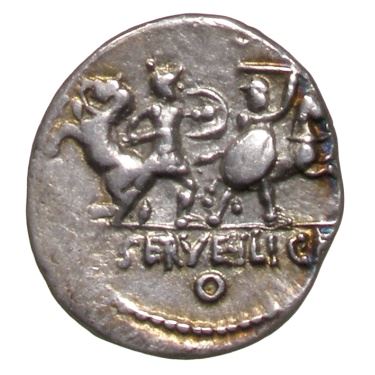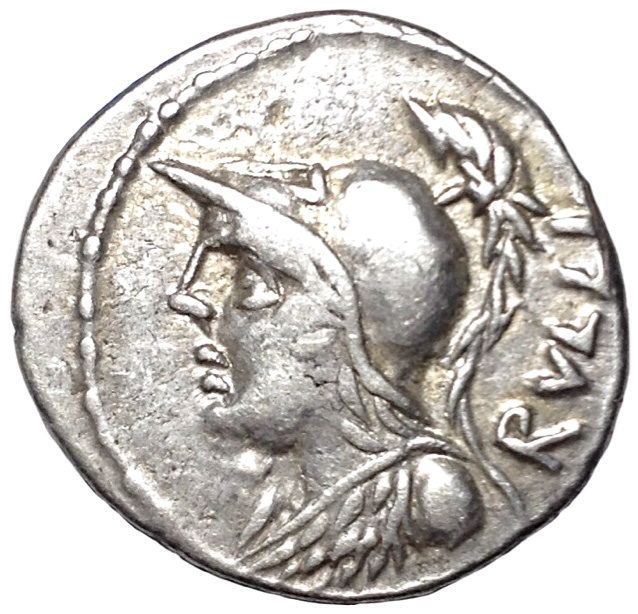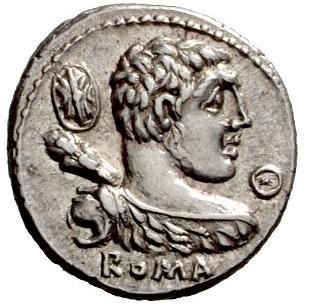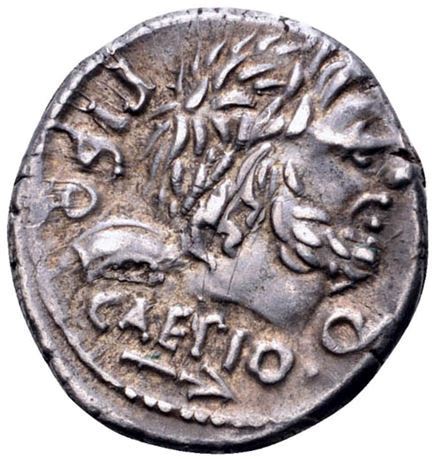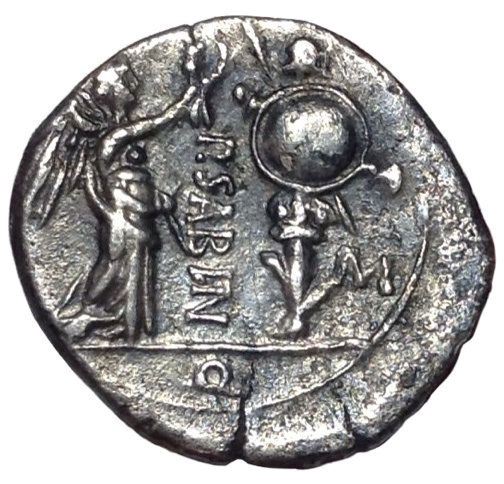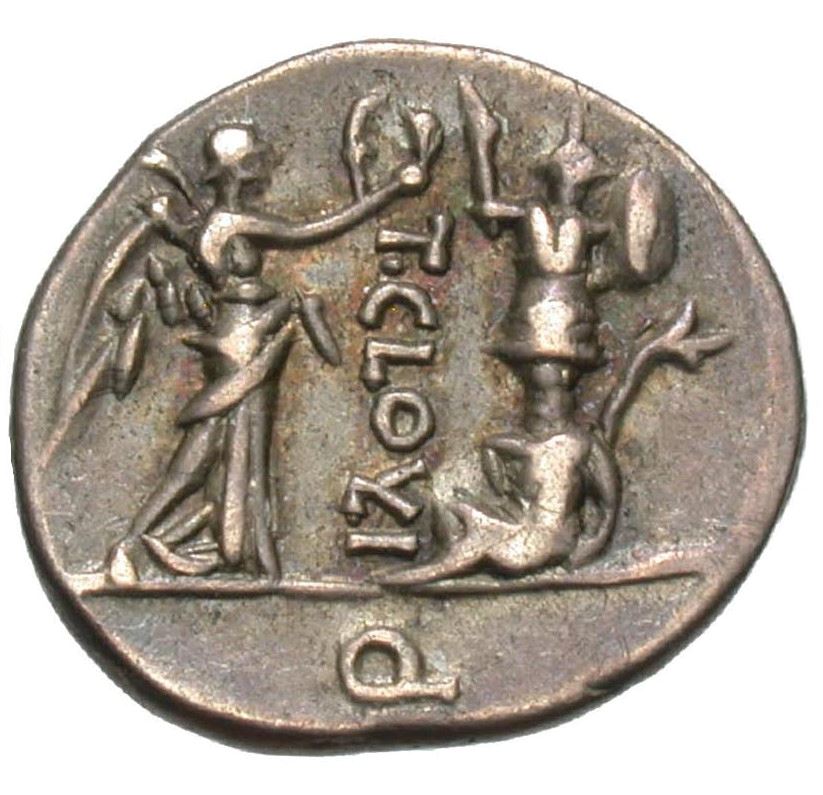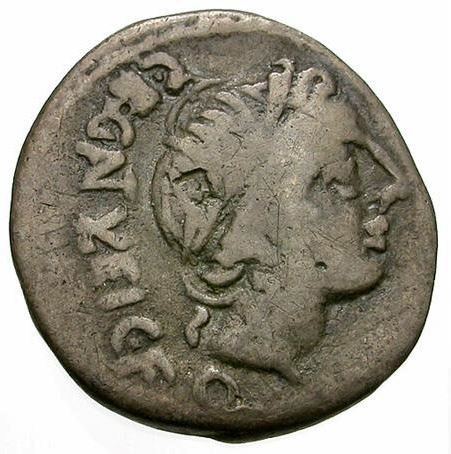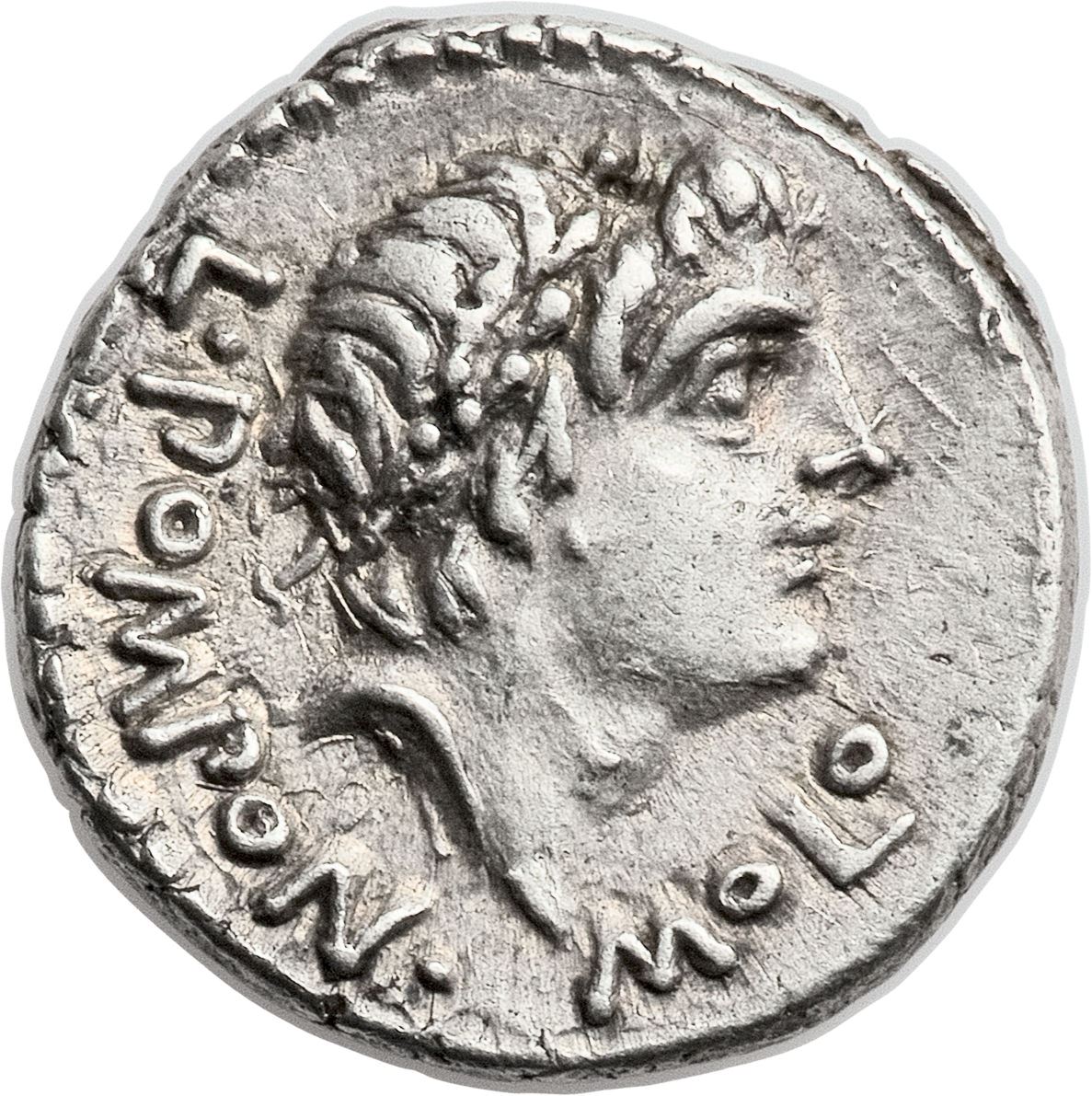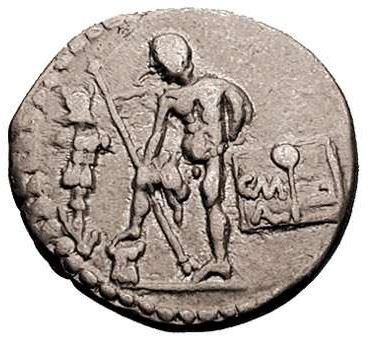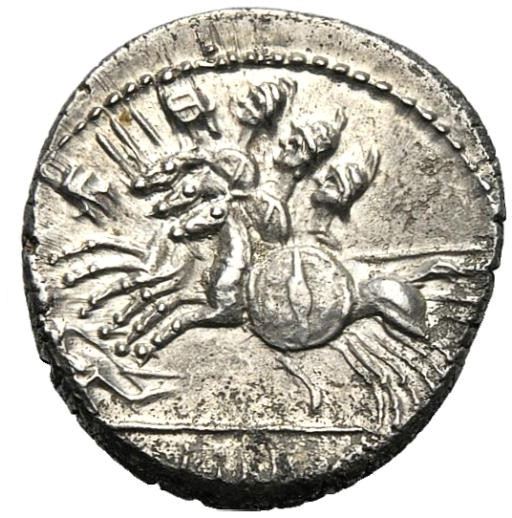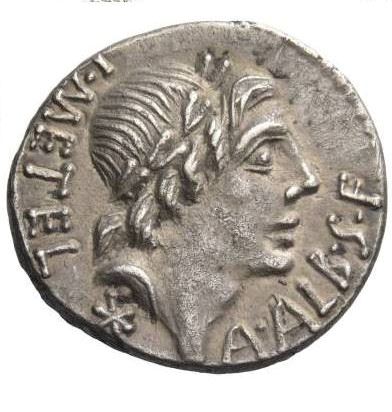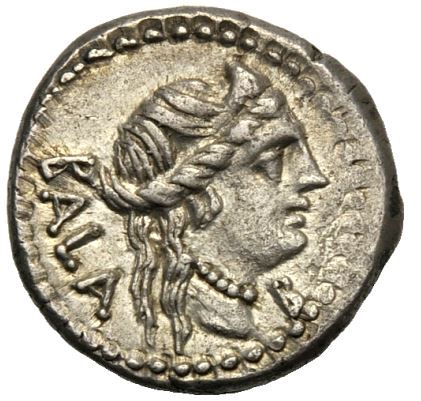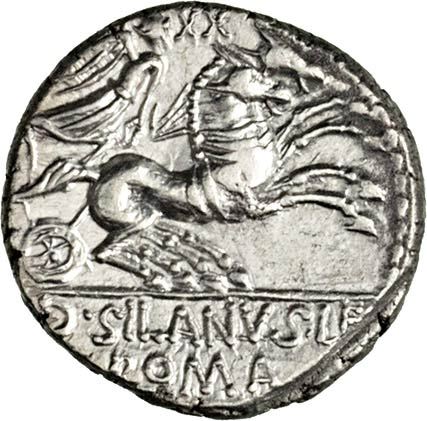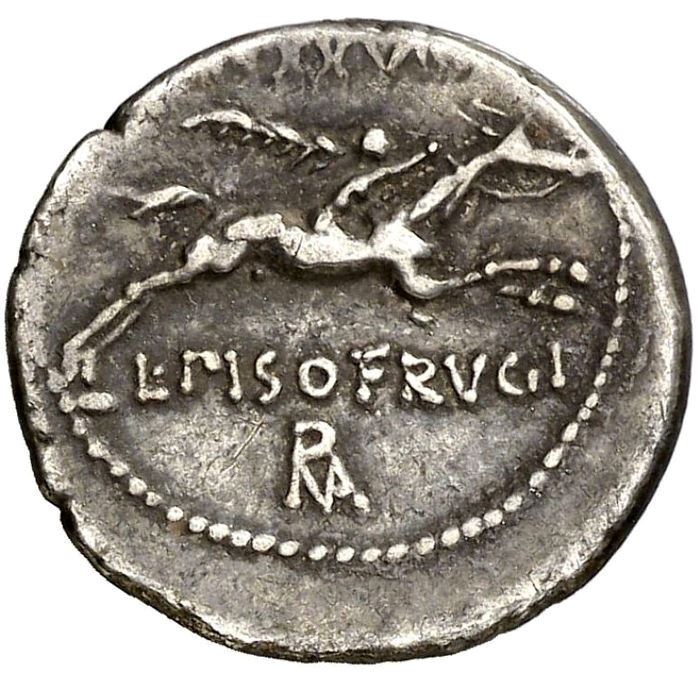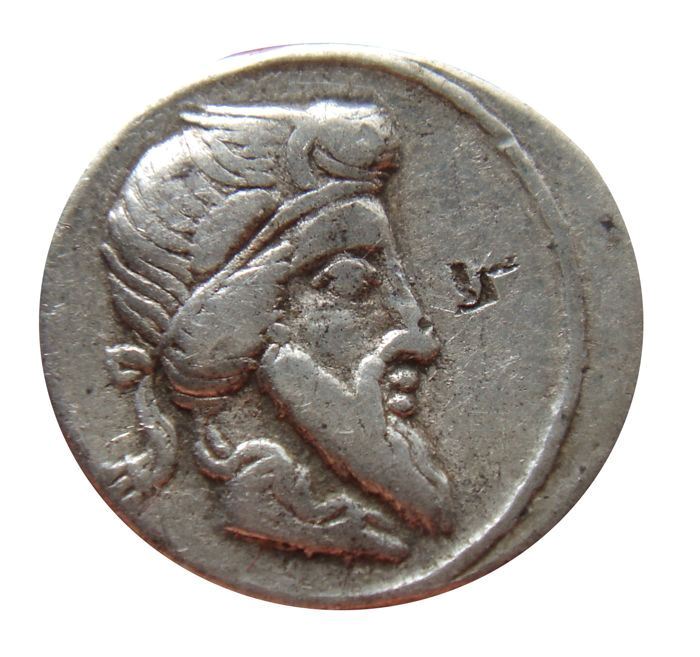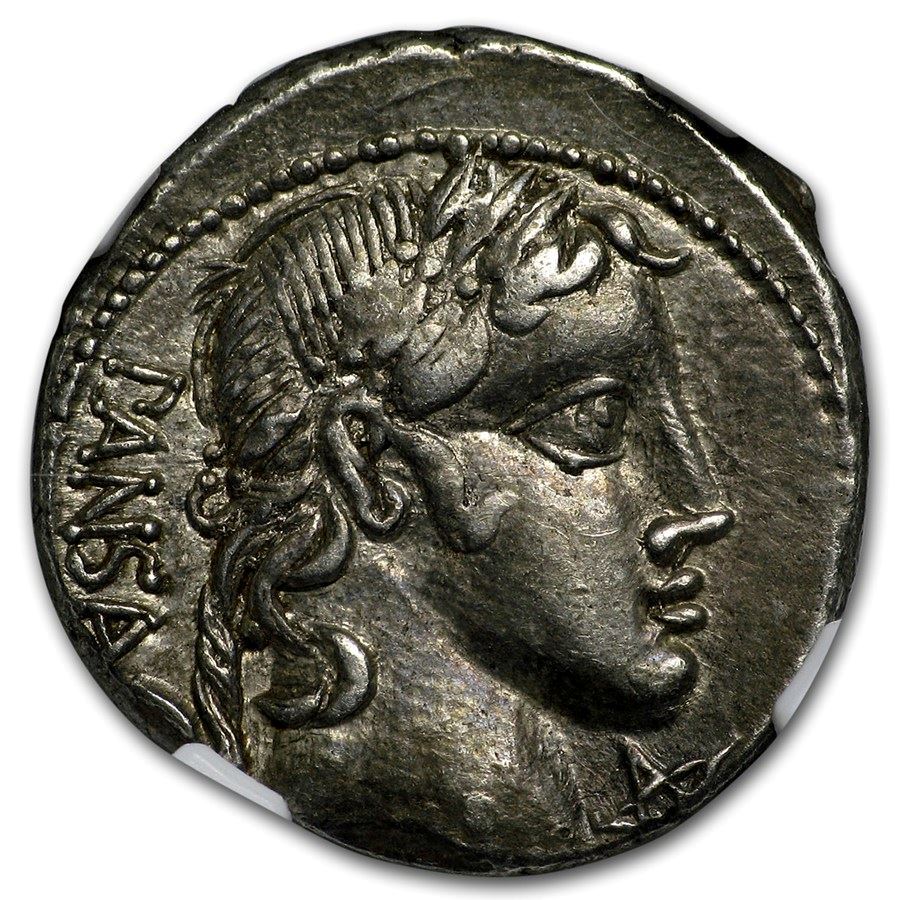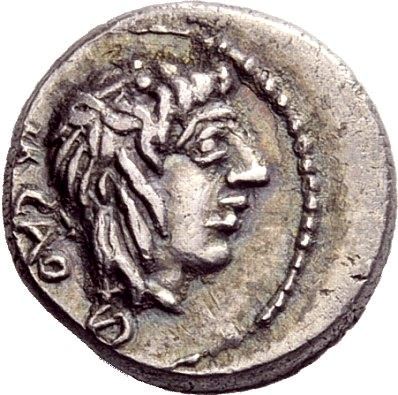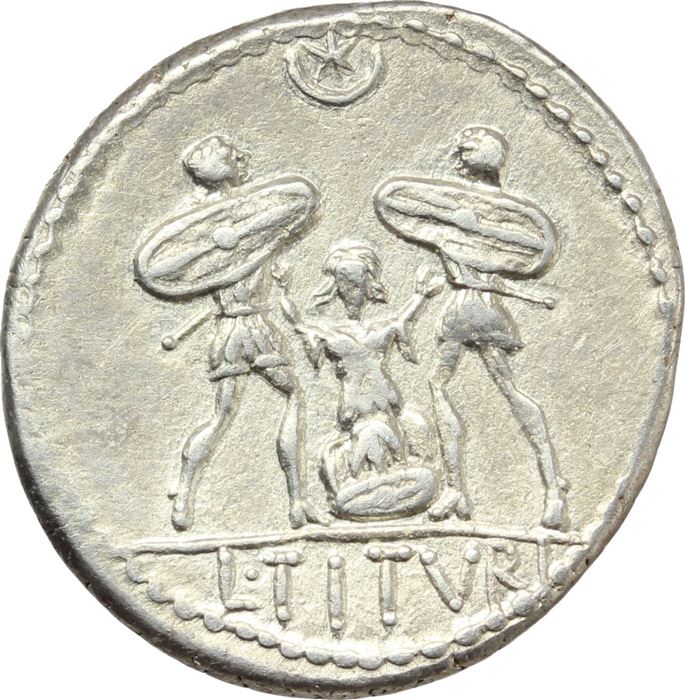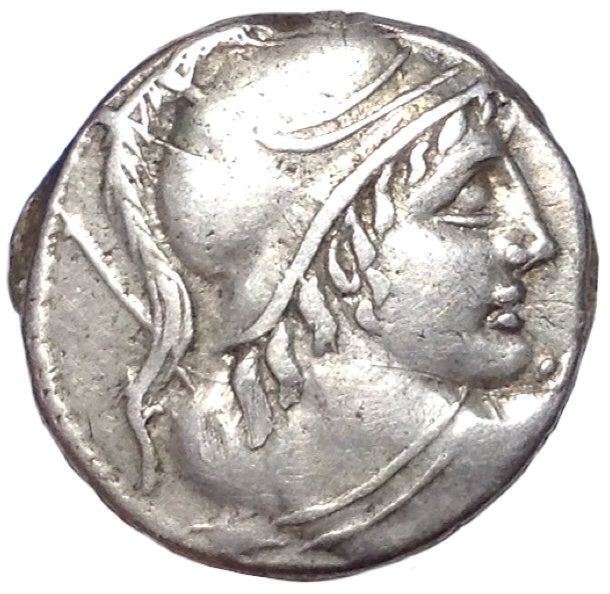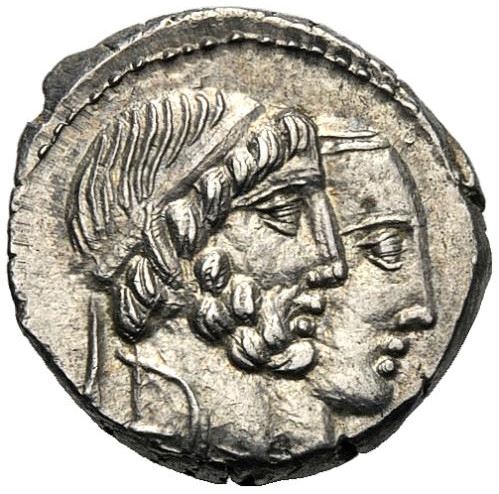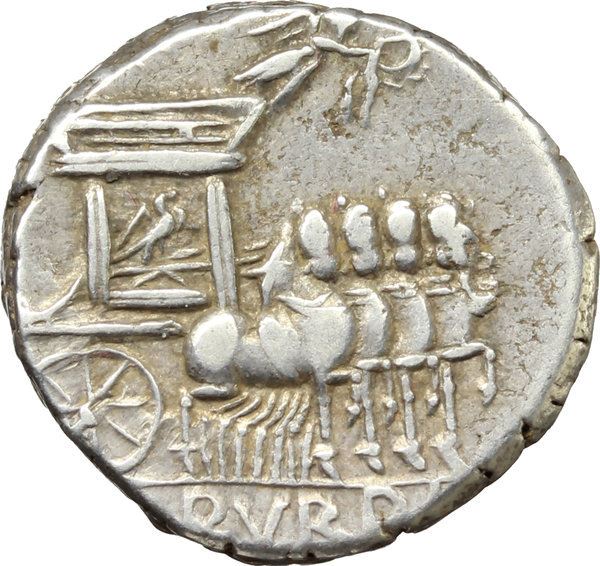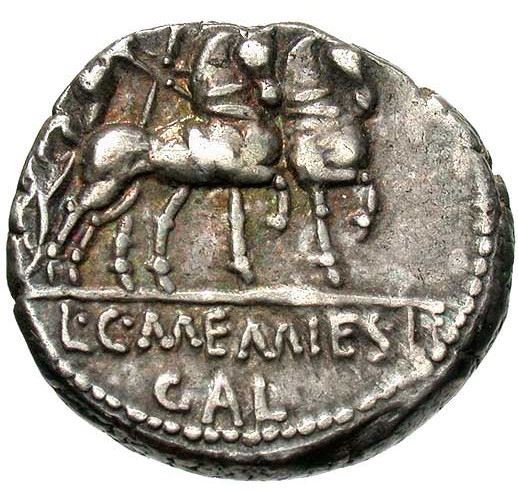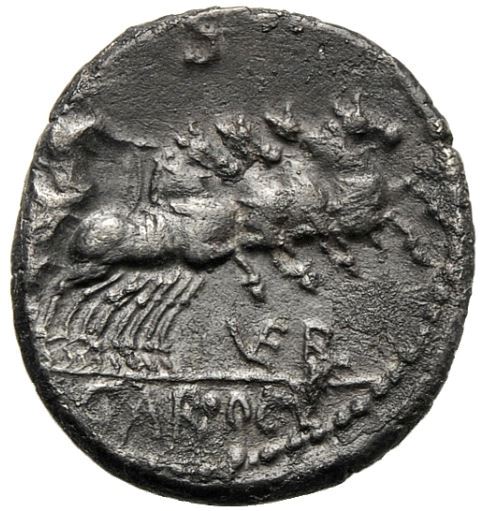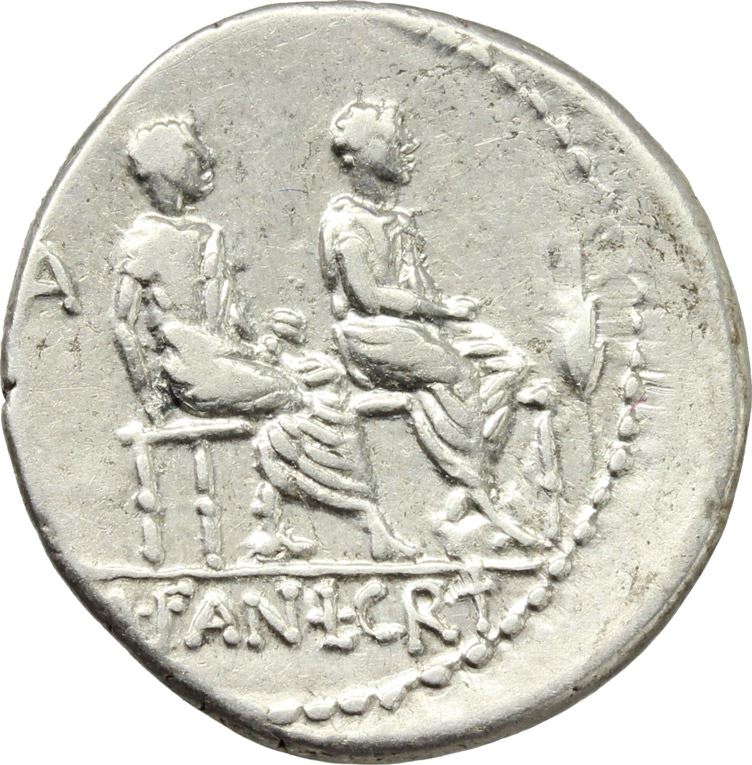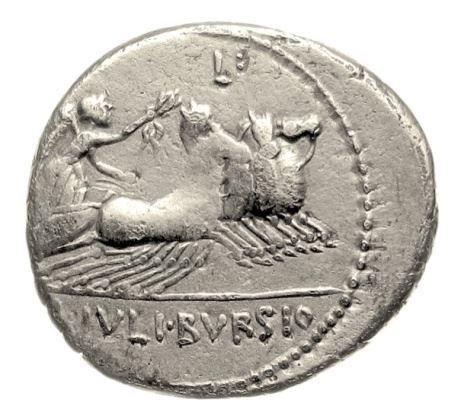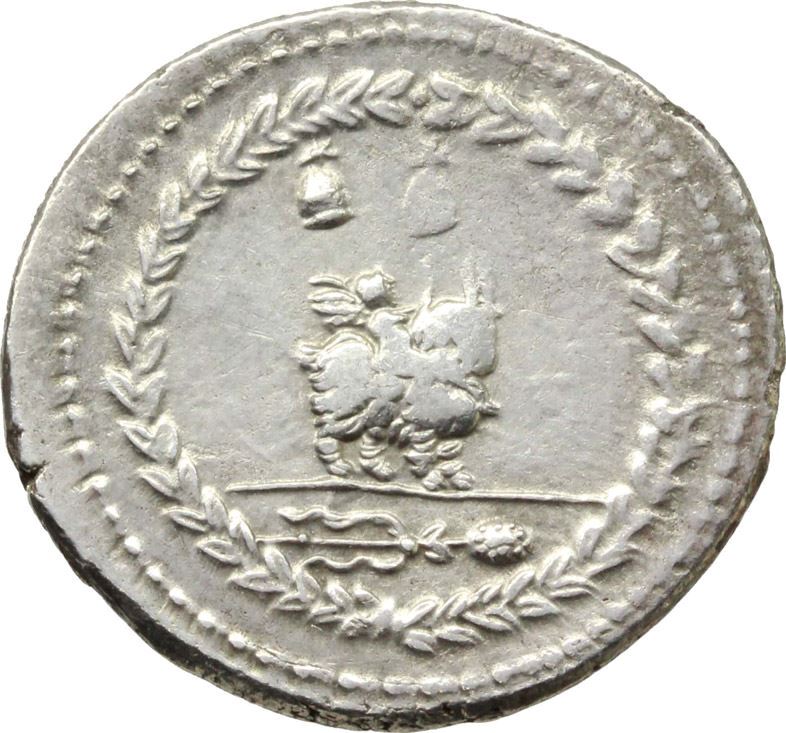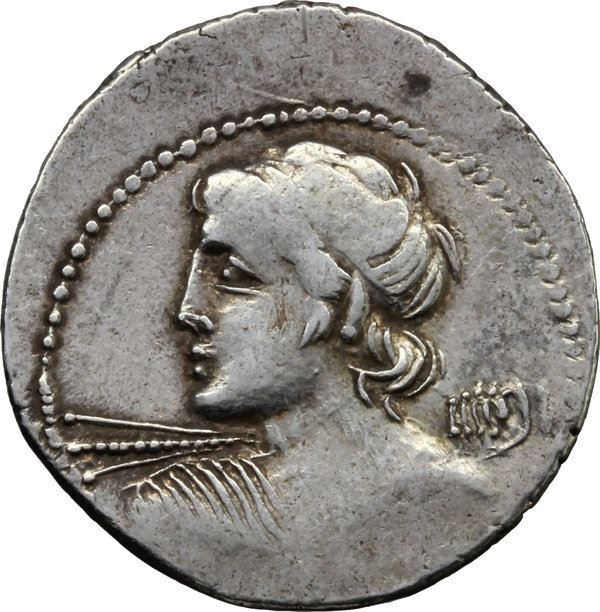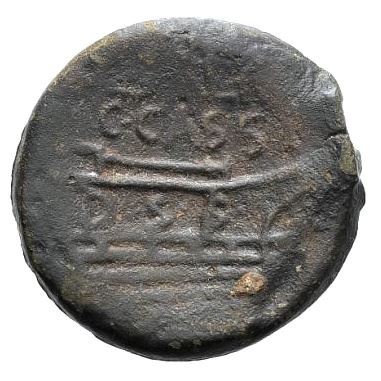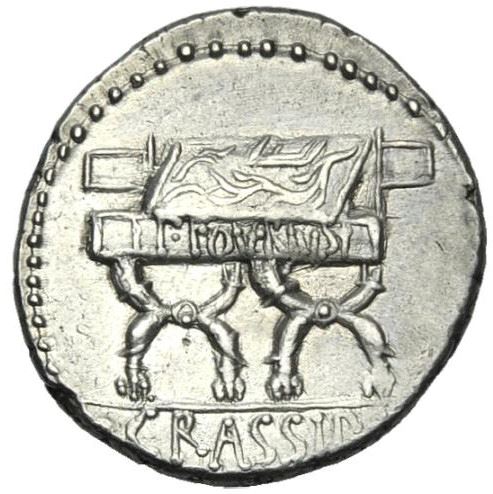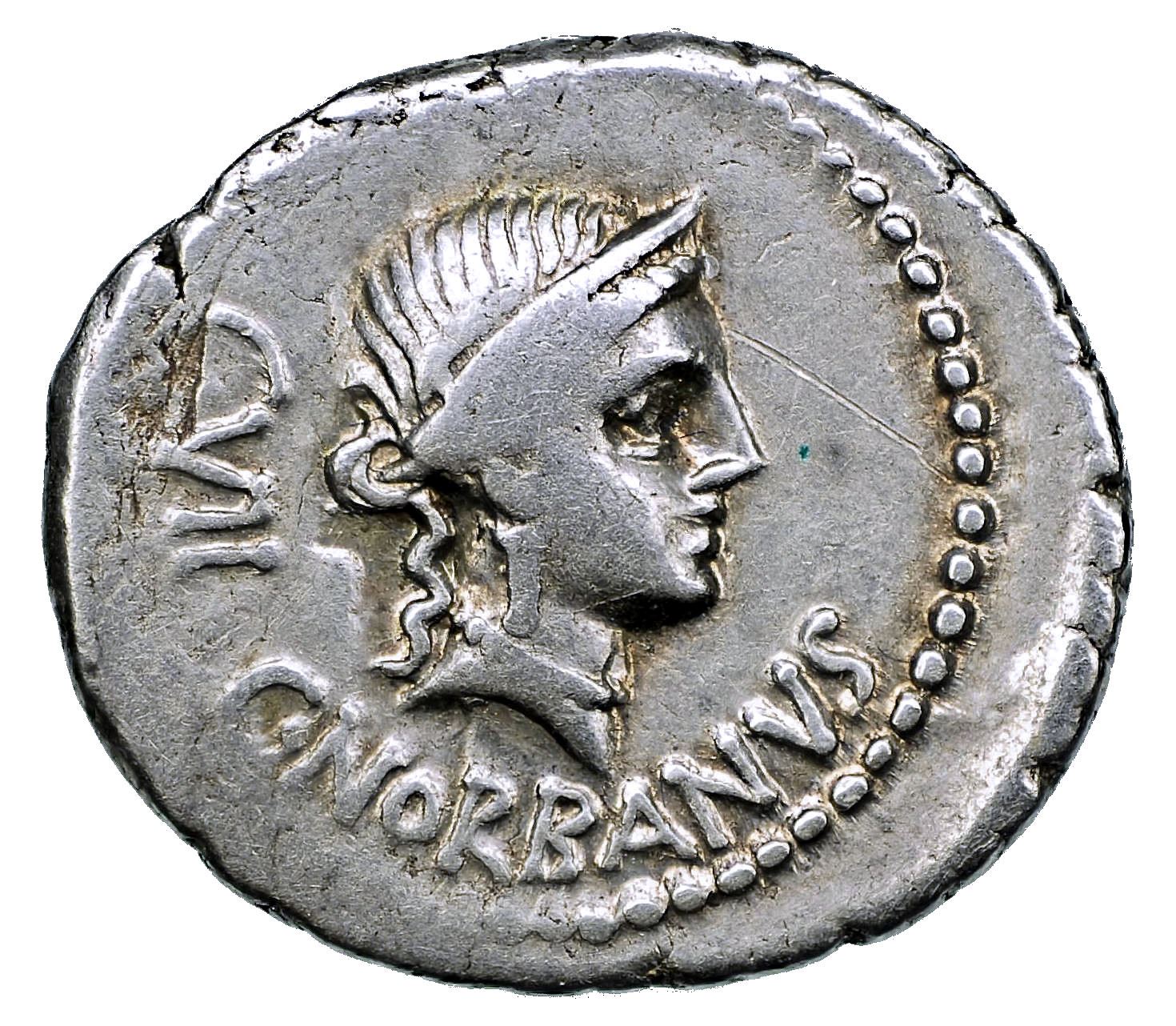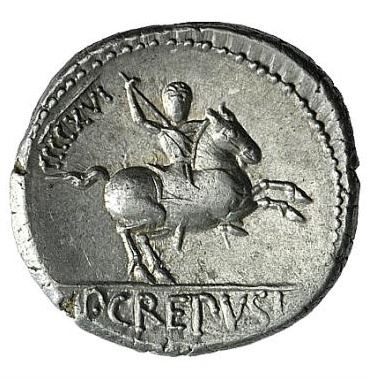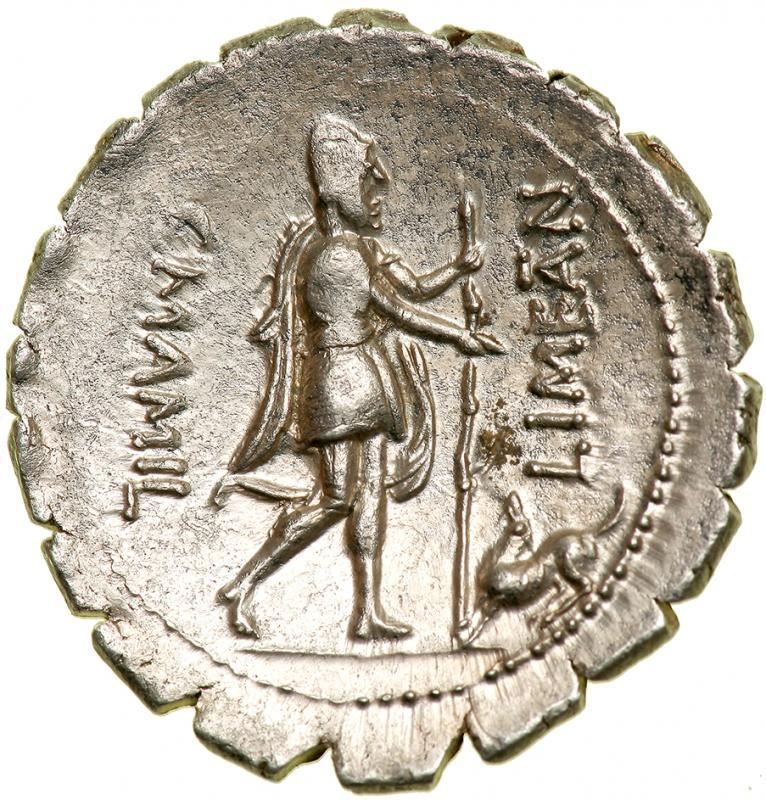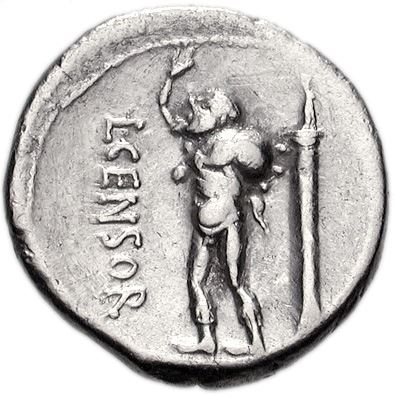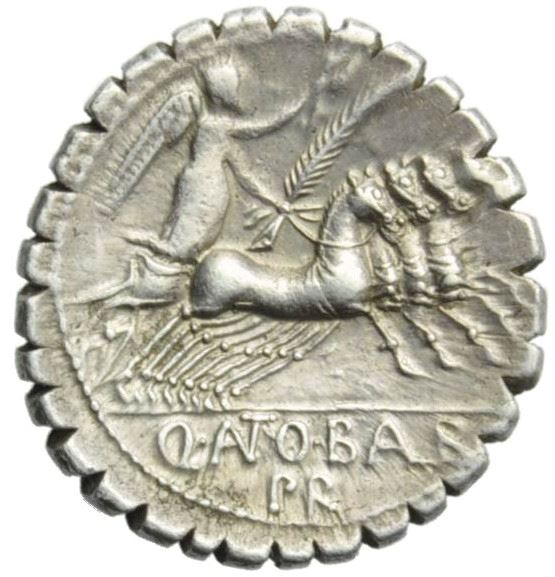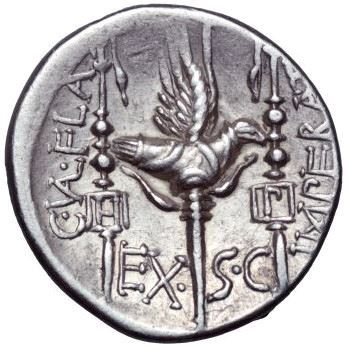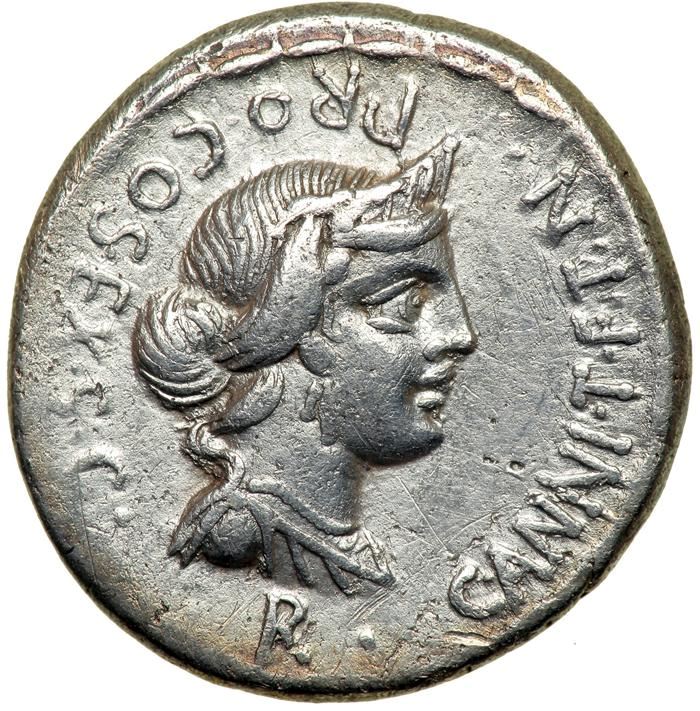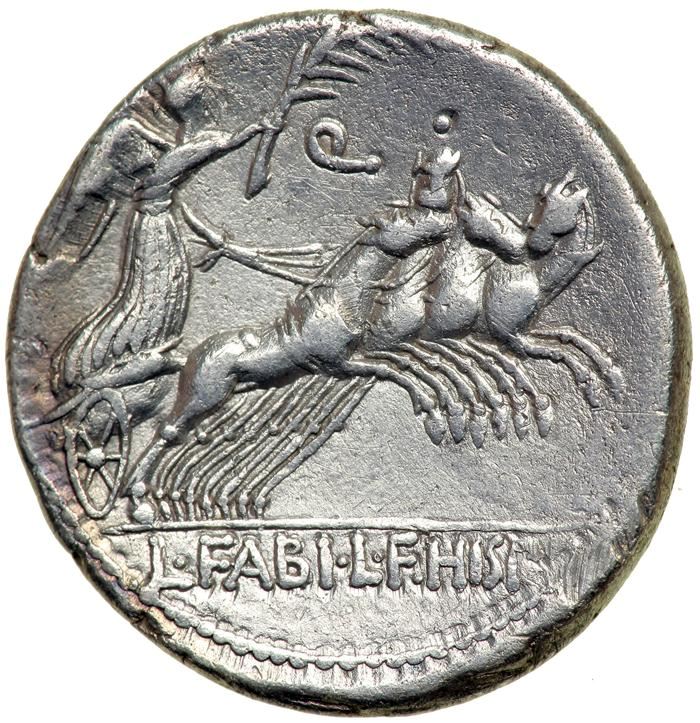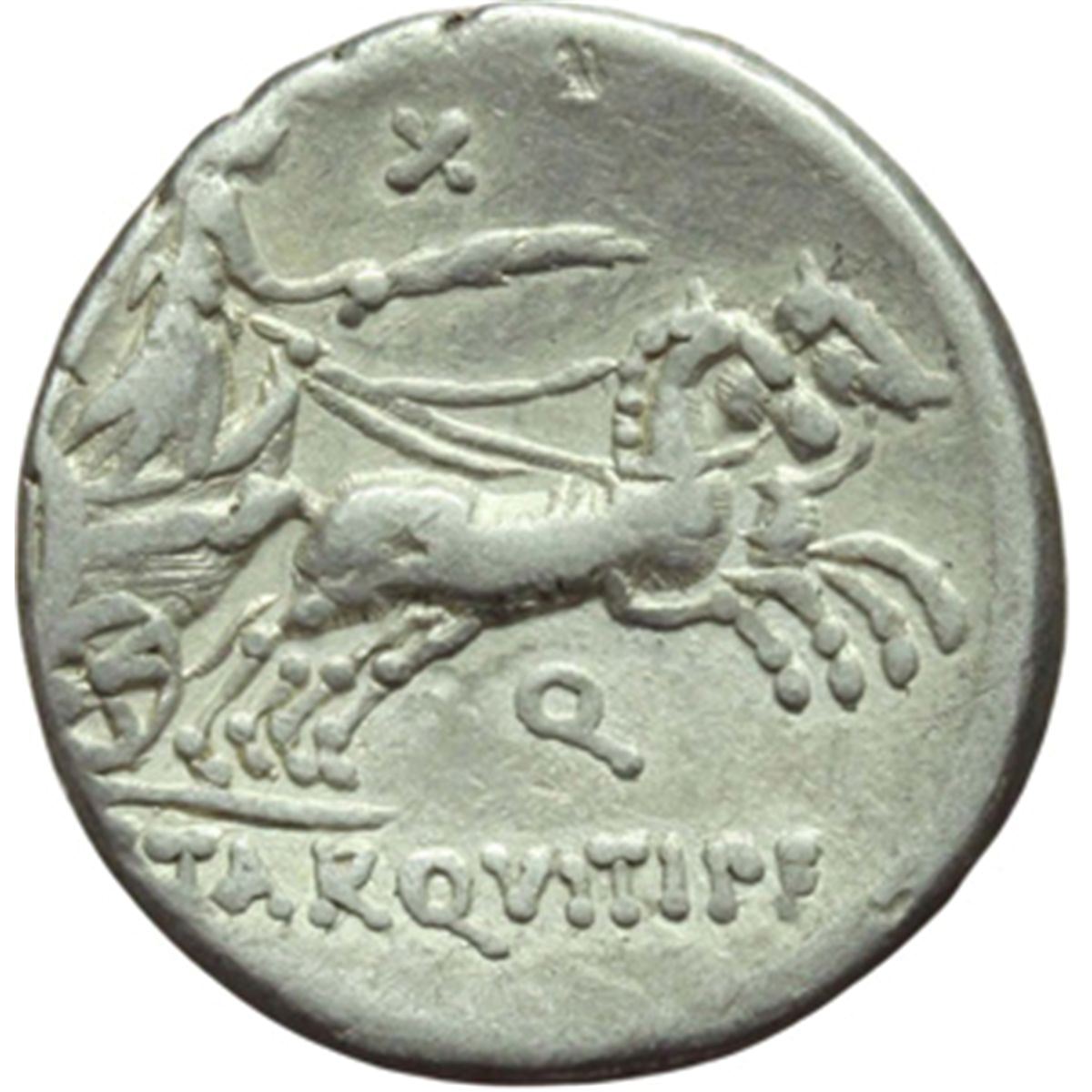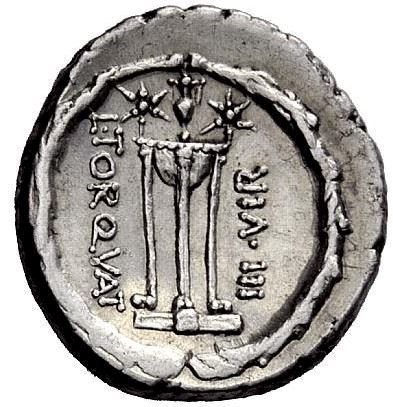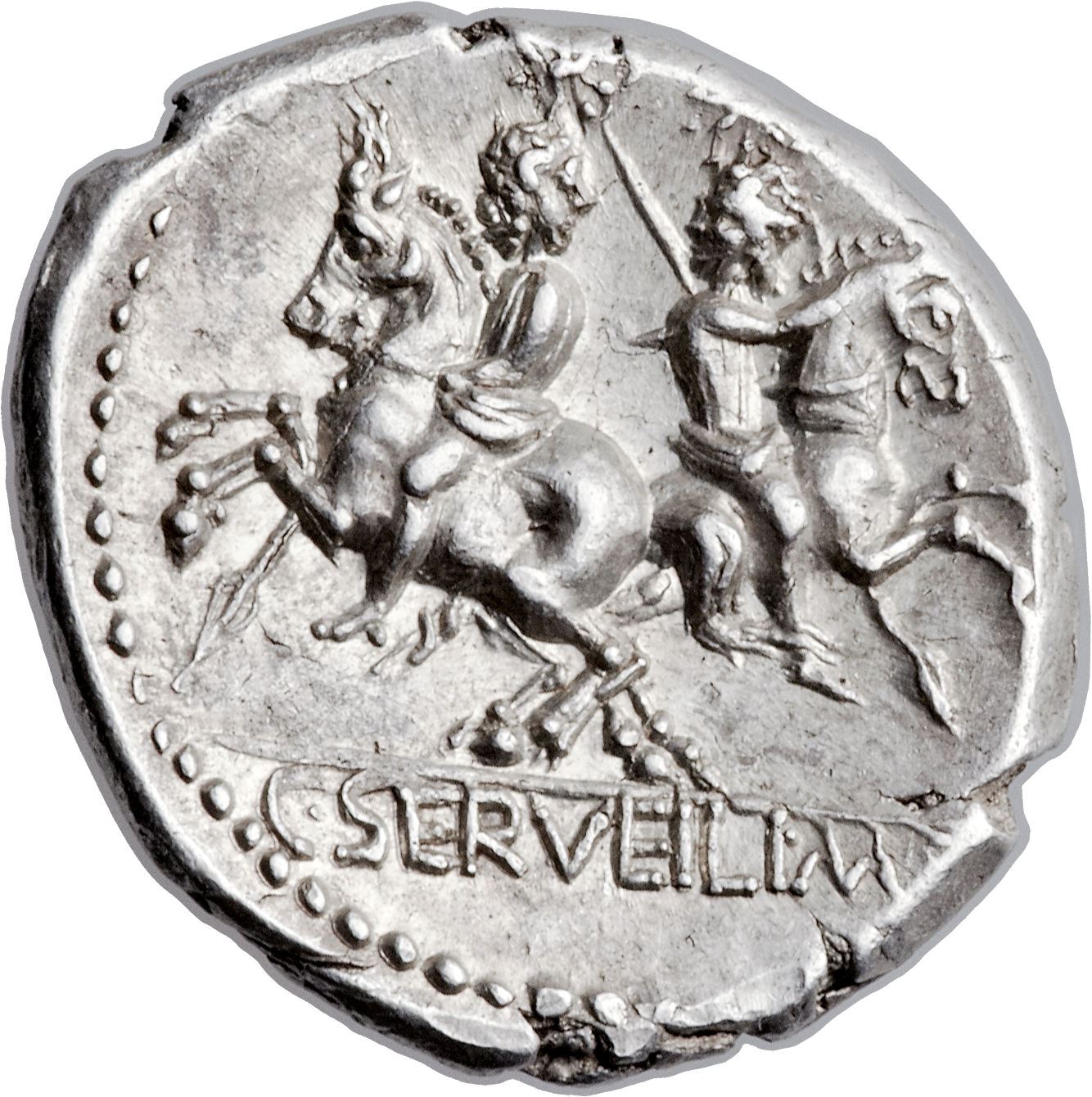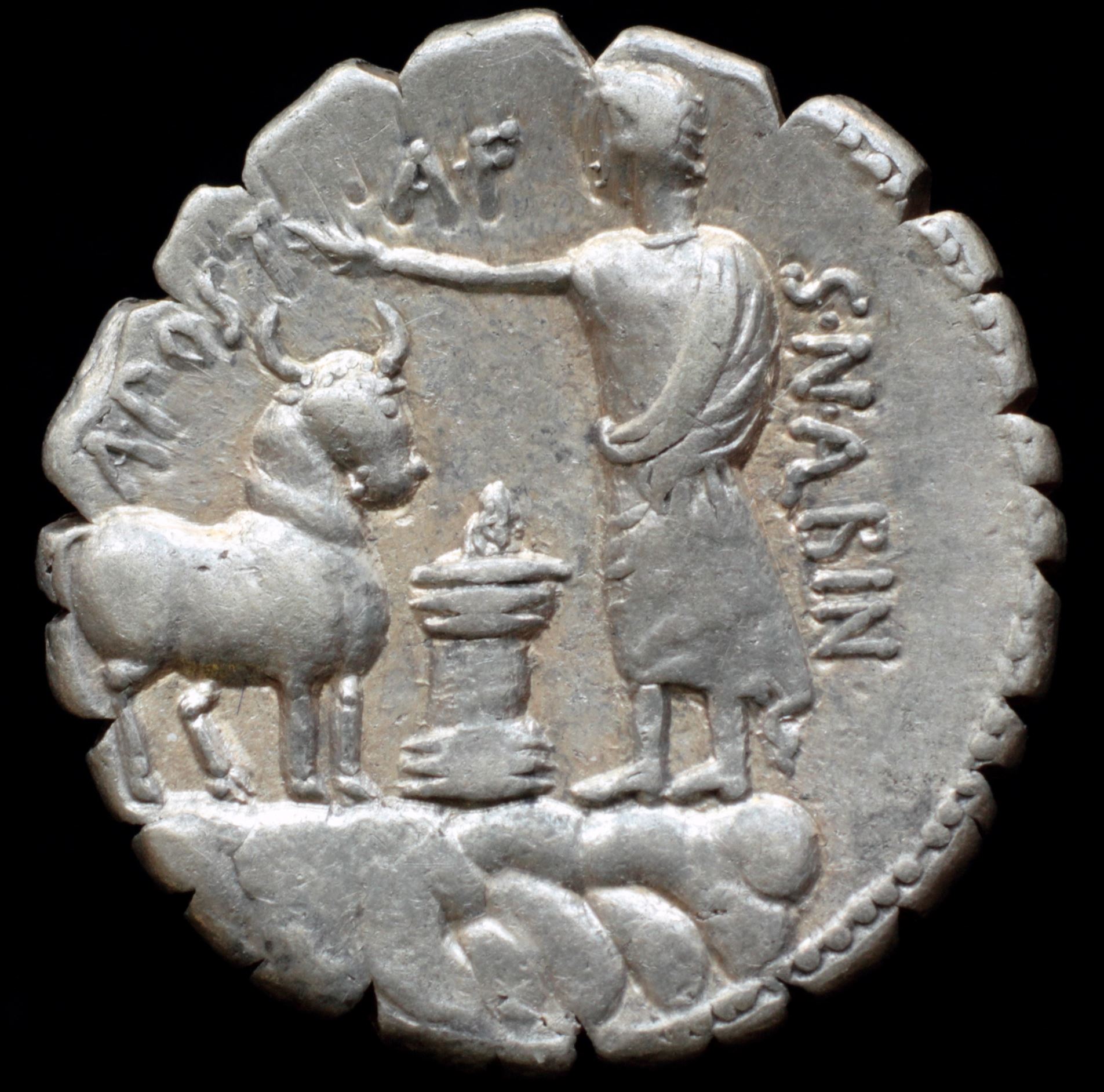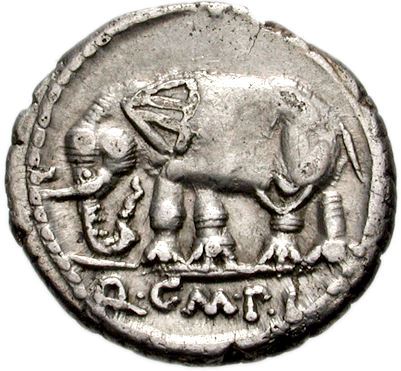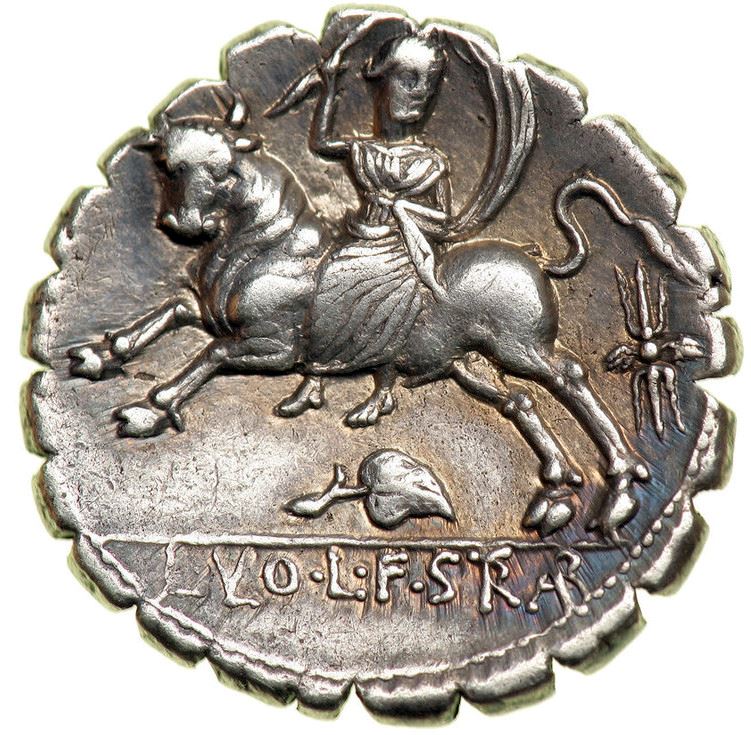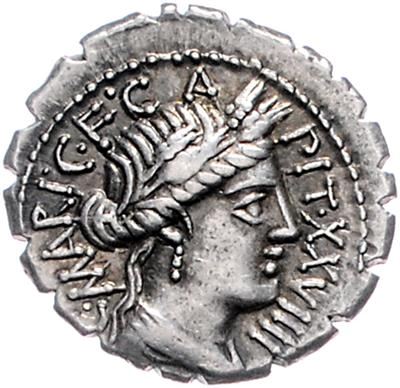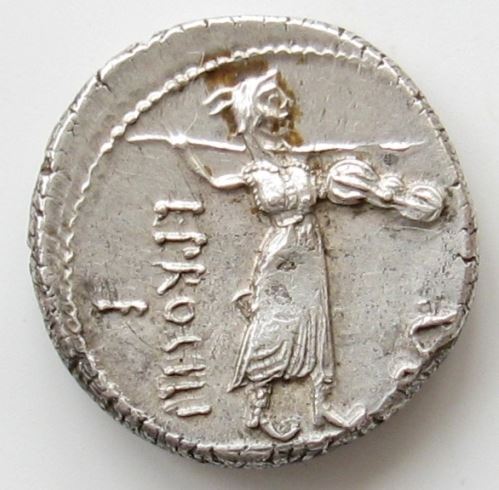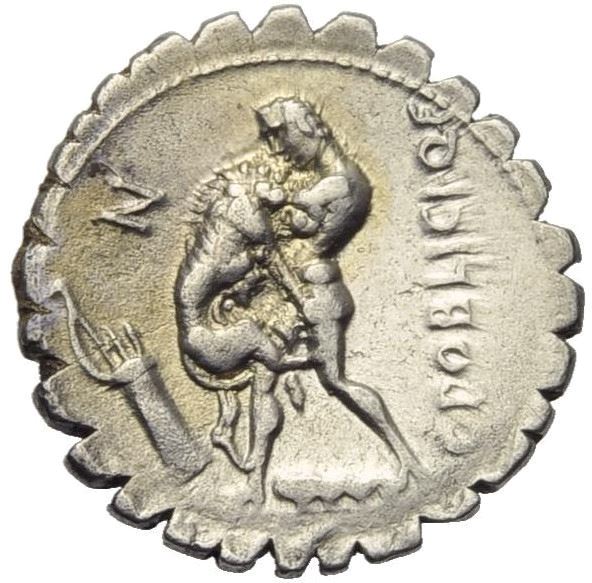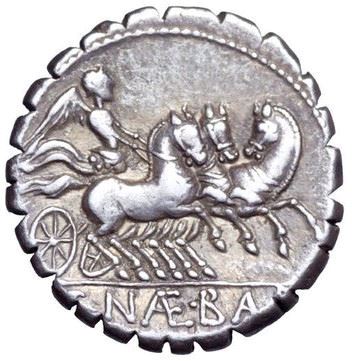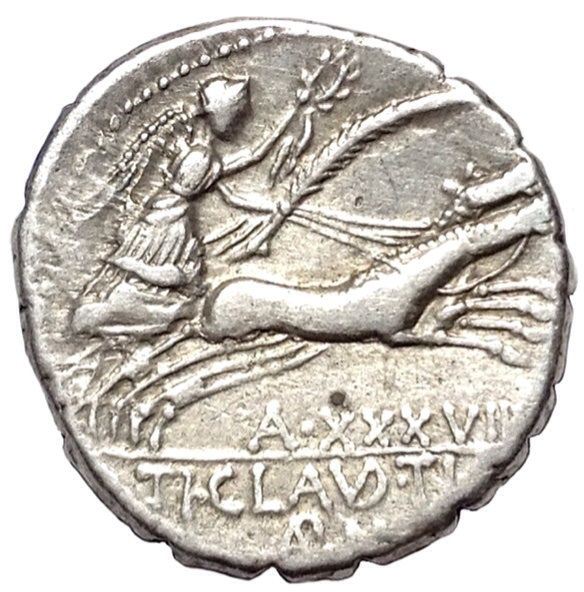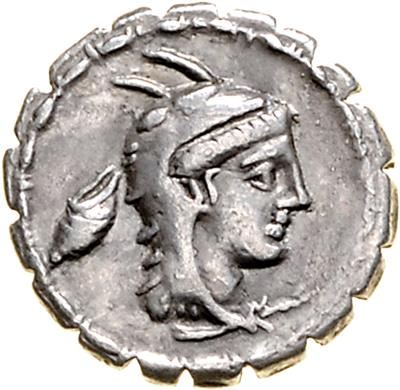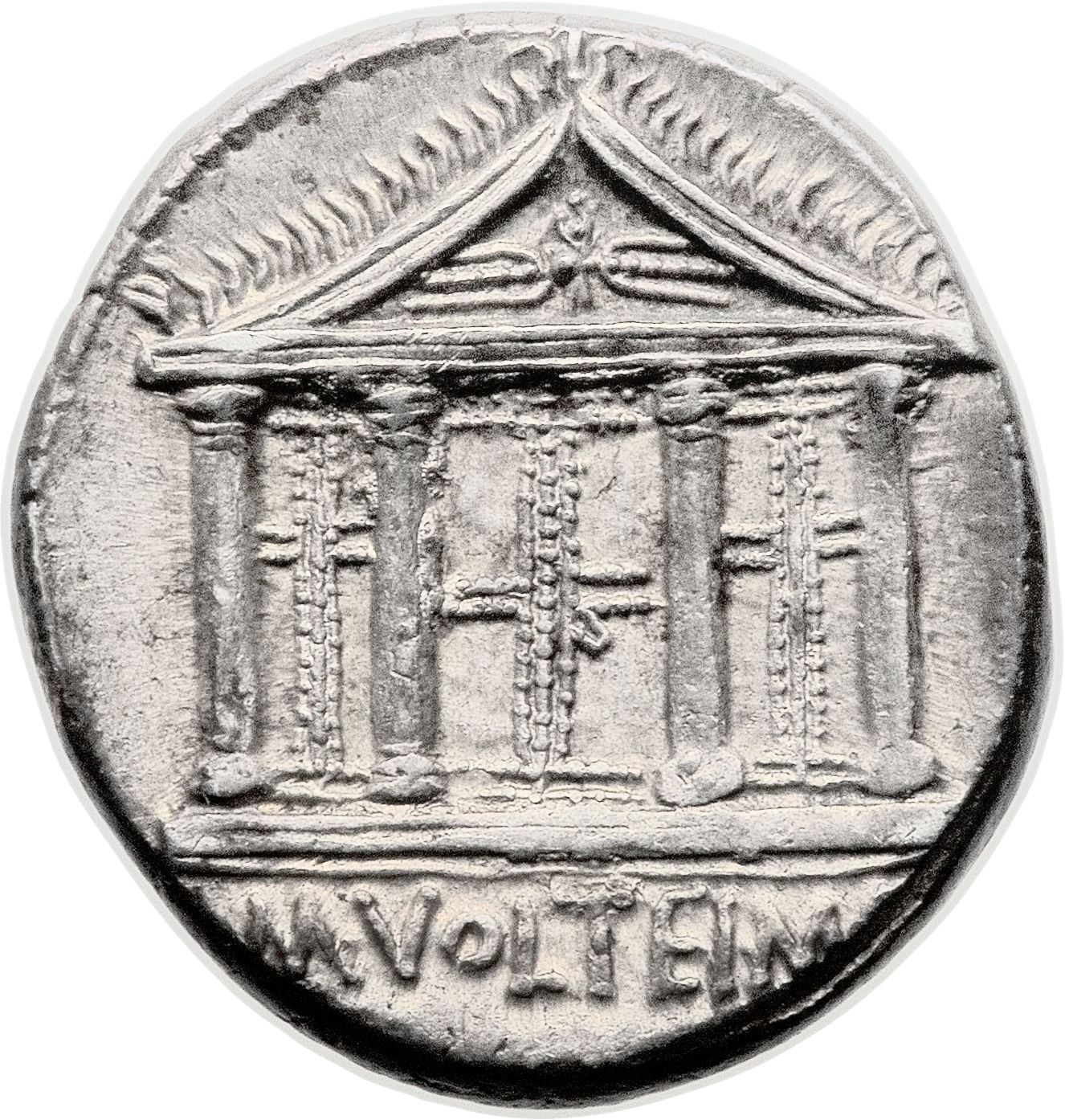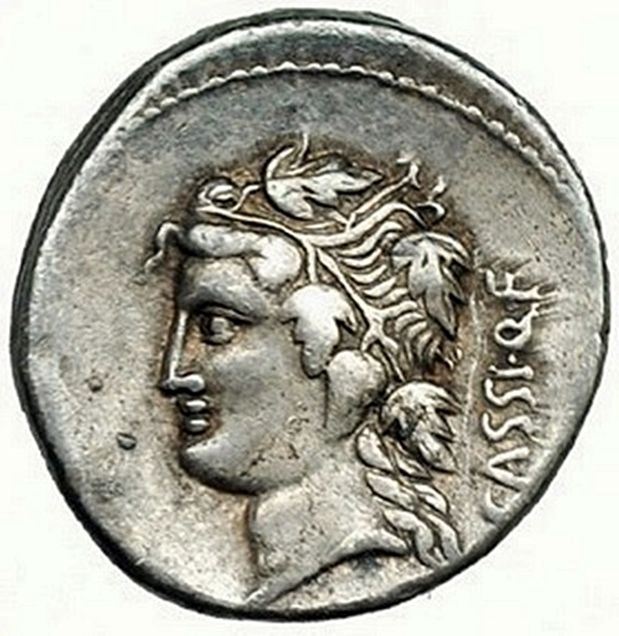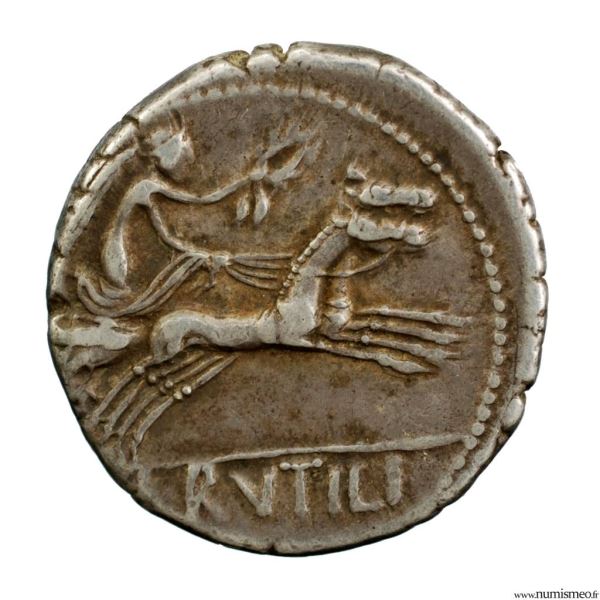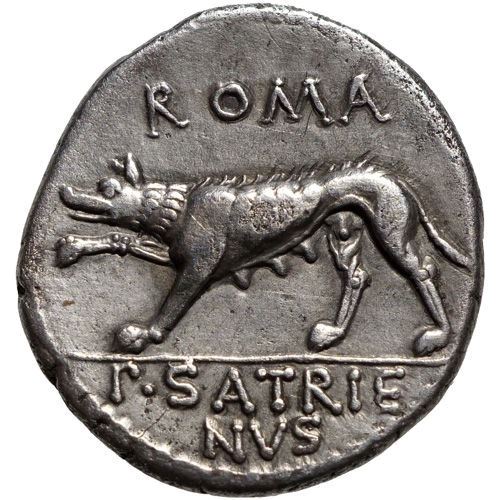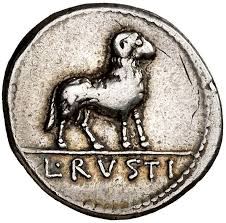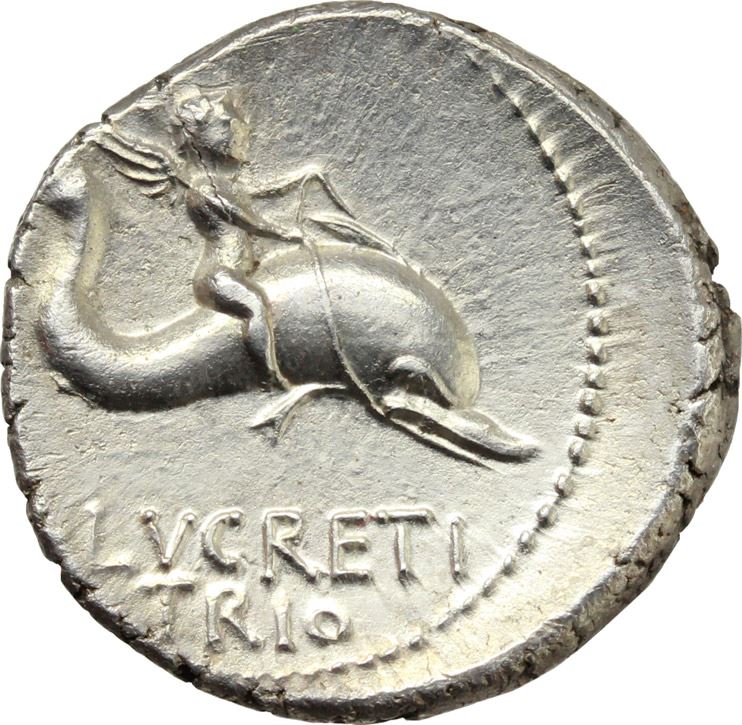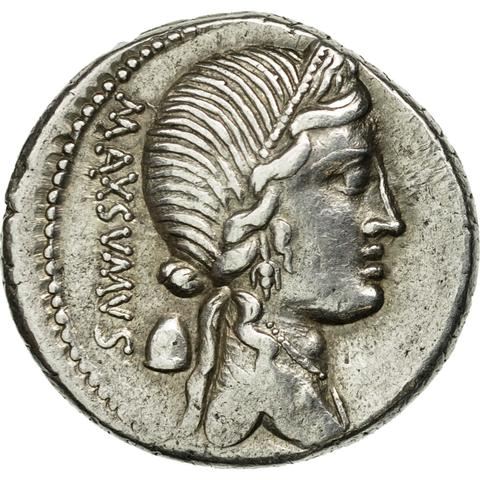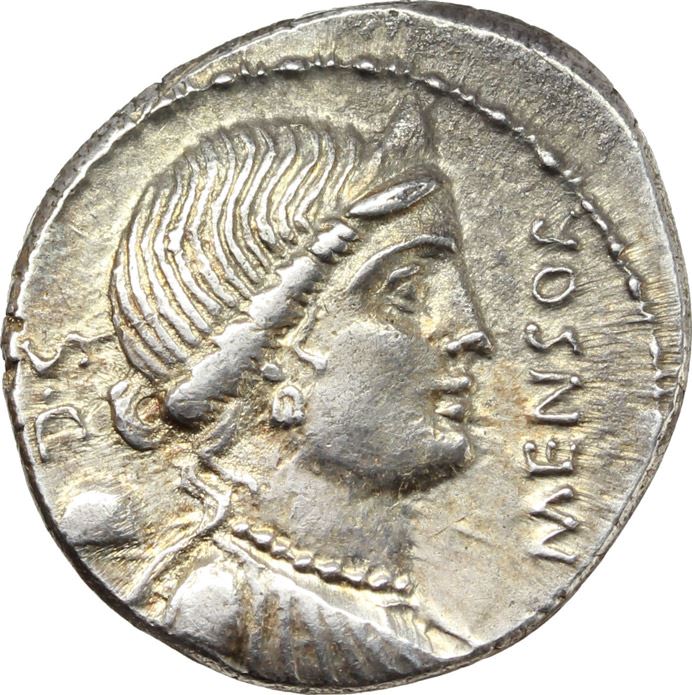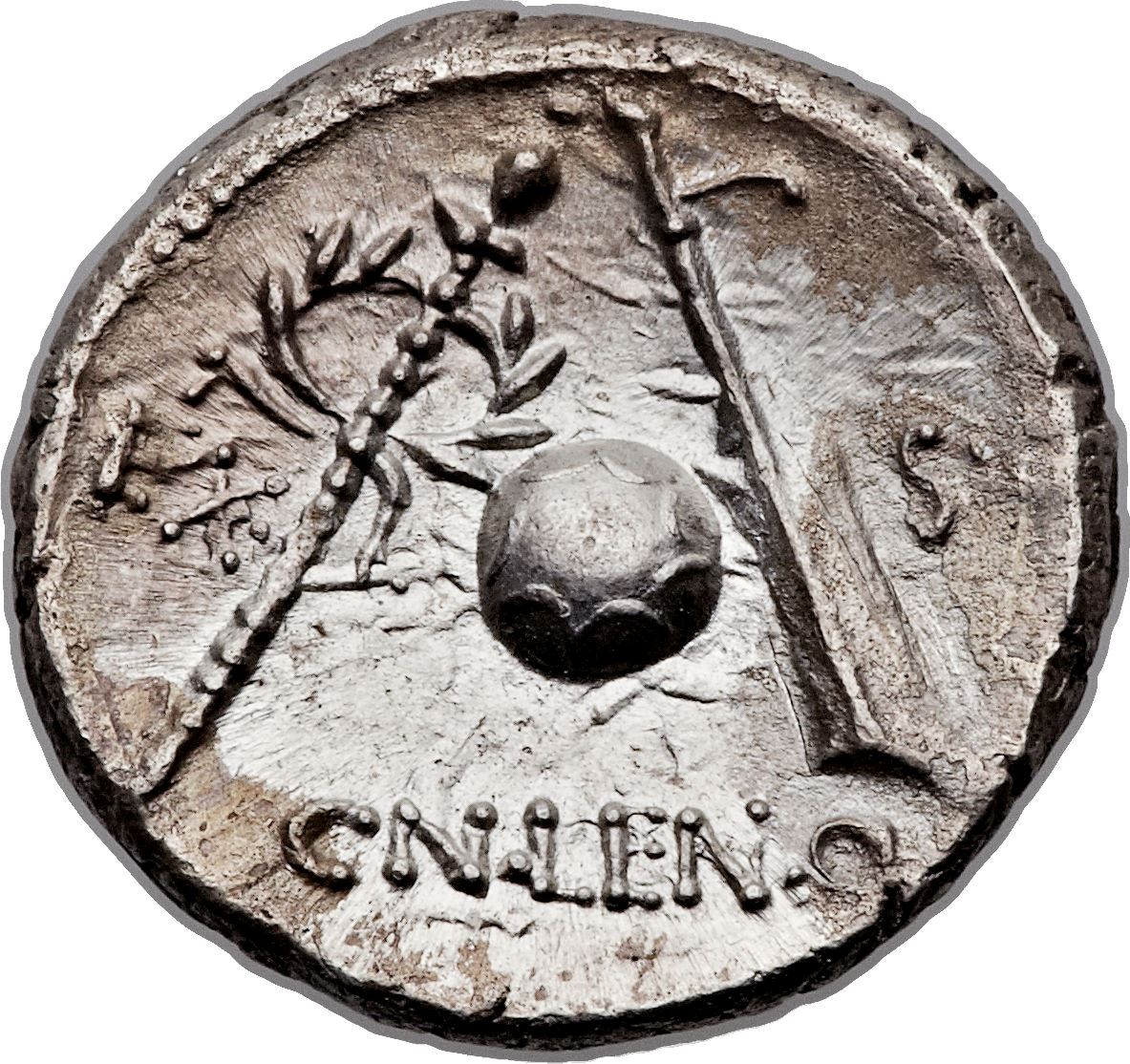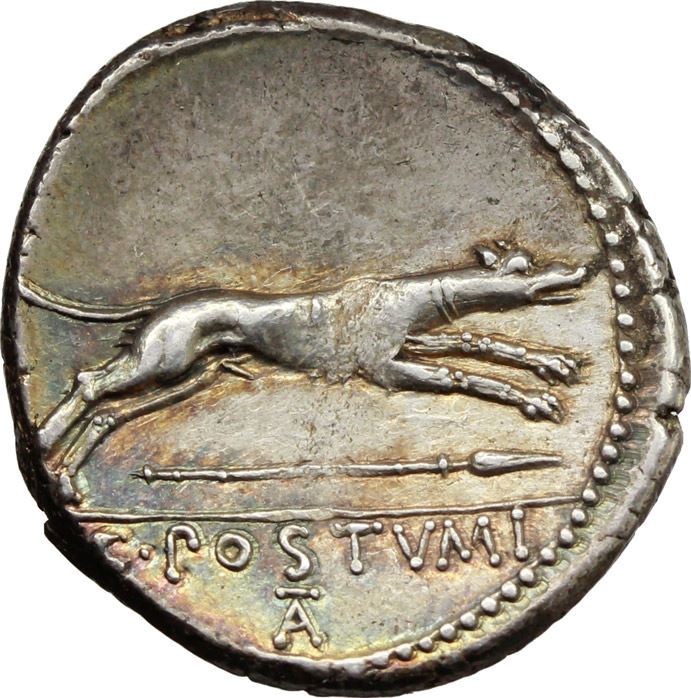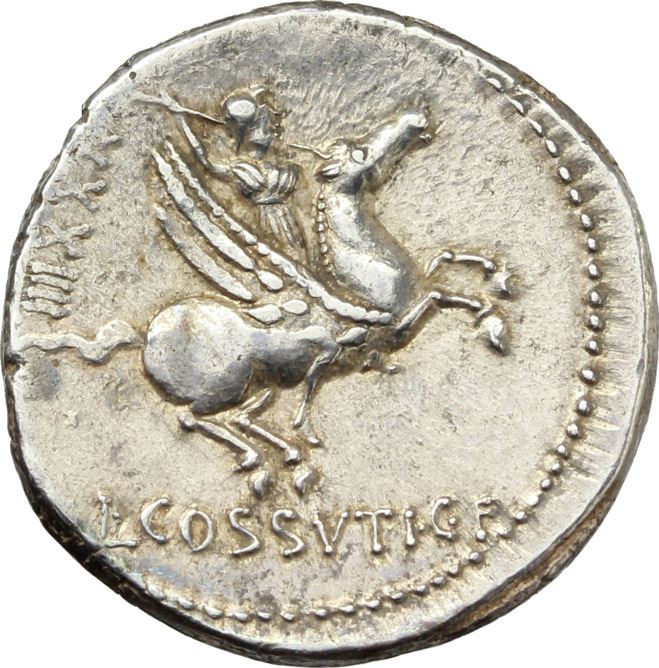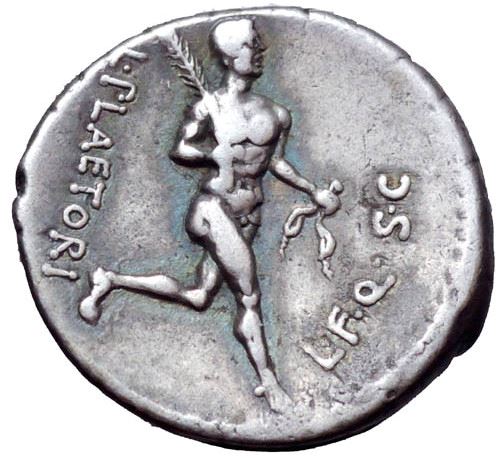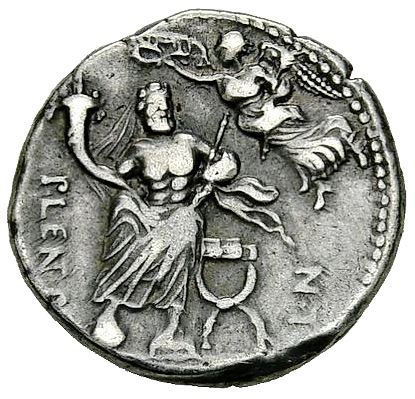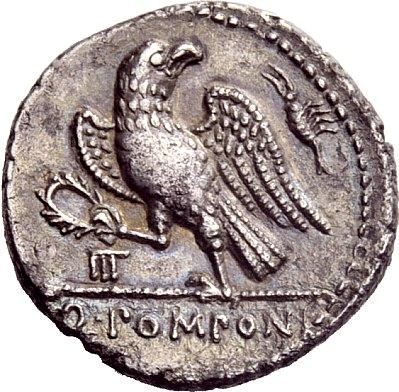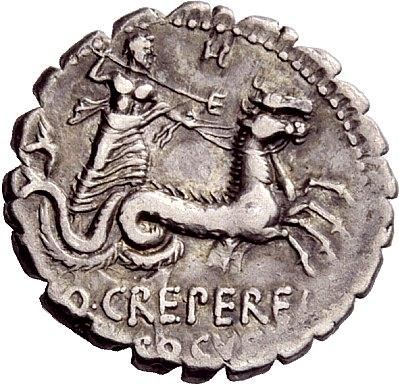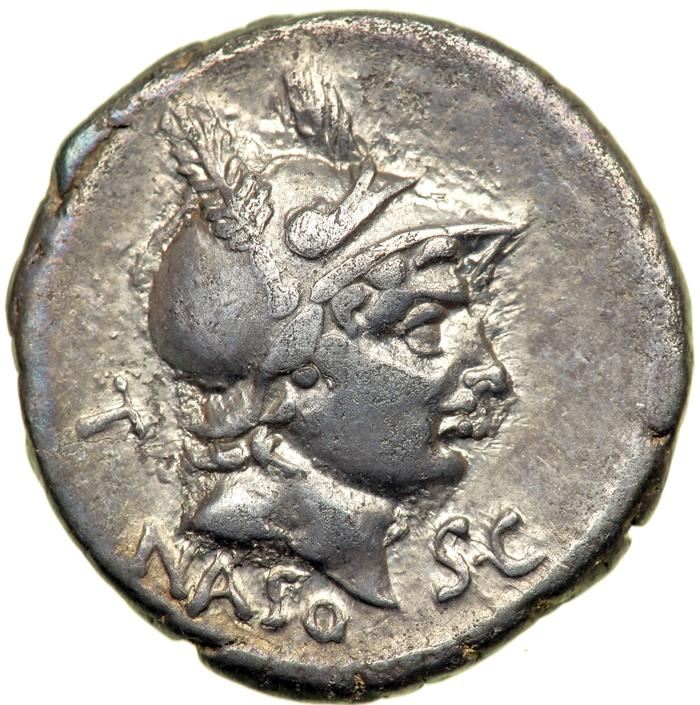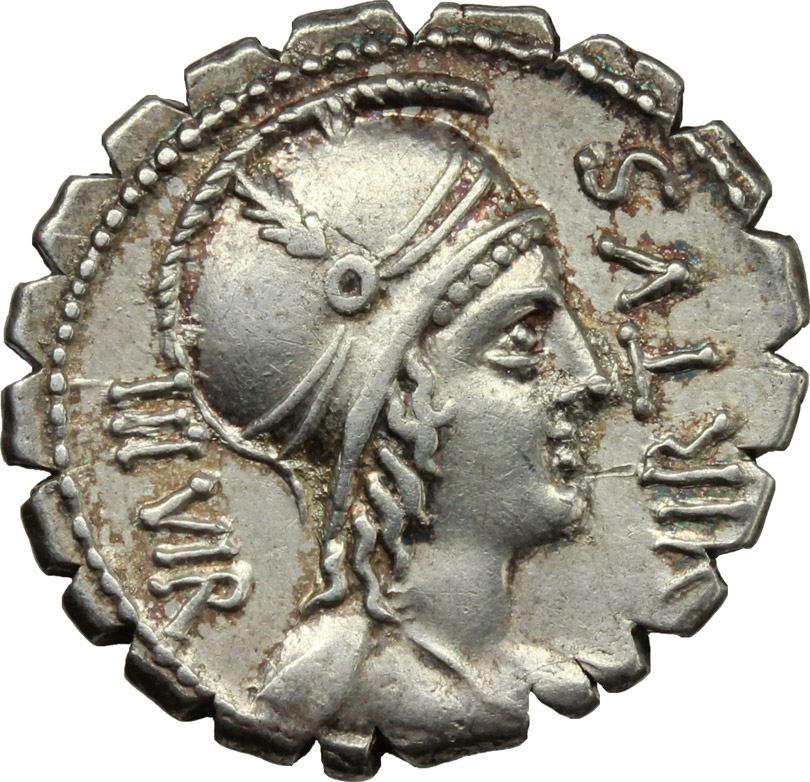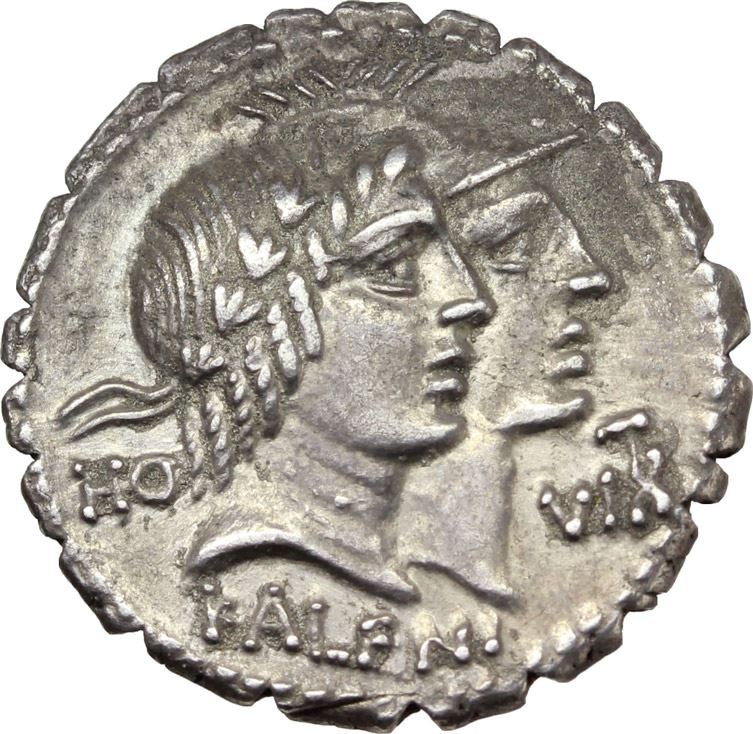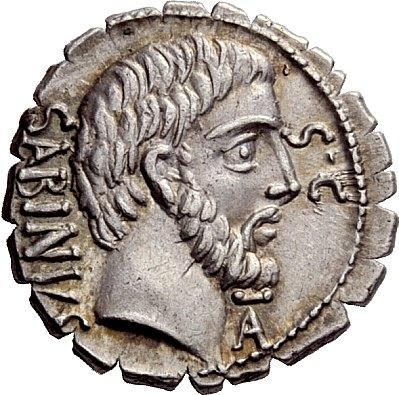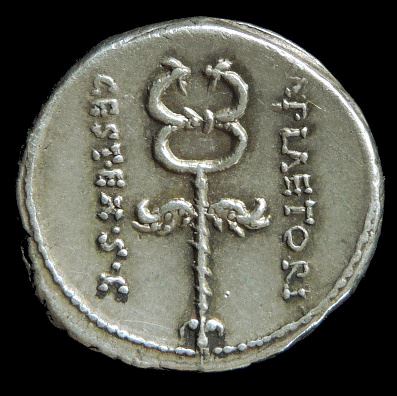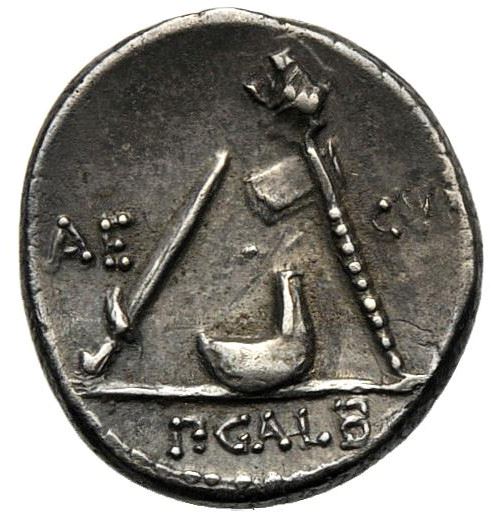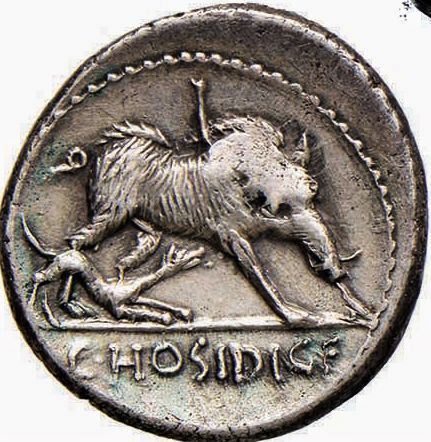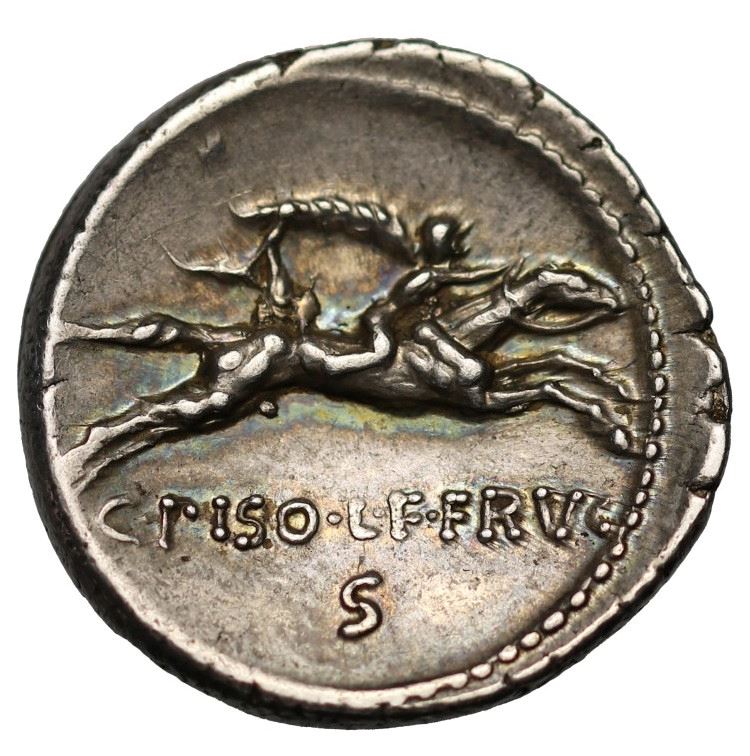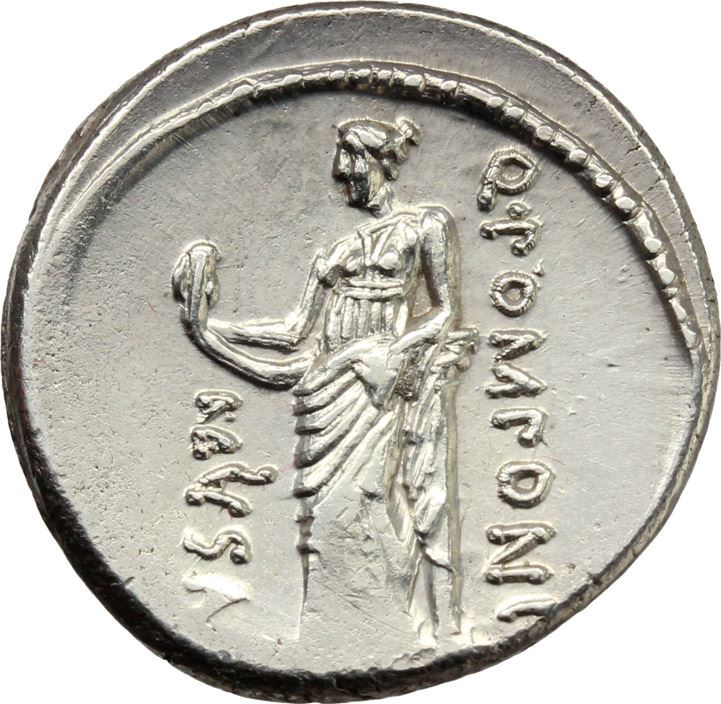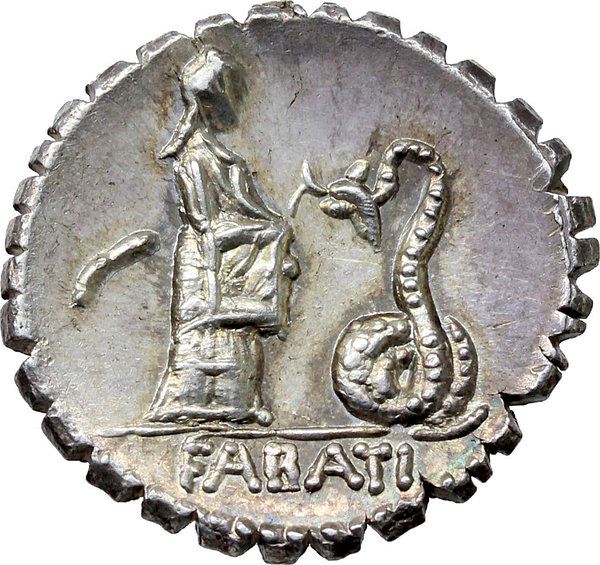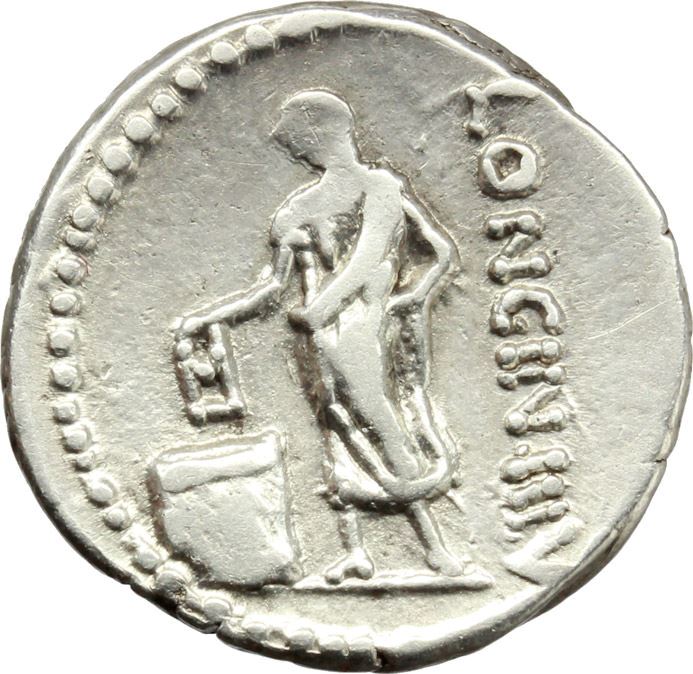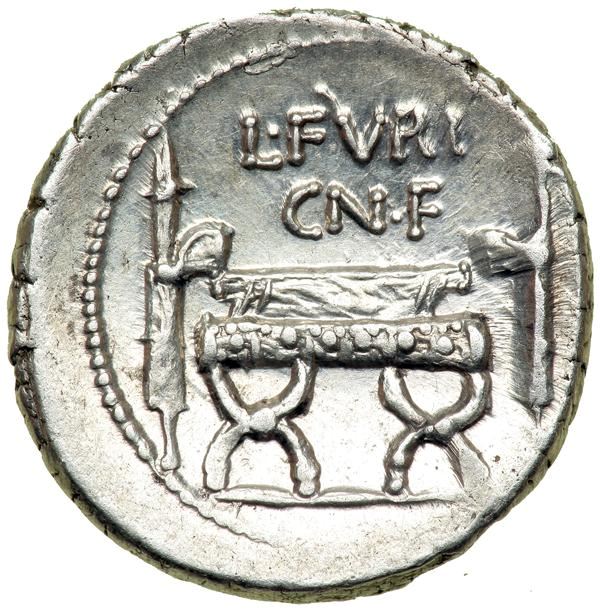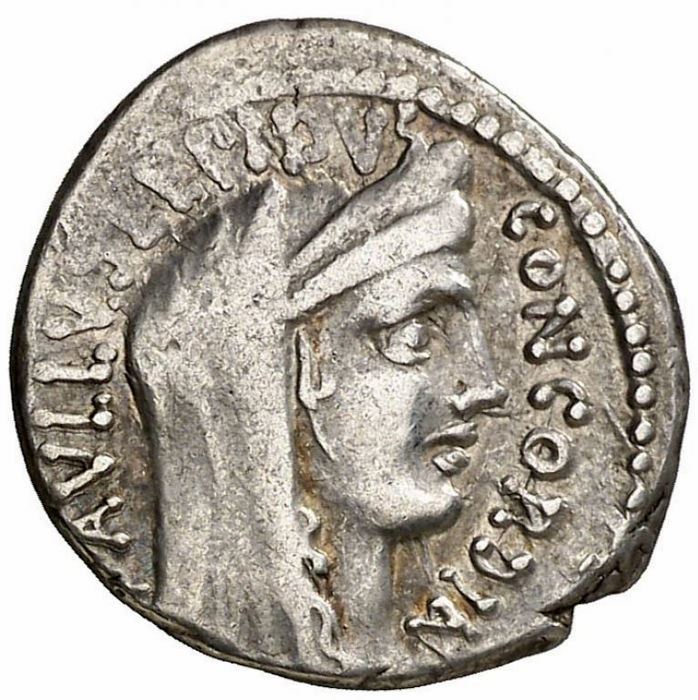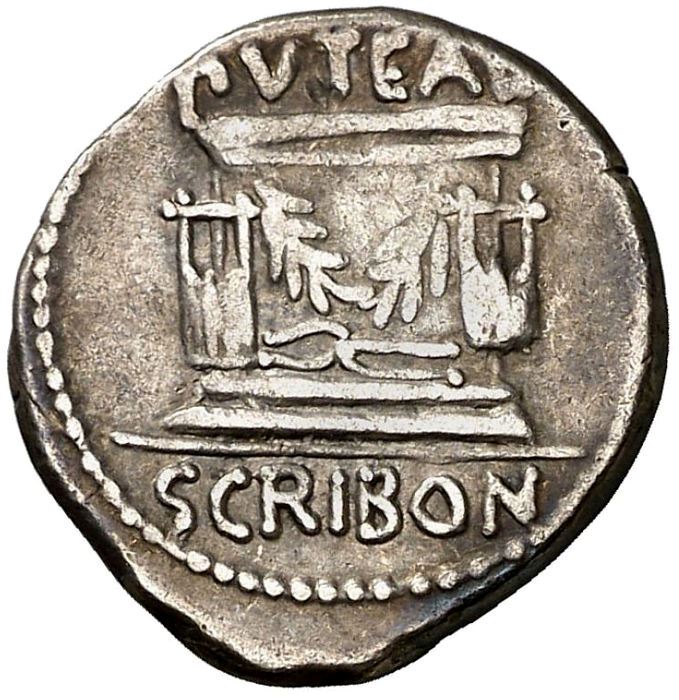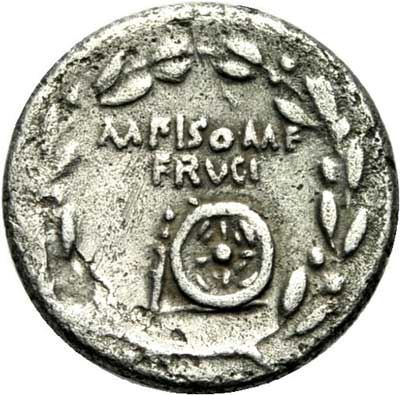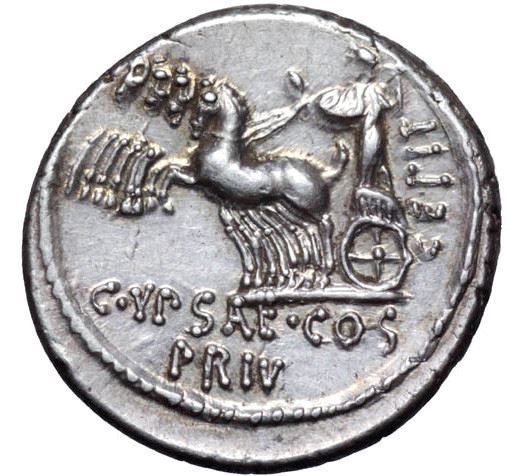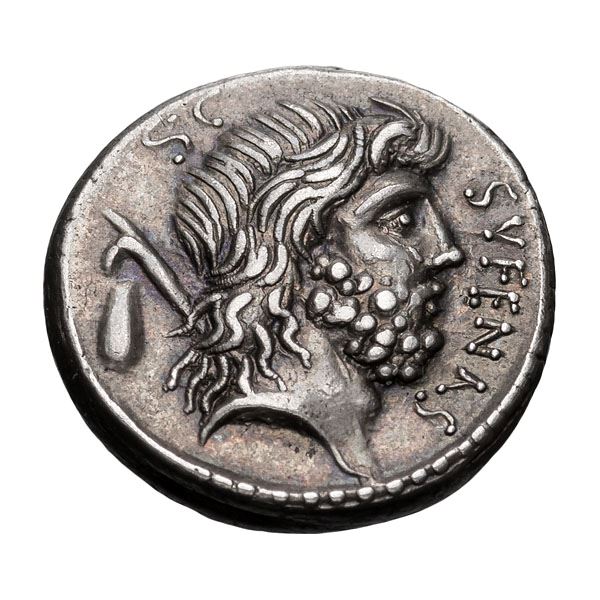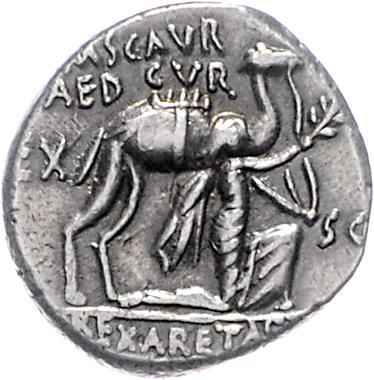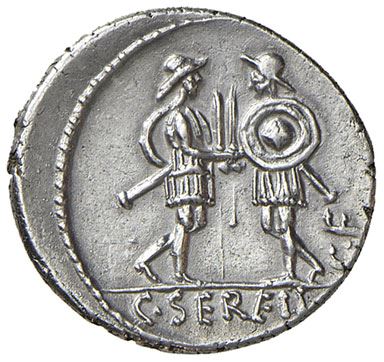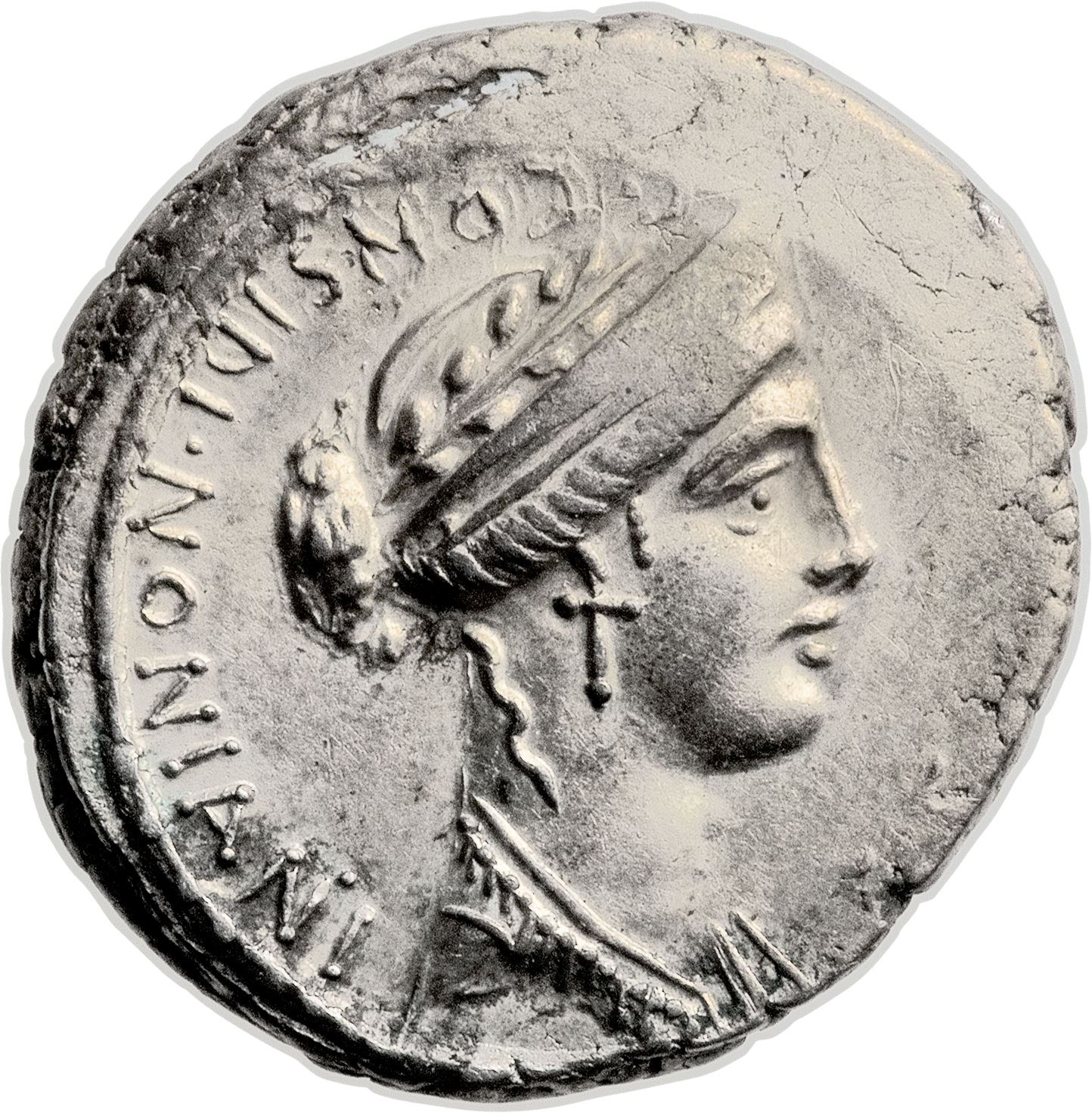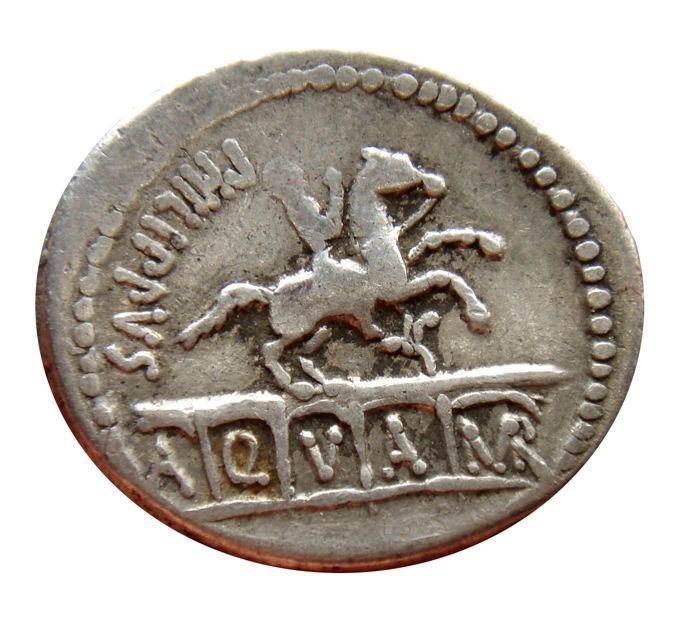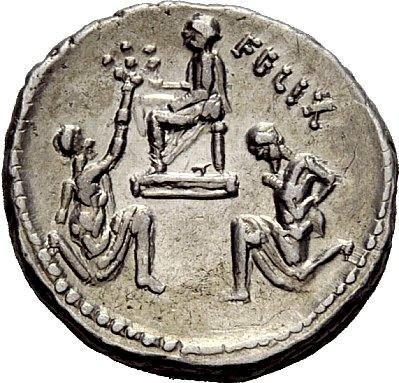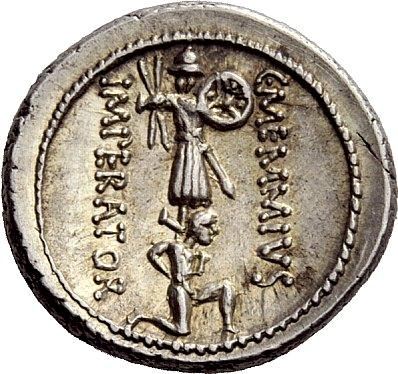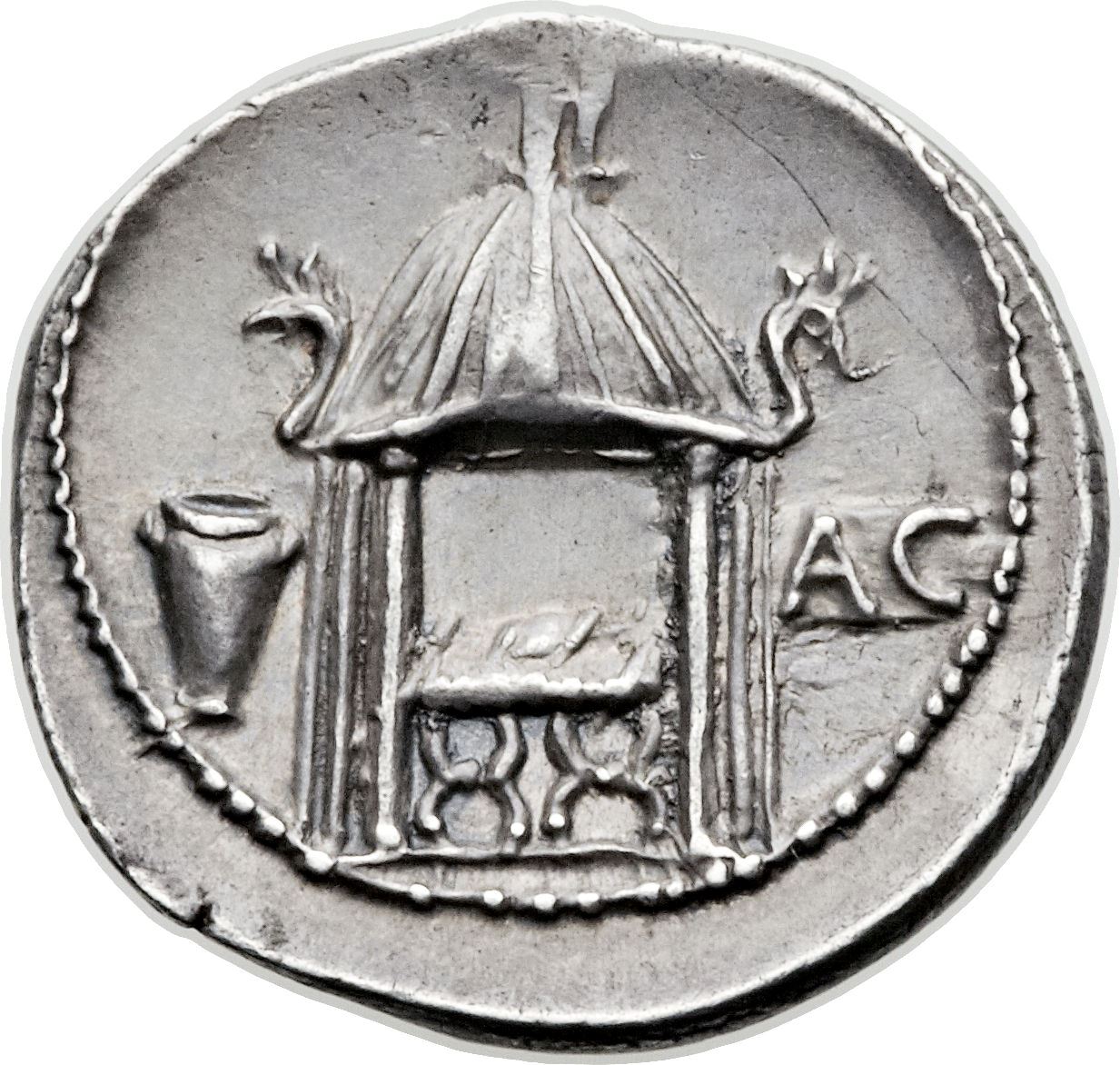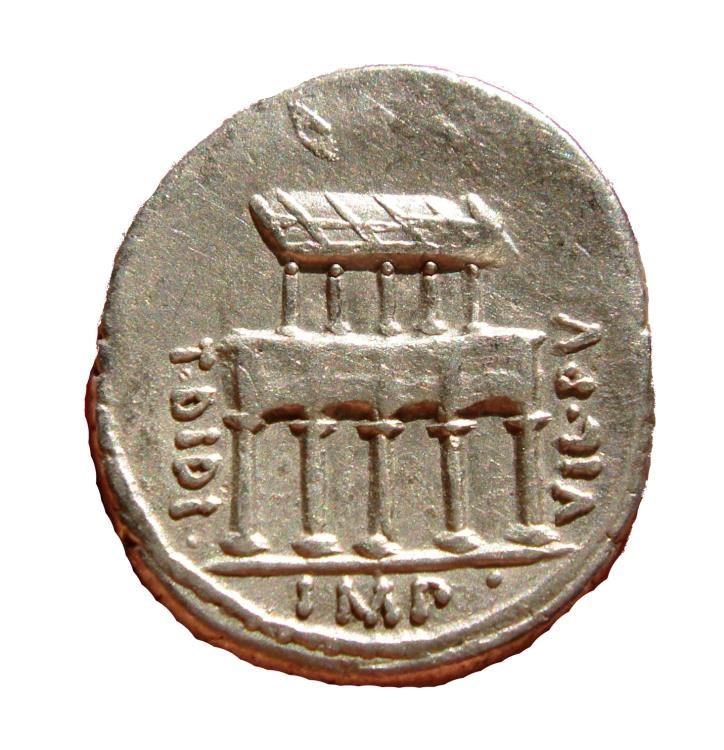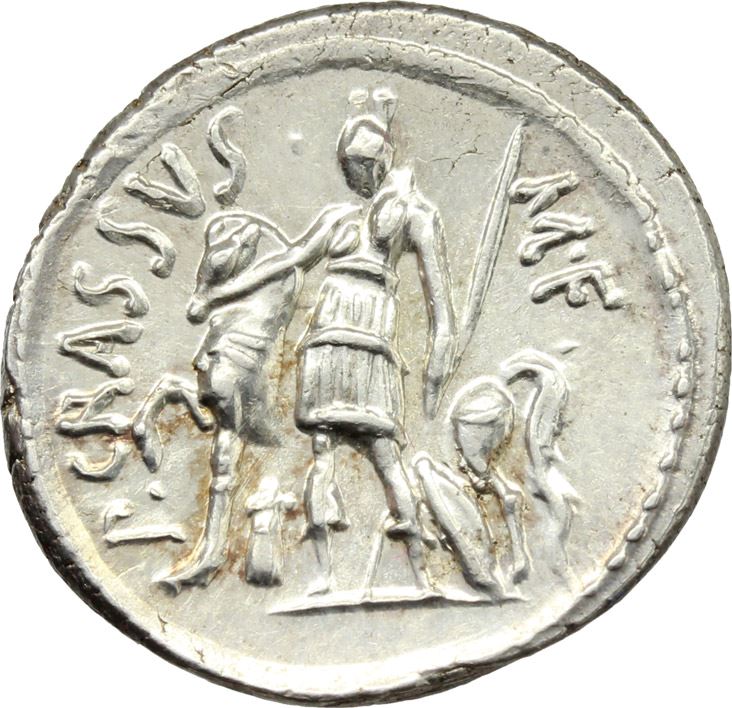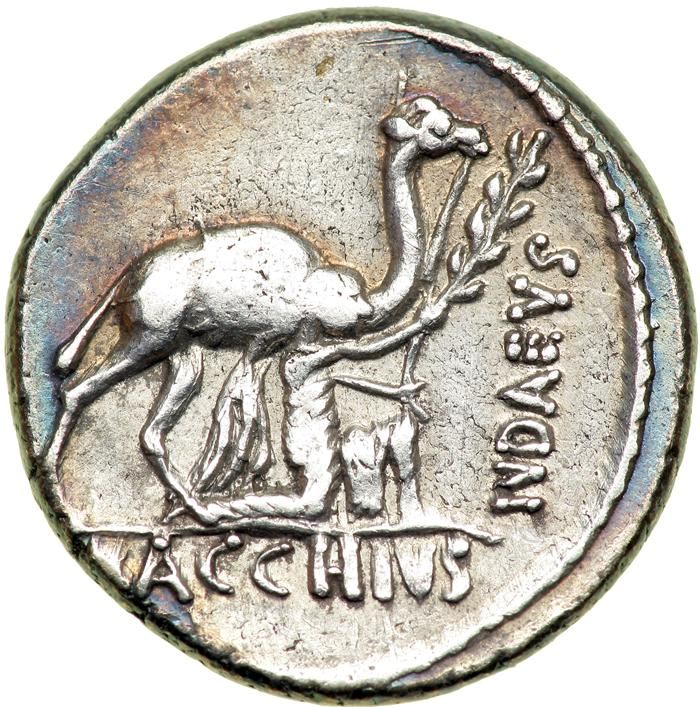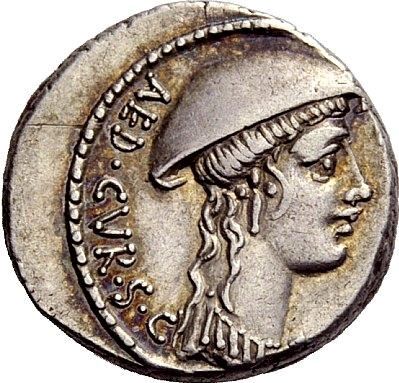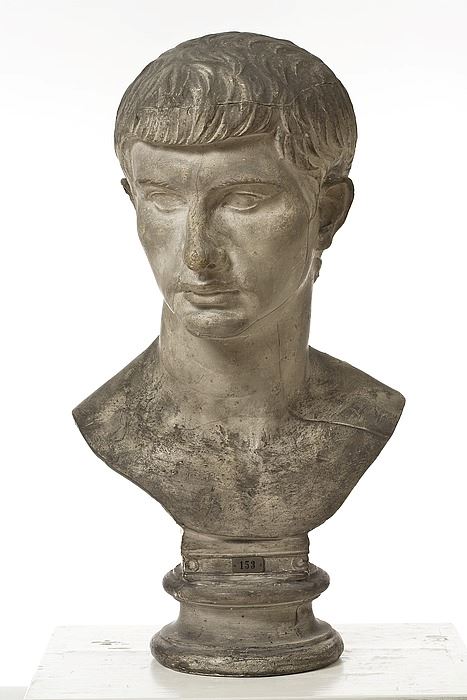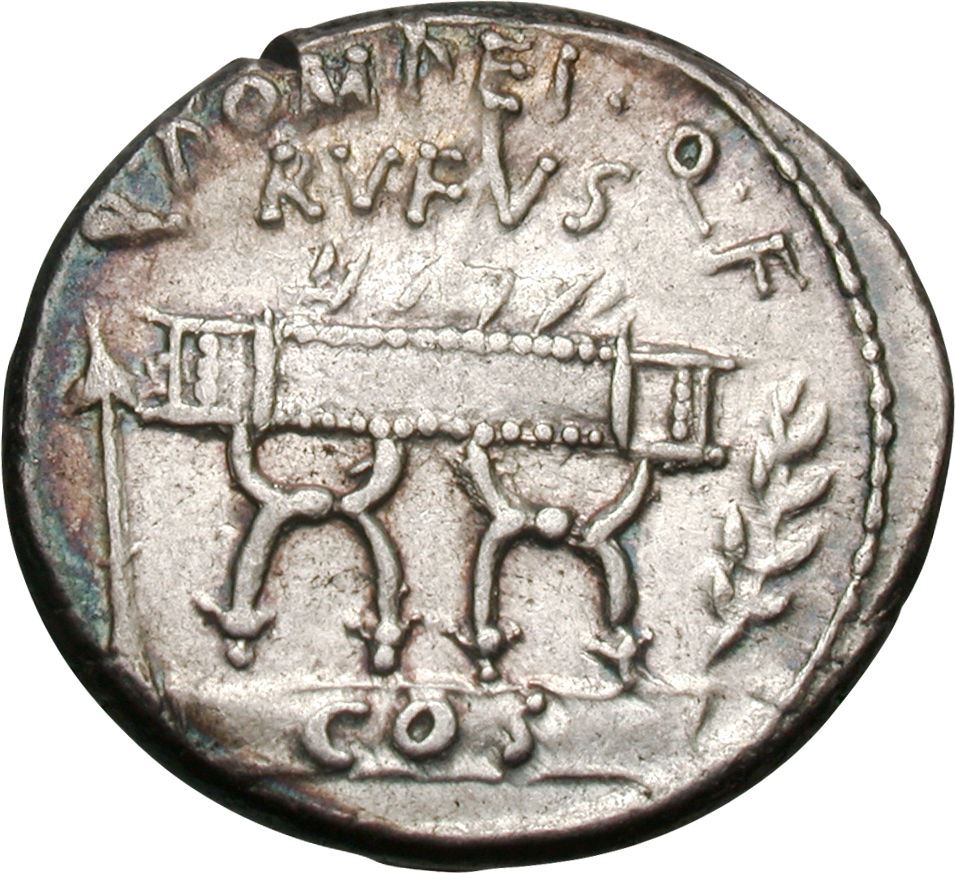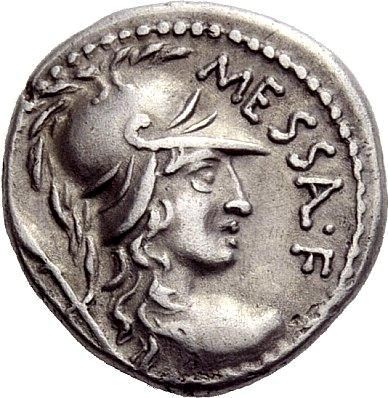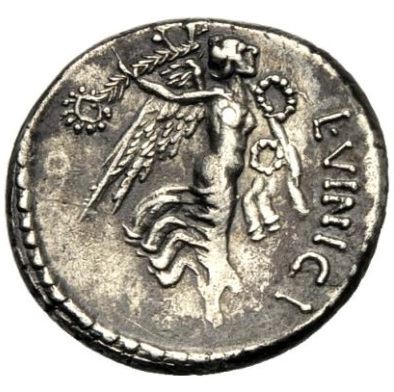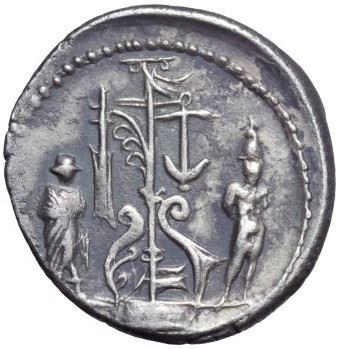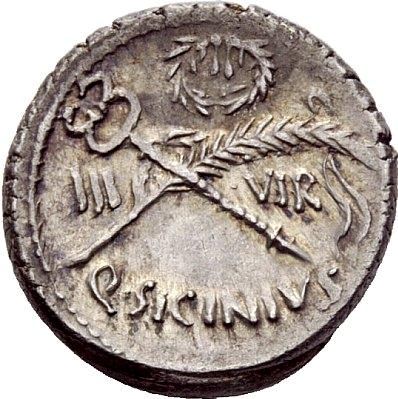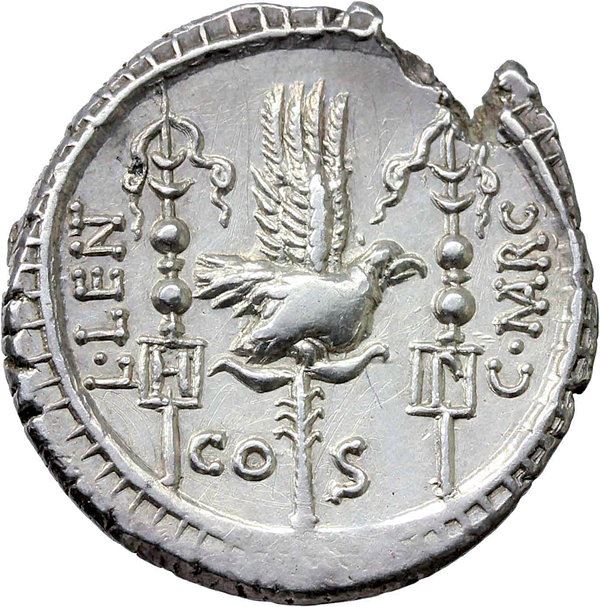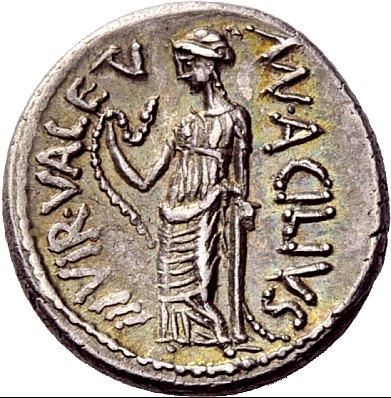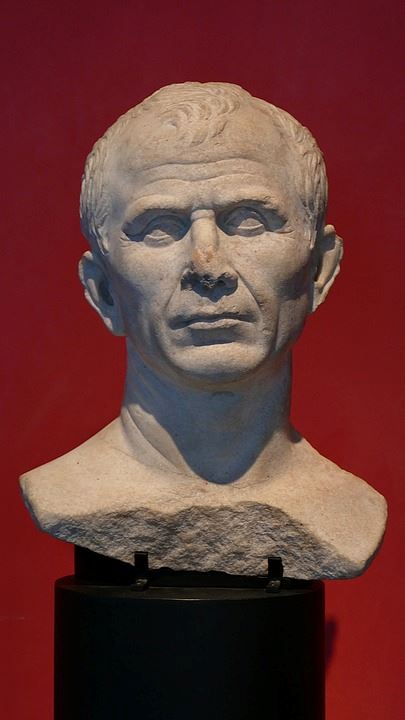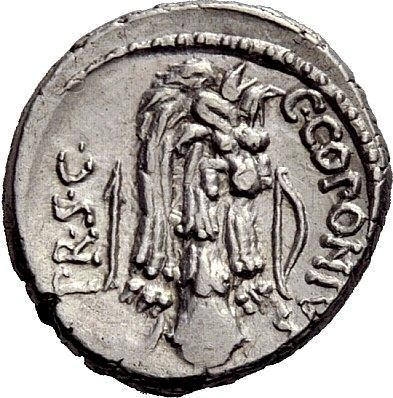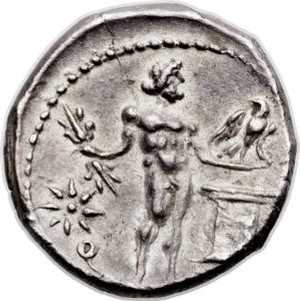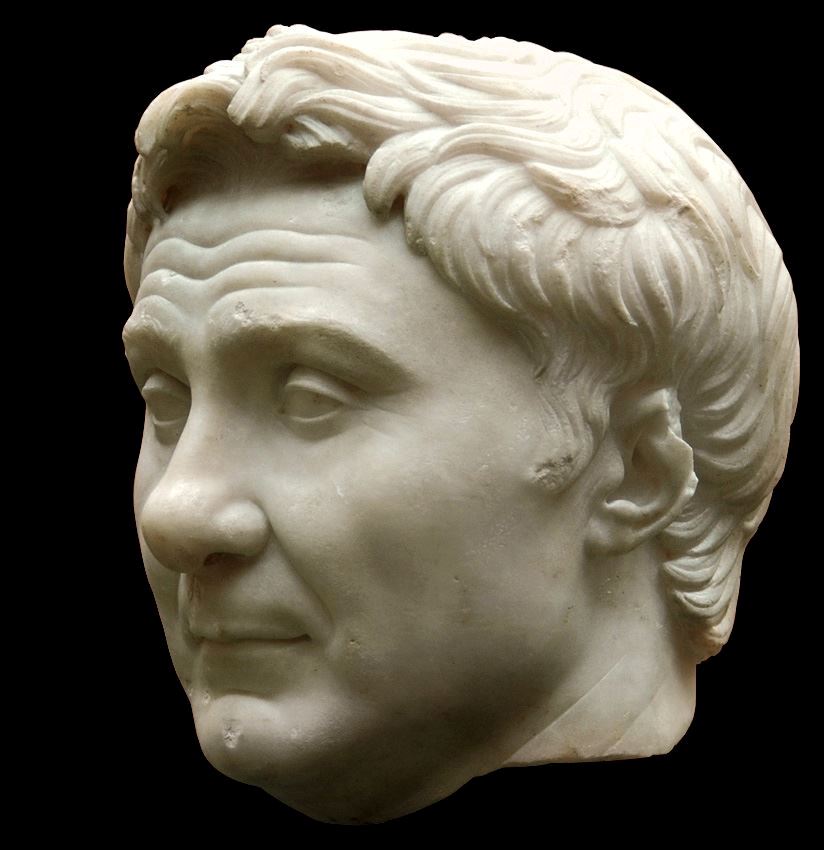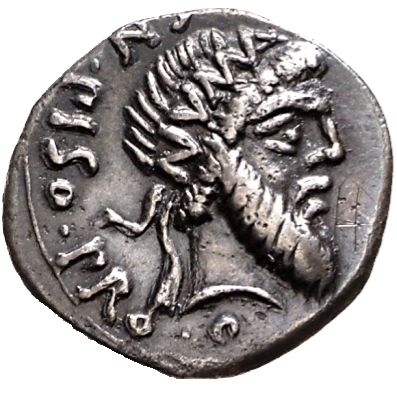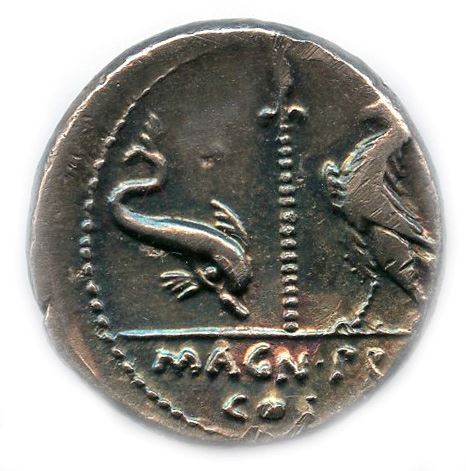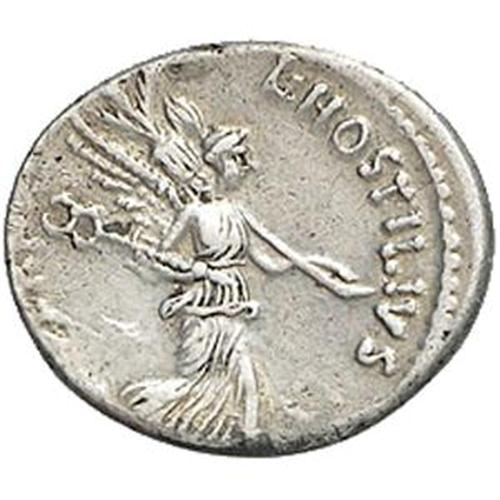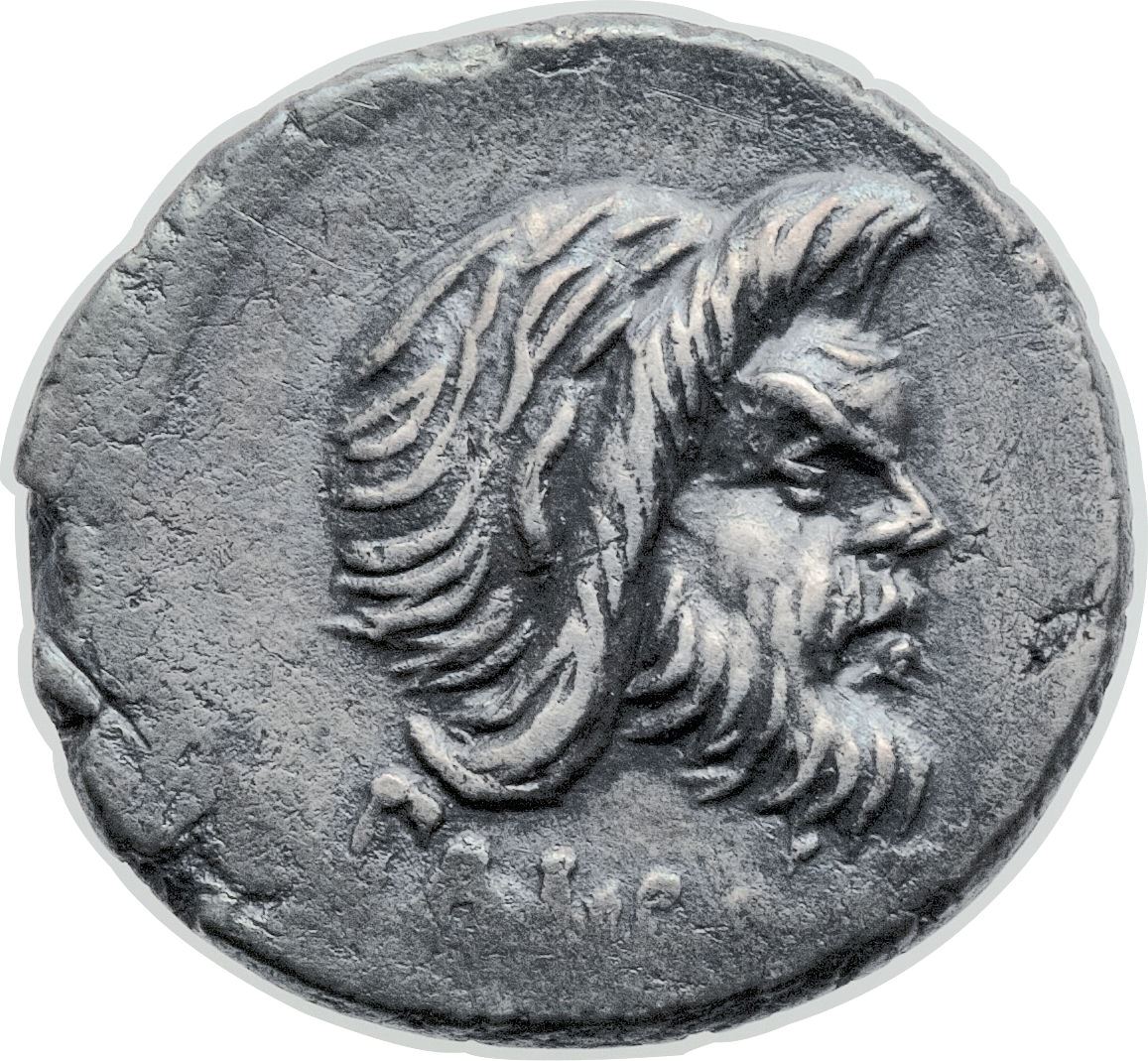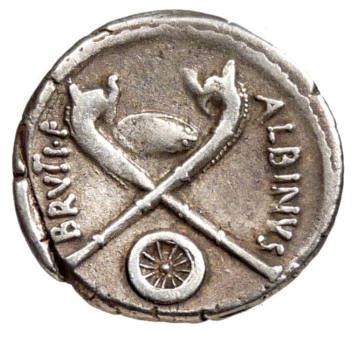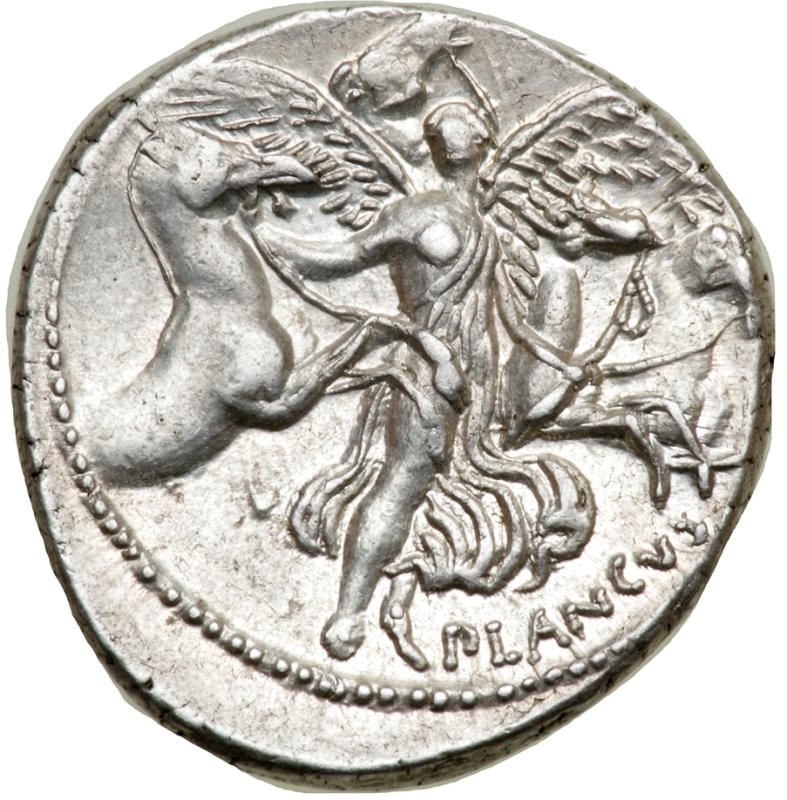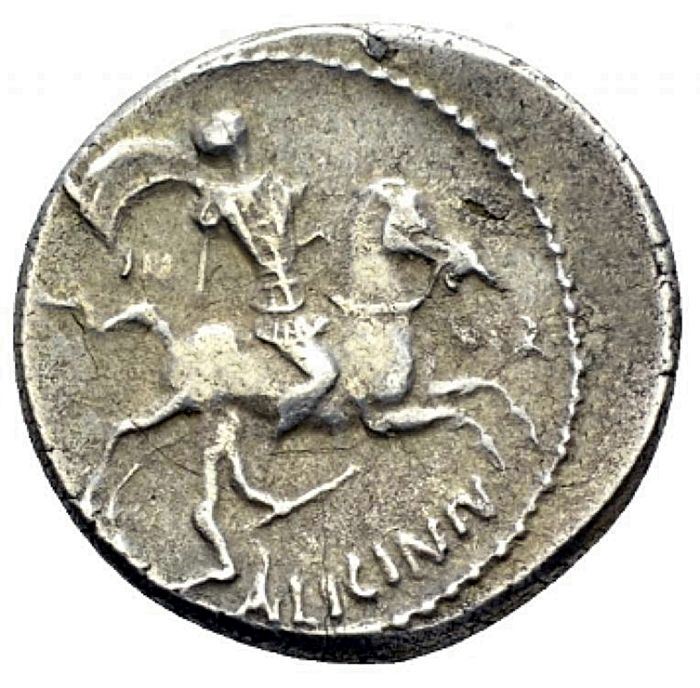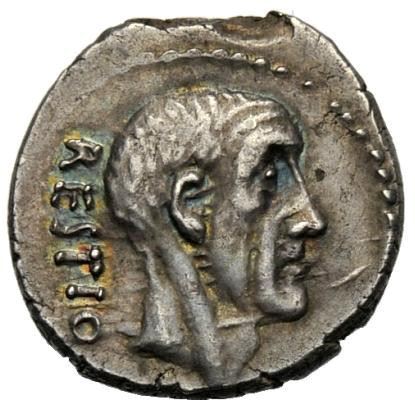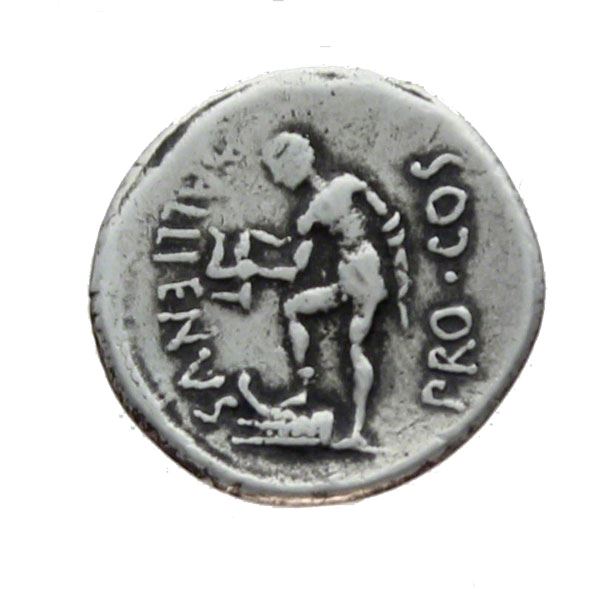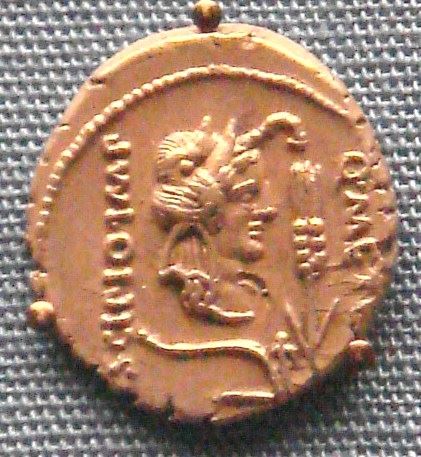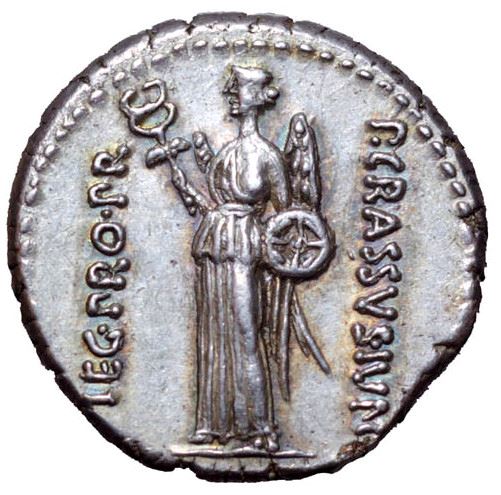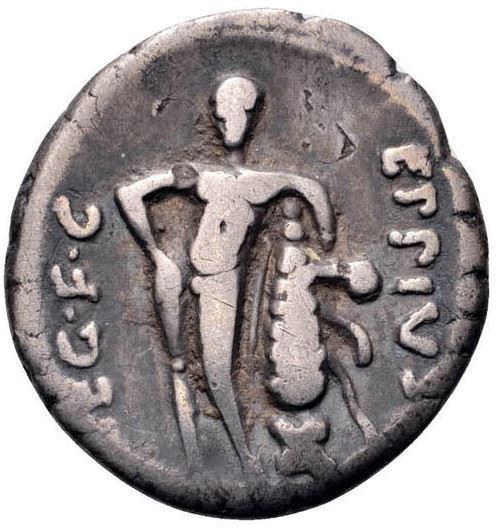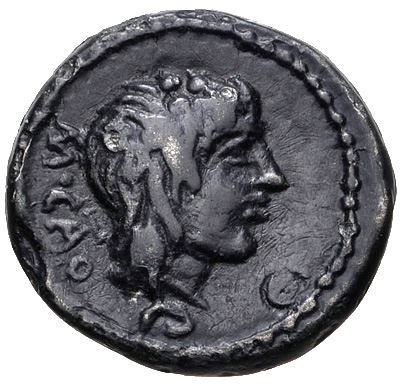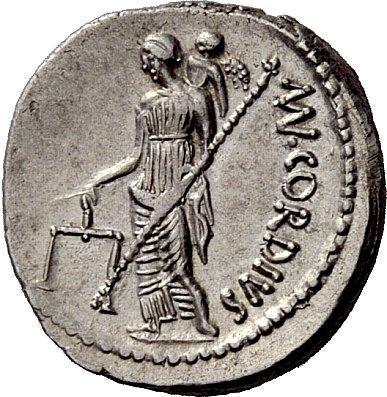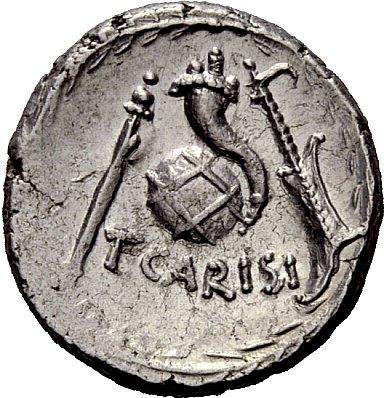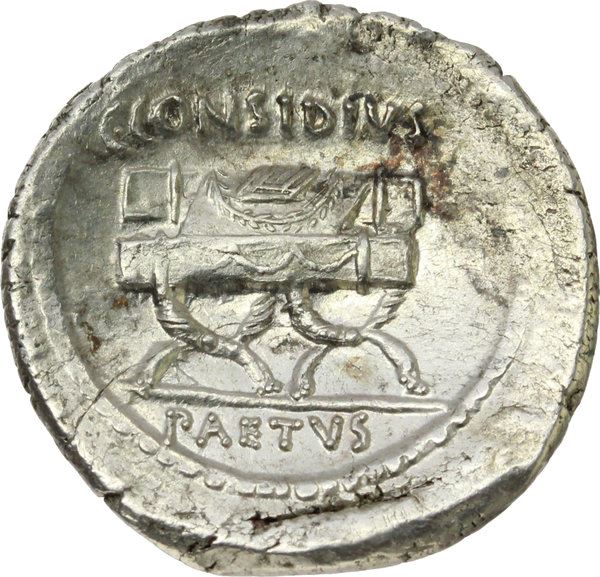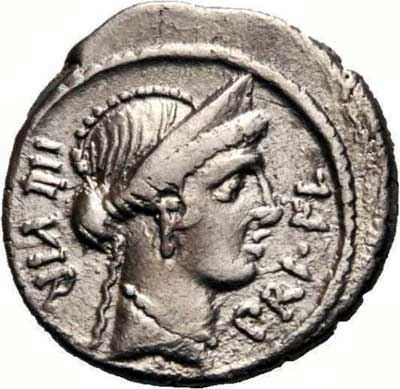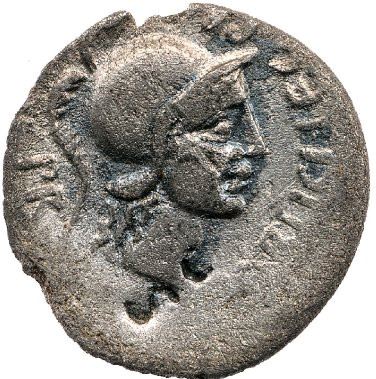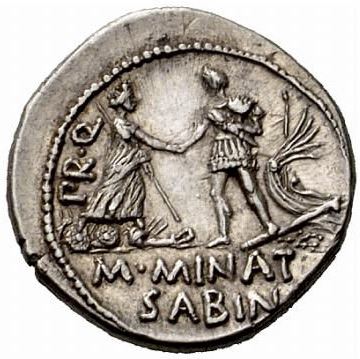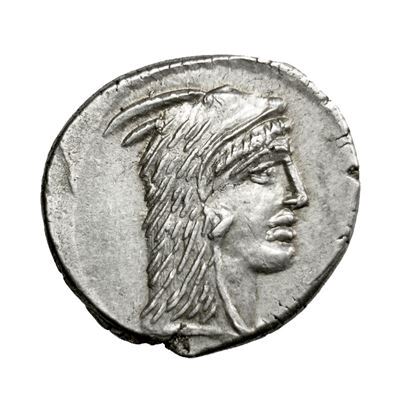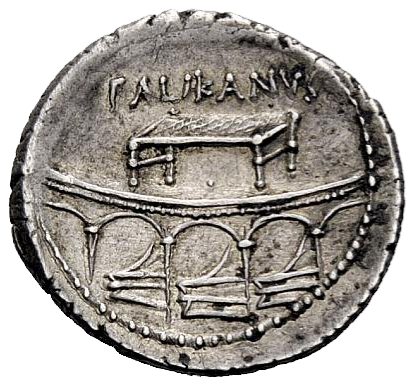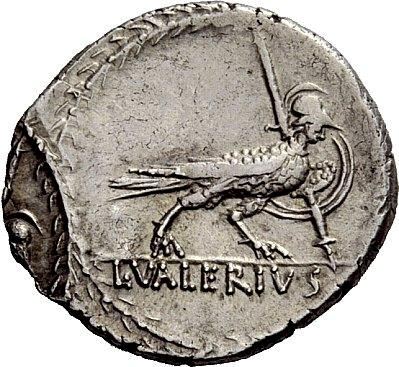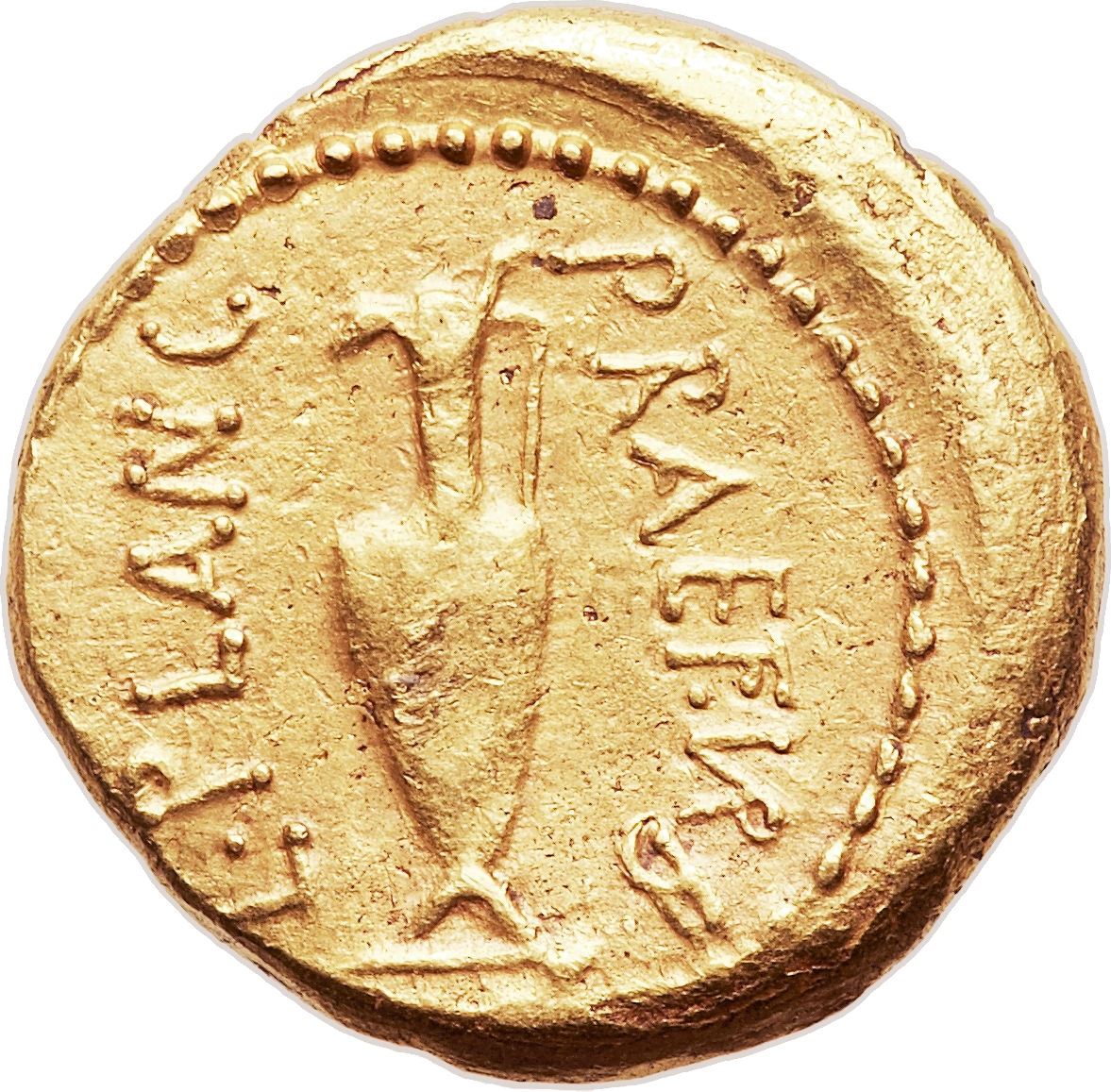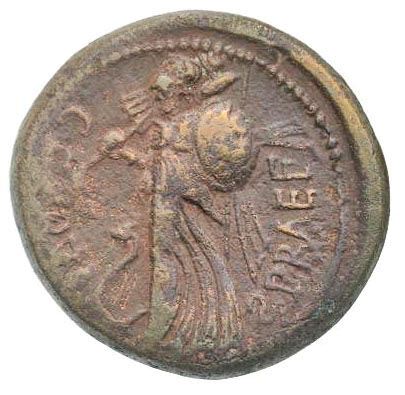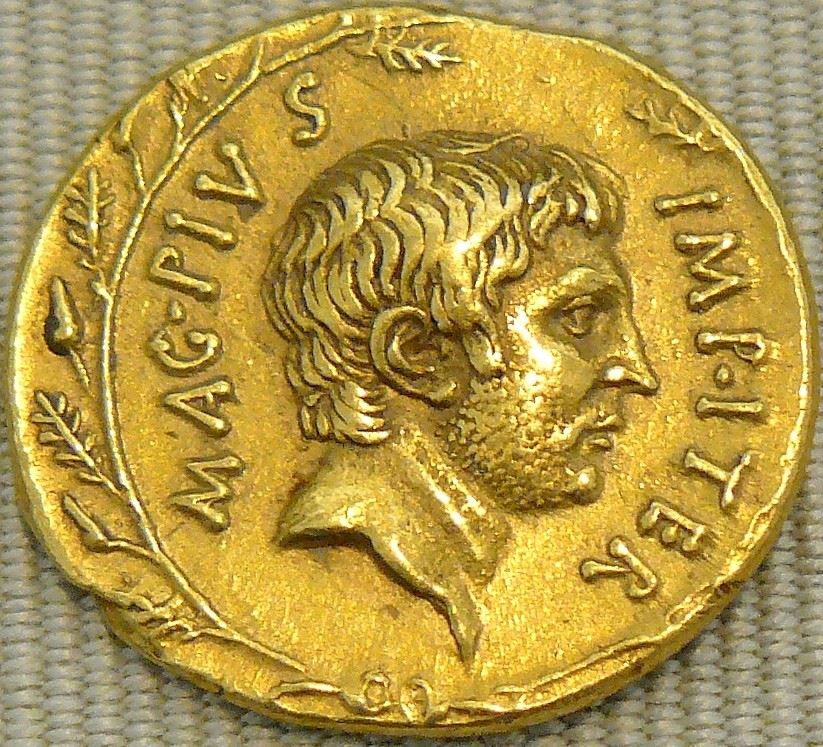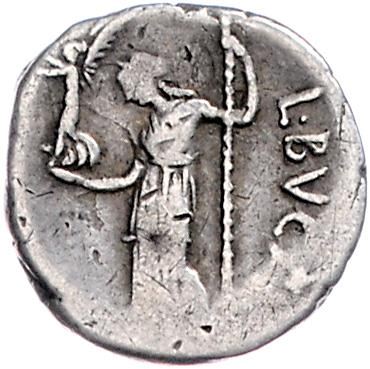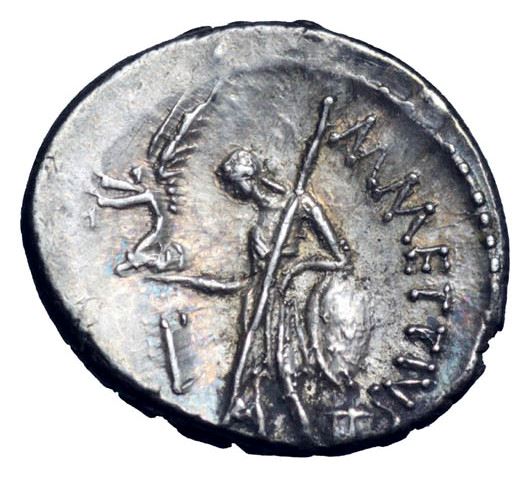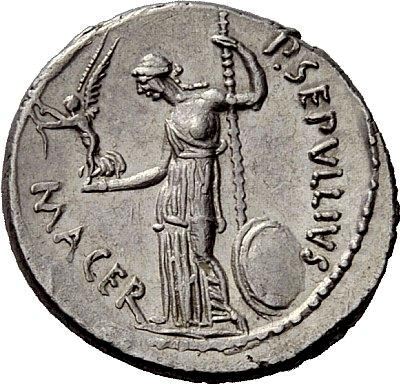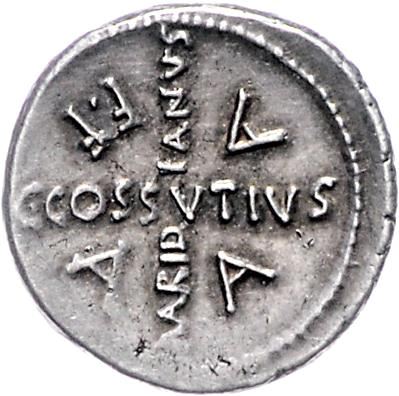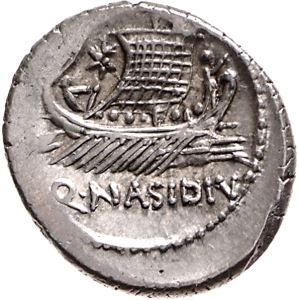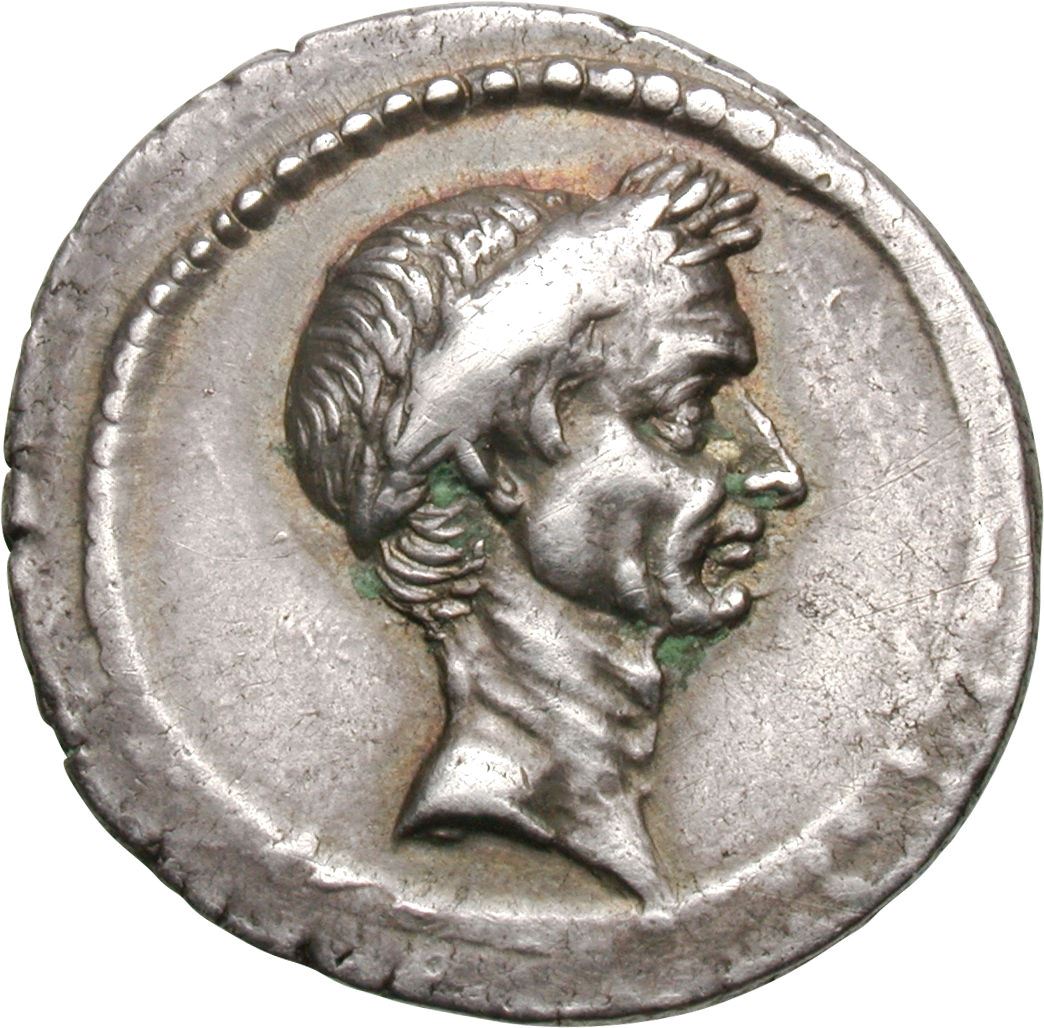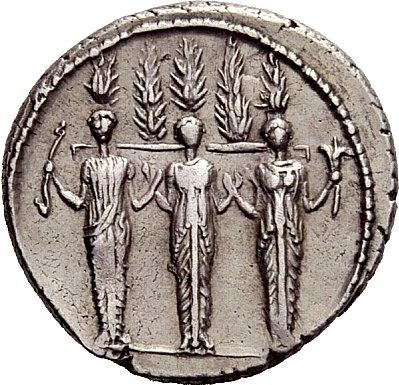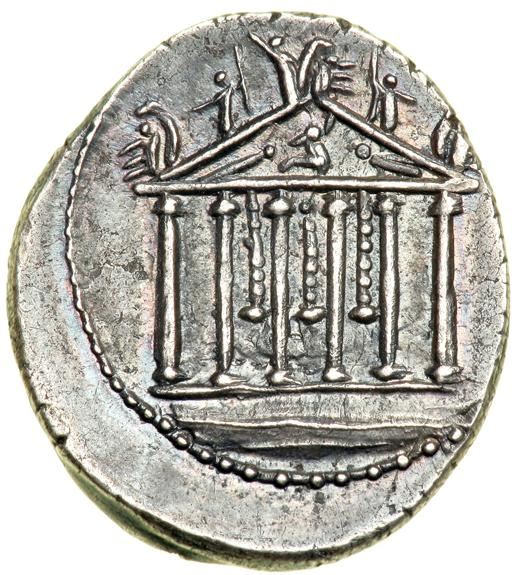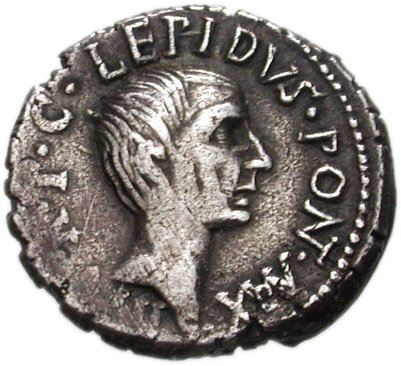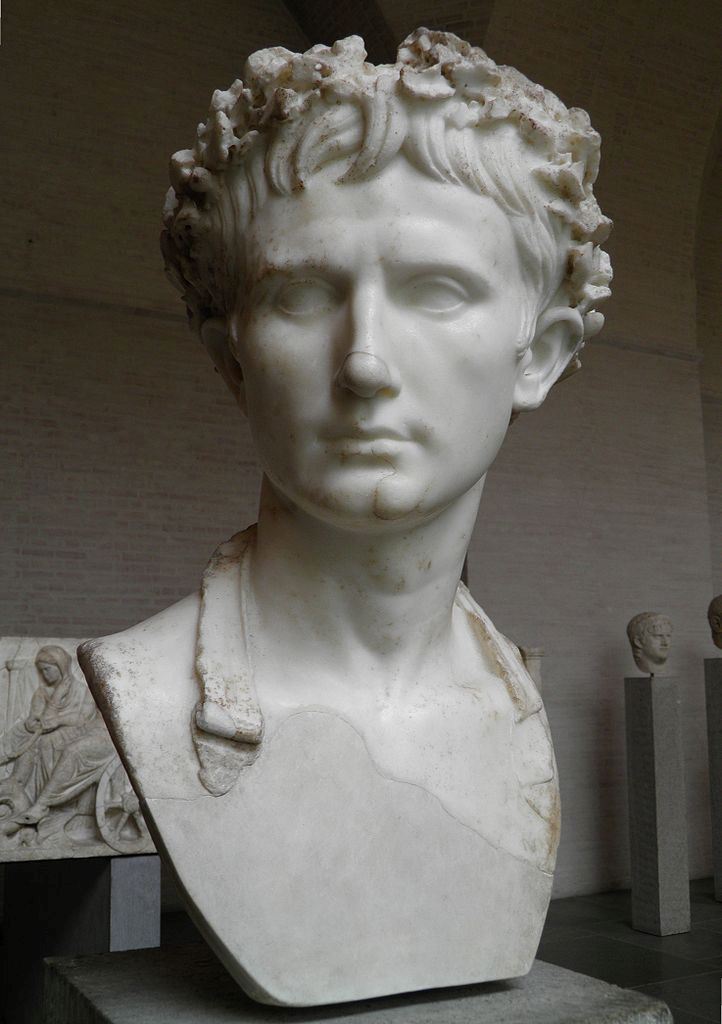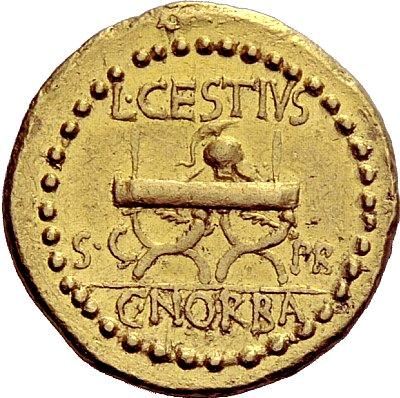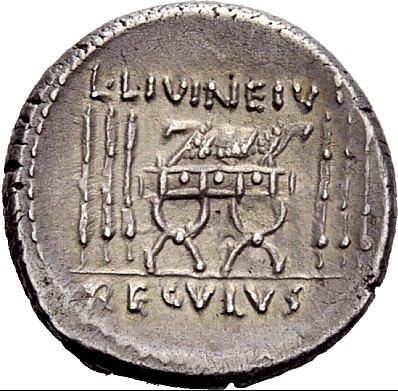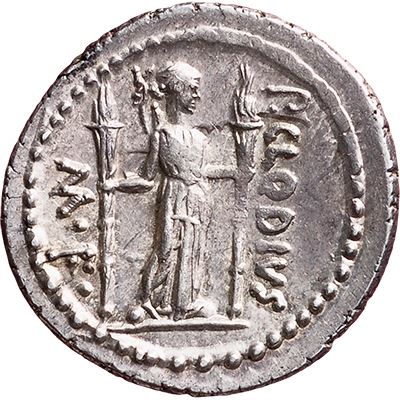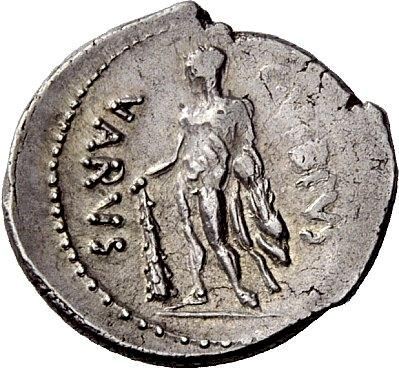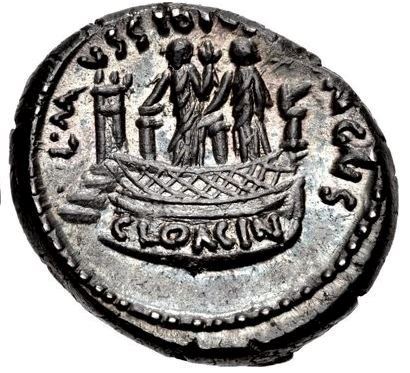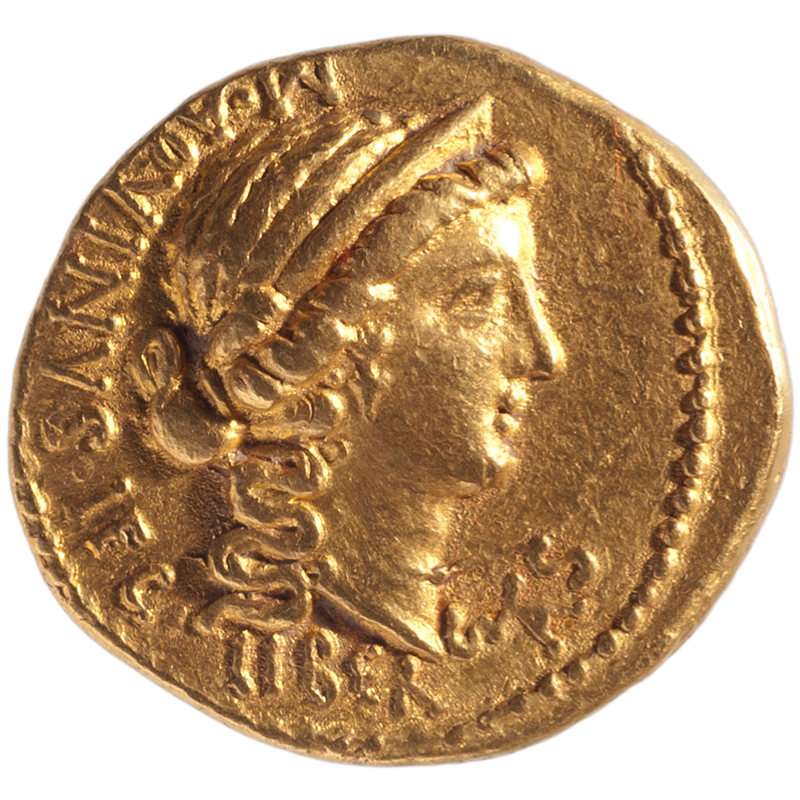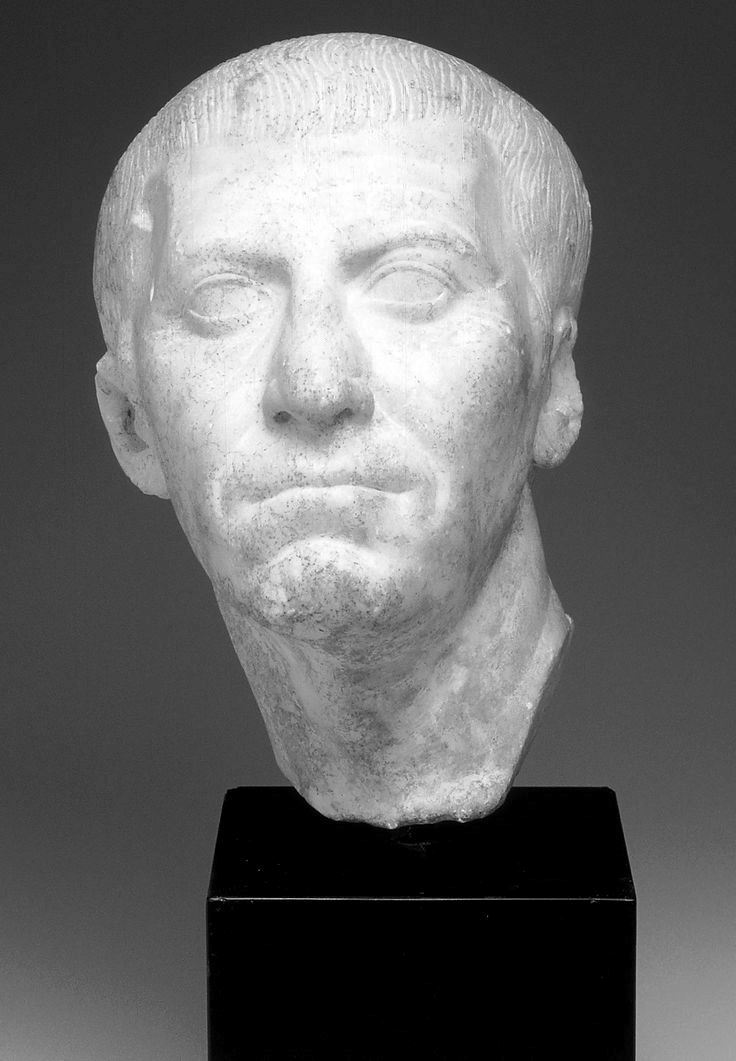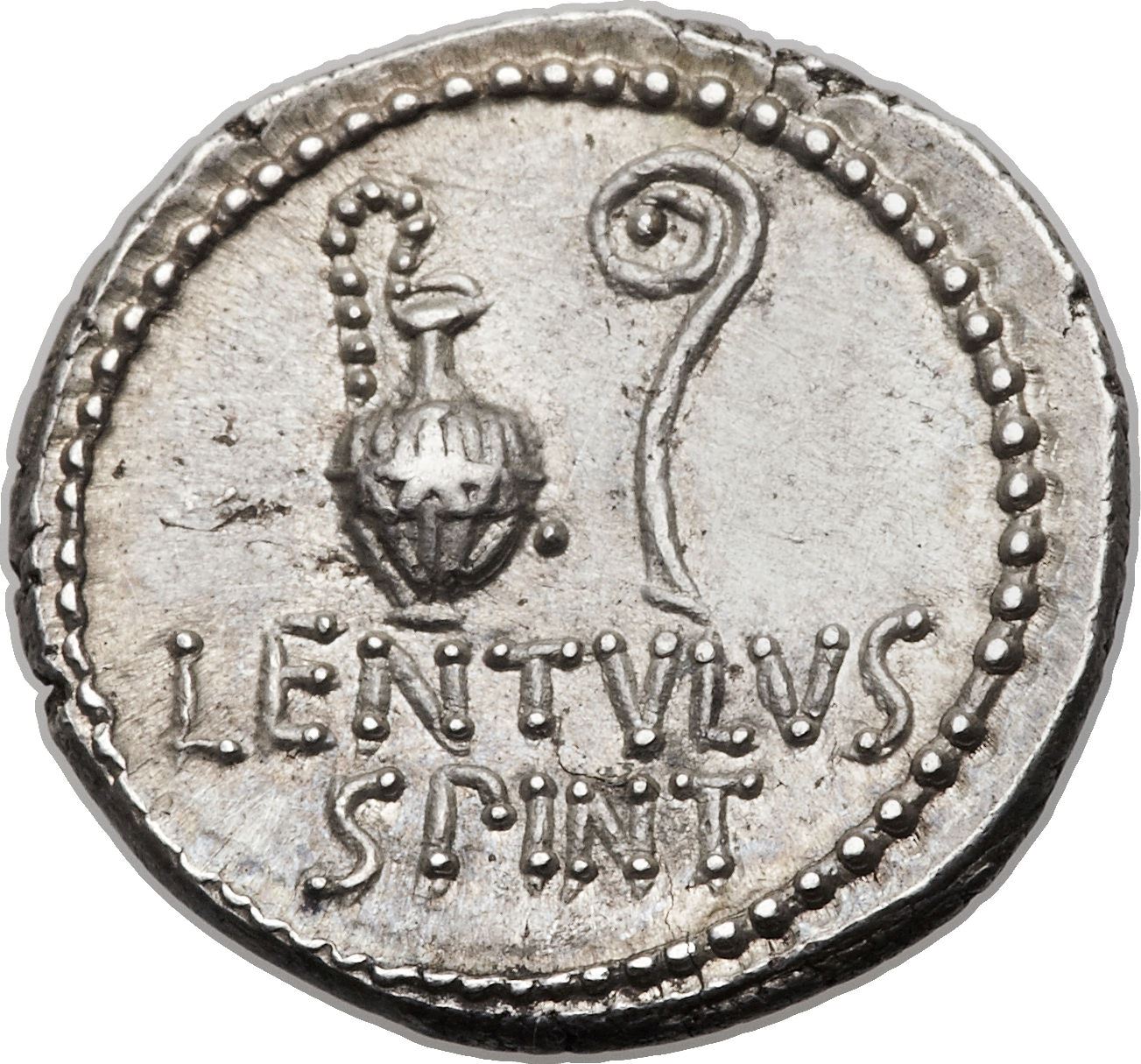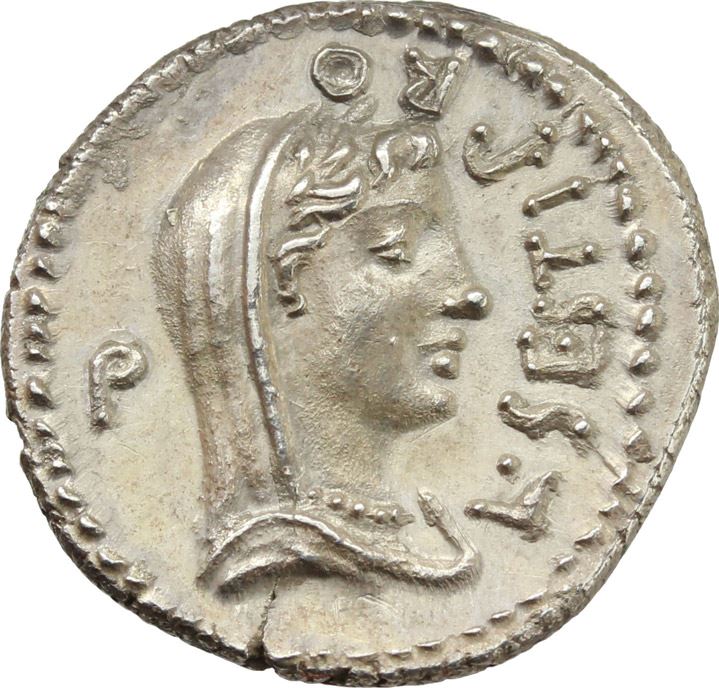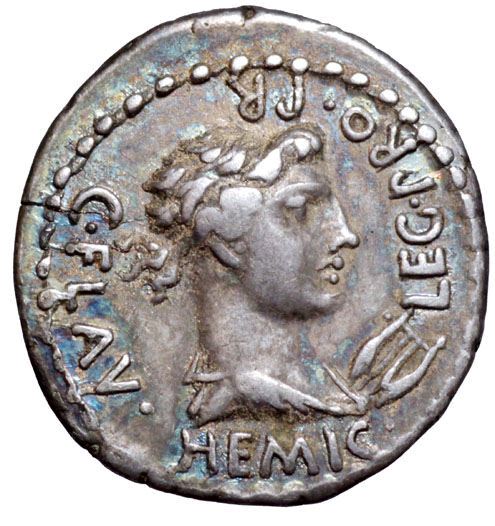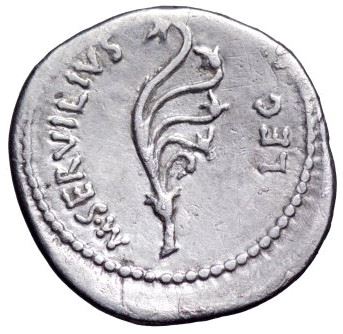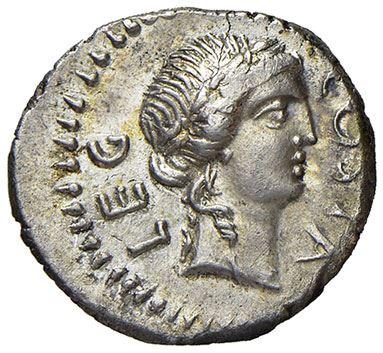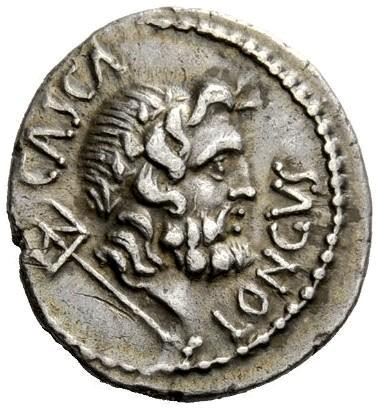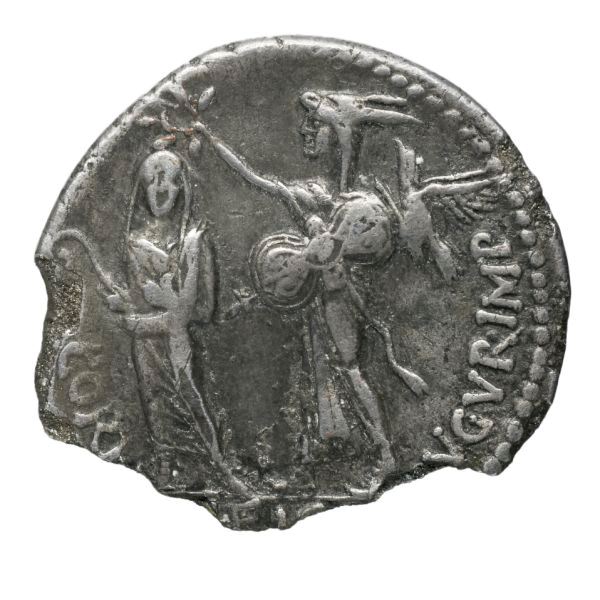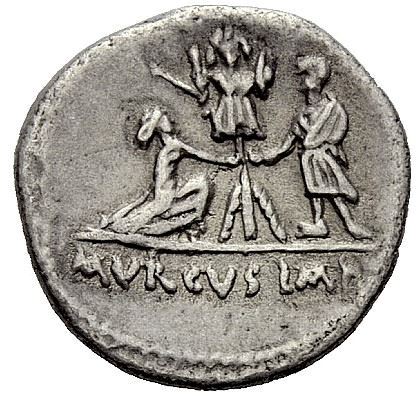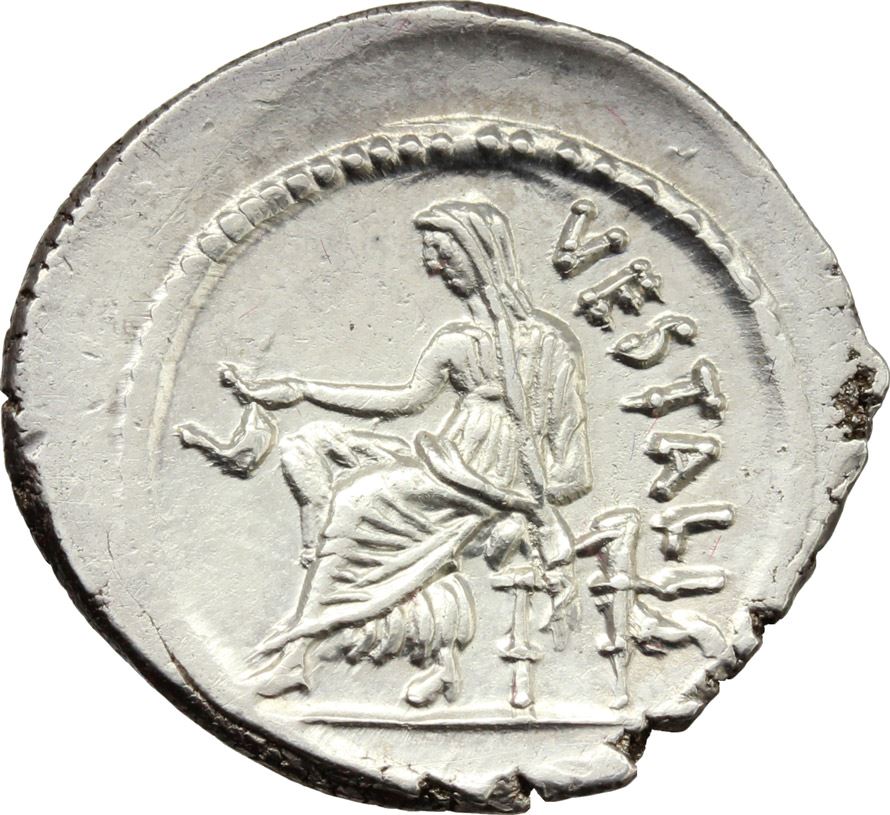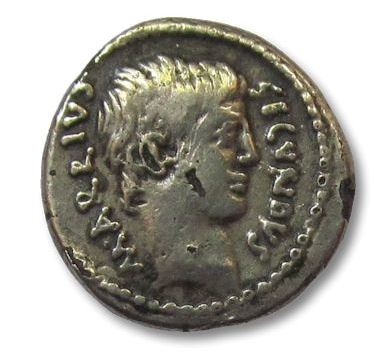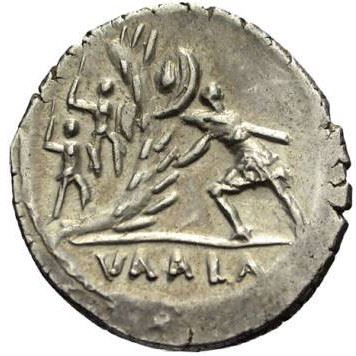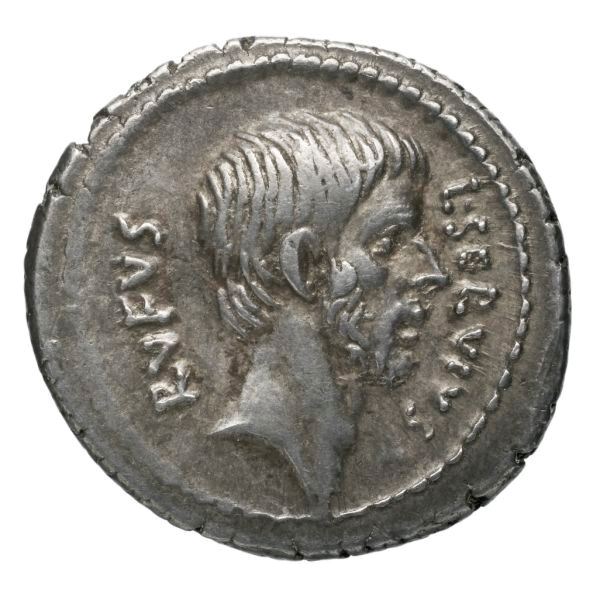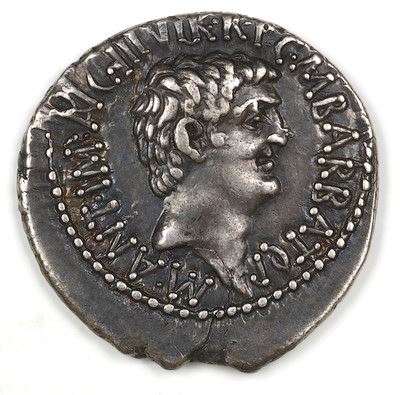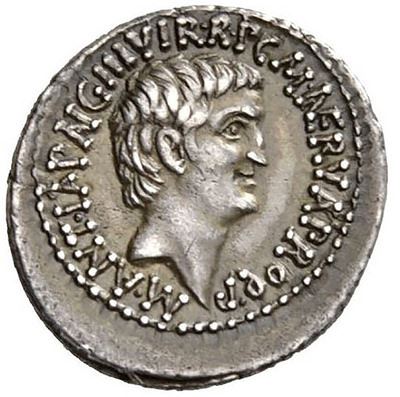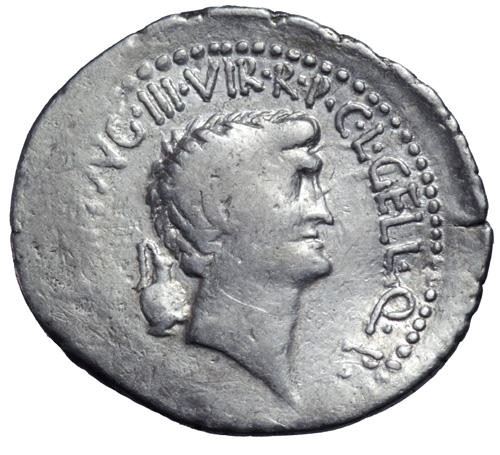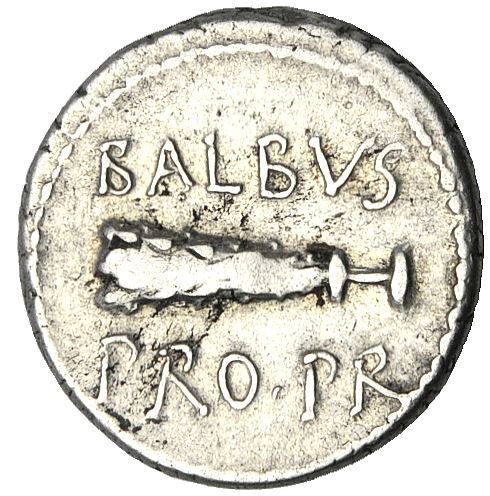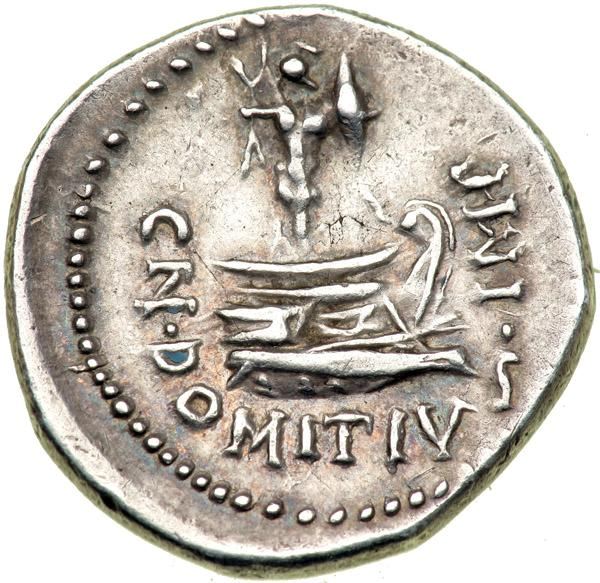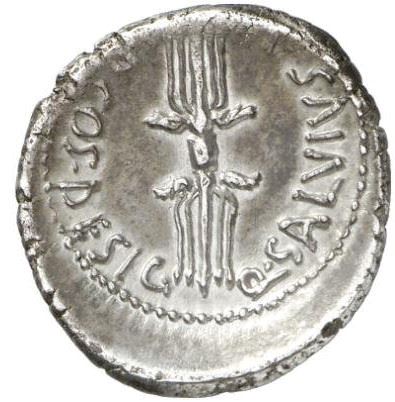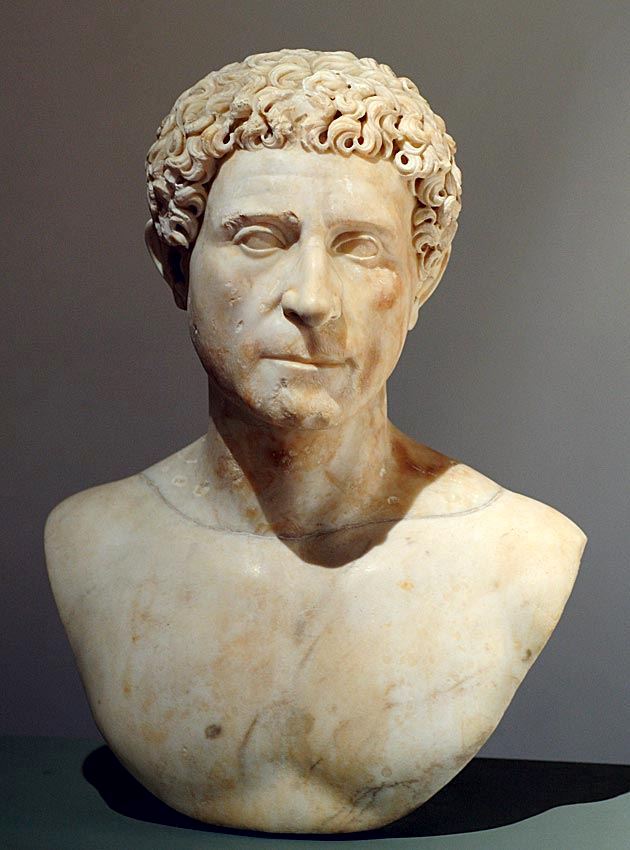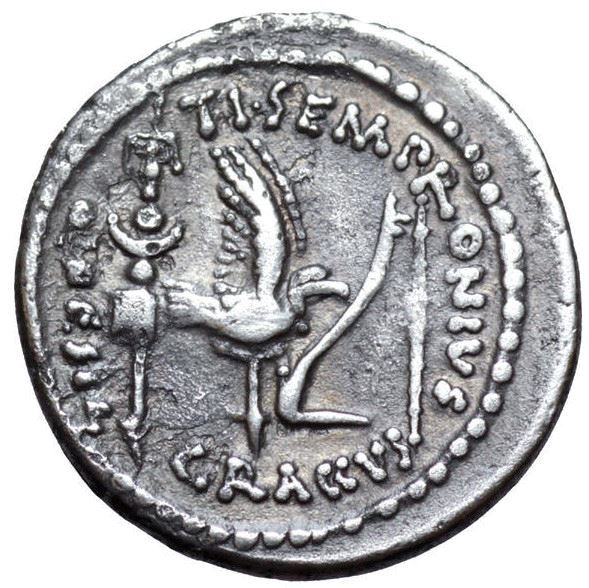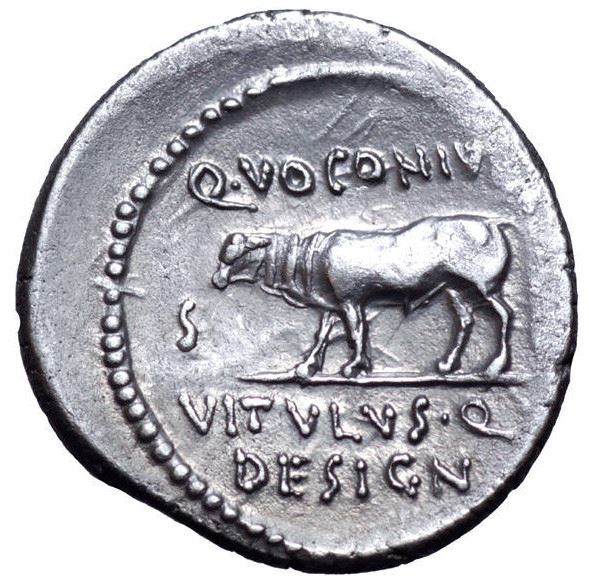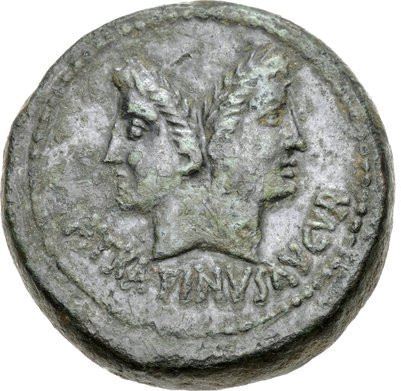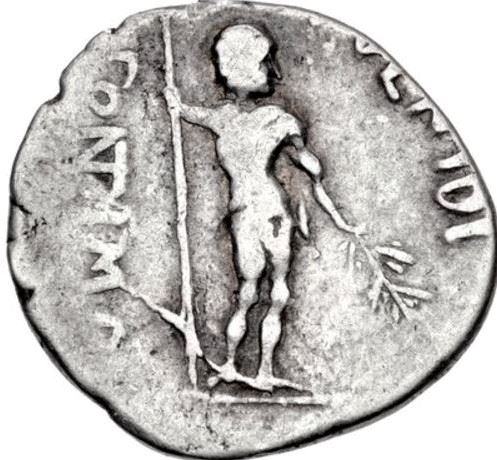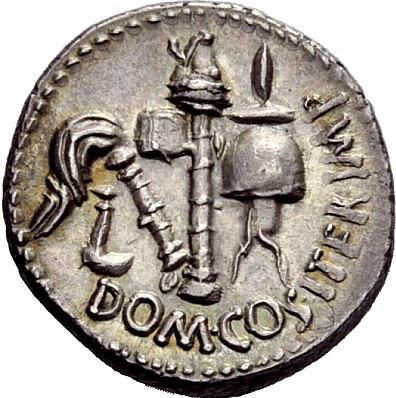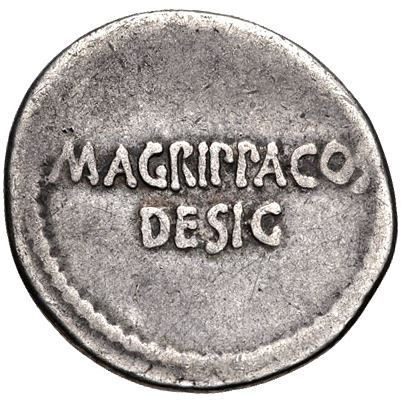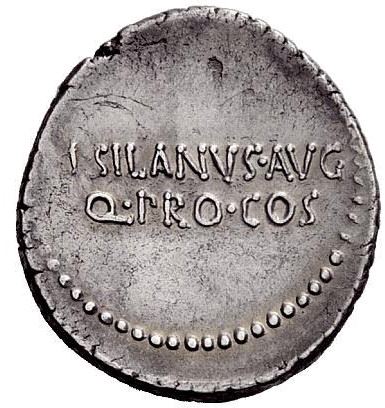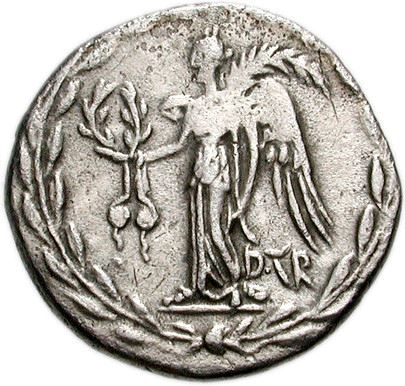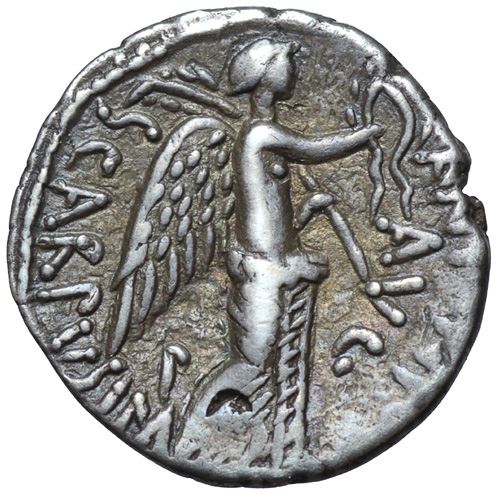Coinage came late to the Roman Republic compared with the rest of the Mediterranean. It started with a few silver coins apparently devised for trade with the Greek colonies in Southern Italy, and heavy cast bronze pieces for use in Central Italy.
During the Second Punic war a flexible system of coins in bronze, silver and (occasionally) gold was created. This system was dominated by the silver denarius, a denomination which remained in circulation for 450 years. The coins of the republic were produced by "mint magistrates", junior officials who choose the designs and legends. This resulted in the production of coins advertising the officials' families for political purposes; most of the messages on these coins can still be understood today.
During the Second Punic war a flexible system of coins in bronze, silver and (occasionally) gold was created. This system was dominated by the silver denarius, a denomination which remained in circulation for 450 years. The coins of the republic were produced by "mint magistrates", junior officials who choose the designs and legends. This resulted in the production of coins advertising the officials' families for political purposes; most of the messages on these coins can still be understood today.
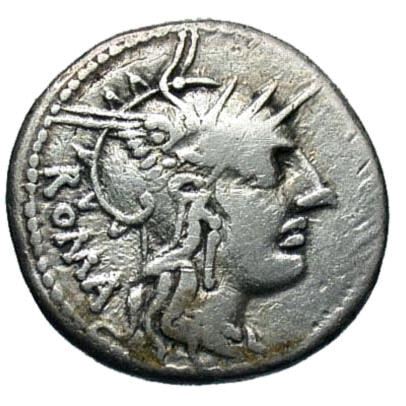
The Marsic Confederation was an alliance of cities opposed to Rome during the Social War (from socii ("allies") of 91-88 BC.
The conflict developed out of dissatisfaction amongst the allied Italian peoples, who served in the Roman armies but did not enjoy equal compensation in terms of political rights and compensation in booty and land. The war was begun by the Picentes.
Th...
The conflict developed out of dissatisfaction amongst the allied Italian peoples, who served in the Roman armies but did not enjoy equal compensation in terms of political rights and compensation in booty and land. The war was begun by the Picentes.
Th...
Lucius Cornelius Lentulus struck coins in 211 BC, where he also served as Praetor of Sicily.
He was brother of Gnaeus Cornelius Lentulus, the consul of 201 BC. After serving as Praetor, he succeeded Scipio Africanus as proconsul in Spain, though he was denied a triumph upon his return in 200 BC. He was rewarded by becoming consul in the following year. He died in 173 BC.
He...
He was brother of Gnaeus Cornelius Lentulus, the consul of 201 BC. After serving as Praetor, he succeeded Scipio Africanus as proconsul in Spain, though he was denied a triumph upon his return in 200 BC. He was rewarded by becoming consul in the following year. He died in 173 BC.
He...
P. Manlius Vulso was Praetor of Sicily in 210 BC, and struck (signed) coins in that respect.
He held the office of praetor in the middle of the Roman fight against Hannibal, which is called the Second Punic war (218-201 BC). He commanded two legions in order to defend Sardinia against the Carthaginians. Yet a Punic fleet led by Hamilcar ravaged at the end of the summer of 210 BC Olbia, ...
He held the office of praetor in the middle of the Roman fight against Hannibal, which is called the Second Punic war (218-201 BC). He commanded two legions in order to defend Sardinia against the Carthaginians. Yet a Punic fleet led by Hamilcar ravaged at the end of the summer of 210 BC Olbia, ...
C. Aurunculeius was Praetor of Sardinia for the year 209 BC, and struck coins in that respect and signed with AR.
Gens Aurunculeia was a plebian family of little importance - C. Arunculeius was the first to reach a major political office. None of the members were ever elected Consul. The only cognomen associated with the Aurunculeii is Cotta.
The nomen Aurunculeius is probabl...
Gens Aurunculeia was a plebian family of little importance - C. Arunculeius was the first to reach a major political office. None of the members were ever elected Consul. The only cognomen associated with the Aurunculeii is Cotta.
The nomen Aurunculeius is probabl...
C. Terentius Varro struck coins as Praetor of Sicily c. 209-208 BC.
Gens Terentia was a plebeian Roman family. The name comes from the Sabine terenus ("soft"). The gens is mentioned from 462 BC, the year Gaius Terentillus Arsa became tribune of the plebs. The Terentii ascended to the status of Roman consul with Gaius Terentius Varro, who commanded at the time of the Battle of Cannae in ...
Gens Terentia was a plebeian Roman family. The name comes from the Sabine terenus ("soft"). The gens is mentioned from 462 BC, the year Gaius Terentillus Arsa became tribune of the plebs. The Terentii ascended to the status of Roman consul with Gaius Terentius Varro, who commanded at the time of the Battle of Cannae in ...
C. Aelius struck coins between 209-208 BC, possibly in an official role connected with Sicily.
Gens Aelia, occasionally written Ailia, or Ælia, was a plebeian family in Rome, which flourished from the fifth century BC until at least the third century AD, a period of nearly eight hundred years. The archaic spelling Ailia is found on coins, but must not be confused with Allia, which is a ...
Gens Aelia, occasionally written Ailia, or Ælia, was a plebeian family in Rome, which flourished from the fifth century BC until at least the third century AD, a period of nearly eight hundred years. The archaic spelling Ailia is found on coins, but must not be confused with Allia, which is a ...
Marcus Valerius Laevinus was a Roman consul and commander who rose to prominence during the Second Punic War and corresponding First Macedonian War. He struck coins c. 211-210 BC as governor of Sicily.
At the time, Mutines, a Carthaginian general, had been replaced as commander of the Numidian cavalry and betrayed Agrigentum to the Romans in revenge for the demotion. According to Livy, ...
At the time, Mutines, a Carthaginian general, had been replaced as commander of the Numidian cavalry and betrayed Agrigentum to the Romans in revenge for the demotion. According to Livy, ...
Aelius was one of the moneyers for the years 211-208 BC. He is not otherwise known.
Gens Aelia, occasionally written Ailia, or Ælia, was a plebeian family in Rome, which flourished from the fifth century BC until at least the third century AD, a period of nearly eight hundred years. The archaic spelling Ailia is found on coins, but must not be confused with Allia, which is a distinct ge...
Gens Aelia, occasionally written Ailia, or Ælia, was a plebeian family in Rome, which flourished from the fifth century BC until at least the third century AD, a period of nearly eight hundred years. The archaic spelling Ailia is found on coins, but must not be confused with Allia, which is a distinct ge...
Q. Lutatius Catulus was one of the moneyers for the year 206-200 BC. He is otherwise unknown.
Gens Lutatia, occasionally written Luctatia, was a plebeian family of ancient Rome. The first of the gens to obtain the consulship was Gaius Lutatius Catulus in 242 BC, the final year of the First Punic War. Orosius mentions their burial place, the sepulchrum Lutatiorum, which lay beyond the Ti...
Gens Lutatia, occasionally written Luctatia, was a plebeian family of ancient Rome. The first of the gens to obtain the consulship was Gaius Lutatius Catulus in 242 BC, the final year of the First Punic War. Orosius mentions their burial place, the sepulchrum Lutatiorum, which lay beyond the Ti...
A. Terentius Varro was one of the moneyers for the year 206-200 BC. He later served as Praetor in 184 BC.
Gens Terentia was a plebeian Roman family. The name comes from the Sabine terenus ("soft"). The gens is mentioned from 462 BC, the year Gaius Terentillus Arsa became tribune of the plebs. The Terentii ascended to the status of Roman consul with Gaius Terentius Varro, who commanded a...
Gens Terentia was a plebeian Roman family. The name comes from the Sabine terenus ("soft"). The gens is mentioned from 462 BC, the year Gaius Terentillus Arsa became tribune of the plebs. The Terentii ascended to the status of Roman consul with Gaius Terentius Varro, who commanded a...
Caecilius Metellus was one of the moneyers for the year 194-190 BC. He is otherwise unknown.
Gens Caecilia was a plebeian family at Rome. Members of this gens are mentioned in history as early as the fifth century BC, but the first of the Caecilii who obtained the consulship was Lucius Caecilius Metellus Denter, in 284 BC.
Like other Roman families in the later times of the ...
Gens Caecilia was a plebeian family at Rome. Members of this gens are mentioned in history as early as the fifth century BC, but the first of the Caecilii who obtained the consulship was Lucius Caecilius Metellus Denter, in 284 BC.
Like other Roman families in the later times of the ...
Baebius Tamphilus was one of the moneyers for the years 194-190 BC. He is either Cn. Baebius Tamphilus, Praetor in 168 BC, or his cousin M. Baebius Tamphilus, Consul in 181 BC.
Gens Baebia was a plebeian family in ancient Rome. The first member of the gens who obtained the consulship was Gnaeus Baebius Tamphilus, in 182 BC. During the later Republic, the Baebii were frequently connected...
Gens Baebia was a plebeian family in ancient Rome. The first member of the gens who obtained the consulship was Gnaeus Baebius Tamphilus, in 182 BC. During the later Republic, the Baebii were frequently connected...
L. Plautius Hypsaeus was one of the moneyers between 194 and 190 BC.
Gens Plautia was a plebeian gens that probably came from Privernum. The first member of the gens Plautia to reach consular rank was Gaius Plautius Proculus, who became consul in 358 BCE and was magister equitum to the first plebeian dictator Gaius Marcius Rutilus.
The principal name used by the Gens Plautia ...
Gens Plautia was a plebeian gens that probably came from Privernum. The first member of the gens Plautia to reach consular rank was Gaius Plautius Proculus, who became consul in 358 BCE and was magister equitum to the first plebeian dictator Gaius Marcius Rutilus.
The principal name used by the Gens Plautia ...
P. Maenius was one of the moneyers for the year 194-190 BC. He is not otherwise known.
Gens Maenia, occasionally written Mainia, was a plebeian family at ancient Rome. Members of this gens are first mentioned soon after the establishment of the Republic, and occur in history down to the second century BC. Several of them held the position of tribune of the plebs, from which they strenuo...
Gens Maenia, occasionally written Mainia, was a plebeian family at ancient Rome. Members of this gens are first mentioned soon after the establishment of the Republic, and occur in history down to the second century BC. Several of them held the position of tribune of the plebs, from which they strenuo...
Q. Maenius was one of the moneyers for the year 189-180 BC. He later served as Praetor in 170 BC.
Gens Maenia, occasionally written Mainia, was a plebeian family at ancient Rome. Members of this gens are first mentioned soon after the establishment of the Republic, and occur in history down to the second century BC. Several of them held the position of tribune of the plebs, from which t...
Gens Maenia, occasionally written Mainia, was a plebeian family at ancient Rome. Members of this gens are first mentioned soon after the establishment of the Republic, and occur in history down to the second century BC. Several of them held the position of tribune of the plebs, from which t...
L. Furius Philus was one of the moneyers for the year 189-180 BC. He later served as Praetor in 171 BC.
Gens Furia, originally written Fusia, was one of the most ancient and noble patrician houses at Rome. Its members held the highest offices of the state throughout the period of the Roman Republic. The first of the Furii to attain the consulship was Sextus Furius Medullinus in 488 BC. ...
Gens Furia, originally written Fusia, was one of the most ancient and noble patrician houses at Rome. Its members held the highest offices of the state throughout the period of the Roman Republic. The first of the Furii to attain the consulship was Sextus Furius Medullinus in 488 BC. ...
L. Autronius was one of the moneyers for the year 189-180 BC. He is otherwise unknown.
Gens Autronia was a plebeian family at Rome. Persons of this gens first came into notice in the last century of the Republic; the first member who obtained the consulship was Publius Autronius Paetus, in 65 BC.
The only surname of the Autronii was Paetus, a cognomen in many other gentes. It...
Gens Autronia was a plebeian family at Rome. Persons of this gens first came into notice in the last century of the Republic; the first member who obtained the consulship was Publius Autronius Paetus, in 65 BC.
The only surname of the Autronii was Paetus, a cognomen in many other gentes. It...
Gnaeus Domitius Ahenobarbus, son of the Gnaeus Domitius Ahenobarbus who had been consul in 192 BC, was one of the moneyers for the year 189-180 BC. He was the father of Gnaeus Domitius Ahenobarbus, who was consul in 122 BC.
He served as pontifex in 172 BC, when still a young man, and in 169 BC was sent with two others as commissioners into Macedonia. In 167 BC he was one of the ten comm...
He served as pontifex in 172 BC, when still a young man, and in 169 BC was sent with two others as commissioners into Macedonia. In 167 BC he was one of the ten comm...
Q. Marius was one of the moneyers for the year 189-180 BC. He is not otherwise known.
The gens Maria was a plebeian family of Rome. Its most celebrated member was Gaius Marius, one of the greatest generals of antiquity, and seven times consul. As a nomen, Marius is probably derived from the Oscan praenomen Marius, in which case the family may be of Sabine or Sabellic background, althoug...
The gens Maria was a plebeian family of Rome. Its most celebrated member was Gaius Marius, one of the greatest generals of antiquity, and seven times consul. As a nomen, Marius is probably derived from the Oscan praenomen Marius, in which case the family may be of Sabine or Sabellic background, althoug...
L. Mamilius was one of the moneyers for the year 189-180 BC. He is otherwise unknown.
Gens Mamilia was a plebeian family at Rome during the period of the Republic. The gens was originally one of the most distinguished families of Tusculum, and indeed in the whole of Latium. It is first mentioned in the time of the Tarquins; and it was to a member of this family, Octavius Mamilius, that ...
Gens Mamilia was a plebeian family at Rome during the period of the Republic. The gens was originally one of the most distinguished families of Tusculum, and indeed in the whole of Latium. It is first mentioned in the time of the Tarquins; and it was to a member of this family, Octavius Mamilius, that ...
M. Titiniuswas one of the moneyers for the years 189-180 BC. He is otherwise unknown. The moneyer may also be M. Titinus Curvus, in which case he served as Praetor in 178 BC.
Gens Titinia was a plebian gens . No mention is made of it until the decemviri period, but it never became an important gens, and none of its members reached the consulate.
Gens Titinia was a plebian gens . No mention is made of it until the decemviri period, but it never became an important gens, and none of its members reached the consulate.
S. Furius was one of the moneyers for the year 189-180 BC. He is not otherwise known.
Gens Furia, originally written Fusia, was one of the most ancient and noble patrician houses at Rome. Its members held the highest offices of the state throughout the period of the Roman Republic. The first of the Furii to attain the consulship was Sextus Furius Medullinus in 488 BC. The cognomina ...
Gens Furia, originally written Fusia, was one of the most ancient and noble patrician houses at Rome. Its members held the highest offices of the state throughout the period of the Roman Republic. The first of the Furii to attain the consulship was Sextus Furius Medullinus in 488 BC. The cognomina ...
Sextus Quinctilius was one of the moneyers for the year 189-180 BC. He is not otherwise known.
Quinctilia, also written Quintilia, was a patrician family at Rome, dating from the earliest period of Roman history, and continuing well into imperial times. Despite its great antiquity, the gens never attained much historical importance. The only member who obtained the consulship under the ...
Quinctilia, also written Quintilia, was a patrician family at Rome, dating from the earliest period of Roman history, and continuing well into imperial times. Despite its great antiquity, the gens never attained much historical importance. The only member who obtained the consulship under the ...
Cn. Calpurnius was one of the moneyers for the year 189-180 BC. He is not otherwise known.
Gens Calpurnia was a plebeian family at Rome, which first appears in history during the third century BC. The first of the gens to obtain the consulship was Gaius Calpurnius Piso in 180 BC, but from this time their consulships were very frequent, and the family of the Pisones became one of the mos...
Gens Calpurnia was a plebeian family at Rome, which first appears in history during the third century BC. The first of the gens to obtain the consulship was Gaius Calpurnius Piso in 180 BC, but from this time their consulships were very frequent, and the family of the Pisones became one of the mos...
L. Coelius was one of the moneyers for the year 189-180 BC. He laterserved as Legatus in 170-169.
Gens Caelia, also written Coelia was a plebeian family at Rome. The nomen is usually written Caelius in manuscripts, while Coelius or Coilius is regularly found on coins. The name is frequently confused with the more common Caecilius. Although the Caelii asserted their great antiquity, the ...
Gens Caelia, also written Coelia was a plebeian family at Rome. The nomen is usually written Caelius in manuscripts, while Coelius or Coilius is regularly found on coins. The name is frequently confused with the more common Caecilius. Although the Caelii asserted their great antiquity, the ...
L. Furius Purpureo was one of the moneyers for the year 179-170 BC. He is apparently not the same persion as the Furius Purpurio who struck coins a decade later.
gens Furia, originally written Fusia, was one of the most ancient and noble patrician houses at Rome. Its members held the highest offices of the state throughout the period of the Roman Republic. The first of the Furii to atta...
gens Furia, originally written Fusia, was one of the most ancient and noble patrician houses at Rome. Its members held the highest offices of the state throughout the period of the Roman Republic. The first of the Furii to atta...
P. Juventius Thalna was one of the moneyers for the years 179-170 BC. He was later Praetor in 149 BC.
Gens Juventia, occasionally written Jubentia, was an ancient plebeian family at Rome. After centuries of obscurity, the gens emerges into history with the appearance of Titus Juventius, a military tribune, in the beginning of the second century BC. The first of the Juventii to obtain th...
Gens Juventia, occasionally written Jubentia, was an ancient plebeian family at Rome. After centuries of obscurity, the gens emerges into history with the appearance of Titus Juventius, a military tribune, in the beginning of the second century BC. The first of the Juventii to obtain th...
Matienus was one of the moneyers for the years 179-170 BC. He is not otherwise known.
Gens Matiena was a plebeian family at Rome. Members of this gens first appear in history in the time of the Second Punic War. Chase classifies the nomen Matienus as part of a group of Latin gentilicia that appear to be derived from other nomina, although the ultimate origin of the name is not apparent.
Gens Matiena was a plebeian family at Rome. Members of this gens first appear in history in the time of the Second Punic War. Chase classifies the nomen Matienus as part of a group of Latin gentilicia that appear to be derived from other nomina, although the ultimate origin of the name is not apparent.
C. Cluvius Saxula was moneyer between 169 BC and 158 BC. He was perhaps son of the C. Cluvius Saxula who was Praetor Peregrinus in 173 BC.
Gens Cluvia was a Roman family during the later Republic, and early imperial times. C. Cluvius Saxula senior was the first of the family to achieve prominence.
The Cluvii do not appear to have been divided into distinct families. Individua...
Gens Cluvia was a Roman family during the later Republic, and early imperial times. C. Cluvius Saxula senior was the first of the family to achieve prominence.
The Cluvii do not appear to have been divided into distinct families. Individua...
A. Caecilius A.f. was one of the moneyers for the years 169-158 BC. He is not otherwise known.
Gens Caecilia was a plebeian family at Rome. Members of this gens are mentioned in history as early as the fifth century BC, but the first of the Caecilii who obtained the consulship was Lucius Caecilius Metellus Denter, in 284 BC.
Like other Roman families in the later times of th...
Gens Caecilia was a plebeian family at Rome. Members of this gens are mentioned in history as early as the fifth century BC, but the first of the Caecilii who obtained the consulship was Lucius Caecilius Metellus Denter, in 284 BC.
Like other Roman families in the later times of th...
Paetus was one of the moneyers for the year 169-158 BC. He is not otherwise known, but is assumed to belong to Gens Aemiilia.
Gens Aemilia, originally written Aimilia, was one of the greatest patrician families at Rome. The gens was of great antiquity, and claimed descent from Numa Pompilius, the second King of Rome. The Aemilii were almost certainly one of the gentes maiores, the most ...
Gens Aemilia, originally written Aimilia, was one of the greatest patrician families at Rome. The gens was of great antiquity, and claimed descent from Numa Pompilius, the second King of Rome. The Aemilii were almost certainly one of the gentes maiores, the most ...
L. Cornelius Cinna was one of the moneyers for the year 169-158 BC. He is perhaps identical to the L. Cornelius Cinna who was Consul in 127 BC.
Gens Cornelia was one of the greatest patrician houses at Rome. For more than seven hundred years, from the early decades of the Republic to the third century AD, the Cornelii produced more eminent statesmen and generals than any other gens. Nea...
Gens Cornelia was one of the greatest patrician houses at Rome. For more than seven hundred years, from the early decades of the Republic to the third century AD, the Cornelii produced more eminent statesmen and generals than any other gens. Nea...
Saxula was one of the moneyers for the year 169-158 BC. He was perhaps a younger brother of the moneyer C. Cluvius Saxula, but is otherwise unknown.
Gens Cluvia was a Roman family during the later Republic, and early imperial times. C. Cluvius Saxula senior was the first of the family to achieve prominence. he Cluvii do not appear to have been divided into distinct families. Individual ...
Gens Cluvia was a Roman family during the later Republic, and early imperial times. C. Cluvius Saxula senior was the first of the family to achieve prominence. he Cluvii do not appear to have been divided into distinct families. Individual ...
A. Terentius Varro was one of the moneyers for the year 169-158 BC. He also served as commissioner to L. Mummius, Consul in 146 BC.
Gens Terentia was a plebeian Roman family. The name comes from the Sabine terenus ("soft"). The gens is mentioned from 462 BC, the year Gaius Terentillus Arsa became tribune of the plebs. The Terentii ascended to the status of Roman consul with Gaius Terent...
Gens Terentia was a plebeian Roman family. The name comes from the Sabine terenus ("soft"). The gens is mentioned from 462 BC, the year Gaius Terentillus Arsa became tribune of the plebs. The Terentii ascended to the status of Roman consul with Gaius Terent...
L. Licinius Murena was one of the moneyers for the years 169-158 BC. He later served as commissioner to L. Mummius, Consul in 146 BC, and may have served as Praetor.
Gens Licinia was a celebrated plebeian family at Rome, which appears from the earliest days of the Republic until imperial times, and which eventually obtained the imperial dignity. The first of the gens to obtain the consu...
Gens Licinia was a celebrated plebeian family at Rome, which appears from the earliest days of the Republic until imperial times, and which eventually obtained the imperial dignity. The first of the gens to obtain the consu...
Furius Purpurio was a moneyer between 169 BC and 158 BC. He is evidently not the same as the L. Furius Purpurio who was consul in 196 BC.
His denarii feature a murex shell, a punning allusion to the moneyer’s name. The shells, found mainly around the southern Mediterranean coastline, were left to decompose and the purple ink which resulted was used to make purple dye. This dye was highl...
His denarii feature a murex shell, a punning allusion to the moneyer’s name. The shells, found mainly around the southern Mediterranean coastline, were left to decompose and the purple ink which resulted was used to make purple dye. This dye was highl...
The gens Opeimia, also written Opimia, was a plebeian family in Rome.
The nomen Opimius is derived from the versatile Latin adjective opimus, which may be translated as "best, highest" or "fat, abundant, fruitful".
The chief praenomina of the Opimii seem to have been Quintus and Lucius, but the family also used Gaius and Marcus.
The first of the Opimii to obtain th...
The nomen Opimius is derived from the versatile Latin adjective opimus, which may be translated as "best, highest" or "fat, abundant, fruitful".
The chief praenomina of the Opimii seem to have been Quintus and Lucius, but the family also used Gaius and Marcus.
The first of the Opimii to obtain th...
P. Cornelius P.f. Blasio was one of the moneyers for the years 169-158 BC. He is presumable identical to the P. Cornelius P.f. Blasio who was later Praetor in the 140s BC.
Gens Cornelia was one of the greatest patrician houses at Rome. For more than seven hundred years, from the early decades of the Republic to the third century AD, the Cornelii produced more eminent statesmen and genera...
Valerius was one of the moneyers for the year 169-158 BC. He is unknown except for his Gens.
Gens Gens Valeria was a patrician family at Rome, prominent from the very beginning of the Republic to the latest period of the Empire. Publius Valerius Poplicola was one of the consuls in 509 BC, the year that saw the overthrow of the Tarquins, and the members of his family were among the most ...
Gens Gens Valeria was a patrician family at Rome, prominent from the very beginning of the Republic to the latest period of the Empire. Publius Valerius Poplicola was one of the consuls in 509 BC, the year that saw the overthrow of the Tarquins, and the members of his family were among the most ...
Papirius Turdus was one of the moneyers for the period 169-158 BC. He is likely the son of the Tribunis Plebis in 177 BC, C. Papirius Turdus.
Gens Papiria was an ancient patrician family at Rome. According to tradition, the Papirii had already achieved prominence in the time of the kings, and the first Rex Sacrorum was a member of this gens. Lucius Papirius Mugillanus was the first of t...
Gens Papiria was an ancient patrician family at Rome. According to tradition, the Papirii had already achieved prominence in the time of the kings, and the first Rex Sacrorum was a member of this gens. Lucius Papirius Mugillanus was the first of t...
Sex. Atilius Saranus was one of the moneyers for the year 155 BC. He served as Consul in 136 BC.
Gens Atilia, sometimes written Atillia, was a family at Rome, which had both patrician and plebeian branches. The first member of this gens who obtained the consulship was Marcus Atilius Regulus, in 335 BC. The Atilii continued to hold the highest offices of the state throughout the history ...
Gens Atilia, sometimes written Atillia, was a family at Rome, which had both patrician and plebeian branches. The first member of this gens who obtained the consulship was Marcus Atilius Regulus, in 335 BC. The Atilii continued to hold the highest offices of the state throughout the history ...
C. Scribonius C.f. was one of the moneyers for the year 154 BC. He may be a son of the Praetor for 193 BC, C. Scribonius, and served as Praefectus Socium (Magistrate of the Allies) in 181 BC.
Gens Scribonia is first mentioned at the time of the second Punic war, but the first member of it who obtained the consulship was C. Scribonius Curio in b. c. 76. The principal families in the gen...
Gens Scribonia is first mentioned at the time of the second Punic war, but the first member of it who obtained the consulship was C. Scribonius Curio in b. c. 76. The principal families in the gen...
C. Juventius P.f. Thalna was one of the moneyers for the year 154 BC. He is not otherwise known.
Gens Juventia, occasionally written Jubentia, was an ancient plebeian family at Rome. After centuries of obscurity, the gens emerges into history with the appearance of Titus Juventius, a military tribune, in the beginning of the second century BC. The first of the Juventii to obtain the con...
Gens Juventia, occasionally written Jubentia, was an ancient plebeian family at Rome. After centuries of obscurity, the gens emerges into history with the appearance of Titus Juventius, a military tribune, in the beginning of the second century BC. The first of the Juventii to obtain the con...
C. Maianius was moneyer for the year 153 BC. He is not otherwise known.
Gens Maiania is a family of uncertain rank of which no mention is made by ancient writers.
Maianius may simply be a variant spelling of the Gens Maenius, although this is disputed.
Gens Maiania is a family of uncertain rank of which no mention is made by ancient writers.
Maianius may simply be a variant spelling of the Gens Maenius, although this is disputed.
L. Saufeius was one of the moneyers for the year 152 BC. He is not otherwise known.
The gens Saufeia originally came from Praeneste in Italy. During the latter half of the third century BC a branch of the family settled in Rome, became Roman citizens and held senatorial positions during the Gracchan era. Among the listed officials (praetores, censores, aediles, quaestores) one Lucius Sa...
The gens Saufeia originally came from Praeneste in Italy. During the latter half of the third century BC a branch of the family settled in Rome, became Roman citizens and held senatorial positions during the Gracchan era. Among the listed officials (praetores, censores, aediles, quaestores) one Lucius Sa...
P. Cornelius P.f. Sulla was one of the moneyers for the year 151 BC. He is not otherwise known.
Gens Cornelia was one of the greatest patrician houses at Rome. For more than seven hundred years, from the early decades of the Republic to the third century AD, the Cornelii produced more eminent statesmen and generals than any other gens. Nearly a third of all the consuls under the Republi...
Gens Cornelia was one of the greatest patrician houses at Rome. For more than seven hundred years, from the early decades of the Republic to the third century AD, the Cornelii produced more eminent statesmen and generals than any other gens. Nearly a third of all the consuls under the Republi...
Decimius Flavus C.n. was one of the moneyers for the year 150 BC. He is not otherwise known, but is perhaps a grandson of thePraetor for 184, C. Decimus Flavus.
Gens Decimia was a plebeian family at Rome. Members of this gens are first mentioned towards the end of the third century BC. The Decimii appear to have been originally a Samnite family of Bovianum; at least, the first of the na...
Gens Decimia was a plebeian family at Rome. Members of this gens are first mentioned towards the end of the third century BC. The Decimii appear to have been originally a Samnite family of Bovianum; at least, the first of the na...
Pinarius Natta was one of the moneyers for the year 149 BC. He is not otherwise known, but could be a brother of the moneyer for 155 BC with the same name.
Gens Pinaria was one of the most ancient patrician families at Rome. According to tradition, the gens originated long before the founding of the city. The Pinarii are mentioned under the kings, and members of this gens attained the h...
Gens Pinaria was one of the most ancient patrician families at Rome. According to tradition, the gens originated long before the founding of the city. The Pinarii are mentioned under the kings, and members of this gens attained the h...
L. Iteius was one of the moneyers for the year 149 BC. He is not otherwise known, and neither is his Gens.
C. Junius C.f. was one of the moneyers for the year 149 BC. He is not otherwise known.
Gens Junia was one of the most celebrated families in Rome. The gens may originally have been patrician. The family was already prominent in the last days of the Roman monarchy.
Lucius Junius Brutus was the nephew of Lucius Tarquinius Superbus, the seventh and last King of Rome, and on the...
Gens Junia was one of the most celebrated families in Rome. The gens may originally have been patrician. The family was already prominent in the last days of the Roman monarchy.
Lucius Junius Brutus was the nephew of Lucius Tarquinius Superbus, the seventh and last King of Rome, and on the...
Q. Caecilius Metellus Macedonicus struck coins during the years 155-149 BC.
He was a Praetor in 148 BC, Consul in 143 BC, Proconsul of Hispania Citerior in 142 BC and Censor in 131 BC. He was the oldest son of Quintus Caecilius Metellus and grandson of Lucius Caecilius Metellus. Metellus was elected Censor in 131 BC, boldly pledging to halt the growing degradation of Roman custom. In a ...
He was a Praetor in 148 BC, Consul in 143 BC, Proconsul of Hispania Citerior in 142 BC and Censor in 131 BC. He was the oldest son of Quintus Caecilius Metellus and grandson of Lucius Caecilius Metellus. Metellus was elected Censor in 131 BC, boldly pledging to halt the growing degradation of Roman custom. In a ...
This moneyer is probably identical to Marcus Atilius Serranus, who was praetor in Hispania Ulterior in 152 BC
He defeated the Lusitani, and took their principal city, Oxthracae.
He defeated the Lusitani, and took their principal city, Oxthracae.
Q. Marcus Libo was one of the moneyers for the year 148 BC. He is otherwise unknown.
Gens Marcia, occasionally written Martia, was one of the oldest and noblest houses at ancient Rome. They claimed descent from the second and fourth Roman Kings, and the first of the Marcii appearing in the history of the Republic would seem to have been patrician; but all of the families of the Marcii k...
Gens Marcia, occasionally written Martia, was one of the oldest and noblest houses at ancient Rome. They claimed descent from the second and fourth Roman Kings, and the first of the Marcii appearing in the history of the Republic would seem to have been patrician; but all of the families of the Marcii k...
L. Sempronius Pitio was one of the moneyers for the year 148 BC. He is not otherwise known.
Gens Sempronia was a Roman family of great antiquity, which included both patrician and plebeian branches.
The first of the Sempronii to obtain the consulship was Aulus Sempronius Atratinus, in 497 BC, the twelfth year of the Republic.
The patrician Sempronii frequently ob...
Gens Sempronia was a Roman family of great antiquity, which included both patrician and plebeian branches.
The first of the Sempronii to obtain the consulship was Aulus Sempronius Atratinus, in 497 BC, the twelfth year of the Republic.
The patrician Sempronii frequently ob...
C. Terentius Lucanus was one of the moneyers for the year 147 BC.
Gens Terentia was a plebeian Roman family. The name comes from the Sabine terenus ("soft"). The gens is mentioned from 462 BC, the year Gaius Terentillus Arsa became tribune of the plebs. The Terentii ascended to the status of Roman consul with Gaius Terentius Varro, who commanded at the time of the Battle of Cannae in 21...
Gens Terentia was a plebeian Roman family. The name comes from the Sabine terenus ("soft"). The gens is mentioned from 462 BC, the year Gaius Terentillus Arsa became tribune of the plebs. The Terentii ascended to the status of Roman consul with Gaius Terentius Varro, who commanded at the time of the Battle of Cannae in 21...
L. Cupiennius was one of the moneyers for the year 147 BC. He is not otherwise known.
Cupiennia was a plebeian family at Rome. Members of this gens are first mentioned toward the end of the Republic. None of them achieved any great importance.
Gaius Cupiennius, a friend of Cicero, who wrote him a letter in 44 BC, reminding him of the friendship that had existed between him an...
Cupiennia was a plebeian family at Rome. Members of this gens are first mentioned toward the end of the Republic. None of them achieved any great importance.
Gaius Cupiennius, a friend of Cicero, who wrote him a letter in 44 BC, reminding him of the friendship that had existed between him an...
C. Antestius was a moneyer for the year 146 BC. He is not otherwise known, but many of his coins feature a puppy or dog on the design.
Gens Antestia, or Antistia, was a plebeian family at Rome. The first of the gens to achieve prominence was Sextus Antistius, tribune of the plebs in 422 BC.
The oldest families of the Antistii used the praenomina Sextus, Lucius, and Marcus. In...
Gens Antestia, or Antistia, was a plebeian family at Rome. The first of the gens to achieve prominence was Sextus Antistius, tribune of the plebs in 422 BC.
The oldest families of the Antistii used the praenomina Sextus, Lucius, and Marcus. In...
Marcus Junius D. f. D. n. Silanus was a member of the Junii Silani, a noble Roman family, who held the consulship in 109 BC.
He was a moneyer in 145 BC, and is probably identical with the tribune of the people Marcus Junius D. f., who introduced in 124 or 123 BC a law against exploitative Roman governors (lex Iunia)
In 109 BC Silanus was elected consul, as the fist member of ...
He was a moneyer in 145 BC, and is probably identical with the tribune of the people Marcus Junius D. f., who introduced in 124 or 123 BC a law against exploitative Roman governors (lex Iunia)
In 109 BC Silanus was elected consul, as the fist member of ...
T. Annius Rufus was one of the moneyers for the year 144 BC. He later served as Consul in 128 BC.
Gens Annia was a plebeian family of considerable antiquity at Rome. The first person of this name whom Livy mentions is the Latin praetor Lucius Annius of Setia, a Roman colony in 340 BC. By the time of the Second Punic War, the Annii were obtaining minor magistracies at Rome, and in 153 BC...
Gens Annia was a plebeian family of considerable antiquity at Rome. The first person of this name whom Livy mentions is the Latin praetor Lucius Annius of Setia, a Roman colony in 340 BC. By the time of the Second Punic War, the Annii were obtaining minor magistracies at Rome, and in 153 BC...
C. Curiatius Trigeminus was one of the moneyers for the year 142 BC. According to Crawford, he is probably the father of the C. Curiatius Trigeminus who was moneyer in 135 BC. He probably served as Tribunis Plebis in 138 BC, and died while in office.
Gens Curiatia was a distinguished family at Rome, with both patrician and plebeian branches. Members of this gens are mentioned in connec...
Gens Curiatia was a distinguished family at Rome, with both patrician and plebeian branches. Members of this gens are mentioned in connec...
L. Julius was one of the moneyers for the year 141 BC. He is often mistaken for his namesake the moneyer L. Julius, who struck coins on 101 BC.
Gens Julia or Iulia was one of the most ancient patrician families at Ancient Rome. Members of the gens attained the highest dignities of the state in the earliest times of the Republic.
The first of the family to obtain the consulsh...
Gens Julia or Iulia was one of the most ancient patrician families at Ancient Rome. Members of the gens attained the highest dignities of the state in the earliest times of the Republic.
The first of the family to obtain the consulsh...
L. Atilius Nomentanus was one of the moneyers for the year 141 BC. He later served on the staff of Q. Mucius Scaevola, Praetor in Asia in 120 BC.
Gens Atilia, sometimes written Atillia, was a family at Rome, which had both patrician and plebeian branches. The first member of this gens who obtained the consulship was Marcus Atilius Regulus, in 335 BC. The Atilii continued to hold the hig...
Gens Atilia, sometimes written Atillia, was a family at Rome, which had both patrician and plebeian branches. The first member of this gens who obtained the consulship was Marcus Atilius Regulus, in 335 BC. The Atilii continued to hold the hig...
C. Titinius was one of the moneyers for the year 141 BC. He is not otherwise known.
Gens Titinia was a plebian gens . No mention is made of it until the decemviri period, but it never became an important gens, and none of its members reached the consulate.
Gens Titinia was a plebian gens . No mention is made of it until the decemviri period, but it never became an important gens, and none of its members reached the consulate.
M. Aufidius Rusticus was one of the moneyers for the year 140 BC. He is not otherwise known.
Gens Aufidia was a plebeian family at Rome, which is not known until the later times of the Republic. The first member to obtain the consulship was Gnaeus Aufidius Orestes, in 71 BC.
In Republican times, the Aufidii used the praenomina Gnaeus, Titus, Marcus, and Sextus. Lucius and Gai...
Gens Aufidia was a plebeian family at Rome, which is not known until the later times of the Republic. The first member to obtain the consulship was Gnaeus Aufidius Orestes, in 71 BC.
In Republican times, the Aufidii used the praenomina Gnaeus, Titus, Marcus, and Sextus. Lucius and Gai...
C. Valerius C.f. Flaccus was one of the moneyers for the year 140 BC. He is not othwewise known.
Gens Gens Valeria was a patrician family at Rome, prominent from the very beginning of the Republic to the latest period of the Empire. Publius Valerius Poplicola was one of the consuls in 509 BC, the year that saw the overthrow of the Tarquins, and the members of his family were among the m...
Gens Gens Valeria was a patrician family at Rome, prominent from the very beginning of the Republic to the latest period of the Empire. Publius Valerius Poplicola was one of the consuls in 509 BC, the year that saw the overthrow of the Tarquins, and the members of his family were among the m...
M. Aurelius L.f. Cotta was one of the moneyers for the year 139 BC. He is not otherwise known.
Gens Aurelia was a plebeian family at Rome, which flourished from the third century BC to the latest period of the Empire. The first of the Aurelian gens to obtained the consulship was Gaius Aurelius Cotta in 252 BC. From then to the end of the Republic, the Aurelii supplied many distinguished...
Gens Aurelia was a plebeian family at Rome, which flourished from the third century BC to the latest period of the Empire. The first of the Aurelian gens to obtained the consulship was Gaius Aurelius Cotta in 252 BC. From then to the end of the Republic, the Aurelii supplied many distinguished...
A. Spurilius was one of the moneyers for the year 139 BC. He is not otherwise known, and could also be called Spurius or Spurinna.
In fact, the entire Gens Spurilia is only known from coins - and from a single mention of a tribune in some editions of Livy.
In fact, the entire Gens Spurilia is only known from coins - and from a single mention of a tribune in some editions of Livy.
C. Renius was one of the moneyers for the year 138 BC. He is not otherwise known.
In fact, the entire Gens Renia is completely unknown except for these coins. During the Empire, a Rennius family which could be descended from this gens appears, but they are likewise almost unknown.
A single inscription indicates that they may have originated from the city of Lanuvium.
In fact, the entire Gens Renia is completely unknown except for these coins. During the Empire, a Rennius family which could be descended from this gens appears, but they are likewise almost unknown.
A single inscription indicates that they may have originated from the city of Lanuvium.
Gnaeus Gellius was one of the moneyers for the year 138 BC.
He was the author of a history of Rome from the earliest epoch, extending at least to the year 145 BC, as indicated by Censorinus.
He described the Rape of the Sabines in his second book; the reign of Titus Tatius in the third; and in the 33rd, dealing with the Second Punic War, the death of Postumius Albinus and the...
He was the author of a history of Rome from the earliest epoch, extending at least to the year 145 BC, as indicated by Censorinus.
He described the Rape of the Sabines in his second book; the reign of Titus Tatius in the third; and in the 33rd, dealing with the Second Punic War, the death of Postumius Albinus and the...
P. Aelius Paetus was one of the moneyers for the year 138 BC. He is not otherwise known, but is perhaps the son of the consul for 167 BC, Q. Aelius P.f. Q.n. Paetus.
Gens Aelia was a plebeian family in Rome, which flourished from the fifth century BC until at least the third century AD, a period of nearly eight hundred years.
The archaic spelling Ailia is found on coins, but...
Gens Aelia was a plebeian family in Rome, which flourished from the fifth century BC until at least the third century AD, a period of nearly eight hundred years.
The archaic spelling Ailia is found on coins, but...
Ti. Veturius Gracchi was one of the moneyers for the year 137 BC. He is not otherwise known.
Gens Veturia, originally Vetusia, was an ancient patrician family of the Roman Republic. According to tradition, the armourer Mamurius Veturius lived in the time of Numa Pompilius, and made the sacred ancilia. The Veturii occur regularly in the consular fasti of the early Republic, with Gaius Ve...
Gens Veturia, originally Vetusia, was an ancient patrician family of the Roman Republic. According to tradition, the armourer Mamurius Veturius lived in the time of Numa Pompilius, and made the sacred ancilia. The Veturii occur regularly in the consular fasti of the early Republic, with Gaius Ve...
Sex. Pompeius was one of the moneyers for the year 137 BC. He is probably identical to Sextus Pompeius, Praetor in 119 BC and the father of Cn. Pompeius Strabo, which is to say that he was the grandfather of Pompey the Great.
Gens Pompeia was a plebeian family at ancient Rome, first appearing in history during the second century BC, and frequently occupying the highest offices of the Ro...
Gens Pompeia was a plebeian family at ancient Rome, first appearing in history during the second century BC, and frequently occupying the highest offices of the Ro...
M. Baebius Q.f. Tampilus was one of the moneyers for the year 137 BC. He is not otherwise known.
Gens Baebia was a plebeian family in ancient Rome. The first member of the gens who obtained the consulship was Gnaeus Baebius Tamphilus, in 182 BC.
During the later Republic, the Baebii were frequently connected with the patrician family of the Aemilii.
The cognomina ...
Gens Baebia was a plebeian family in ancient Rome. The first member of the gens who obtained the consulship was Gnaeus Baebius Tamphilus, in 182 BC.
During the later Republic, the Baebii were frequently connected with the patrician family of the Aemilii.
The cognomina ...
Cnaeus Lucretius Trio was one of the moneyers for the year 136 BC. He may be an ancestor of Lucius Lucretius Trio.
Gens Lucretia was a prominent family of the Roman Republic. Originally patrician, the gens later included a number of plebeian families. The Lucretii were one of the most ancient gentes, and the wife of Numa Pompilius, the second King of Rome, was named Lucretia. The first ...
Gens Lucretia was a prominent family of the Roman Republic. Originally patrician, the gens later included a number of plebeian families. The Lucretii were one of the most ancient gentes, and the wife of Numa Pompilius, the second King of Rome, was named Lucretia. The first ...
L. Antestius Gragulus was one of the moneyers for the year 136 BC. He is otherwise unknown.
Gens Antestia, or Antistia, was a plebeian family at Rome. The first of the gens to achieve prominence was Sextus Antistius, tribune of the plebs in 422 BC.
The oldest families of the Antistii used the praenomina Sextus, Lucius, and Marcus. In the later Republic, members of the gens a...
Gens Antestia, or Antistia, was a plebeian family at Rome. The first of the gens to achieve prominence was Sextus Antistius, tribune of the plebs in 422 BC.
The oldest families of the Antistii used the praenomina Sextus, Lucius, and Marcus. In the later Republic, members of the gens a...
C. Serveilius M.f. C.n. was one of the moneyers for the year 136 BC. He is not otherwise known.
Gens Servilia was a patrician family at Rome. The gens was celebrated during the early ages of the Republic, and the names of few gentes appear more frequently at this period in the consular Fasti. It continued to produce men of influence in the state down to the latest times of the Republic,...
Gens Servilia was a patrician family at Rome. The gens was celebrated during the early ages of the Republic, and the names of few gentes appear more frequently at this period in the consular Fasti. It continued to produce men of influence in the state down to the latest times of the Republic,...
C. Curiatius Trigeminus filius was one of the moneyers for the year 135 BC. He is probably the son of C. Curiatius Trigeminus, moneyer for 142 BC.
Gens Curiatia was a distinguished family at Rome, with both patrician and plebeian branches. Members of this gens are mentioned in connection with the reign of Tullus Hostilius, the third King of Rome, during the seventh century BC. The first...
Gens Curiatia was a distinguished family at Rome, with both patrician and plebeian branches. Members of this gens are mentioned in connection with the reign of Tullus Hostilius, the third King of Rome, during the seventh century BC. The first...
L. Trebanius was one of the moneyers for the year 135 BC. He is not otherwise known.
Gens Trebania is completely unknown, except for coins by this moneyer.
Gens Trebania is completely unknown, except for coins by this moneyer.
C. Minucius C.f. Augurinus was one of the moneyers for the year 135 BC. He is not otherwise known.
Gens Minucia was a Roman family, which flourished from the earliest days of the Republic until imperial times. The gens was apparently of patrician origin, but was better known by its plebeian branches. The first of the Minucii to hold the consulship was Marcus Minucius Augurinus, elected ...
Gens Minucia was a Roman family, which flourished from the earliest days of the Republic until imperial times. The gens was apparently of patrician origin, but was better known by its plebeian branches. The first of the Minucii to hold the consulship was Marcus Minucius Augurinus, elected ...
Ti. Minucius C.f. Augurinus was one of the moneyers for the year 134 BC. He is not otherwise known.
Gens Minucia was a Roman family, which flourished from the earliest days of the Republic until imperial times. The gens was apparently of patrician origin, but was better known by its plebeian branches. The first of the Minucii to hold the consulship was Marcus Minucius Augurinus, elected...
Gens Minucia was a Roman family, which flourished from the earliest days of the Republic until imperial times. The gens was apparently of patrician origin, but was better known by its plebeian branches. The first of the Minucii to hold the consulship was Marcus Minucius Augurinus, elected...
Caius Aburius Geminus was one of the moneyers for the year 134 BC. He is not otherwise known.
The gens Aburia was a plebeian family at Rome during the latter centuries of the Republic, and the 1st century of the Empire. The first member of this gens to achieve prominence was Marcus Aburius, praetor peregrinus in 176 BC.
The Aburii are known to have used the praenomina Marcus,...
The gens Aburia was a plebeian family at Rome during the latter centuries of the Republic, and the 1st century of the Empire. The first member of this gens to achieve prominence was Marcus Aburius, praetor peregrinus in 176 BC.
The Aburii are known to have used the praenomina Marcus,...
M. Marcius Mn.f. was one of the moneyers for the year 134 BC. He is not otherwise known.
Gens Marcia, occasionally written Martia, was one of the oldest and noblest houses at ancient Rome. They claimed descent from the second and fourth Roman Kings, and the first of the Marcii appearing in the history of the Republic would seem to have been patrician; but all of the families of the Marc...
Gens Marcia, occasionally written Martia, was one of the oldest and noblest houses at ancient Rome. They claimed descent from the second and fourth Roman Kings, and the first of the Marcii appearing in the history of the Republic would seem to have been patrician; but all of the families of the Marc...
C. Numitorius C.f. Lem was one of the moneyers for the year 133 BC. He is also known from a senate inquiry.
Gens Numitoria was an ancient but minor plebeian family at Rome. The first member of this gens to appear in history was Lucius Numitorius, elected tribune of the plebs in 472 BC. Although Numitorii are found down to the final century of the Republic, none of them ever held any of...
Gens Numitoria was an ancient but minor plebeian family at Rome. The first member of this gens to appear in history was Lucius Numitorius, elected tribune of the plebs in 472 BC. Although Numitorii are found down to the final century of the Republic, none of them ever held any of...
P. Calpurnius was one of the moneyers for the year 133 BC. According to Crawford, he is perhaps the father of P. Calpurnius Lanarius, Legatus in 81 BC.
Gens Calpurnia was a plebeian family at Rome, which first appears in history during the third century BC. The first of the gens to obtain the consulship was Gaius Calpurnius Piso in 180 BC, but from this time their consulships were very ...
Gens Calpurnia was a plebeian family at Rome, which first appears in history during the third century BC. The first of the gens to obtain the consulship was Gaius Calpurnius Piso in 180 BC, but from this time their consulships were very ...
Lucius Minucius was one of the moneyers for the year 133 BC. He is not otherwise known.
Gens Minucia was a Roman family, which flourished from the earliest days of the Republic until imperial times. The gens was apparently of patrician origin, but was better known by its plebeian branches.
The first of the Minucii to hold the consulship was Marcus Minucius Augurinus, elected...
Gens Minucia was a Roman family, which flourished from the earliest days of the Republic until imperial times. The gens was apparently of patrician origin, but was better known by its plebeian branches.
The first of the Minucii to hold the consulship was Marcus Minucius Augurinus, elected...
P. Maenius M.f. Antias was one of the moneyers for the year 132 BC. He is not otherwise known.
Gens Maenia, occasionally written Mainia, was a plebeian family at ancient Rome. Members of this gens are first mentioned soon after the establishment of the Republic, and occur in history down to the second century BC. Several of them held the position of tribune of the plebs, from which they...
Gens Maenia, occasionally written Mainia, was a plebeian family at ancient Rome. Members of this gens are first mentioned soon after the establishment of the Republic, and occur in history down to the second century BC. Several of them held the position of tribune of the plebs, from which they...
Marcus Aburius M.f. Geminus was one of the moneyers for the year 132 BC.
The gens Aburia was a plebeian family at Rome during the latter centuries of the Republic, and the 1st century of the Empire. The first member of this gens to achieve prominence was Marcus Aburius, praetor peregrinus in 176 BC.
The gens Aburia was a plebeian family at Rome during the latter centuries of the Republic, and the 1st century of the Empire. The first member of this gens to achieve prominence was Marcus Aburius, praetor peregrinus in 176 BC.
M. Fabrinius was one of the moneyers for the year 132 BC. He is not otherwise known.
Gens Fabrinia is only known from this moneyer, who only struck bronze issues.
Gens Fabrinia is only known from this moneyer, who only struck bronze issues.
L. Postumius L.f. Albinus was one of the moneyers for the year 131 BC. He is not otherwise known.
Gens Postumia was one of the most ancient patrician gentes at Rome. Its members frequently held the highest office of the state, from the banishment of the kings to the downfall of the Republic. The first of the Postumii who obtained the consulship was Publius Postumius Tubertus in 505 BC, ...
Gens Postumia was one of the most ancient patrician gentes at Rome. Its members frequently held the highest office of the state, from the banishment of the kings to the downfall of the Republic. The first of the Postumii who obtained the consulship was Publius Postumius Tubertus in 505 BC, ...
L. Opeimius Q.f. was one of the moneyers for the year 131 BC. He later served as Consul in 121 BC.
The gens Opimia, also written Opeimia, was a plebeian family at Rome. Members of this gens are first mentioned during the time of the Samnite Wars, and they are mentioned in Roman historians from then down to the end of the Republic. The first of the Opimii to obtain the consulship was Qui...
The gens Opimia, also written Opeimia, was a plebeian family at Rome. Members of this gens are first mentioned during the time of the Samnite Wars, and they are mentioned in Roman historians from then down to the end of the Republic. The first of the Opimii to obtain the consulship was Qui...
M. Opeimius Q.f. was one of the moneyers for the year 131 BC. He is otherwise unknown.
The gens Opimia, also written Opeimia, was a plebeian family at Rome. Members of this gens are first mentioned during the time of the Samnite Wars, and they are mentioned in Roman historians from then down to the end of the Republic. The first of the Opimii to obtain the consulship was Quintus Opimius...
The gens Opimia, also written Opeimia, was a plebeian family at Rome. Members of this gens are first mentioned during the time of the Samnite Wars, and they are mentioned in Roman historians from then down to the end of the Republic. The first of the Opimii to obtain the consulship was Quintus Opimius...
M. Acilius M.f. was one of the moneyers for the year 130 BC. He is not otherwise known.
Gens Acilia was a plebeian family at Ancient Rome, that flourished from the middle of the third century BC until at least the fifth century AD, a period of seven hundred years.
The first of the gens to achieve prominence was Gaius Acilius Glabrio, who was quaestor in 203 and tribune of the...
Gens Acilia was a plebeian family at Ancient Rome, that flourished from the middle of the third century BC until at least the fifth century AD, a period of seven hundred years.
The first of the gens to achieve prominence was Gaius Acilius Glabrio, who was quaestor in 203 and tribune of the...
Q. Caecilius Metellus was one of the moneyers for the year 130 BC.
He was the eldest son of Quintus Caecilius Metellus Macedonicus, the Roman consul of 143 BC, and a member of the plebeian gens Caecilia. It is suspected that he served under his father in Hispania Citerior during 143-142 BC. By 126 BC, he had been elected to the office of Praetor. He was then elected to the consulship in...
He was the eldest son of Quintus Caecilius Metellus Macedonicus, the Roman consul of 143 BC, and a member of the plebeian gens Caecilia. It is suspected that he served under his father in Hispania Citerior during 143-142 BC. By 126 BC, he had been elected to the office of Praetor. He was then elected to the consulship in...
M. Vargunteius was one of the moneyers for the year 130 BC. He is not otherwise known.
Not only is M. Vargunteius unknown - the entire gens is not mentioned anywhere outside coin issues. A gens could be as small as a single family, or could include hundreds of individuals. In theory, each gens functioned as a state within a state, governed by its own elders and assemblies, following its...
Not only is M. Vargunteius unknown - the entire gens is not mentioned anywhere outside coin issues. A gens could be as small as a single family, or could include hundreds of individuals. In theory, each gens functioned as a state within a state, governed by its own elders and assemblies, following its...
Sex. Julius Caesar was one of the moneyers for the year 129 BC. He later served as Praetor in 123 BC.
Gens Julia or Iulia was one of the most ancient patrician families at Ancient Rome. Members of the gens attained the highest dignities of the state in the earliest times of the Republic.
The first of the family to obtain the consulship was Gaius Julius Iulus in 489 BC. The g...
Gens Julia or Iulia was one of the most ancient patrician families at Ancient Rome. Members of the gens attained the highest dignities of the state in the earliest times of the Republic.
The first of the family to obtain the consulship was Gaius Julius Iulus in 489 BC. The g...
Q. Marcius Q.n. Philippus was one of the moneyers for the year 129 BC. He is not otherwise known.
Gens Marcia, occasionally written Martia, was one of the oldest and noblest houses at ancient Rome. They claimed descent from the second and fourth Roman Kings, and the first of the Marcii appearing in the history of the Republic would seem to have been patrician; but all of the families of...
Gens Marcia, occasionally written Martia, was one of the oldest and noblest houses at ancient Rome. They claimed descent from the second and fourth Roman Kings, and the first of the Marcii appearing in the history of the Republic would seem to have been patrician; but all of the families of...
T. Cloulius (or Cloelius) was one of the moneyers for the year 128 BC. He is not otherwise known.
Gens Cloelia, originally Cluilia, and occasionally written Clouilia or Cloulia was a patrician family at Rome. The gens was prominent throughout the period of the Republic. The first of the Cloelii to hold the consulship was Quintus Cloelius Siculus, in 498 BC.
The Cluilii were o...
Gens Cloelia, originally Cluilia, and occasionally written Clouilia or Cloulia was a patrician family at Rome. The gens was prominent throughout the period of the Republic. The first of the Cloelii to hold the consulship was Quintus Cloelius Siculus, in 498 BC.
The Cluilii were o...
Cnaeus Domitius Calvinus or Ahenobarbus was one of the moneyers for the year 128 BC.
Domitia was a plebeian family at Rome. The first of the gens to achieve prominence was Gnaeus Domitius Calvinus, consul in 332 BC. His son, Gnaeus Domitius Calvinus Maximus, was consul in 283, and the first plebeian censor. The family produced several distinguished generals, and towards the end of the R...
Domitia was a plebeian family at Rome. The first of the gens to achieve prominence was Gnaeus Domitius Calvinus, consul in 332 BC. His son, Gnaeus Domitius Calvinus Maximus, was consul in 283, and the first plebeian censor. The family produced several distinguished generals, and towards the end of the R...
Lucius Caecilius Metellus Diadematus was one of the moneyers for the year 128 BC. He was the second son of Roman politician and general Quintus Caecilius Metellus Macedonicus, and served as Consuil in 117 BC.
During his consulship in 117 BC he supported the development of roads in Italy and he probably built Via Caecilia. A year later he was Proconsul of Cisalpine Gaul. In 115 BC Diadem...
During his consulship in 117 BC he supported the development of roads in Italy and he probably built Via Caecilia. A year later he was Proconsul of Cisalpine Gaul. In 115 BC Diadem...
M. Caecilius Metellus was one of the moneyers for the year 127 BC. According to Crawford, he is presumably identical to the M. Caecilius Metellus who was Consul in 115 BC.
From 114 BC to 111 BC he was Proconsul of Corsica and Sardinia. He was sent to Sardinia to suppress an insurrection on the island, which he succeeded in doing and obtained a Triumph in consequence in Quintilis (July) ...
From 114 BC to 111 BC he was Proconsul of Corsica and Sardinia. He was sent to Sardinia to suppress an insurrection on the island, which he succeeded in doing and obtained a Triumph in consequence in Quintilis (July) ...
C. Servilius Vatia was one of the moneyers for the year 127 BC. He is otherwise unknown.
Gens Servilia was a patrician family at Rome. The gens was celebrated during the early ages of the Republic, and the names of few gentes appear more frequently at this period in the consular Fasti. It continued to produce men of influence in the state down to the latest times of the Republic, an...
Gens Servilia was a patrician family at Rome. The gens was celebrated during the early ages of the Republic, and the names of few gentes appear more frequently at this period in the consular Fasti. It continued to produce men of influence in the state down to the latest times of the Republic, an...
Q. Fabius Maximus was one of the moneyers for the year 127 BC. He is presumably identical to the Consul for 115 BC. A restored issue was also struck for him between 82-80 BC.
Gens Fabia was one of the most ancient patrician families at Rome. The gens played a prominent part in history soon after the establishment of the Republic, and three brothers were invested with seven successive co...
Gens Fabia was one of the most ancient patrician families at Rome. The gens played a prominent part in history soon after the establishment of the Republic, and three brothers were invested with seven successive co...
C. Cassius C.f. Longinus was one of the moneyers for the year 126 BC. He is otherwise unknown.
Gens Cassia was a Roman family of great antiquity. The gens was originally patrician, but all of the members who appear in later times were plebeians. The first of the Cassii to obtain the consulship was Spurius Cassius Viscellinus, in 502 BC. He was the proposer of the first agrarian law, and...
Gens Cassia was a Roman family of great antiquity. The gens was originally patrician, but all of the members who appear in later times were plebeians. The first of the Cassii to obtain the consulship was Spurius Cassius Viscellinus, in 502 BC. He was the proposer of the first agrarian law, and...
T. Quinctius Flamininus was one of the moneyers for the year 126 BC. He is not otherwise known. He is referred to as Flaminius in Crawford, but most modern sources use Flamininus.
Gens Quinctia, sometimes written Quintia, was a patrician family at Rome. Throughout the history of the Republic, its members often held the highest offices of the state, and it produced some men of importance...
Gens Quinctia, sometimes written Quintia, was a patrician family at Rome. Throughout the history of the Republic, its members often held the highest offices of the state, and it produced some men of importance...
N. Fabius Pictor was one of the moneyers for the year 126 BC. He is not otherwise known.
Gens Fabia was one of the most ancient patrcian familiies in Rome. They played a prominent part in history soon after the Republic was established, and three brothers held seven consecutive consulships from 485 to 479 BC, thereby cementing the excellent reputation of the family. According to legend,...
Gens Fabia was one of the most ancient patrcian familiies in Rome. They played a prominent part in history soon after the Republic was established, and three brothers held seven consecutive consulships from 485 to 479 BC, thereby cementing the excellent reputation of the family. According to legend,...
Caius Caecilius Metellus Caprarius was one of the moneyers for the year 125 BC. He served under Scipio Aemilianus in Numantia around 133 BC, and was praetor in 117 BC, before being elected Consul in 113 BC.
Gens Caecilia was a plebeian family at Rome. Members of this gens are mentioned in history as early as the fifth century BC, but the first of the Caecilii who obtained the consulship...
Gens Caecilia was a plebeian family at Rome. Members of this gens are mentioned in history as early as the fifth century BC, but the first of the Caecilii who obtained the consulship...
M. Porcius Laeca was one of the moneyers for the year 125 BC. He is not otherwise known.
Gens Porcia, rarely written Portia, was a plebeian family at Ancient Rome. Its members first appear in history during the third century BC. The first of the gens to achieve the consulship was Marcus Porcius Cato in 195 BC, and from then until imperial times, the Porcii regularly occupied the highest...
Gens Porcia, rarely written Portia, was a plebeian family at Ancient Rome. Its members first appear in history during the third century BC. The first of the gens to achieve the consulship was Marcus Porcius Cato in 195 BC, and from then until imperial times, the Porcii regularly occupied the highest...
Mn. Acilius Balbus was one of the moneyers for the year 125 BC. He was later consul in 114 BC.
The gens Acilia was a plebeian family at Ancient Rome, that flourished from the middle of the third century BC until at least the fifth century AD, a period of seven hundred years. The first of the gens to achieve prominence was Gaius Acilius Glabrio, who was quaestor in 203 and tribune of the...
The gens Acilia was a plebeian family at Ancient Rome, that flourished from the middle of the third century BC until at least the fifth century AD, a period of seven hundred years. The first of the gens to achieve prominence was Gaius Acilius Glabrio, who was quaestor in 203 and tribune of the...
Q. Fabius Labeo was one fo the moneyers for the year 124 BC. He is not otherwise known.
Gens Fabia was one of the most ancient patrcian familiies in Rome. They played a prominent part in history soon after the Republic was established, and three brothers held seven consecutive consulships from 485 to 479 BC, thereby cementing the excellent reputation of the family.
According ...
Gens Fabia was one of the most ancient patrcian familiies in Rome. They played a prominent part in history soon after the Republic was established, and three brothers held seven consecutive consulships from 485 to 479 BC, thereby cementing the excellent reputation of the family.
According ...
Caius Porcius Cato was one of the moneyers for the year 123 BC. He later served as Consul in 113 BC.
As Praetor, he assigned to the province of Macedonia and campaigned unsuccessfully against the Scordisci. He was accused of extortion in Macedonia, and was sentenced to pay a fine. He sought refuge at Tarraco in Spain, and became a citizen of that town.
Gens Porcia, rarely wri...
As Praetor, he assigned to the province of Macedonia and campaigned unsuccessfully against the Scordisci. He was accused of extortion in Macedonia, and was sentenced to pay a fine. He sought refuge at Tarraco in Spain, and became a citizen of that town.
Gens Porcia, rarely wri...
Marcus Fannius C.f. was one of the moneyers for the year 123 BC. According to Crawford, he is perhaps the son of C. Fannius, the Consul for 122 BC, or C. Fannius, Praetor in 118 BC.
Gens Fannia was a plebeian family at Rome. No members of this gens are mentioned in Roman history prior to the second century BC, and the first who obtained the consulship was Gaius Fannius Strabo, in BC 161...
Gens Fannia was a plebeian family at Rome. No members of this gens are mentioned in Roman history prior to the second century BC, and the first who obtained the consulship was Gaius Fannius Strabo, in BC 161...
M. Papirius Carbo was one of the moneyers for the year 122 BC. He may have served as Praetor in SIcily.
Gens Papiria was an ancient patrician family at Rome. According to tradition, the Papirii had already achieved prominence in the time of the kings, and the first Rex Sacrorum was a member of this gens. Lucius Papirius Mugillanus was the first of the Papirii to obtain the consulship in...
Gens Papiria was an ancient patrician family at Rome. According to tradition, the Papirii had already achieved prominence in the time of the kings, and the first Rex Sacrorum was a member of this gens. Lucius Papirius Mugillanus was the first of the Papirii to obtain the consulship in...
Q. Minucius Rufus was one of the moneyers for the year 122 BC. He later served as Legatus in 110 BC.
Gens Minucia was a Roman family, which flourished from the earliest days of the Republic until imperial times. The gens was apparently of patrician origin, but was better known by its plebeian branches. The first of the Minucii to hold the consulship was Marcus Minucius Augurinus, electe...
Gens Minucia was a Roman family, which flourished from the earliest days of the Republic until imperial times. The gens was apparently of patrician origin, but was better known by its plebeian branches. The first of the Minucii to hold the consulship was Marcus Minucius Augurinus, electe...
C. Plautius C.f. was one of the moneyers for the year 121 BC. He is not otherwise known.
Gens Plautia, sometimes written Plotia, was a plebeian family at ancient Rome. Members of this gens first appear in history in the middle of the fourth century BC, when Gaius Plautius Proculus obtained the consulship soon after that magistracy was opened to the plebeian order by the lex Licinia Sext...
Gens Plautia, sometimes written Plotia, was a plebeian family at ancient Rome. Members of this gens first appear in history in the middle of the fourth century BC, when Gaius Plautius Proculus obtained the consulship soon after that magistracy was opened to the plebeian order by the lex Licinia Sext...
Cn. Papirius Carbo was moneyer for the year 121 BC. He is otherwise unknown.
Gens Papiria was an ancient patrician family at Rome. According to tradition, the Papirii had already achieved prominence in the time of the kings, and the first Rex Sacrorum was a member of this gens. Lucius Papirius Mugillanus was the first of the Papirii to obtain the consulship in 444 BC. The patrician memb...
Gens Papiria was an ancient patrician family at Rome. According to tradition, the Papirii had already achieved prominence in the time of the kings, and the first Rex Sacrorum was a member of this gens. Lucius Papirius Mugillanus was the first of the Papirii to obtain the consulship in 444 BC. The patrician memb...
M Tullius was moneyer in 120 BC, but is not otherwise known. He is perhaps the father of M Tullius Decula, one of the consuls for the year 81 BC.
Gens Tullia was an Ancient Roman family, who claimed descent from Servius Tullius, an early king of Rome.
Not all those who have the nomen are related by blood; Cicero did not believe that he was descended from Servius Tullius, thou...
Gens Tullia was an Ancient Roman family, who claimed descent from Servius Tullius, an early king of Rome.
Not all those who have the nomen are related by blood; Cicero did not believe that he was descended from Servius Tullius, thou...
M. Furius L.f. Philus was one of the moneyers for the year 119 BC. He is not otherwise known, but it probably the son of the Consul for 136 BC, L. Furius Philus.
Gens Furia, originally written Fusia, was one of the most ancient and noble patrician houses at Rome. Its members held the highest offices of the state throughout the period of the Roman Republic. The first of the Furii to atta...
Gens Furia, originally written Fusia, was one of the most ancient and noble patrician houses at Rome. Its members held the highest offices of the state throughout the period of the Roman Republic. The first of the Furii to atta...
M. Aurelius M.f. Scaurus was one of the moneyers for the year 118 BC. He struck a joint issue with his colleagues for the year, L. Licinius Crassus and Cn. Domitius Ahenobarbus, and may have served as Quaestor at a later date, but is otherwise unknown.
Gens Aurelia was a plebeian family at Rome, which flourished from the third century BC to the latest period of the Empire. The first of ...
Gens Aurelia was a plebeian family at Rome, which flourished from the third century BC to the latest period of the Empire. The first of ...
Lucius Licinius Crassus was Duovir Colonia Deducenda in Narbo for the year 118 BC, and struck an issue jointly with his colleagues for the year. He served as Consul in 95 BC.
He was considered the greatest orator of his day, most notably by his pupil Cicero. Crassus is also famous as one of the main characters in Cicero's work De Oratore, a dramatic dialogue on the art of oratory set ju...
He was considered the greatest orator of his day, most notably by his pupil Cicero. Crassus is also famous as one of the main characters in Cicero's work De Oratore, a dramatic dialogue on the art of oratory set ju...
Cnaeus Domitius Ahenobarbuswas Duovir Colonia Deducenda in Narbo for the year 118 BC, and struck a joint issue with his colleagues for the year, L. Licinius Crassus and M. Aurelius Scaurus.
He was elected consul in 96 BC and censor in 92 BC with Lucius Licinius Crassus the orator, with whom he was frequently at variance. They took joint action, however, in suppressing the recently esta...
He was elected consul in 96 BC and censor in 92 BC with Lucius Licinius Crassus the orator, with whom he was frequently at variance. They took joint action, however, in suppressing the recently esta...
Lucius Cosconius M.f.. was colonian moneyer in Narbo in 118 BC. He is otherwise unknown.
Gens Cosconia was a plebeian family at Rome. Members of this gens are first mentioned in the Second Punic War, but none ever obtained the honours of the consulship; the first who held a curule office was Marcus Cosconius, praetor in 135 BC.
The praenomina associated with the Cosconii are ...
Gens Cosconia was a plebeian family at Rome. Members of this gens are first mentioned in the Second Punic War, but none ever obtained the honours of the consulship; the first who held a curule office was Marcus Cosconius, praetor in 135 BC.
The praenomina associated with the Cosconii are ...
C. Publicius Malleolus C.f. was Curatores denariorum flandorum in Narbo for the year 118 BC.
The cognomen 'Malleolus' means hammer, and was associated with Gens Publicia.
The cognomen 'Malleolus' means hammer, and was associated with Gens Publicia.
L. Pomponius Cn.f. was colonial moneyer in Narbo in 118 BC. He is not otherwise known.
Gens Pomponia was a plebeian family at Rome. Its members appear throughout the history of the Roman Republic, and into imperial times. The first of the gens to achieve prominence was Marcus Pomponius, tribune of the plebs in 449 BC; the first who obtained the consulship was Manius Pomponius Matho in 2...
Gens Pomponia was a plebeian family at Rome. Its members appear throughout the history of the Roman Republic, and into imperial times. The first of the gens to achieve prominence was Marcus Pomponius, tribune of the plebs in 449 BC; the first who obtained the consulship was Manius Pomponius Matho in 2...
L. Porcius Licinus was one of the Curatores denariorum flandorum in Narbo for the year 118 BC. He is not otherwise known, but is presumably the grandson or great grandson of the L Porcius Licinius who was Consul in 184 BC.
Gens Porcia was a plebeian family whose members first appear in history during the third century BC. The first of the gens to achieve the consulship was Marcus Porciu...
Gens Porcia was a plebeian family whose members first appear in history during the third century BC. The first of the gens to achieve the consulship was Marcus Porciu...
Q. Marcius was one of the moneyers for the years 118-117 BC. He is not otherwise known.
Gens Marcia, occasionally written Martia, was one of the oldest and noblest houses at ancient Rome. They claimed descent from the second and fourth Roman Kings, and the first of the Marcii appearing in the history of the Republic would seem to have been patrician; but all of the families of the Marci...
Gens Marcia, occasionally written Martia, was one of the oldest and noblest houses at ancient Rome. They claimed descent from the second and fourth Roman Kings, and the first of the Marcii appearing in the history of the Republic would seem to have been patrician; but all of the families of the Marci...
M. Calidius was one of the moneyers for the years 117 & 116 BC. He struck coins jointly with his colleagues for the year, but is not otherwise known.
Gens Calidia or Callidia was a Roman family during the final century of the Republic. The first of the gens to achieve prominence was Quintus Calidius, tribune of the plebs in 99 and praetor in 79 BC.
The nomen Calidius is proba...
Gens Calidia or Callidia was a Roman family during the final century of the Republic. The first of the gens to achieve prominence was Quintus Calidius, tribune of the plebs in 99 and praetor in 79 BC.
The nomen Calidius is proba...
Cn. Fulvius was one of the moneyers for the years 117 & 116 BC. He struck coins jointly with his colleagues for the year, but is not otherwise known.
Gens Fulvia, originally Foulvia, was one of the most illustrious plebeian families at Rome. By the end of the fourth century BC, they had joined the nobiles through the patronage of the Fabii, who supported the successful candidacy of Luci...
Gens Fulvia, originally Foulvia, was one of the most illustrious plebeian families at Rome. By the end of the fourth century BC, they had joined the nobiles through the patronage of the Fabii, who supported the successful candidacy of Luci...
Quintus Caecilius Metellus Numidicus was the leader of the conservative faction of the Roman Senate and a bitter enemy of Gaius Marius. He was moneyer in 117-116 BC, and struck coins jointly with his colleagues, Cn. Fulvius and M. Calidius.
He served as consul for 109 BC, and was the chief commander in the Jugurthine War in Numidia until Marius displaced him. He later became a censor, e...
He served as consul for 109 BC, and was the chief commander in the Jugurthine War in Numidia until Marius displaced him. He later became a censor, e...
Cn. Domitius Cn.f. Cn.n. Ahenobarbus was one of the moneyers for the year 116-115 BC. He struck coins jointly with his colleagues for the year, M. Junius Silanus and Q. Curtius, but is not otherwise known.
Gens Domitia was a plebeian family at Rome. The first of the gens to achieve prominence was Gnaeus Domitius Calvinus, consul in 332 BC. His son, Gnaeus Domitius Calvinus Maximus, was ...
Gens Domitia was a plebeian family at Rome. The first of the gens to achieve prominence was Gnaeus Domitius Calvinus, consul in 332 BC. His son, Gnaeus Domitius Calvinus Maximus, was ...
Q. Curtius was one of the moneyers for the year 116-115 BC. He struck coins jointly with his colleagues for the year, M. Junius Silanus and Cn. Domitius Cn.f. Cn.n. Ahenobarbus, but is not otherwise known.
Gens Curtia was an ancient but minor noble family at Rome, with both patrician and plebeian branches. The only member of the gens invested with the consulship under the Republic was G...
Gens Curtia was an ancient but minor noble family at Rome, with both patrician and plebeian branches. The only member of the gens invested with the consulship under the Republic was G...
M. Junius Silanus was one of the moneyers for the year 116-115 BC. He struck coins jointly with his colleagues for the year, Q. Curtius and Cn. Domitius Cn.f. Cn.n. Ahenobarbus, but is not otherwise known.
Gens Junia was one of the most celebrated families in Rome. The gens may originally have been patrician. The family was already prominent in the last days of the Roman monarchy. Luci...
Gens Junia was one of the most celebrated families in Rome. The gens may originally have been patrician. The family was already prominent in the last days of the Roman monarchy. Luci...
M. Sergius Silus was one of the moneyers for the year 116 BC. He was a Quaestor, as indicated by the Q on his coins.
His grandfather was Marcus Sergius, a Roman general during the Second Punic War (218 to 201 BC). He is famed in prosthetics circles as the first documented user of a prosthetic hand. The metal hand was constructed to allow him to hold his shield in battle.
His grandfather was Marcus Sergius, a Roman general during the Second Punic War (218 to 201 BC). He is famed in prosthetics circles as the first documented user of a prosthetic hand. The metal hand was constructed to allow him to hold his shield in battle.
Cethegus was one of the moneyers for the year 115-114 BC. According to Crwford, he is perhaps the father of the notorious political boss of the 70s, P. Cethegus.
Cethegus is a cognomen whose original meaning and significance have been lost. The Cornelii Cethegi first appear in the latter half of the third century BC, and were described by Quintus Horatius Flaccus as cinctuti Cethegi, fo...
Cethegus is a cognomen whose original meaning and significance have been lost. The Cornelii Cethegi first appear in the latter half of the third century BC, and were described by Quintus Horatius Flaccus as cinctuti Cethegi, fo...
M. Cipius M.f. was one of the moneyers for the year 115-114 BC. He is not otherwise known.
Gens Cipia was a plebeian family of little importance.
The proverb non omnibus dormio - "I don't always sleep" - is said to refer to a story about a Cipius who would pretend to be asleep so that his wife could commit adultery in peace.
Gens Cipia was a plebeian family of little importance.
The proverb non omnibus dormio - "I don't always sleep" - is said to refer to a story about a Cipius who would pretend to be asleep so that his wife could commit adultery in peace.
C. Fonteius was one of the moneyers for the year 114-113 BC. He or his brother served as Legatus in 91 BC.
Gens Fonteia was a plebeian family at Rome. Members of this gens are first mentioned toward the end of the third century BC; Titus Fonteius was a legate of Publius Cornelius Scipio during the Second Punic War. The first of the Fonteii to obtain the consulship was Gaius Fonteius Cap...
Gens Fonteia was a plebeian family at Rome. Members of this gens are first mentioned toward the end of the third century BC; Titus Fonteius was a legate of Publius Cornelius Scipio during the Second Punic War. The first of the Fonteii to obtain the consulship was Gaius Fonteius Cap...
Mn. Aemilius Lepidus was one of he moneyers for the year 114-113 BC. According to Crawford, he is probably the father of the consul from 66 BC, Mn. Aemilius Mn.f. Lepius, and perhaps the son of the son of the consul from 126 BC. M. Aemilius Lepidus.
Gens Aemilia, originally written Aimilia, was one of the greatest patrician families at Rome. The gens was of great antiquity, and claimed ...
Gens Aemilia, originally written Aimilia, was one of the greatest patrician families at Rome. The gens was of great antiquity, and claimed ...
Publius Licinius Nerva was one of the moneyers for the year 113-112 BC.
As Praetor he served as Governor of Sicily in 104 BC, at the outbreak of the Second Servile War. Having failed to put down a slave revolt which then rapidly escalated into the Second Servile War he was replaced at the end of his term by Lucius Licinius Lucullus.
Gens Licinia was a celebrated plebeian fam...
As Praetor he served as Governor of Sicily in 104 BC, at the outbreak of the Second Servile War. Having failed to put down a slave revolt which then rapidly escalated into the Second Servile War he was replaced at the end of his term by Lucius Licinius Lucullus.
Gens Licinia was a celebrated plebeian fam...
Lucius Marcius Philippus was one of the moneyers for the year 113-112 BC, a Roman orator, and one of the most important politicians of the late Roman Republic.
As Consul in 91 BC, he strongly opposed Drusus' reforms - which was instrumental to the outbreak of the disastrous bellum Italicum, the Social War.
Personalitywise, he seems to have been more of an individualist and su...
As Consul in 91 BC, he strongly opposed Drusus' reforms - which was instrumental to the outbreak of the disastrous bellum Italicum, the Social War.
Personalitywise, he seems to have been more of an individualist and su...
Titus Didius was a general and politician of the Roman Republic, who served as a moneyer in 113-112 BC. He was Consul in 98 BC.
After his term as consul, Didius was assigned to govern the province of Hispania Citerior, where he served from 97 BC to 93 BC. Nearly his entire proconsular term in Spain was spent at war with the Celtiberi. In the four years Didius governed Spain he achieved ...
After his term as consul, Didius was assigned to govern the province of Hispania Citerior, where he served from 97 BC to 93 BC. Nearly his entire proconsular term in Spain was spent at war with the Celtiberi. In the four years Didius governed Spain he achieved ...
L. Manlius Torquatus was quaestor in 113-112 BC, and struck coins in that respect. He is not otherwise known.
Gens Manlia was one of the oldest and noblest patrician houses at Rome, from the earliest days of the Republic until imperial times. The first of the gens to obtain the consulship was Gnaeus Manlius Cincinnatus, consul in 480 BC, and for nearly five centuries its members frequen...
Gens Manlia was one of the oldest and noblest patrician houses at Rome, from the earliest days of the Republic until imperial times. The first of the gens to obtain the consulship was Gnaeus Manlius Cincinnatus, consul in 480 BC, and for nearly five centuries its members frequen...
Cn. Cornelius Blasio was one of the moneyers for the year 112-111 BC. He is not otherwise known.
Gens Cornelia was one of the greatest patrician houses at Rome. For more than seven hundred years, from the early decades of the Republic to the third century AD, the Cornelii produced more eminent statesmen and generals than any other gens. Nearly a third of all the consuls under the Republ...
Gens Cornelia was one of the greatest patrician houses at Rome. For more than seven hundred years, from the early decades of the Republic to the third century AD, the Cornelii produced more eminent statesmen and generals than any other gens. Nearly a third of all the consuls under the Republ...
Ti. Quinctius or Quinctilius was one of the moneyers for the year 112-111 BC. He is not otherwise known.
Gens Quinctia, sometimes written Quintia, was a patrician family at Rome. Throughout the history of the Republic, its members often held the highest offices of the state, and it produced some men of importance even during the imperial period. For the first forty years after the expul...
Gens Quinctia, sometimes written Quintia, was a patrician family at Rome. Throughout the history of the Republic, its members often held the highest offices of the state, and it produced some men of importance even during the imperial period. For the first forty years after the expul...
L. Caesius or Caesilius was one of the moneyers for the year 112-111 BC. He is not otherwise known.
Caesia was a plebeian family at Rome during the late Republic, and through imperial times. The first member of the gens to achieve prominence was Marcus Caesius, praetor in 75 BC. Under the Empire, the gens was distinguished for its literary achievements.
Gens Caecilia was a pl...
Caesia was a plebeian family at Rome during the late Republic, and through imperial times. The first member of the gens to achieve prominence was Marcus Caesius, praetor in 75 BC. Under the Empire, the gens was distinguished for its literary achievements.
Gens Caecilia was a pl...
Ap. Claudius Pulcher was one of the moneyers for the year 111-110 BC. He struck coins jointly with his colleageus for the year, T. Manlius Macinus and Q. Urbinius.
He was a supporter of Lucius Cornelius Sulla and served as praetor in 88 BC. He was exiled in that year by Gaius Marius while Sulla was away in the east. He returned to Rome after Lucius Cornelius Cinna died in 84 BC, and ser...
He was a supporter of Lucius Cornelius Sulla and served as praetor in 88 BC. He was exiled in that year by Gaius Marius while Sulla was away in the east. He returned to Rome after Lucius Cornelius Cinna died in 84 BC, and ser...
T. Manlius Macinus was one of the moneyers for the year 111-110 BC. He struck coins jointly with his colleageus for the year, Ap. Claudius Pulcher, and Q. Urbinius. He later served as Tribunis Plebis in 107 BC.
Gens Manlia was one of the oldest and noblest patrician houses at Rome, from the earliest days of the Republic until imperial times. The first of the gens to obtain the consulshi...
Gens Manlia was one of the oldest and noblest patrician houses at Rome, from the earliest days of the Republic until imperial times. The first of the gens to obtain the consulshi...
Q. Urbinius or Urbanus was one of the moneyers for the year 111-110 BC. He struck coins jointly with his colleageus for the year, Ap. Claudius Pulcher, and T. Manlius Macinus. He is otherwise unknown.
Caius Claudius Pulcher was one of the moneyers for the year 110-109 BC. He later served as Consul in 92 BC.
In 100 BC he was one of those took up arms against Saturninus. In 99 BC he was curule aedile, and in the games celebrated by him elephants were for the first time exhibited in the circus, and painting employed in the scenic decorations. In 85 BC he was praetor in Sicily, and, by d...
In 100 BC he was one of those took up arms against Saturninus. In 99 BC he was curule aedile, and in the games celebrated by him elephants were for the first time exhibited in the circus, and painting employed in the scenic decorations. In 85 BC he was praetor in Sicily, and, by d...
Publius Porcius Laeca was one of the moneyers for the year 110-109 BC. He later served as Tribunis Plebis in the 90s BC.
Gens Porcia, rarely written Portia, was a plebeian family at Ancient Rome. Its members first appear in history during the third century BC. The first of the gens to achieve the consulship was Marcus Porcius Cato in 195 BC, and from then until imperial times, the Porci...
Gens Porcia, rarely written Portia, was a plebeian family at Ancient Rome. Its members first appear in history during the third century BC. The first of the gens to achieve the consulship was Marcus Porcius Cato in 195 BC, and from then until imperial times, the Porci...
L. Flaminius Chilo was one of the moneyers for the year 109-108 BC. He is not otherwise known.
Gens Flaminia was a plebeian family of little importance. During the first five centuries of Rome, no mention is made of any member of the Flaminia gens.
The name Flaminius is evidently a derivative of flamen, and seems to have originally denoted a servant of a flamen. Chilo is foun...
Gens Flaminia was a plebeian family of little importance. During the first five centuries of Rome, no mention is made of any member of the Flaminia gens.
The name Flaminius is evidently a derivative of flamen, and seems to have originally denoted a servant of a flamen. Chilo is foun...
Manius Aquillius was one of the moneyers for the year 109-108 BC. He was a loyal supporter of Gaius Marius, and was trusted with command of an army against the Cimbri during the election for Marius' 4th consulship.
As a reward for his loyal services, Gaius Marius ran with Aquillius under a joint ticket for the consulship of 101 BC. After the consulship, with Rome struggling with famine...
As a reward for his loyal services, Gaius Marius ran with Aquillius under a joint ticket for the consulship of 101 BC. After the consulship, with Rome struggling with famine...
L. Memmius was one of the moneyers for the year 109-108 BC. He is known to have visited Egypt as a senator in 112 BC.
Gens Memmia was a plebeian family at Rome. The first member of the gens to achieve prominence was Gaius Memmius Gallus, praetor in 173 BC. From the period of the Jugurthine War to the age of Augustus they contributed numerous tribunes to the Republic.
The poet...
Gens Memmia was a plebeian family at Rome. The first member of the gens to achieve prominence was Gaius Memmius Gallus, praetor in 173 BC. From the period of the Jugurthine War to the age of Augustus they contributed numerous tribunes to the Republic.
The poet...
Q. Lutatius Cerco was a Quaestor in 108 or 109 BC, and struck coins in this respect. He is not known to have progressed any further in his career.
Gens Lutatia, occasionally written Luctatia, was a plebeian family of ancient Rome. The first of the gens to obtain the consulship was Gaius Lutatius Catulus in 242 BC, the final year of the First Punic War. Orosius mentions their burial plac...
Gens Lutatia, occasionally written Luctatia, was a plebeian family of ancient Rome. The first of the gens to obtain the consulship was Gaius Lutatius Catulus in 242 BC, the final year of the First Punic War. Orosius mentions their burial plac...
Lucius Valerius Flaccus was one of the moneyers for the year 107-108 BC. He later served as Consul in 100 BC, and as princeps senatus (leader of the senate) during the 80s.
He is noted for his peace initiatives, which failed, and for sponsoring the Lex Valeria that created the dictatorship of Sulla.
Gens Gens Valeria was a patrician family at Rome, prominent from the very beg...
He is noted for his peace initiatives, which failed, and for sponsoring the Lex Valeria that created the dictatorship of Sulla.
Gens Gens Valeria was a patrician family at Rome, prominent from the very beg...
Mn. Fonteius was one of the moneyers for the year 108-107 BC. He is not otherwise known.
Gens Fonteia was a plebeian family at Rome. Members of this gens are first mentioned toward the end of the third century BC; Titus Fonteius was a legate of Publius Cornelius Scipio during the Second Punic War. The first of the Fonteii to obtain the consulship was Gaius Fonteius Capito, consul suffec...
Gens Fonteia was a plebeian family at Rome. Members of this gens are first mentioned toward the end of the third century BC; Titus Fonteius was a legate of Publius Cornelius Scipio during the Second Punic War. The first of the Fonteii to obtain the consulship was Gaius Fonteius Capito, consul suffec...
M. Herennius M.f. was one of the moneyers for the year 108-197 BC. He is presumably identical to the Consul for 93 BC.
Gens Herennia was a plebeian family at Rome. Members of this gens are first mentioned among the Italian nobility during the Samnite Wars, and they appear in the Roman Fasti beginning in 93 BC. In Imperial times they held a number of provincial offices and military comma...
Gens Herennia was a plebeian family at Rome. Members of this gens are first mentioned among the Italian nobility during the Samnite Wars, and they appear in the Roman Fasti beginning in 93 BC. In Imperial times they held a number of provincial offices and military comma...
A. Manlius Q.f. was a moneyer who struck coins between 118 BC and 107 BC. He later served as Legatus in 107-105 BC.
Gens Manlia was one of the oldest and noblest patrician houses at Rome, from the earliest days of the Republic until imperial times. The first of the gens to obtain the consulship was Gnaeus Manlius Cincinnatus, consul in 480 BC, and for nearly five centuries its members f...
Gens Manlia was one of the oldest and noblest patrician houses at Rome, from the earliest days of the Republic until imperial times. The first of the gens to obtain the consulship was Gnaeus Manlius Cincinnatus, consul in 480 BC, and for nearly five centuries its members f...
C. Cornelius L.f. Sisenna was a moneyer who struck coins between 118 BC and 107 BC. His coins are quite rare.
Gens Cornelia was one of the greatest patrician houses at Rome. For more than seven hundred years, from the early decades of the Republic to the third century AD, the Cornelii produced more eminent statesmen and generals than any other gens. Nearly a third of all the consuls und...
Gens Cornelia was one of the greatest patrician houses at Rome. For more than seven hundred years, from the early decades of the Republic to the third century AD, the Cornelii produced more eminent statesmen and generals than any other gens. Nearly a third of all the consuls und...
Lucius Cornelius Scipio Asiaticus was one of the moneyers for the year 106 BC. He was later consul in 83 BC.
He was a great-grandson of Lucius Cornelius Scipio Asiaticus, consul in 190 BC, who was victor of the Battle of Magnesia (189 BC).
This Scipio is first mentioned in 100 BC, when he took up arms with the other members of the senate against Lucius Appuleius Saturninus. ...
He was a great-grandson of Lucius Cornelius Scipio Asiaticus, consul in 190 BC, who was victor of the Battle of Magnesia (189 BC).
This Scipio is first mentioned in 100 BC, when he took up arms with the other members of the senate against Lucius Appuleius Saturninus. ...
C. Sulpicius C.f. Galba was one of the moneyers for the year 106 BC.
The gens Sulpicia was one of the most ancient patrician families at Rome, and produced a succession of distinguished men, from the foundation of the Republic to the imperial period. The first member of the gens who obtained the consulship was Servius Sulpicius Camerinus Cornutus, in 500 BC, only nine years after the ex...
The gens Sulpicia was one of the most ancient patrician families at Rome, and produced a succession of distinguished men, from the foundation of the Republic to the imperial period. The first member of the gens who obtained the consulship was Servius Sulpicius Camerinus Cornutus, in 500 BC, only nine years after the ex...
L. Memmius Galeria was one of the moneyers for the year 106 BC. He is not otherwise known.
Lucius Aurelius Cotta was one of the moneyers for the year 105 BC. He is not otherwise known.
Gens Aurelia was a plebeian family at Rome, which flourished from the third century BC to the latest period of the Empire. The first of the Aurelian gens to obtained the consulship was Gaius Aurelius Cotta in 252 BC. From then to the end of the Republic, the Aurelii supplied many distinguished ...
Gens Aurelia was a plebeian family at Rome, which flourished from the third century BC to the latest period of the Empire. The first of the Aurelian gens to obtained the consulship was Gaius Aurelius Cotta in 252 BC. From then to the end of the Republic, the Aurelii supplied many distinguished ...
L. Hostilius Tubulus was one of the moneyers for the year 105 BC. He is not otherwise known.
Gens Hostilia was an ancient family at Rome, which traced its origin to the time of Romulus. The most famous member of the gens was Tullus Hostilius, the third King of Rome; however, all of the Hostilii known from the time of the Republic were plebeians. Several of the Hostilii were distinguishe...
Gens Hostilia was an ancient family at Rome, which traced its origin to the time of Romulus. The most famous member of the gens was Tullus Hostilius, the third King of Rome; however, all of the Hostilii known from the time of the Republic were plebeians. Several of the Hostilii were distinguishe...
L Thorius Balbus was a moneyer who hailed from Lanuvium, where there was a cult of Juno Sospita. Cicero describes him as a man who lived in such a manner that there was no pleasure, no matter how rare, that he did not enjoy. He was possibly the son of M. Aclius Balbus (168 BC).
Gens Thoria was a Roman family which used as a badge the bull (taurus) due to the similarity between the words...
Gens Thoria was a Roman family which used as a badge the bull (taurus) due to the similarity between the words...
Lucius Appuleius Saturninus was a Roman populist and tribune. He struck coins as Quaestor in 104 BC. He is most notable for introducing a series of legislative reforms, alongside his associate Gaius Servilius Glaucia and with the consent of the famous Gaius Marius, during the last years of the second century BC.
In 100 BC, an Optimate candidate, Gaius Memmius, who seemed to have a good ...
In 100 BC, an Optimate candidate, Gaius Memmius, who seemed to have a good ...
Caius Coelius Caldus was one of the moneyers for the year 104 BC.
He was a consul in 94 BC alongside his colleague Lucius Domitius Ahenobarbus. During Sulla's second civil war he tried in conjunction with Gaius Carrinas and Brutus to help Gaius Marius the Younger by preventing Pompey from joining his forces to Sulla, but failed.
His grandson and namesake struck coins bearing ...
He was a consul in 94 BC alongside his colleague Lucius Domitius Ahenobarbus. During Sulla's second civil war he tried in conjunction with Gaius Carrinas and Brutus to help Gaius Marius the Younger by preventing Pompey from joining his forces to Sulla, but failed.
His grandson and namesake struck coins bearing ...
Q. Minucius M.f. Thermus was one of the moneyers for the year 103 BC. He probably had a long-standing alliance with Pompey.
Gens Minucia was a Roman family, which flourished from the earliest days of the Republic until imperial times. The gens was apparently of patrician origin, but was better known by its plebeian branches. The first of the Minucii to hold the consulship was Marcus Min...
Gens Minucia was a Roman family, which flourished from the earliest days of the Republic until imperial times. The gens was apparently of patrician origin, but was better known by its plebeian branches. The first of the Minucii to hold the consulship was Marcus Min...
Lucius Julius Caesar was one of the moneyers for the year 103 BC. He was elected consul in 90 BC. He was involved in the downfall of the plebeian tribune Lucius Appuleius Saturninus in 100 BC.
During his consulship, he defeated the Samnites, after suffering losses at Aesernia, Accerae, and Teanum. Lucius proposed legislation (one of the Leges Juliae or "Julian laws") granting Roman citi...
During his consulship, he defeated the Samnites, after suffering losses at Aesernia, Accerae, and Teanum. Lucius proposed legislation (one of the Leges Juliae or "Julian laws") granting Roman citi...
L. Cassius Caeicianus was one of the moneyers for the year 102 BC. He served as praetor in 84 BC.
Gens Cassia was a Roman family of great antiquity. The gens was originally patrician, but all of the members who appear in later times were plebeians. The first of the Cassii to obtain the consulship was Spurius Cassius Viscellinus, in 502 BC. He was the proposer of the first agrarian law, ...
Gens Cassia was a Roman family of great antiquity. The gens was originally patrician, but all of the members who appear in later times were plebeians. The first of the Cassii to obtain the consulship was Spurius Cassius Viscellinus, in 502 BC. He was the proposer of the first agrarian law, ...
Gaius Fabius Hadrianus was one of the moneyers for the year 102 BC. He was later was praetor in 84 BC and propraetor 83–82 in the Roman province of Africa.
He is known primarily for the sensational circumstances of his death: during an uprising at the beginning of Sulla's second civil war, the governor’s residence was set on fire and Hadrianus was burned alive.
Gens Fabia was...
He is known primarily for the sensational circumstances of his death: during an uprising at the beginning of Sulla's second civil war, the governor’s residence was set on fire and Hadrianus was burned alive.
Gens Fabia was...
L. Julius was one of the moneyers for the year 101 BC. He is often mistaken for his namesake the moneyer L. Iulius, who struck coins on 141 BC.
Gens Julia or Iulia was one of the most ancient patrician families at Ancient Rome. Members of the gens attained the highest dignities of the state in the earliest times of the Republic.
The first of the family to obtain the consulsh...
Gens Julia or Iulia was one of the most ancient patrician families at Ancient Rome. Members of the gens attained the highest dignities of the state in the earliest times of the Republic.
The first of the family to obtain the consulsh...
M. Lucilius Mn.f. M.n. Rufus was one of the moneyers for the year 101 BC. Hes is not otherwise known, but is perhaps the son of Mn. Lucilius M.f. who was senator in 129 BC.
Gens Lucilia was a plebeian family at ancient Rome. The most famous of the gens was the poet Gaius Lucilius, who flourished during the latter part of the second century BC.
Although many Lucilii appear i...
Gens Lucilia was a plebeian family at ancient Rome. The most famous of the gens was the poet Gaius Lucilius, who flourished during the latter part of the second century BC.
Although many Lucilii appear i...
L. Sentius C.f. was one of the moneyers for the year 101 BC. Hes is not otherwise known, but was also Quaestor, as the Q on his coins indicate.
Gens Sentia was a plebeian gens, which less and less as the Republic neared its end. Their cognomini seem to have been Augurinus and Saturninus.
Gens Sentia was a plebeian gens, which less and less as the Republic neared its end. Their cognomini seem to have been Augurinus and Saturninus.
C. Fundanius was one of the moneyers for the year 101 BC, as well as a Quaestor the same year - as indicated by the Q on his coins.
The gens Fundania was a plebeian family at Rome, which first came into notice in the middle of the third century BC. Although one of its members obtained the consulship in BC 243, the Fundanii never attained much importance in the state.
The Fund...
The gens Fundania was a plebeian family at Rome, which first came into notice in the middle of the third century BC. Although one of its members obtained the consulship in BC 243, the Fundanii never attained much importance in the state.
The Fund...
M. Servilius Vatia Isauricus was one of the moneyers for the year 100 BC. He was probably the brother of P. Servilius Vatia Isauricus, the consul for 79 BC.
Gens Servilia was a patrician family at Rome. The gens was celebrated during the early ages of the Republic, and the names of few gentes appear more frequently at this period in the consular Fasti. It continued to produce men of inf...
Gens Servilia was a patrician family at Rome. The gens was celebrated during the early ages of the Republic, and the names of few gentes appear more frequently at this period in the consular Fasti. It continued to produce men of inf...
P. Servilius M.f. Rullus was one of the moneyers for the year 100 BC. He was the father of the Tribunis Plebis for the year 63 BC, P. Servilius Rullus.
Gens Servilia was a patrician family at Rome. The gens was celebrated during the early ages of the Republic, and the names of few gentes appear more frequently at this period in the consular Fasti. It continued to produce men of influenc...
Gens Servilia was a patrician family at Rome. The gens was celebrated during the early ages of the Republic, and the names of few gentes appear more frequently at this period in the consular Fasti. It continued to produce men of influenc...
Publius Cornelius Lentulus Marcellinus was one of the moneyers for the year 100 BC. His namesake was moneyer in 50 BC.
The gens Cornelia was one of the greatest patrician houses at Rome. For more than seven hundred years, from the early decades of the Republic to the third century AD, the Cornelii produced more eminent statesmen and generals than any other gens. Nearly a third of all th...
The gens Cornelia was one of the greatest patrician houses at Rome. For more than seven hundred years, from the early decades of the Republic to the third century AD, the Cornelii produced more eminent statesmen and generals than any other gens. Nearly a third of all th...
L. Calpurnius Piso Caesoninus was one of the moneyers for the year 100 BC. He was Quaestor Ostiensis - in Ostia - in the same year.
Gens Calpurnia was a plebeian family at Rome, which first appears in history during the third century BC. The first of the gens to obtain the consulship was Gaius Calpurnius Piso in 180 BC, but from this time their consulships were very frequent, and the fa...
Gens Calpurnia was a plebeian family at Rome, which first appears in history during the third century BC. The first of the gens to obtain the consulship was Gaius Calpurnius Piso in 180 BC, but from this time their consulships were very frequent, and the fa...
Quintus Servilius Caepio the Younger struck coins in the year 100 BC, as part of this tenure as Quaestor Urabanus in the same year.
In 92 BC, Caepio prosecuted Marcus Aemilius Scaurus, the eminent princeps senatus, for supposed provincial extortion and, it seems, for taking bribes from Mithridates VI of Pontus. Scaurus managed to issue a counter-accusation against Caepio, and the two ac...
In 92 BC, Caepio prosecuted Marcus Aemilius Scaurus, the eminent princeps senatus, for supposed provincial extortion and, it seems, for taking bribes from Mithridates VI of Pontus. Scaurus managed to issue a counter-accusation against Caepio, and the two ac...
P. Sabinus was Quaestor in 99 BC. He struck coins in this capicity, but is not otherwise known.
Sabinus is an ancient Roman cognomen originally meaning "Sabine"; that is, it indicated origin among the Sabines, an ancient people of Latium. It was used by a branch of the gens Flavia, of the gens Calvisia, and several others, and is by far the most common of the cognomina indicating ethnic...
Sabinus is an ancient Roman cognomen originally meaning "Sabine"; that is, it indicated origin among the Sabines, an ancient people of Latium. It was used by a branch of the gens Flavia, of the gens Calvisia, and several others, and is by far the most common of the cognomina indicating ethnic...
T. Cloulius, supporter of Gaius Marius, struck coins as questor in 99 BC. He later served as Legatus in 83 BC. His presumed namesake struck coins in 128 BC.
This quinarius issue commemorates Marius' victory over Teutones in the battle of Aquae Sextiae 102 BC and over Cimbri one year later.
This quinarius issue commemorates Marius' victory over Teutones in the battle of Aquae Sextiae 102 BC and over Cimbri one year later.
C. Egnatuleius C.f. struck coins in 97 BC, in his role as quaestor.
Egnatuleia was a plebeian family at Rome. The only member of the gens to achieve any of the higher offices of the state was Lucius Egnatuleius, quaestor in 44 BC.
Egnatuleia was a plebeian family at Rome. The only member of the gens to achieve any of the higher offices of the state was Lucius Egnatuleius, quaestor in 44 BC.
L. Pomponius L.f. M.n. Molo struck coins in 97 BC. He is not otherwise known.
Gens Pomponia was a plebeian family at Rome. Its members appear throughout the history of the Roman Republic, and into imperial times. The first of the gens to achieve prominence was Marcus Pomponius, tribune of the plebs in 449 BC; the first who obtained the consulship was Manius Pomponius Matho in 233 BC. <...
Gens Pomponia was a plebeian family at Rome. Its members appear throughout the history of the Roman Republic, and into imperial times. The first of the gens to achieve prominence was Marcus Pomponius, tribune of the plebs in 449 BC; the first who obtained the consulship was Manius Pomponius Matho in 233 BC. <...
C. Publicius Malleolus was one of the moneyers for the year 96 BC. He was Quaestor in 80 BC, and is presumably the son of the C. Malleolus who was colonial moneyer in Narbo in 118 BC.
The cognomen 'Malleolus' means hammer, and was associated with Gens Publicia.
The cognomen 'Malleolus' means hammer, and was associated with Gens Publicia.
A. Postumius Albinus was one of the moneyers for the year 96 BC.
He was probably the son of Sp. Postumius Albinus, Consul in 110 BC, and was possibly killed in the Battle of the Colline Gate in 82 BC.
His coins are marked A·ALBINVS·S·F and he issued coins jointly with L. Caecilius Metellus and C. Publicius Malleolus.
He was probably the son of Sp. Postumius Albinus, Consul in 110 BC, and was possibly killed in the Battle of the Colline Gate in 82 BC.
His coins are marked A·ALBINVS·S·F and he issued coins jointly with L. Caecilius Metellus and C. Publicius Malleolus.
L. Caecilius L.f. Q.n. Metellus Delmaticus was one of the moneyers for the year 96 BC.
Caecilia was a plebeian family at Rome. Members of this gens are mentioned in history as early as the fifth century BC, but the first of the Caecilii who obtained the consulship was Lucius Caecilius Metellus Denter, in 284 BC.
From the consulship of Lucius Caecilius Metellus Denter, the fam...
Caecilia was a plebeian family at Rome. Members of this gens are mentioned in history as early as the fifth century BC, but the first of the Caecilii who obtained the consulship was Lucius Caecilius Metellus Denter, in 284 BC.
From the consulship of Lucius Caecilius Metellus Denter, the fam...
C. Allius Bala was moneyer in 92 BC. He is not otherwise known, and his gens is also unimportant.
D. Junius L.f. Silanus was one of the moneyers for the year 91 BC. He is not otherwise known.
Gens Junia was one of the most celebrated families in Rome. The gens may originally have been patrician. The family was already prominent in the last days of the Roman monarchy.
Gens Junia was one of the most celebrated families in Rome. The gens may originally have been patrician. The family was already prominent in the last days of the Roman monarchy.
Lucius Calpurnius Piso Frugi was a moneyer around 90 BC.
As praetor in 74, he vetoed many of the edicts issued by his colleague Verres, who was famously attacked by Cicero in the speeches known as the Verrines.
As praetor in 74, he vetoed many of the edicts issued by his colleague Verres, who was famously attacked by Cicero in the speeches known as the Verrines.
Q. Titius was one of the moneyers for the year 90 BC - he is not otherwise known.
Gens Titia was a plebeian family in Rome. They are rarely mentioned in the Republican period, and did not rise from obscurity until a very late time. None of the members held the consulship until Marcus Titius in 31 BC.
Titius seems to be a patronymic surname based on the praenomen Titus, which ...
Gens Titia was a plebeian family in Rome. They are rarely mentioned in the Republican period, and did not rise from obscurity until a very late time. None of the members held the consulship until Marcus Titius in 31 BC.
Titius seems to be a patronymic surname based on the praenomen Titus, which ...
C. Vibius Pansa was one of the moneyers for the year 90 BC. He is not otherwise known.
The cognomen 'Pansa' literally means 'splay-footed', so an ancestor probably possessed this trait to a noticable degree.
The cognomen 'Pansa' literally means 'splay-footed', so an ancestor probably possessed this trait to a noticable degree.
M. Porcius Cato was one of the moneyers for the year 89 BC. He is not otherwise known.
Gens Porcia was a plebeian family at Ancient Rome. Its members first appear in history during the third century BC. The first of the gens to achieve the consulship was Marcus Porcius Cato in 195 BC, and from then until imperial times, the Porcii regularly occupied the highest offices of the Roman stat...
Gens Porcia was a plebeian family at Ancient Rome. Its members first appear in history during the third century BC. The first of the gens to achieve the consulship was Marcus Porcius Cato in 195 BC, and from then until imperial times, the Porcii regularly occupied the highest offices of the Roman stat...
L. Titurius Sabinus was one of the moneyers for the year 89 BC.
Under his tenure, a series of coins alluding the the legendary abduction of the Sabine women were struck - soldiers carrying Sabine women, the killing of Tarpeia, obverses featuring King Titus Tatius of the Sabines, etc.
Under his tenure, a series of coins alluding the the legendary abduction of the Sabine women were struck - soldiers carrying Sabine women, the killing of Tarpeia, obverses featuring King Titus Tatius of the Sabines, etc.
Cn. Cornelius Cn.f. Lentulus Clodianus was one of the moneyers for the year 88 BC. He later served as one of two Consuls of the Republic in 72 BC along with Lucius Gellius Publicola.
Closely linked to the family of Pompey, he is noted for being one of the consular generals who led Roman legions against the slave armies of Spartacus in the Third Servile War. He did not fare well, and wa...
Closely linked to the family of Pompey, he is noted for being one of the consular generals who led Roman legions against the slave armies of Spartacus in the Third Servile War. He did not fare well, and wa...
Gaius Marcius Censorinus was a moneyer (monetalis) ca. 88 BC. In 87, as a military tribune or prefect, he commanded the cavalry that attacked and killed the consul Gnaeus Octavius, then brought his head to Cinna; the historian Appian remarks that this was the first time a consul's head was displayed on the Rostra, but unfortunately not the last.
In 82, near the end of the civil war bet...
In 82, near the end of the civil war bet...
M. Fonteius was one of the moneyers for the year 87 BC. He was later Quaestor in 84 BC, and Praetor in 75 BC. Curiously, while we know he was moneyer, no coins of his are known to exist.
Gens Fonteia was a plebeian family at Rome. Members of this gens are first mentioned toward the end of the third century BC; Titus Fonteius was a legate of Publius Cornelius Scipio during the Sec...
Gens Fonteia was a plebeian family at Rome. Members of this gens are first mentioned toward the end of the third century BC; Titus Fonteius was a legate of Publius Cornelius Scipio during the Sec...
L. Rubrius Dossenus was one of the moneyers for the year 87 BC. He is not otherwise known.
Gens Rubria was a plebeian family who is first known from the time of the Gracchi brothers. In the imperial period the Rubrii became more distinguished, and one of them - C. Rubrius Gallus - obtained the consulship in A. D. 101.
The surnames of the Rubrii in the time of the republic a...
Gens Rubria was a plebeian family who is first known from the time of the Gracchi brothers. In the imperial period the Rubrii became more distinguished, and one of them - C. Rubrius Gallus - obtained the consulship in A. D. 101.
The surnames of the Rubrii in the time of the republic a...
L. and C. Memmius L.f. Gal were two brothers who issued coins together, as moneyers for the year 87 BC. They are not otherwise known. They may be the sons of L. Memmius Gal. (q.v.) who issued coins in 106 BC.
Gens Memmia was a plebeian family at Rome. The first member of the gens to achieve prominence was Gaius Memmius Gallus, praetor in 173 BC. From the period of the Jugurthine War to ...
Gens Memmia was a plebeian family at Rome. The first member of the gens to achieve prominence was Gaius Memmius Gallus, praetor in 173 BC. From the period of the Jugurthine War to ...
Caius Gargonius was one of the moneyers for the year 86 BC. He struck coins jointly with his colleagues Ogulnius and M. Vergilius or Verginius, but is not otherwise known.
Gens Gargonia was a minor Roman family during first and second centuries BC. Some of the gens were of equestrian rank, but none appear to have held any curule magistracies.
Gens Gargonia was a minor Roman family during first and second centuries BC. Some of the gens were of equestrian rank, but none appear to have held any curule magistracies.
Ogulnius was one of the moneyers for the year 86 BC. He struck coins jointly with his colleagues C. Gargonius and M. Vergilius or Verginius, but is not otherwise known.
Gens Ogulnia was an ancient plebeian family at Rome. The gens first came to prominence at the beginning of the third century BC, when the brothers Quintus and Gnaeus Ogulnius, tribunes of the plebs, carried a law opening...
Gens Ogulnia was an ancient plebeian family at Rome. The gens first came to prominence at the beginning of the third century BC, when the brothers Quintus and Gnaeus Ogulnius, tribunes of the plebs, carried a law opening...
M. Vergilius or Verginius was one of the moneyers for the year 86 BC. He struck coins jointly with his colleagues C. Gargonius and Ogulnius. He served as Tribunis Plebis in 87 BC.
Gens Verginia or Virginia was a prominent family at Rome, which from an early period was divided into patrician and plebeian branches. The gens was of great antiquity, and frequently filled the highest honors ...
Gens Verginia or Virginia was a prominent family at Rome, which from an early period was divided into patrician and plebeian branches. The gens was of great antiquity, and frequently filled the highest honors ...
Marcus Fannius was plebian aedil in 86 BC, and in that respect struck a joint issue with his colleague L. Critonius.
Gens Fannia was a plebeian family at Rome. No members of this gens are mentioned in Roman history prior to the second century BC, and the first who obtained the consulship was Gaius Fannius Strabo, in BC 161.
The only praenomina associated with the Fannii are G...
Gens Fannia was a plebeian family at Rome. No members of this gens are mentioned in Roman history prior to the second century BC, and the first who obtained the consulship was Gaius Fannius Strabo, in BC 161.
The only praenomina associated with the Fannii are G...
L. Critonius was plebian aedil in 86 BC, and in that respect struck a joint issue with his colleague M. Fannius.
Gens Critonia was a plebeian family at Rome. It is known chiefly from a single individual, Lucius Critonius, who was one of the first aediles cerealis after the institution of that office by Caesar in 44 BC. Critonius had belonged to Caesar's party, but objected to having to ...
Gens Critonia was a plebeian family at Rome. It is known chiefly from a single individual, Lucius Critonius, who was one of the first aediles cerealis after the institution of that office by Caesar in 44 BC. Critonius had belonged to Caesar's party, but objected to having to ...
L. Julius Bursio was one of the moneyers for the year 85 BC, but is not otherwise known.
Gens Julia or Iulia was one of the most ancient patrician families at Ancient Rome. Members of the gens attained the highest dignities of the state in the earliest times of the Republic. The first of the family to obtain the consulship was Gaius Julius Iulus in 489 BC.
The cognomen Bursi...
Gens Julia or Iulia was one of the most ancient patrician families at Ancient Rome. Members of the gens attained the highest dignities of the state in the earliest times of the Republic. The first of the family to obtain the consulship was Gaius Julius Iulus in 489 BC.
The cognomen Bursi...
Manius Fonteius C.f was one of the moneyers for the year 85 BC.
Gens Fonteia was a plebeian family at Rome. Members of this gens are first mentioned toward the end of the third century.
In his oration, Pro Fonteio, Cicero mentions that the Fonteii came originally from Tusculum, of which municipium it was one of the most distinguished families. The Fonteii claimed descent from...
Gens Fonteia was a plebeian family at Rome. Members of this gens are first mentioned toward the end of the third century.
In his oration, Pro Fonteio, Cicero mentions that the Fonteii came originally from Tusculum, of which municipium it was one of the most distinguished families. The Fonteii claimed descent from...
Gaius Licinius Macer was an official and annalist of ancient Rome - and one of the moneyers for the year 84 BC.
He was tribune in 73 BC; Sallust mentions him agitating for the people's rights. He became praetor in 68 BC, but in 66 BC Cicero succeeded in convicting him of bribery and extortion, upon which he committed suicide.
Macer also wrote a history of Rome, in 16 books. T...
He was tribune in 73 BC; Sallust mentions him agitating for the people's rights. He became praetor in 68 BC, but in 66 BC Cicero succeeded in convicting him of bribery and extortion, upon which he committed suicide.
Macer also wrote a history of Rome, in 16 books. T...
Caius Cassius Longinus Varus was one of the moneyers for the year 84 BC, and later served as consul in 73 BC. He may have been the father of the more famous assassin of Caesar, Gaius Cassius Longinus.
Cassius and his colleague passed the lex Terentia Cassia that ordered the state to buy up grain in Sicily and sell it for a low price in Rome. As proconsul of Cisalpine Gaul in 72 BC, duri...
Cassius and his colleague passed the lex Terentia Cassia that ordered the state to buy up grain in Sicily and sell it for a low price in Rome. As proconsul of Cisalpine Gaul in 72 BC, duri...
Livius Salinator was one of the moneyers for the year 84 BC. He struck coins jointly with his colleague for the year, C. Cassius Longinus Varus. He later reappears as the Legate for Sertorius in 81 BC.
Gens Livia was an illustrious plebeian family at ancient Rome. The first of the Livii to obtain the consulship was Marcus Livius Denter in 302 BC, and from his time the Livii supplied th...
Gens Livia was an illustrious plebeian family at ancient Rome. The first of the Livii to obtain the consulship was Marcus Livius Denter in 302 BC, and from his time the Livii supplied th...
P. Furius Crassipes was Curule Aedil in 84 BC, and struck a coin in this respect. He is not otherwise known.
Gens Furia, originally written Fusia, was one of the most ancient and noble patrician houses at Rome. Its members held the highest offices of the state throughout the period of the Roman Republic. The first of the Furii to attain the consulship was Sextus Furius Medullinus in 488...
Gens Furia, originally written Fusia, was one of the most ancient and noble patrician houses at Rome. Its members held the highest offices of the state throughout the period of the Roman Republic. The first of the Furii to attain the consulship was Sextus Furius Medullinus in 488...
Gaius Norbanus Flaccus was a Roman politician and general during the 1st century BC, and one of the moneyers for the year 83 BC.
He was the grandson of Gaius Norbanus, and his family was in opposition to Sulla - and later supported Julius Caesar and then Octavian. Norbanus served as a general during the civils war of the Second Triumvirate.
In reward for his service, Octavia...
He was the grandson of Gaius Norbanus, and his family was in opposition to Sulla - and later supported Julius Caesar and then Octavian. Norbanus served as a general during the civils war of the Second Triumvirate.
In reward for his service, Octavia...
Mn. Juventius Laterensis was one of the moneyers for the year 83 BC. He is presumed to be identical to the Praetor for 51 BC, although his coins say nothing about his praenomen.
Gens Juventia, occasionally written Iubentia, was an ancient plebeian family at Rome. After centuries of obscurity, the gens emerges into history with the appearance of Titus Juventius, a military tribune, in th...
Gens Juventia, occasionally written Iubentia, was an ancient plebeian family at Rome. After centuries of obscurity, the gens emerges into history with the appearance of Titus Juventius, a military tribune, in th...
Lucius Cornelius Sulla Felix, known commonly as Sulla, was a Roman general and statesman. He had the distinction of holding the office of consul twice, as well as reviving the dictatorship.
Sulla was a skillful general, achieving numerous successes in wars against different opponents, both foreign and Roman. He was awarded a grass crown, the most prestigious Roman military honor, durin...
Sulla was a skillful general, achieving numerous successes in wars against different opponents, both foreign and Roman. He was awarded a grass crown, the most prestigious Roman military honor, durin...
P. Crepusius was one of the moneyers for the year 82 BC. He is not otherwise known, and his gens is equally obscure.
C. Mamilius C.f. Limetanus was one of the moneyers for the year 82 BC. He struck serrate denarii at an unknown italian mint, but is otherwise unknown.
Gens Mamilia was a plebeian family at Rome during the period of the Republic. The gens was originally one of the most distinguished families of Tusculum, and indeed in the whole of Latium. It is first mentioned in the time of the Tarquins...
Gens Mamilia was a plebeian family at Rome during the period of the Republic. The gens was originally one of the most distinguished families of Tusculum, and indeed in the whole of Latium. It is first mentioned in the time of the Tarquins...
Lucius Marcius Censorinus was a moneyer ca. 82 BC, and an officer, perhaps prefect of the fleet, in 70.
A denarius was minted by Lucius Marcius Censorinus picturing Apollo and Marsyas the satyr. This coin has attracted several interpretations because of the ambiguity of its symbolism.
The symbolism may refer to the moneyer’s family line, the gens Marcia, who claimed legendary...
A denarius was minted by Lucius Marcius Censorinus picturing Apollo and Marsyas the satyr. This coin has attracted several interpretations because of the ambiguity of its symbolism.
The symbolism may refer to the moneyer’s family line, the gens Marcia, who claimed legendary...
Q. Antonius Balbus was a member of the Marian party, and in 82 BC was appointed praetor of Sardinia.
Before leaving for Sardinia a denarius was struck by order of the Senate. At the time the senate was dominated by members of the Marian party. The denarius was produced to pay the army preparing to resist the return of Sulla. The reverse imagery reflects the expectations of the senate ...
Before leaving for Sardinia a denarius was struck by order of the Senate. At the time the senate was dominated by members of the Marian party. The denarius was produced to pay the army preparing to resist the return of Sulla. The reverse imagery reflects the expectations of the senate ...
Gaius Valerius Flaccus was a consul of the Roman Republic in 93 BC and a provincial governor in the late-90s and throughout the 80s.
He is notable for his balanced stance during the Sullan civil wars, the longevity of his term as governor, and his efforts to extend citizenship to non-Romans.
After Sulla emerged victorious, the senate authorized Flaccus to strike coinage to c...
He is notable for his balanced stance during the Sullan civil wars, the longevity of his term as governor, and his efforts to extend citizenship to non-Romans.
After Sulla emerged victorious, the senate authorized Flaccus to strike coinage to c...
C. Annius T.f. T.n. Luscus was proconsul in Spain in 82 BC, and struck coins in this respect. He struck jointly with L. Fabius Hispaniensis and C. Tarquitius, who are presumed to be his quaestors.
Gens Annia was a plebeian family of considerable antiquity at Rome. The first person of this name whom Livy mentions is the Latin praetor Lucius Annius of Setia, a Roman colony in 340 BC. By t...
Gens Annia was a plebeian family of considerable antiquity at Rome. The first person of this name whom Livy mentions is the Latin praetor Lucius Annius of Setia, a Roman colony in 340 BC. By t...
L. Fabius L.f. Hispaniensis is presumed to have been quaester in Spain in 82 BC, and struck coins in this respect. He struck coins alongside C. Annius Luscus, who is presumed to be his proconsul.
Gens Fabia was one of the most ancient patrician families at Rome. The gens played a prominent part in history soon after the establishment of the Republic, and three brothers were invested wit...
Gens Fabia was one of the most ancient patrician families at Rome. The gens played a prominent part in history soon after the establishment of the Republic, and three brothers were invested wit...
C. Tarquitius is presumed to have been quaester in Spain in 82 BC, and struck coins in this respect. He struck coins alongside C. Annius Luscus, who is presumed to be his proconsul.
Gens Tarquitia was a Roman family of great antiquity. Only one member of the family is known: Lucius Tarquitius Fiaccus, who was magister equitum in BC 458 under the dictator Cincinnatus. The other Tarquitii...
Gens Tarquitia was a Roman family of great antiquity. Only one member of the family is known: Lucius Tarquitius Fiaccus, who was magister equitum in BC 458 under the dictator Cincinnatus. The other Tarquitii...
Lucius Manlius L.f. Torquatus was proquaestor in Asia under Lucius Cornelius Sulla in 84 BC, for whom he issued gold and silver coinage. He returned to Rome with Sulla in 82 BC where he fought at the Battle of the Colline Gate. He was later elected Consul in 65 BC.
Gens Manlia was one of the oldest and noblest patrician houses at Rome, from the earliest days of the Republic until imper...
Gens Manlia was one of the oldest and noblest patrician houses at Rome, from the earliest days of the Republic until imper...
C. Servilius struck coins between 82-80 BC. He is not otherwise known.
Servilia was a patrician family at Rome. The gens was celebrated during the early ages of the Republic, and the names of few gentes appear more frequently at this period in the consular Fasti. It continued to produce men of influence in the state down to the latest times of the Republic, and even in the imperial peri...
Servilia was a patrician family at Rome. The gens was celebrated during the early ages of the Republic, and the names of few gentes appear more frequently at this period in the consular Fasti. It continued to produce men of influence in the state down to the latest times of the Republic, and even in the imperial peri...
A. Postumius A.f. Sp.n. Albinus was one of the moneyers for the year 81 BC. He is not otherwise known.
Gens Postumia was one of the most ancient patrician gentes at Rome. Its members frequently held the highest office of the state, from the banishment of the kings to the downfall of the Republic. The first of the Postumii who obtained the consulship was Publius Postumius Tubertus in 505...
Gens Postumia was one of the most ancient patrician gentes at Rome. Its members frequently held the highest office of the state, from the banishment of the kings to the downfall of the Republic. The first of the Postumii who obtained the consulship was Publius Postumius Tubertus in 505...
Quintus Caecilius Metellus Pius was a pro-Sullan politician and general who was Consul in 80 BC. He was the principal Senatorial commander during the Sertorian War, fighting alongside Pompeius Magnus.
He was given the agnomen (nickname) “Pius” because of his constant and unbending attempts to have his father officially recalled from exile.
During the entire 80s BC, he was sh...
He was given the agnomen (nickname) “Pius” because of his constant and unbending attempts to have his father officially recalled from exile.
During the entire 80s BC, he was sh...
L. Voluminus Strabo was one of the moneyers of the year 81 BC. He may be identical to the L. Volumnius L.f. Ani. on the consilium of Cn. Pompeius Strabo at Asculum.
Gens Volumnia was an old patrician family of Etruscan origin. It is attested from the seventh century BC. A Publius Volumnius Gallus , who covered the consulate as early as 461 BC
Despite its ancient origins, this...
Gens Volumnia was an old patrician family of Etruscan origin. It is attested from the seventh century BC. A Publius Volumnius Gallus , who covered the consulate as early as 461 BC
Despite its ancient origins, this...
C. Marius C.f. Capito was one of the moneyrs for the year 81 BC. He is not otherwise known.
The gens Maria was a plebeian family of Rome. Its most celebrated member was Gaius Marius, one of the greatest generals of antiquity, and seven times consul.
The cognomen Capito is believed to mean 'big-headed', so presumably this body trait was obvious in an ancestor at some point.
The gens Maria was a plebeian family of Rome. Its most celebrated member was Gaius Marius, one of the greatest generals of antiquity, and seven times consul.
The cognomen Capito is believed to mean 'big-headed', so presumably this body trait was obvious in an ancestor at some point.
L. Procilius Filius was one of the moneyers of the year 80 BC. He was made senator in 56 BC.
Gens Procilia, sometimes written Procillia, was a minor plebeian family at ancient Rome. Members of this gens are first mentioned during the final century of the Republic, but few of them obtained any position of importance in the Roman state, and they are best known as a result of the historian...
Gens Procilia, sometimes written Procillia, was a minor plebeian family at ancient Rome. Members of this gens are first mentioned during the final century of the Republic, but few of them obtained any position of importance in the Roman state, and they are best known as a result of the historian...
C. Publicius Q.f. was one of the moneyers of the year 80 BC. He is not otherwise known.
Gens Publicia, occasionally found as Poblicia or Poplicia, was a plebeian family at ancient Rome. Members of this gens are first mentioned in history during the period following the First Punic War, and the only one to achieve the consulship was Marcus Publicius Malleolus in 232 BC.
The no...
Gens Publicia, occasionally found as Poblicia or Poplicia, was a plebeian family at ancient Rome. Members of this gens are first mentioned in history during the period following the First Punic War, and the only one to achieve the consulship was Marcus Publicius Malleolus in 232 BC.
The no...
A. Manlius A.f. Q.n. was one of the moneyers of the year 80 BC. He is not otherwise known.
Gens Manlia was one of the oldest and noblest patrician houses at Rome, from the earliest days of the Republic until imperial times. The first of the gens to obtain the consulship was Gnaeus Manlius Cincinnatus, consul in 480 BC, and for nearly five centuries its members frequently held the most i...
Gens Manlia was one of the oldest and noblest patrician houses at Rome, from the earliest days of the Republic until imperial times. The first of the gens to obtain the consulship was Gnaeus Manlius Cincinnatus, consul in 480 BC, and for nearly five centuries its members frequently held the most i...
C. Naevius Balbus. was one of the moneyers of the year 79 BC. He is not otherwise known.
Gens Naevia, occasionally written Navia, was a plebeian or patrician family at Rome. Members of this gens are first mentioned at the time of the Second Punic War, but the first of the Naevii to obtain the consulship was Lucius Naevius Surdinus, in AD 30.
In the time of the Republic, the p...
Gens Naevia, occasionally written Navia, was a plebeian or patrician family at Rome. Members of this gens are first mentioned at the time of the Second Punic War, but the first of the Naevii to obtain the consulship was Lucius Naevius Surdinus, in AD 30.
In the time of the Republic, the p...
Tiberius Claudius Nero was one of the moneyers for the year 79 BC.
He was Praetor before 63 BC. His coins are inscribed TI·CLAVD·TI·F AP·N.
He should not be confused with the Emperor Tiberius, who bore the same name.
He was Praetor before 63 BC. His coins are inscribed TI·CLAVD·TI·F AP·N.
He should not be confused with the Emperor Tiberius, who bore the same name.
L. Papius was one of the moneyers for the year 79 BC. He is not otherwise known, but was probably not a populares or an opponent of Sulla, or he would not have been appointed moneyer.
He was probably the father of the moneyer L. Papius who became censor under Caesar.
The gens Papia was a plebeian family at Rome. Members of this gens are first mentioned at the time of the Samn...
He was probably the father of the moneyer L. Papius who became censor under Caesar.
The gens Papia was a plebeian family at Rome. Members of this gens are first mentioned at the time of the Samn...
M. Volteius M.f. was one of the moneyers for he year 78 BC. He is not otherwise known.
Gens Volteia is known primarily from coins - the sole exception being an L. Volteius described by Cicero as propraetor in Siclily.
The coins of M. Volteius are always interesting - great designs, beautifully struck, and in a fine style.
Gens Volteia is known primarily from coins - the sole exception being an L. Volteius described by Cicero as propraetor in Siclily.
The coins of M. Volteius are always interesting - great designs, beautifully struck, and in a fine style.
L. Cassius Q.f. Longinus was one of the moneyers for the year 78 BC. He is presumably identical to the Consul for 66 BC:
Gens Cassia was a Roman family of great antiquity. The gens was originally patrician, but all of the members who appear in later times were plebeians. The first of the Cassii to obtain the consulship was Spurius Cassius Viscellinus, in 502 BC. He was the proposer of t...
Gens Cassia was a Roman family of great antiquity. The gens was originally patrician, but all of the members who appear in later times were plebeians. The first of the Cassii to obtain the consulship was Spurius Cassius Viscellinus, in 502 BC. He was the proposer of t...
L. Rutilius Flaccus was one of the moneyers for the year 77 BC. He was a senator in 72 BC.
Gens Rutilia was a plebeian family who began to appear regularly in sources in the 2nd century BC. The first consul from the gens was Publius Rutilius Rufus, who was great uncle to Gaius Julius Caesar and an ally of Gaius Marius's during his term (105 BC).
The cognomen Flaccus has been ...
Gens Rutilia was a plebeian family who began to appear regularly in sources in the 2nd century BC. The first consul from the gens was Publius Rutilius Rufus, who was great uncle to Gaius Julius Caesar and an ally of Gaius Marius's during his term (105 BC).
The cognomen Flaccus has been ...
Publius Satrienus was one of the moneyers for the year 77 BC. He is not otherwise known, and his gens is equally obscure.
L. Rustius was one of the moneyers for the year 76 BC. He is not otherwise known, but is presumed to hail from Antium.
Gens Rustia is virtually unknown, save for two moneyers; L. Rustius in 77 BC and Q. Rustius in the time of the empire.
Gens Rustia is virtually unknown, save for two moneyers; L. Rustius in 77 BC and Q. Rustius in the time of the empire.
Lucius Lucretius Trio was one of the moneyers for the year 76 BC. He is not otherwise known.
One of his coins shows the laureate head of Neptune with a dolphin reverse, the other a radiate Sol and a crescent moon and seven stars on reverse. The stars are the Septem Triones (Ursa major), a pun of the moneyer cognomen.
The Lucretii were one of the most ancient gentes, and the w...
One of his coins shows the laureate head of Neptune with a dolphin reverse, the other a radiate Sol and a crescent moon and seven stars on reverse. The stars are the Septem Triones (Ursa major), a pun of the moneyer cognomen.
The Lucretii were one of the most ancient gentes, and the w...
C. Egnatius Maximus was one of the moneyers for the year 75 BC. He is possibly the younger brother of the Cn. Egnatius mentioned by Cicero.
Gens Egnatia was a plebeian family of equestrian rank at Rome. Only a few of the Egnatii held any magistracies, of whom the most important may have been Gnaeus Egnatius, who held the praetorship during the second century BC, and served as governor o...
Gens Egnatia was a plebeian family of equestrian rank at Rome. Only a few of the Egnatii held any magistracies, of whom the most important may have been Gnaeus Egnatius, who held the praetorship during the second century BC, and served as governor o...
Lucius Farsuleius Mensor was one of the moneyers for the year 75 BC. He is not othwewise known.
Gens Farsuleia was an obscure Roman family, known chiefly from coins and inscriptions. None of its members is known to have held any magistracies. A coin of this gens depicts what appears to be the head of Libertas on the obverse, and on the reverse a man being helped into a chariot by a Roma...
Gens Farsuleia was an obscure Roman family, known chiefly from coins and inscriptions. None of its members is known to have held any magistracies. A coin of this gens depicts what appears to be the head of Libertas on the obverse, and on the reverse a man being helped into a chariot by a Roma...
Gnaeus Cornelius Lentulus Marcellinus was a Roman statesman and consul of 56 BC. He was moneyer 76-75 BC.
He was married at least twice - his first wife is unknown but his second wife was probably Scribonia, at least twenty years his junior, who later became the second wife of Augustus.
Marcellinus died before 47 BC. Scribonia remarried to Publius Cornelius Scipio Salvito, w...
He was married at least twice - his first wife is unknown but his second wife was probably Scribonia, at least twenty years his junior, who later became the second wife of Augustus.
Marcellinus died before 47 BC. Scribonia remarried to Publius Cornelius Scipio Salvito, w...
C. Postumius was one of the moneyers for the year 74 BC. He is not otherwise known.
Postumia was an ancient and noble Patrician family at Rome. Throughout the history of the Republic, the Postumii frequently occupied the chief magistracies of the Roman state, beginning with Publius Postumius Tubertus, consul in 505 BC, the fifth year of the Republic. Although like much of the old Roman ...
Postumia was an ancient and noble Patrician family at Rome. Throughout the history of the Republic, the Postumii frequently occupied the chief magistracies of the Roman state, beginning with Publius Postumius Tubertus, consul in 505 BC, the fifth year of the Republic. Although like much of the old Roman ...
L. Cossutius C.f. Sabula was one of the moneyers for the year 74 BC. He is not otherwise known.
Gens Cossutia was a plebeian family of equestrian rank at Rome. It never attained any importance.
On coins of this gens, we find the cognomens Maridianus and Sabula, but none occur in history.
Gens Cossutia was a plebeian family of equestrian rank at Rome. It never attained any importance.
On coins of this gens, we find the cognomens Maridianus and Sabula, but none occur in history.
L. Plaetorius L.f. Cestianus was one of the quaestors for the year 74 BC, and struck coins in this respect.
Gens Plaetoria was a plebeian family at Rome. A number of Plaetorii appear in history during the first and second centuries BC, but none of this gens ever obtained the consulship. Several Plaetorii issued denarii from the late 70s into the 40s, of which one of the best known allud...
Gens Plaetoria was a plebeian family at Rome. A number of Plaetorii appear in history during the first and second centuries BC, but none of this gens ever obtained the consulship. Several Plaetorii issued denarii from the late 70s into the 40s, of which one of the best known allud...
P. Corn. Lentulus Spinther was one of the queastors for the year 74 BC, and struck coins in this respect. He was Consul in 57 BC.
Publius, nicknamed Spinther because of his likeness to a popular actor of that name, came from an ancient Roman patrician family of the Cornelia gens.
As pro-praetor in Spain, Spinther struck coins which bore his name and nickname - proving the 'Sp...
Publius, nicknamed Spinther because of his likeness to a popular actor of that name, came from an ancient Roman patrician family of the Cornelia gens.
As pro-praetor in Spain, Spinther struck coins which bore his name and nickname - proving the 'Sp...
Q. Pomponius Rufus was moneyer for the year 73 BC. He is not otherwise known, but is perhaps the son of Cn. Pomponius, who was tribunis plebis in 90 BC.
Gens Pomponia was a plebeian family at Rome. Its members appear throughout the history of the Roman Republic, and into imperial times. The first of the gens to achieve prominence was Marcus Pomponius, tribune of the plebs in 449 BC; th...
Gens Pomponia was a plebeian family at Rome. Its members appear throughout the history of the Roman Republic, and into imperial times. The first of the gens to achieve prominence was Marcus Pomponius, tribune of the plebs in 449 BC; th...
Q. Crepereius Rocus was moneyer for the year 72 BC. He is not otherwise known, but struck several coins bearing representations of Venus and Neptune, the gods of Corinth, from which it may be inferred that he had some connection with that city, perhaps after its restoration by Caesar.
Crepereia was a plebeian family of equestrian rank at Rome. The family appears in history from the fir...
Crepereia was a plebeian family of equestrian rank at Rome. The family appears in history from the fir...
L. Axsius L.f. Naso was moneyer for the year 71 BC. He is not otherwise known.
Gens Axia, also spelled Axsia, was a plebeian family at Rome during the final century of the Republic. The gens does not appear to have been particularly large or important, although at least some of the family were reasonably wealthy.
None of the Axii mentioned by ancient writers bear any cognome...
Gens Axia, also spelled Axsia, was a plebeian family at Rome during the final century of the Republic. The gens does not appear to have been particularly large or important, although at least some of the family were reasonably wealthy.
None of the Axii mentioned by ancient writers bear any cognome...
Mn. Aquillius Mn.f. Mn.n was one of the moneyers for the year 71 BC. He was made a senator in 74 BC.
Gens Aquillia or Aquilia was a family at Rome with both patrician and plebeian branches. This gens was of great antiquity. Two of the Aquillii are mentioned among the Roman nobles who conspired to bring back the Tarquins, and a member of the house, Gaius Aquillius Tuscus, was consul in 4...
Gens Aquillia or Aquilia was a family at Rome with both patrician and plebeian branches. This gens was of great antiquity. Two of the Aquillii are mentioned among the Roman nobles who conspired to bring back the Tarquins, and a member of the house, Gaius Aquillius Tuscus, was consul in 4...
Quintus Fufius Calenus was one of the moneyers for the year 70 BC, who struck coins jointly with his colleage P. Mucius Scaevola Cordus. He later served as a general and as Consul in 47 BC.
Gens Fufia was a plebeian family at Rome. The gens does not appear to have been of great antiquity, and only appears in history toward the beginning of the first century BC. The Fufii do not occur i...
Gens Fufia was a plebeian family at Rome. The gens does not appear to have been of great antiquity, and only appears in history toward the beginning of the first century BC. The Fufii do not occur i...
P. Mucius Scaevola Cordus was one of the moneyers for the year 70 BC. He struck coins jointly with his colleague, Q. Fufius Calenus.
Gens Mucia was an ancient and noble patrician house at Rome. The gens is first mentioned at the earliest period of the Republic, but in later times the family was known primarily by its plebeian branches.
The only major family of the Mucii bore ...
Gens Mucia was an ancient and noble patrician house at Rome. The gens is first mentioned at the earliest period of the Republic, but in later times the family was known primarily by its plebeian branches.
The only major family of the Mucii bore ...
T. Vettius Sabinus was one of the moneyers for the year 70 BC. He later served as Praetor in 59 BC.
Gens Vettia was a plebeian family of Rome built at the end of the Republic . The Vettii then grew in importance during the Empire , when their name often appeared in the Fasti . A branch of the Vettii lived in the village of Vezza d'Alba , which in fact took its name. Also in Pompeii ther...
Gens Vettia was a plebeian family of Rome built at the end of the Republic . The Vettii then grew in importance during the Empire , when their name often appeared in the Fasti . A branch of the Vettii lived in the village of Vezza d'Alba , which in fact took its name. Also in Pompeii ther...
M. Plaetorius M.f. Cestianus was one of the moneyers for the year 69 BC. He is not otherwise known.
Gens Plaetoria was a plebeian family at Rome. A number of Plaetorii appear in history during the first and second centuries BC, but none of this gens ever obtained the consulship. Several Plaetorii issued denarii from the late 70s into the 40s, of which one of the best known alludes to th...
Gens Plaetoria was a plebeian family at Rome. A number of Plaetorii appear in history during the first and second centuries BC, but none of this gens ever obtained the consulship. Several Plaetorii issued denarii from the late 70s into the 40s, of which one of the best known alludes to th...
P. Sulpicius Galba was one of the moneyers for the year 69 BC. He was appointed one of the judges in the case of Verres, in 70 BC, afterwards a pontifex and augur. He had been praetor, but the year is uncertain; perhaps 66.
The gens Sulpicia was one of the most ancient patrician families at Rome, and produced a succession of distinguished men, from the foundation of the Republic to the ...
The gens Sulpicia was one of the most ancient patrician families at Rome, and produced a succession of distinguished men, from the foundation of the Republic to the ...
C. Hosidius C.f. Geta was one of the moneyers for the year 68 BC. He is likely identical to the Hosidius Geta who was proscibed in 43 BC, as a part of the backlash for the murder of Julius Caesar.
He was rescued by his son who pretended that the elder Geta had taken his own life, and performed the funeral rites while concealing his father on one of his farms.
The father disg...
He was rescued by his son who pretended that the elder Geta had taken his own life, and performed the funeral rites while concealing his father on one of his farms.
The father disg...
C. Calpurnius Piso L.f. L.n. Frugi was a moneyer during the Republic.
He was married to Cicero's daughter, Tullia, in 63 B.C. and he was quaestor in 58 B.C. This type copies an issue of his father, Lucius Piso Frugi, c. 90 B.C. Crawford dates this type to 67 B.C. Sydenham and Grueber date it 64 B.C. Sear notes that hoard evidence indicates a date closer to 60 B.C.
He was married to Cicero's daughter, Tullia, in 63 B.C. and he was quaestor in 58 B.C. This type copies an issue of his father, Lucius Piso Frugi, c. 90 B.C. Crawford dates this type to 67 B.C. Sydenham and Grueber date it 64 B.C. Sear notes that hoard evidence indicates a date closer to 60 B.C.
Quintus Pomponius Musa was a magistrate, moneyer and banker during the Republican Period in Rome, around 66 BC.
Musa created ten coin designs: one design for each of the nine Muses, a play on Musa's name; and one coin featuring the image of Hercules with the inscription HERCULES MUSARUM (Hercules of the Muses). All ten designs depict the specific muse on the reverse, while featuring the...
Musa created ten coin designs: one design for each of the nine Muses, a play on Musa's name; and one coin featuring the image of Hercules with the inscription HERCULES MUSARUM (Hercules of the Muses). All ten designs depict the specific muse on the reverse, while featuring the...
Lucius Roscius Fabatus was a military officer and politician of the late Roman Republic.
He began his political career (cursus honorum) as a moneyer in 64 BC.[2] In 55 BC he was elected tribune of the plebs and co-sponsored at least one law, the lex Mamilia Roscia Alliena Peducaea Fabia. Associated with the faction of the populares, he supported Julius Caesar.
He was a membe...
He began his political career (cursus honorum) as a moneyer in 64 BC.[2] In 55 BC he was elected tribune of the plebs and co-sponsored at least one law, the lex Mamilia Roscia Alliena Peducaea Fabia. Associated with the faction of the populares, he supported Julius Caesar.
He was a membe...
Lucius Cassius Longinus was the brother of the Gaius Cassius Longinus, a leading instigator in the assassination of Julius Caesar. He was one of the moneyers for the year 63 BC.
He was a proconsul by Caesar's appointment in 48 BC, during the civil war. He occupied Thessaly, but was forced by Metellus Scipio to retreat, after which he joined Calvisius Sabinus in Aetolia. He was a tribune...
He was a proconsul by Caesar's appointment in 48 BC, during the civil war. He occupied Thessaly, but was forced by Metellus Scipio to retreat, after which he joined Calvisius Sabinus in Aetolia. He was a tribune...
L. Furius Brocchus was one of the moneyers for the year 63 BC.
He is not otherwise known. Babelon has suggested that the head of Ceres refers to the grain distributions conducted by the plebeian aediles.
The curule chair and fasces, however, indicate the curule, not the plebeian, aedileship. The head of Ceres and the grain symbols may refer to the largess that Brocchus would...
He is not otherwise known. Babelon has suggested that the head of Ceres refers to the grain distributions conducted by the plebeian aediles.
The curule chair and fasces, however, indicate the curule, not the plebeian, aedileship. The head of Ceres and the grain symbols may refer to the largess that Brocchus would...
Lucius Aemilius Lepidus Paullus was the brother of triumvir Marcus Aemilius Lepidus and son to an elder Marcus Aemilius Lepidus.
He supported Cicero during the Catiline Conspiracy and never supported Pompey. Paullus was quaestor in 59 BC, aedile in 55 BC, praetor in 53 BC and consul in 50 BC.
During his consulship, Julius Caesar bribed him for his support. He reconstructed th...
He supported Cicero during the Catiline Conspiracy and never supported Pompey. Paullus was quaestor in 59 BC, aedile in 55 BC, praetor in 53 BC and consul in 50 BC.
During his consulship, Julius Caesar bribed him for his support. He reconstructed th...
An L. Scribonius Libo was moneyer in 62 BC - perhaps the consul for the year 34 BC, or more likely his father (according to Crawford).
The elder Scribonius Libo held the office of praetor urbanus in 80 BC. He married Cornelia Sulla, the daughter of Pompeia Magna (daughter of triumvir Pompey) and senator Faustus Cornelius Sulla (the son of Sulla).
Cornelia bore Lucius two chi...
The elder Scribonius Libo held the office of praetor urbanus in 80 BC. He married Cornelia Sulla, the daughter of Pompeia Magna (daughter of triumvir Pompey) and senator Faustus Cornelius Sulla (the son of Sulla).
Cornelia bore Lucius two chi...
M. Pupius M.f. Piso Frugi was one of the moneyers for the year 61 BC. He is not otherwise known.
Gens Pupia was a plebeian family at ancient Rome. Members of this gens are mentioned as early as 409 BC, when Publius Pupius was one of the first plebeian quaestors, but over the course of centuries they achieved little of significance, and rarely held any of the higher offices of the Roman ...
Gens Pupia was a plebeian family at ancient Rome. Members of this gens are mentioned as early as 409 BC, when Publius Pupius was one of the first plebeian quaestors, but over the course of centuries they achieved little of significance, and rarely held any of the higher offices of the Roman ...
Publius Plautius Hypsaeus was one of the moneyers for the year 60 BC.
As Praetor and an ally of Pompey, Hypsaeus was later tried under Pompey's retroactive laws on violence and corruption (52 BC) for bribery. In 53 BC he was a candidate for the consular position, against Milo. Hypsaeus' gangs were reinforced by Clodius and fights broke out between the competing parties.
Gens Plautia, s...
Gens Plautia, s...
M. Nonius Sufenas was one of the moneyers for the year 59 BC. He was later Praetor in 55 BC.
Gens Nonia was a plebeian family at ancient Rome. Its members first appear in history toward the end of the Republic.
The first of the Nonii to obtain the consulship was Lucius Nonius Asprenas in 36 BC. From then until the end of the fourth century, they regularly held the highest of...
Gens Nonia was a plebeian family at ancient Rome. Its members first appear in history toward the end of the Republic.
The first of the Nonii to obtain the consulship was Lucius Nonius Asprenas in 36 BC. From then until the end of the fourth century, they regularly held the highest of...
M. Aemilius Scaurus was Aedilis Curulis in 58 BC, and struck coin in that respect. He was Praetor in 56 BC and Proparaetor of Sardinia in 55 BC.
He was the son of Marcus Aemilius Scaurus and Caecilia Metella Dalmatica. Scaurus lost his father when he was very young, but his education was insured by several other family friends. Pompey the Great was briefly married to his sister Aemilia...
He was the son of Marcus Aemilius Scaurus and Caecilia Metella Dalmatica. Scaurus lost his father when he was very young, but his education was insured by several other family friends. Pompey the Great was briefly married to his sister Aemilia...
C. Servilius C.f. was one of the moneyers for the year 57 BC. He is not otherwise known.
Gens Servilia was a patrician family at Rome. The gens was celebrated during the early ages of the Republic, and the names of few gentes appear more frequently at this period in the consular Fasti. It continued to produce men of influence in the state down to the latest times of the Republic, and ev...
Gens Servilia was a patrician family at Rome. The gens was celebrated during the early ages of the Republic, and the names of few gentes appear more frequently at this period in the consular Fasti. It continued to produce men of influence in the state down to the latest times of the Republic, and ev...
C. Considius Nonianus was one of the moneyers for the year 57 BC. He is not otherwise known.
Gens Considia was a plebeian family at Rome. None of the members of this gens ever obtained any higher office in the state than the praetorship, and are, with one exception, mentioned only in the last century of the Republic.
Nonianus implies a connection with the gens Nonia, althoug...
Gens Considia was a plebeian family at Rome. None of the members of this gens ever obtained any higher office in the state than the praetorship, and are, with one exception, mentioned only in the last century of the Republic.
Nonianus implies a connection with the gens Nonia, althoug...
Lucius Marcius Philippus was one of the moneyers for the year 56 BC, and was elected suffect consul in 38 BC.
He was step-brother to the future emperor Augustus. Nevertheless, he did not declare himself openly for his step-brother against MarcusAntonius.
By 35 BC, he was appointed the proconsular governor of one of the two provinces of Hispania.[5] After serving there for two...
He was step-brother to the future emperor Augustus. Nevertheless, he did not declare himself openly for his step-brother against MarcusAntonius.
By 35 BC, he was appointed the proconsular governor of one of the two provinces of Hispania.[5] After serving there for two...
Faustus Cornelius Sulla was one of the moneyers for the year 56 BC. He was Quaestor in 54 B.
Faustus was the only surviving son of the Dictator of Rome Lucius Cornelius Sulla and his fourth wife Caecilia Metella, and thus a member of one of the most ancient patrician families, the Cornelii. After his father's death in 78 BC, he and his twin sister Fausta were brought up by his guardian,...
Faustus was the only surviving son of the Dictator of Rome Lucius Cornelius Sulla and his fourth wife Caecilia Metella, and thus a member of one of the most ancient patrician families, the Cornelii. After his father's death in 78 BC, he and his twin sister Fausta were brought up by his guardian,...
C. Memmius was one of the moneyers for the year 56 BC. He was later Tribunis Plebis in 54 BC.
Gens Memmia was a plebeian family at Rome. The first member of the gens to achieve prominence was Gaius Memmius Gallus, praetor in 173 BC. From the period of the Jugurthine War to the age of Augustus they contributed numerous tribunes to the Republic.
The poet Vergilius linked the fa...
Gens Memmia was a plebeian family at Rome. The first member of the gens to achieve prominence was Gaius Memmius Gallus, praetor in 173 BC. From the period of the Jugurthine War to the age of Augustus they contributed numerous tribunes to the Republic.
The poet Vergilius linked the fa...
Quintus Cassius Longinus was one of the moneyers for the year 55 BC.
He served as a quaestor of Pompey in Hispania Ulterior in 54 BC, and in 49 BC, as tribune of the people, he strongly supported the cause of Caesar. As a reward, he was appointed governor of Hispania Ulterior. He treated the provincials with great cruelty, and his appointment (48 BC) to take the field against Juba I ...
He served as a quaestor of Pompey in Hispania Ulterior in 54 BC, and in 49 BC, as tribune of the people, he strongly supported the cause of Caesar. As a reward, he was appointed governor of Hispania Ulterior. He treated the provincials with great cruelty, and his appointment (48 BC) to take the field against Juba I ...
P. Fonteius Capito was one of the moneyers for the year 55 BC. He is not otherwise known.
Gens Fonteia was a plebeian family at Rome. Members of this gens are first mentioned toward the end of the third century BC; Titus Fonteius was a legate of Publius Cornelius Scipio during the Second Punic War. The first of the Fonteii to obtain the consulship was Gaius Fonteius Capito, consul suffe...
Gens Fonteia was a plebeian family at Rome. Members of this gens are first mentioned toward the end of the third century BC; Titus Fonteius was a legate of Publius Cornelius Scipio during the Second Punic War. The first of the Fonteii to obtain the consulship was Gaius Fonteius Capito, consul suffe...
Publius Licinius Crassus was one of the moneyers for the year 55 BC, and one of two sons of Marcus Licinius Crassus
Publius Crassus served under Julius Caesar in Gaul from 58 to 56 BC. Too young to receive a formal commission from the senate, Publius distinguished himself as a commanding officer in campaigns among the Armorican nations (Brittany) and in Aquitania. He was highly regarded...
Publius Crassus served under Julius Caesar in Gaul from 58 to 56 BC. Too young to receive a formal commission from the senate, Publius distinguished himself as a commanding officer in campaigns among the Armorican nations (Brittany) and in Aquitania. He was highly regarded...
A. Plautius was Aedilis Curulis in 55 BC and struck coins in that respect, alongside his colleague for the year, Cn. Plancius. He served as Tribunis Plebis in 56 BC, and Praetor in 51 BC.
Gens Plautia was a plebeian gens that probably came from Privernum. The first member of the gens Plautia to reach consular rank was Gaius Plautius Proculus, who became consul in 358 BCE and was magiste...
Gens Plautia was a plebeian gens that probably came from Privernum. The first member of the gens Plautia to reach consular rank was Gaius Plautius Proculus, who became consul in 358 BCE and was magiste...
Cn. Plancius aedilus curilis in 55 BC, alongside A. Plautius.
The office of the aedilis was generally held by young men intending to follow the cursus honorum to high political office, traditionally after their quaestorship but before their praetorship. It was not a compulsory part of the cursus, but it was an advantageous position to hold because it demonstrated the aspiring politician...
The office of the aedilis was generally held by young men intending to follow the cursus honorum to high political office, traditionally after their quaestorship but before their praetorship. It was not a compulsory part of the cursus, but it was an advantageous position to hold because it demonstrated the aspiring politician...
Marcus Junius Brutus was a politician of the late Roman Republic, who took a leading role in the assassination of Julius Caesar. He struck coins for the first time in 54 BC, under the name of Q. Servilius Caepio Brutus.
Originally, Brutus was close to Julius Caesar, but Caesar's attempts to assume greater power for himself put him at greater odds with the Roman elite and members of the ...
Originally, Brutus was close to Julius Caesar, but Caesar's attempts to assume greater power for himself put him at greater odds with the Roman elite and members of the ...
Q. Pompeius Rufus was one of the moneyers for the year 54 BC. He later served as Tribunis Plebis in 52 BC.
Gens Pompeia was a plebeian family at ancient Rome, first appearing in history during the second century BC, and frequently occupying the highest offices of the Roman state from then until imperial times. The first of the Pompeii to obtain the consulship was Quintus Pompeius in 141...
Gens Pompeia was a plebeian family at ancient Rome, first appearing in history during the second century BC, and frequently occupying the highest offices of the Roman state from then until imperial times. The first of the Pompeii to obtain the consulship was Quintus Pompeius in 141...
M. Valerius Messala was one of the moneyers for the year 53 BC. He was the son of Marcus Valerius Messalla Rufus, who was consul in 53 BC.
Taking no part in the civil war and the political upheavals of the Second Triumvirate, in 32 BC he was appointed suffect consul after both consuls left Rome to join Marcus Antonius in Ephesus, following Caesar Octavianus’ attack on Gaius Sosius and M...
Taking no part in the civil war and the political upheavals of the Second Triumvirate, in 32 BC he was appointed suffect consul after both consuls left Rome to join Marcus Antonius in Ephesus, following Caesar Octavianus’ attack on Gaius Sosius and M...
L. Vinicius was one of the moneyers for the year 52 BC.
Vinicius was a Novus homo whose family originated at Cales in Campania, and who were members of the Roman equestrian order. A supporter of Julius Caesar, he was elected Plebeian Tribune for 51 BC, during which time he vetoed an anti-Caesarean resolution of the Senate.
His support for Caesar and then Augustus saw him appo...
Vinicius was a Novus homo whose family originated at Cales in Campania, and who were members of the Roman equestrian order. A supporter of Julius Caesar, he was elected Plebeian Tribune for 51 BC, during which time he vetoed an anti-Caesarean resolution of the Senate.
His support for Caesar and then Augustus saw him appo...
Caius Coelius Caldus was one of the moneyers for the year 51 BC.
Coelius Caldus was the grandson of the moneyer from 104 BC, and struck coins bearing his portrait, and honoured two other ancestors with the same name.
Gens Caelia or Coelia was a plebeian family at Rome. In manuscripts the nomen is usually written Caelius, while on coins it generally occurs in the form of Coeli...
Coelius Caldus was the grandson of the moneyer from 104 BC, and struck coins bearing his portrait, and honoured two other ancestors with the same name.
Gens Caelia or Coelia was a plebeian family at Rome. In manuscripts the nomen is usually written Caelius, while on coins it generally occurs in the form of Coeli...
Servius Sulpicius was one of the moneyers for the year 51 BC. Heis not otherwise known.
Gens Sulpicia was one of the most ancient patrician families at Rome, and produced a succession of distinguished men, from the foundation of the Republic to the imperial period. The first member of the gens who obtained the consulship was Servius Sulpicius Camerinus Cornutus, in 500 BC, only nine yea...
Gens Sulpicia was one of the most ancient patrician families at Rome, and produced a succession of distinguished men, from the foundation of the Republic to the imperial period. The first member of the gens who obtained the consulship was Servius Sulpicius Camerinus Cornutus, in 500 BC, only nine yea...
Publius Cornelius Lentulus Marcellinus was one of the moneyers for the year 50 BC. His namesake was moneyer in 100 BC.
Lentulus Marcellinus was a commander under Julius Caesar, and was later Consul when the Senate transferred power to Emperor Augustus.
The cognoment 'Lentulus' was associated with Gens Cornelia, and literally means 'slow'.
Lentulus Marcellinus was a commander under Julius Caesar, and was later Consul when the Senate transferred power to Emperor Augustus.
The cognoment 'Lentulus' was associated with Gens Cornelia, and literally means 'slow'.
Q. Sicinius was one of the moneyers for the year 49 BC. He is not otherwise known.
Gens Sicinia was a plebeian family of Rome. Ancient documentation places the name in use during the Roman Republic and the Roman Empire. This Latin name in its masculine adoptive form evolved into the modern Italian word Sicignano, a town in Salerno and surname dominant in Southern Italy, especially in Ca...
Gens Sicinia was a plebeian family of Rome. Ancient documentation places the name in use during the Roman Republic and the Roman Empire. This Latin name in its masculine adoptive form evolved into the modern Italian word Sicignano, a town in Salerno and surname dominant in Southern Italy, especially in Ca...
Cn. Nerius was Quaestor Urbanus for the year 49 BC, and stuck coins in that respect. He is not otherwise known.
Gens Neria was a minor plebeian family at Rome. Nerius' Quaestorship is the first mention of the family, and few if any others are known to have held Roman magistracies. Many Nerii are known from inscriptions. A coin issued by Nerius depicts the head of Saturn on the obverse,...
Gens Neria was a minor plebeian family at Rome. Nerius' Quaestorship is the first mention of the family, and few if any others are known to have held Roman magistracies. Many Nerii are known from inscriptions. A coin issued by Nerius depicts the head of Saturn on the obverse,...
Mn. Acilius Glabrio was one of the moneyers for the year 49 BC. He is not otherwise known.
Gens Acilia was a plebeian family at Ancient Rome, that flourished from the middle of the third century BC until at least the fifth century AD, a period of seven hundred years. The first of the gens to achieve prominence was Gaius Acilius Glabrio, who was quaestor in 203 and tribune of the plebs i...
Gens Acilia was a plebeian family at Ancient Rome, that flourished from the middle of the third century BC until at least the fifth century AD, a period of seven hundred years. The first of the gens to achieve prominence was Gaius Acilius Glabrio, who was quaestor in 203 and tribune of the plebs i...
Gaius Julius Caesar was a Roman politician and general who played a critical role in the events that led to the demise of the Roman Republic and the rise of the Roman Empire.
His victories in the Gallic Wars, completed by 51 BC, extended Rome's territory to the English Channel and the Rhine. These achievements granted him unmatched military power. Civil war resulted, and Caesar's victo...
His victories in the Gallic Wars, completed by 51 BC, extended Rome's territory to the English Channel and the Rhine. These achievements granted him unmatched military power. Civil war resulted, and Caesar's victo...
C. Coponius was Praetor in 49 BC, and struck coins in that respect jointly with a moneyer for the year, Q. Sicinius.
He was formerly an officer under Crassus. He was a supporter of Pompeius Magnus. In 43 BC, he was proscribed by the Triumvirate, but was subsequently pardoned, and came to be regarded as a greatly respected member of the Senate.
Gens Coponia was a plebeian fam...
He was formerly an officer under Crassus. He was a supporter of Pompeius Magnus. In 43 BC, he was proscribed by the Triumvirate, but was subsequently pardoned, and came to be regarded as a greatly respected member of the Senate.
Gens Coponia was a plebeian fam...
Lucius Cornelius Lentulus Crus was Consul of the Roman Republic in 49 BC, an opponent of Caesar and supporter of Pompeius in the Civil War during 49 – 48 BC.
He was an active and vocal participant in the increasingly hysterical scenes in the senate in late 50 and January 49 as Caesar sought to secure a safe consulship whilst a reactionary group of senators sought to have him stripped of...
He was an active and vocal participant in the increasingly hysterical scenes in the senate in late 50 and January 49 as Caesar sought to secure a safe consulship whilst a reactionary group of senators sought to have him stripped of...
Gaius Claudius Marcellus (Maior) was a Consul of the Roman Republic in 49 BC. He is known to historians as C. Claudius Marcellus Major to distinguish him from his homonymous cousin (with whom he is readily confused), Gaius Claudius Marcellus Minor, one of the Consuls of the previous year.
In 50 BCE Marcellus was elected consul for the following year alongside Lentulus Crus, as opponents...
In 50 BCE Marcellus was elected consul for the following year alongside Lentulus Crus, as opponents...
Gnaeus Pompeius Magnus was a military and political leader of the late Roman Republic.
Pompey's immense success as a general while still very young enabled him to advance directly to his first consulship without meeting the normal requirements for office. His success as a military commander in Sulla's second civil war resulted in Sulla bestowing the nickname Magnus, "the Great", upon h...
Pompey's immense success as a general while still very young enabled him to advance directly to his first consulship without meeting the normal requirements for office. His success as a military commander in Sulla's second civil war resulted in Sulla bestowing the nickname Magnus, "the Great", upon h...
Cn. Calpurnius Piso was Proquaestor in 49 BC, and struck coins jointly with Pompeius Magnus. He was later appointed as the replacement consul in 23 BC.
A defender of the traditional senatorial elite and an opponent of the First Triumvirate, he first came to notice sometime during the 50 BCs when he prosecuted Gaius Manilius Crispus, a Plebeian Tribune who was in the employ of Gnaeus Pom...
A defender of the traditional senatorial elite and an opponent of the First Triumvirate, he first came to notice sometime during the 50 BCs when he prosecuted Gaius Manilius Crispus, a Plebeian Tribune who was in the employ of Gnaeus Pom...
M. Terentius Varro was Proquaestor in 49 BC, and struck coins jointly with Pompeius Magnus. He is not otherwise known.
Gens Terentia was a plebeian family at ancient Rome. Dionysius mentions a Gaius Terentilius Arsa, tribune of the plebs in 462 BC, but Livy calls him Terentilius, and from inscriptions this would seem to be a separate gens. No other Terentii appear in history until the t...
Gens Terentia was a plebeian family at ancient Rome. Dionysius mentions a Gaius Terentilius Arsa, tribune of the plebs in 462 BC, but Livy calls him Terentilius, and from inscriptions this would seem to be a separate gens. No other Terentii appear in history until the t...
L. Hostilius Saserna was one of the moneyers for the year 48 BC - he is not otherwise known.
The gens Hostilia was an ancient family at Rome, which traced its origin to the time of Romulus. The most famous member of the gens was Tullus Hostilius, the third King of Rome; however, all of the Hostilii known from the time of the Republic were plebeians.
Saserna may be a non-Latin...
The gens Hostilia was an ancient family at Rome, which traced its origin to the time of Romulus. The most famous member of the gens was Tullus Hostilius, the third King of Rome; however, all of the Hostilii known from the time of the Republic were plebeians.
Saserna may be a non-Latin...
Gaius Vibius Pansa Caetronianus was consul of the Roman Republic in 43 BC.
Although supporting Gaius Julius Caesar during the Civil War, he pushed for the restoration of the Republic upon Caesar’s death. He died of injuries sustained at the Battle of Forum Gallorum.
The cognomen 'Pansa' literally means 'splay-footed', so an ancestor probably possessed this trait to a noticabl...
Although supporting Gaius Julius Caesar during the Civil War, he pushed for the restoration of the Republic upon Caesar’s death. He died of injuries sustained at the Battle of Forum Gallorum.
The cognomen 'Pansa' literally means 'splay-footed', so an ancestor probably possessed this trait to a noticabl...
D. Junius Brutus Albinus was a Roman politician and general who struck coins 48 BC, during the civil war. He should not be confused with the more famous Brutus among the conspirators, Marcus Brutus.
He served in Caesar's army during the Gallic wars and was given the command of the fleet in 56 BC, and succeeded in destroying the Veneti's fleet. He also served against Vercingetorix in 52 ...
He served in Caesar's army during the Gallic wars and was given the command of the fleet in 56 BC, and succeeded in destroying the Veneti's fleet. He also served against Vercingetorix in 52 ...
Lucius Plautius Plancus was one of the moneyers for the year 47 BC.
He was adopted into the Plautia gens, and was the brother of Lucius Munatius Plancus.
Plautius Plancus was proscribed and executed in 43 BC. His brother would go on to become one of the classic historical examples of men who have managed to survive very dangerous circumstances by constantly shifting their all...
He was adopted into the Plautia gens, and was the brother of Lucius Munatius Plancus.
Plautius Plancus was proscribed and executed in 43 BC. His brother would go on to become one of the classic historical examples of men who have managed to survive very dangerous circumstances by constantly shifting their all...
A. Licinius Nerva was one of the moneyers for the year 47 BC. He is not otherwise known.
Gens Licinia was a celebrated plebeian family at Rome, which appears from the earliest days of the Republic until imperial times, and which eventually obtained the imperial dignity. The first of the gens to obtain the consulship was Gaius Licinius Calvus Stolo, who, as tribune of the plebs from 376 ...
Gens Licinia was a celebrated plebeian family at Rome, which appears from the earliest days of the Republic until imperial times, and which eventually obtained the imperial dignity. The first of the gens to obtain the consulship was Gaius Licinius Calvus Stolo, who, as tribune of the plebs from 376 ...
Caius Antius C.f. Restio was one of the moneyers for the year 47 BC. He was proscribed in 43 BC.
Gens Antia was a plebeian family at Roman, which seems to have been of considerable antiquity. The first member of the gens to come to prominence was Spurius Antius, one of four ambassadors sent to Lars Tolumnius, the king of Veii in 438 BC. The family was not especially important during the...
Gens Antia was a plebeian family at Roman, which seems to have been of considerable antiquity. The first member of the gens to come to prominence was Spurius Antius, one of four ambassadors sent to Lars Tolumnius, the king of Veii in 438 BC. The family was not especially important during the...
A. Allienus was a politician and general of ancient Rome. He was a friend of Cicero's, who spoke of him in high terms. He was the legate of Cicero's brother Quintus Tullius Cicero in the Roman province of Asia in 60 BC, and praetor in 49 BC. In the following year, he had the province of Sicilia, and sent to Julius Caesar, who was then in the province of Africa, a large body of troops. He continued...
Quintus Caecilius Metellus Pius Cornelianus Scipio Nasica was a Roman consul and military commander in the Late Republic.
During the civil war between Julius Caesar and the senatorial faction led by Pompeius Magnus ("Pompey the Great"), he remained a staunch optimate.
He led troops against Caesar's forces, mainly in the battles of Pharsalus and Thapsus, where he was defeate...
During the civil war between Julius Caesar and the senatorial faction led by Pompeius Magnus ("Pompey the Great"), he remained a staunch optimate.
He led troops against Caesar's forces, mainly in the battles of Pharsalus and Thapsus, where he was defeate...
P. Licinius Crassus Junianus was Legatus Propraetor in 47-46 BC, and struck coins jointly with Metellus Scipio.
A Legatus Pro Praetore was an ex-consul, who was given the governorship of a Roman province with the magisterial powers of a praetor, which in some cases gave him command of four or more legions. A legatus was entitled to twelve lictors who carried out punishments with fasces ...
A Legatus Pro Praetore was an ex-consul, who was given the governorship of a Roman province with the magisterial powers of a praetor, which in some cases gave him command of four or more legions. A legatus was entitled to twelve lictors who carried out punishments with fasces ...
Marcus Eppius was Legatus Fisci Castrensis in 47-46 BC, and struck coins jointly with Metellus Scipio.
He was a Roman senator, who took an active part in favour of Pompeius on the breaking out of the Civil War in 49 BC. He was one of the legates of Quintus Metellus Scipio in the African war, and was pardoned by Caesar, with many others of his party, after the Battle of Thapsus. Afterwa...
He was a Roman senator, who took an active part in favour of Pompeius on the breaking out of the Civil War in 49 BC. He was one of the legates of Quintus Metellus Scipio in the African war, and was pardoned by Caesar, with many others of his party, after the Battle of Thapsus. Afterwa...
Marcus Porcius Cato Uticensis, commonly known as Cato the Younger (Cato Minor) to distinguish him from his great-grandfather (Cato the Elder), was a statesman in the late Roman Republic, and a follower of the Stoic philosophy.
A noted orator, he is remembered for his stubbornness and tenacity (especially in his lengthy conflict with Julius Caesar), as well as his immunity to bribes, hi...
A noted orator, he is remembered for his stubbornness and tenacity (especially in his lengthy conflict with Julius Caesar), as well as his immunity to bribes, hi...
Mn. Cordius Rufus is the only known member of Cordia gens. Later he served as praetor and proconsul under Octavian.
The cognomen 'Rufus' means red, reddish or red-faced - and was one of the most common Roman bynames.
The cognomen 'Rufus' means red, reddish or red-faced - and was one of the most common Roman bynames.
Titus Carisius was one of the moneyers for the year 46 BC.
Carisius is possibly identical to the Carisius who defeated the Astures in Hispania in 25 BC, and took their chief town, Lancia.
In consequence of his cruelty and insolence, the Astures took up arms again in 22.
Carisius is possibly identical to the Carisius who defeated the Astures in Hispania in 25 BC, and took their chief town, Lancia.
In consequence of his cruelty and insolence, the Astures took up arms again in 22.
C. Considius Paetus was one of the moneyers for the year 46 BC. He is not otherwise known.
Gens Considia was a plebeian family at Rome. None of the members of this gens ever obtained any higher office in the state than the praetorship, and are, with one exception, mentioned only in the last century of the Republic.
The cognomina of this gens are Gallus, Longus, Nonianus, and ...
Gens Considia was a plebeian family at Rome. None of the members of this gens ever obtained any higher office in the state than the praetorship, and are, with one exception, mentioned only in the last century of the Republic.
The cognomina of this gens are Gallus, Longus, Nonianus, and ...
Aulus Hirtius was Praetor in 46 BC, and struck coins jointly with Julius Caesar in that respect.
He was a legate of Julius Caesar's starting around 58 BC and served as an envoy to Pompey in 50. It was reported that Hirtius dined with Caesar, Sallust, Oppius, Balbus and Sulpicius Rufus on the night after Caesar's famous crossing over the Rubicon river into Italy on 10 January 49 BC. Afte...
He was a legate of Julius Caesar's starting around 58 BC and served as an envoy to Pompey in 50. It was reported that Hirtius dined with Caesar, Sallust, Oppius, Balbus and Sulpicius Rufus on the night after Caesar's famous crossing over the Rubicon river into Italy on 10 January 49 BC. Afte...
M. Publicius was Legatus Propraetor in 46-45 BC, and struck coins jointly with Pompeius Magnus.
Gens Publicia, occasionally found as Poblicia or Poplicia, was a plebeian family at ancient Rome. Members of this gens are first mentioned in history during the period following the First Punic War, and the only one to achieve the consulship was Marcus Publicius Malleolus in 232 BC.
...
Gens Publicia, occasionally found as Poblicia or Poplicia, was a plebeian family at ancient Rome. Members of this gens are first mentioned in history during the period following the First Punic War, and the only one to achieve the consulship was Marcus Publicius Malleolus in 232 BC.
...
M. Minatius Sabinus was Proquaestor in 46-45 BC, and struck coins jointly with Pompeius Magnus in that respect.
Gens Minatia was a minor plebeian family at Rome. The gens was probably of Sabine origin, as its nomen is derived from the Oscan praenomen Minatus, and the first of the family to appear in Roman history bore the surname Sabinus.
Gens Minatia was a minor plebeian family at Rome. The gens was probably of Sabine origin, as its nomen is derived from the Oscan praenomen Minatus, and the first of the family to appear in Roman history bore the surname Sabinus.
L. Papius Celsus was one of the moneyers for the year 45 BC. He is not otherwise known, but is possibly the son of the L. Papius who was moneyer in 79 BC.
Gens Papia was a plebeian family at Rome. Members of this gens are first mentioned at the time of the Samnite Wars, but do not appear at Rome until the final century of the Republic. Marcus Papius Mutilus was the only member of the fa...
Gens Papia was a plebeian family at Rome. Members of this gens are first mentioned at the time of the Samnite Wars, but do not appear at Rome until the final century of the Republic. Marcus Papius Mutilus was the only member of the fa...
Lollius Palicanus was one of the moneyers for the year 45 BC. He is not otherwise known.
Gens Lollia was a plebeian family at Rome. Members of the gens do not appear at Rome until the last century of the Republic. The first of the family to obtain the consulship was Marcus Lollius, in 21 BC.
The Lollii appear to have been either of Samnite or Sabine origin, for a Samnite of t...
Gens Lollia was a plebeian family at Rome. Members of the gens do not appear at Rome until the last century of the Republic. The first of the family to obtain the consulship was Marcus Lollius, in 21 BC.
The Lollii appear to have been either of Samnite or Sabine origin, for a Samnite of t...
L. Valerius Acisculus was one of the moneyers for the year 45 BC. He may later have served as Tribunis Plebis.
The Gens Valeria was a patrician family at Rome, prominent from the very beginning of the Republic to the latest period of the Empire. Publius Valerius Poplicola was one of the consuls in 509 BC, the year that saw the overthrow of the Tarquins, and the members of his family wer...
The Gens Valeria was a patrician family at Rome, prominent from the very beginning of the Republic to the latest period of the Empire. Publius Valerius Poplicola was one of the consuls in 509 BC, the year that saw the overthrow of the Tarquins, and the members of his family wer...
L. Plancius was Praefect Urbanus in 45 BC, and struck coins jointly with Julius Caesar.
Gens Plancia was a minor plebeian family of equestrian rank at ancient Rome. Few members of this gens are mentioned in the time of the Republic, but a family of the Plancii rose to prominence from the time of Vespasian, and held a number of important magistracies through the time of Hadrian. Other Pl...
Gens Plancia was a minor plebeian family of equestrian rank at ancient Rome. Few members of this gens are mentioned in the time of the Republic, but a family of the Plancii rose to prominence from the time of Vespasian, and held a number of important magistracies through the time of Hadrian. Other Pl...
C. Clovius was prefect of Cisalpine Gaul in 46-45 BC, and struck coins jointly with Julius Caesar in that respect.
Gens Cluvia was a Roman family during the later Republic, and early imperial times. C. Cluvius Saxula senior was the first of the family to achieve prominence.
The Cluvii do not appear to have been divided into distinct families. Individual members of the gens b...
Gens Cluvia was a Roman family during the later Republic, and early imperial times. C. Cluvius Saxula senior was the first of the family to achieve prominence.
The Cluvii do not appear to have been divided into distinct families. Individual members of the gens b...
Sextus Pompeius Magnus Pius was a Roman general from the late Republic. He was the last focus of opposition to the Second Triumvirate. His father was Gnaeus Pompeius Magnus, and his brother was Gnaeus Pompeius Junior.
After his father was killed in the Civil War against Julius Caesar, Sextus fled to Spain, where he continued the war against Caesar. After Caesars assassination in 44, he ...
After his father was killed in the Civil War against Julius Caesar, Sextus fled to Spain, where he continued the war against Caesar. After Caesars assassination in 44, he ...
L. Aemilius Buca struck a series of coins in 44 BC, in support of and jointly with Julius Caesar.
Gens Aemilia, originally written Aimilia, was one of the greatest patrician families at Rome. The gens was of great antiquity, and claimed descent from Numa Pompilius, the second King of Rome. Its members held the highest offices of the state, from the early decades of the Republic to imper...
Gens Aemilia, originally written Aimilia, was one of the greatest patrician families at Rome. The gens was of great antiquity, and claimed descent from Numa Pompilius, the second King of Rome. Its members held the highest offices of the state, from the early decades of the Republic to imper...
Marcus Mettius was a supporter of Julius Caesar in the 50s and 40s BC. He served as moneyer in the year 44 BC.
During the first year of the Gallic Wars, Caesar sent Mettius and the Helvian Celt Gaius Valerius Troucillus as envoys to the Suebian king Ariovistus, in what was presented as a last-ditch effort to prevent a full-scale war. Instead, Ariovistus accused the two of spying and arr...
During the first year of the Gallic Wars, Caesar sent Mettius and the Helvian Celt Gaius Valerius Troucillus as envoys to the Suebian king Ariovistus, in what was presented as a last-ditch effort to prevent a full-scale war. Instead, Ariovistus accused the two of spying and arr...
P. Sepullius Macer was one of the moneyers for the year 44 BC, and struck a number of issues jointly with Julius Caesar, as well as some alone.
He is not otherwise known, and Gens Sepullia is known only from coins.
He is not otherwise known, and Gens Sepullia is known only from coins.
C. Cossutius Maridianus was one of the moneyers for the year 44 BC, and struck a number of issues jointly with Julius Caesar, as well as some alone.
Gens Cossutia was a plebeian family of equestrian rank at Rome. It never attained any importance. It is conjectured by some from Cicero's mention of the Cossutianae tabulae, near Caesena, in Gallia Cisalpina, that the Cossutii originally ca...
Gens Cossutia was a plebeian family of equestrian rank at Rome. It never attained any importance. It is conjectured by some from Cicero's mention of the Cossutianae tabulae, near Caesena, in Gallia Cisalpina, that the Cossutii originally ca...
Q. Nasidius was one of the admirals of Gnaeus Pompeius Magnus during the Civil War. A coin dated to 44-43 BC was struck by him, featuring the head of Pompeius and a trident on the obverse, and on the reverse a ship, with the inscription Q. Nasidius.
Gens Nasidia was otherwise an obscure plebeian family. Although none of the Nasidii are known to have held any of the higher offices of th...
Gens Nasidia was otherwise an obscure plebeian family. Although none of the Nasidii are known to have held any of the higher offices of th...
L. Flaminius Chilo was one of the moneyers for the year 43 BC. He is not otherwise known, but must have been a supporter of Caesar, given his coinage.
Interestingly, Flaminius Chilo was a quattrovir monetalis - as Caesar had added a fourth member to the triumvirate in charge of striking coins, and also given them the liberty of striking gold coins.
Gens Flaminia was a plebeia...
Interestingly, Flaminius Chilo was a quattrovir monetalis - as Caesar had added a fourth member to the triumvirate in charge of striking coins, and also given them the liberty of striking gold coins.
Gens Flaminia was a plebeia...
P. Accoleius Lariscolus was one of the moneyers for the year 43 BC. He is not otherwise known.
Gens Accoleia, also spelled Acculeia, Acoleia, or Aculeia was a minor plebeian family at Rome during the first century BC. Most of what is known of the family comes from various coins and inscriptions.
The origin of the nomen is obscure, but the gens apparently shared its name with ...
Gens Accoleia, also spelled Acculeia, Acoleia, or Aculeia was a minor plebeian family at Rome during the first century BC. Most of what is known of the family comes from various coins and inscriptions.
The origin of the nomen is obscure, but the gens apparently shared its name with ...
Petillius Capitolinus was one of the moneyers for the year 43 BC. He is not otherwise known.
Gens Petillia or Petilia was a plebeian family at ancient Rome. Members of this gens first appear in history at the beginning of the second century BC, and the first to obtain the consulship was Quintus Petillius Spurinus in 176 BC.
The nomen is almost certainly derived from the cogno...
Gens Petillia or Petilia was a plebeian family at ancient Rome. Members of this gens first appear in history at the beginning of the second century BC, and the first to obtain the consulship was Quintus Petillius Spurinus in 176 BC.
The nomen is almost certainly derived from the cogno...
Marcus Antonius was a politician and general who played a critical role in transforming the Roman Republic from an oligarchy into an Empire.
As a supporter of Julius Caesar, he served as one of his generals during the conquest of Gaul and the Civil War. After Caesar's death in 44 BC, Antonius joined forces with Lepidus and Octavian to form the 2nd Triumvirate.
Relations among...
As a supporter of Julius Caesar, he served as one of his generals during the conquest of Gaul and the Civil War. After Caesar's death in 44 BC, Antonius joined forces with Lepidus and Octavian to form the 2nd Triumvirate.
Relations among...
Marcus Aemilius Lepidus was triumvir with Octavian and Marcus Antonius and served as the last Pontifex Maximus of the Roman Republic. He had previously been a close ally of Julius Caesar.
Though an able commander, Lepidus has always been portrayed as the weakest triumvir. After losing the power struggle to Octavian, he was stripped of all offices except that of Pontifex Maximus and sent...
Though an able commander, Lepidus has always been portrayed as the weakest triumvir. After losing the power struggle to Octavian, he was stripped of all offices except that of Pontifex Maximus and sent...
Octavian was was the founder of the Roman Principate and is considered the first Roman emperor, controlling the Roman Empire from 27 BC until his death in AD 14.
He was born Gaius Octavius, and when his maternal great-uncle Julius Caesar was assassinated in 44 BC, Octavius was named as his adopted son and heir.
As Augustus, he restored the outward façade of the free Republi...
He was born Gaius Octavius, and when his maternal great-uncle Julius Caesar was assassinated in 44 BC, Octavius was named as his adopted son and heir.
As Augustus, he restored the outward façade of the free Republi...
L. Cestius was one of the moneyers for the year 43 BC, and struck coins alongside C. Norbanus Flaccus.
Gens Cestia was a plebeian family at Rome during the later Republic, and in imperial times. The first member of the gens to obtain the consulship was Gaius Cestius Gallus in AD 35. The family's name is commemorated on two monuments, the Pons Cestius and the Pyramid of Cestius which sur...
Gens Cestia was a plebeian family at Rome during the later Republic, and in imperial times. The first member of the gens to obtain the consulship was Gaius Cestius Gallus in AD 35. The family's name is commemorated on two monuments, the Pons Cestius and the Pyramid of Cestius which sur...
Gaius Norbanus Flaccus was a Roman politician and general during the 1st century BC. He struck coins jointly with L. Cestius in 43 BC, a year where he also served as Praetor.
Flaccus was the grandson of Gaius Norbanus, moneyer for the year 83 BC. His family had suffered under the proscriptions of Lucius Cornelius Sulla, but had found favour under the regime of Julius Caesar. With Caesar...
Flaccus was the grandson of Gaius Norbanus, moneyer for the year 83 BC. His family had suffered under the proscriptions of Lucius Cornelius Sulla, but had found favour under the regime of Julius Caesar. With Caesar...
L. Livineius Regulus was one of the moneyers for the year 42 BC. He was one of four moneyers, during the relatively short period of time where the triumvirate of moneyers was extended with a fourth member.
Gens Livineia is known only from the moneyer, and from his father who was probably Praetor some 10 years before, and who is believed to be featured on the issues of his son.
Gens Livineia is known only from the moneyer, and from his father who was probably Praetor some 10 years before, and who is believed to be featured on the issues of his son.
P. Clodius M.f. Turrinus was one of the moneyers for the year 42 BC. He is not otherwise known.
Clodius is an alternate form of the Roman nomen Claudius, a patrician gens that was traditionally regarded as Sabine in origin. The alternation of o and au is characteristic of the Sabine dialect.
In the Late Republic, the spelling Clodius is most prominently associated with Publiu...
Clodius is an alternate form of the Roman nomen Claudius, a patrician gens that was traditionally regarded as Sabine in origin. The alternation of o and au is characteristic of the Sabine dialect.
In the Late Republic, the spelling Clodius is most prominently associated with Publiu...
C. Vibius Varus was one of the moneyers for the year 42 BC. He is not otherwise known.
Gens Vibia was a minor plebeian family which first appears after the Second Punic War. The first member to attain the consulship was C. Vibius Pansa Caetronianus in 43 BC.
The cognomen 'Varus' means 'bow-legged'. I could have been a family name, or perhaps a personal name.
Gens Vibia was a minor plebeian family which first appears after the Second Punic War. The first member to attain the consulship was C. Vibius Pansa Caetronianus in 43 BC.
The cognomen 'Varus' means 'bow-legged'. I could have been a family name, or perhaps a personal name.
L. Mussidius Longus was one of the four moneyers for the year 42 BC, appointed by the triumvirs of the 2nd Triumvirate.
Gens Mussidia was a minor plebeian family at Rome. Few of its members are known to have attained the higher offices of the Roman state, and the gens is best known from inscriptions.
The only cognomen associated with the main branch of the Mussidii is Longus,...
Gens Mussidia was a minor plebeian family at Rome. Few of its members are known to have attained the higher offices of the Roman state, and the gens is best known from inscriptions.
The only cognomen associated with the main branch of the Mussidii is Longus,...
M. Aquinus was Legatus from 43-42 BC, and struck a number of issues jointly with C. Cassius Longinus in that respect. He and his gens is not otherwise known.
A legatus was a high ranking Roman military office in the Roman army, equivalent to a modern high ranking general officer. Initially used to delegate power, the term became formalized under Augustus as the officer in command of a ...
A legatus was a high ranking Roman military office in the Roman army, equivalent to a modern high ranking general officer. Initially used to delegate power, the term became formalized under Augustus as the officer in command of a ...
Caius Cassius Longinus was a Roman senator, a leading instigator of the plot to kill Julius Caesar, and the brother in-law of Marcus Junius Brutus.
He commanded troops with Brutus during the Battle of Philippi against the combined forces of Mark Antony and Octavian, Caesar's former supporters, and committed suicide after being defeated by Mark Antony.
He followed the teaching...
He commanded troops with Brutus during the Battle of Philippi against the combined forces of Mark Antony and Octavian, Caesar's former supporters, and committed suicide after being defeated by Mark Antony.
He followed the teaching...
L. Cornelius Lentulus Spinther was one of the moneyers for the year 43-42 BC. He served as Quaestor in 44 BC. He struck a series of issues jointly with C. Cassius Longinus and M. Junius Brutus.
Gens Cornelia was one of the greatest patrician houses at Rome. For more than seven hundred years, from the early decades of the Republic to the third century AD, the Cornelii produced more emine...
Gens Cornelia was one of the greatest patrician houses at Rome. For more than seven hundred years, from the early decades of the Republic to the third century AD, the Cornelii produced more emine...
Lucius Sestius Quirinalis Albinianus was an aristocrat of the late Roman Republic. Although having Republican tendencies, Augustus appointed him suffect consul in 23 BC to fill his role. He struck coins in 43-42 BC, in a role as proquaestor for M. Junius Brutus.
Gens Sestia was a family at Rome. The gens was originally patrician, but in later times there were also plebeian members. The ...
Gens Sestia was a family at Rome. The gens was originally patrician, but in later times there were also plebeian members. The ...
C. Flavius Hemicullus was legatus propraetor in 43-42 BC, and in that role struck coins jointly with M. Junius Brutus.
Gens Flavia was a plebeian family at Rome. Its members are first mentioned during the last three centuries of the Republic. The first of the Flavii to achieve prominence was Marcus Flavius, Tribune of the plebs in 327 and 323 BC; however, no Flavius attained the consuls...
Gens Flavia was a plebeian family at Rome. Its members are first mentioned during the last three centuries of the Republic. The first of the Flavii to achieve prominence was Marcus Flavius, Tribune of the plebs in 327 and 323 BC; however, no Flavius attained the consuls...
C. Flavius Hemic was Legatus in 43-42 BC, and struck coins in that role jointly with C. Cassius Longinus and M. Junius Brutus.
Gens Servilia was a patrician family at Rome. The gens was celebrated during the early ages of the Republic, and the names of few gentes appear more frequently at this period in the consular Fasti. It continued to produce men of influence in the state down to th...
Gens Servilia was a patrician family at Rome. The gens was celebrated during the early ages of the Republic, and the names of few gentes appear more frequently at this period in the consular Fasti. It continued to produce men of influence in the state down to th...
Pedanius Costa was a Legatus in 43-42 BC who struck coins jointly with M. Junius Brutus.
Gens Pedania was a minor plebeian family at Rome. Members of this gens are first mentioned at the time of the Second Punic War, but they achieved little prominence until imperial times, when the ill-starred Lucius Pedanius Secundus attained the consulship under Nero.
The great majority of...
Gens Pedania was a minor plebeian family at Rome. Members of this gens are first mentioned at the time of the Second Punic War, but they achieved little prominence until imperial times, when the ill-starred Lucius Pedanius Secundus attained the consulship under Nero.
The great majority of...
Publius Servilius Casca Longus was was one of the assassins of Gaius Julius Caesar. Afterwards, Casca fought with the liberators during the Liberators' civil war. He is believed to have died by suicide after their defeat at the Battle of Philippi in 42 BC. He struck coins as Legatus jointly with Brutus between 43 and 42 BC.
Gens Servilia was a patrician family at Rome. The gens was cele...
Gens Servilia was a patrician family at Rome. The gens was cele...
L. Plaetorius Cestianus struck coins jointly with M. Junius Brutus in 43-42 BC. He was Quaestor in 42 BC.
Gens Plaetoria was a plebeian family at Rome. A number of Plaetorii appear in history during the first and second centuries BC, but none of this gens ever obtained the consulship. Several Plaetorii issued denarii from the late 70s into the 40s, of which one of the best known alludes...
Gens Plaetoria was a plebeian family at Rome. A number of Plaetorii appear in history during the first and second centuries BC, but none of this gens ever obtained the consulship. Several Plaetorii issued denarii from the late 70s into the 40s, of which one of the best known alludes...
Q. Cornuficius was struck coins as a commander on the republican side of the civil war in 42 BC, but the symbolism seems confined to his augurate, his origin, and the province of Africa.
Gens Cornificia was a plebeian family at Rome. No persons of this name occur until the last century of the Republic; and the first who obtained any of the higher honours of the state was Quintus Cornifi...
Gens Cornificia was a plebeian family at Rome. No persons of this name occur until the last century of the Republic; and the first who obtained any of the higher honours of the state was Quintus Cornifi...
L. Staius Murcus was a Legatus which struck coins in 42 BC. He served under Caesar in Gaul and Africa, and was present at the Senate House on the Ides of March and whilst he did not participate in Caesar’s murder, he approved of the deed. He was Praetor in 45 BC.
After Caesar was assassinated, the Senate sent Murcus to Syria as proconsul to help Cassius besiege Q. Caecilius Bassus. He ...
After Caesar was assassinated, the Senate sent Murcus to Syria as proconsul to help Cassius besiege Q. Caecilius Bassus. He ...
C. Clodius Vestalis was one of the moneyers for the year 41 BC. He is not otherwise known.
Clodius is an alternate form of the Roman nomen Claudius, a patrician gens that was traditionally regarded as Sabine in origin. The alternation of o and au is characteristic of the Sabine dialect.
In the Late Republic, the spelling Clodius is most prominently associated with Publius Cl...
Clodius is an alternate form of the Roman nomen Claudius, a patrician gens that was traditionally regarded as Sabine in origin. The alternation of o and au is characteristic of the Sabine dialect.
In the Late Republic, the spelling Clodius is most prominently associated with Publius Cl...
Marcus Arrius Secundus was one of the moneyers for the year 41 BC. He is not otherwise known.
Gens Arria was a plebeian family at Rome, which appears in the first century BC, and became quite large in imperial times. The first of the gens to achieve prominence was Quintus Arrius, praetor in 72 BC.
Gens Arria was a plebeian family at Rome, which appears in the first century BC, and became quite large in imperial times. The first of the gens to achieve prominence was Quintus Arrius, praetor in 72 BC.
Caius Numonius Vaala was one of the moneyers for the year 41 BC. He is not otherwise known.
Gens Numonia, occasionally written Nummonia, was a minor plebeian family at Rome. Members of this gens are first mentioned in the early years of the Empire. Few if any of the Numonii held any Roman magistracies.
The only distinct family of the Numonia gens bore the surname Vala, also s...
Gens Numonia, occasionally written Nummonia, was a minor plebeian family at Rome. Members of this gens are first mentioned in the early years of the Empire. Few if any of the Numonii held any Roman magistracies.
The only distinct family of the Numonia gens bore the surname Vala, also s...
L. Servius Rufus was one of the moneyers for the year 41 BC. He is not otherwise known.
Gens Servia is virtually unattested, and coins of this moneyer are registered by Crawford undet the Sulpicii.
Gens Servia is virtually unattested, and coins of this moneyer are registered by Crawford undet the Sulpicii.
M. Barbatius Pollio held the unusual office Quaestor Pro Praetore in the east in 41-40 BC. He accompanied Marcus Antonius after the battle of Philippi. He was probably also Curule Aedile.
He restored aedicula shrine on the Forum Romanum and fountain of goddess Juturna (Lacus Iuturnae).
A provincial quaestor normally acted as subordinate to a governor. If the governor of a pr...
He restored aedicula shrine on the Forum Romanum and fountain of goddess Juturna (Lacus Iuturnae).
A provincial quaestor normally acted as subordinate to a governor. If the governor of a pr...
Marcus Cocceius Nerva struck coins as Proquaestor pro praetore under Antonius in 41 BC, jointly with Antonius and others, and it is assumed that he was with Lucius Antonius during the Perusine War.
He was one of the key military officers in Antonius's army who refused to fight Octavianus and brought about the reconciliation between the two men in 40 BC. Around 38 BC, Marcus Antonius app...
He was one of the key military officers in Antonius's army who refused to fight Octavianus and brought about the reconciliation between the two men in 40 BC. Around 38 BC, Marcus Antonius app...
Lucius Gellius Publicola struck coins in 41 BC, jointly with Marcus Antonius and a number of other people.
Gens Gellia was a plebeian family at ancient Rome, where they settled after the Second Punic War. The first of the Gellii to obtain the consulship was Lucius Gellius Poplicola, consul in 72 BC, but the most famous member of this gens is probably the grammarian Aulus Gellius, who fl...
Gens Gellia was a plebeian family at ancient Rome, where they settled after the Second Punic War. The first of the Gellii to obtain the consulship was Lucius Gellius Poplicola, consul in 72 BC, but the most famous member of this gens is probably the grammarian Aulus Gellius, who fl...
Lucius Cornelius Balbus was a wealthy Roman politician and businessman from Gades who played a significant role in the emergence of the Principate at Rome. He was a prominent supporter of Julius Caesar and an intimate advisor to the emperor Augustus. He struck coins as for Caesar with Octavian in 41 BC.
He served in Hispania under Pompey and Metellus Pius against Sertorius. For his serv...
He served in Hispania under Pompey and Metellus Pius against Sertorius. For his serv...
Cn. Domitius L.f. Ahenobarbus was a general and politician in the 1st century BC. He struck coins in 42 BC, both alone and with Marcus Antonius.
In 42 BC he commanded a Republican fleet of fifty ships in the Ionian sea, and gained considerable success against the Second Triumvirate, completely defeating Gnaeus Domitius Calvinus on the day of the first battle of Philippi, as the latter a...
In 42 BC he commanded a Republican fleet of fifty ships in the Ionian sea, and gained considerable success against the Second Triumvirate, completely defeating Gnaeus Domitius Calvinus on the day of the first battle of Philippi, as the latter a...
Quintus Salvidienus Rufus was a Roman general and one of the closest advisors of Octavian during the early years of his political activity. He struck coins in 40 BC in the name of Julius Caesar, in conjunction with Octavian.
In 42 BC he commanded the fleet of Octavian against Sextus Pompeius, who had taken control of Sicily and was harassing the coasts of Italy. However, Salvidienus wa...
In 42 BC he commanded the fleet of Octavian against Sextus Pompeius, who had taken control of Sicily and was harassing the coasts of Italy. However, Salvidienus wa...
Quintus Labienus Parthicus was a Roman republican general, later in the service of Parthia. He struck coins in 40 BC as Imperator.
After Julius Caesar was murdered by a conspiracy in 44 BC, Labienus took the side of the pro-republic conspirators, led by Brutus and Cassius, the latter of whom he served in the capacity of an ambassador to the Parthians. After Brutus and Cassius fled east ...
After Julius Caesar was murdered by a conspiracy in 44 BC, Labienus took the side of the pro-republic conspirators, led by Brutus and Cassius, the latter of whom he served in the capacity of an ambassador to the Parthians. After Brutus and Cassius fled east ...
Ti. Sempronius Gracchus was one of the moneyers for the year 40 BC, as well as Quaestor Designatum.
Gens Sempronia was a Roman family of great antiquity. It included both patrician and plebeian branches. The first of the Sempronii to obtain the consulship was Aulus Sempronius Atratinus, in 497 BC, the twelfth year of the Republic. The patrician Sempronii frequently obtained the highest...
Gens Sempronia was a Roman family of great antiquity. It included both patrician and plebeian branches. The first of the Sempronii to obtain the consulship was Aulus Sempronius Atratinus, in 497 BC, the twelfth year of the Republic. The patrician Sempronii frequently obtained the highest...
Q. Voconius Vitulus was one of the moneyers for the year 40 BC, as well as Quaestor Designatum.
Gens Voconia was a minor gens about whom very little is known. A Lex Voconia was introduced in 169 BC by Q. Voconius Saxa with support from Cato the Elder. It prohibited those who owned property valued at 100,000 asses (or perhaps sesterces) from making a woman their heir.
This par...
Gens Voconia was a minor gens about whom very little is known. A Lex Voconia was introduced in 169 BC by Q. Voconius Saxa with support from Cato the Elder. It prohibited those who owned property valued at 100,000 asses (or perhaps sesterces) from making a woman their heir.
This par...
Lucius Sempronius Atratinus was a Roman politician who was elected suffect consul in 34 BC. He struck coins c. 39 BC as Augur and jointly with Marcus Antonius.
In 56 BC he launched a prosecution against Marcus Caelius Rufus who had previously unsuccessfully attempted to prosecute Atratinus’s adopted father on bribery charges. Caelius had fallen out with his lover, Clodia, and she accuse...
In 56 BC he launched a prosecution against Marcus Caelius Rufus who had previously unsuccessfully attempted to prosecute Atratinus’s adopted father on bribery charges. Caelius had fallen out with his lover, Clodia, and she accuse...
Publius Ventidius Publii filius Bassus was a Roman general and one of Julius Caesar's protégés. He struck coins as Imperator in 39 BC in conjunction with Marcus Antonius.
He won impressive victories against the Parthians which resulted in the deaths of key leaders - victories which redeemed the losses of Crassus and paved the way for Antony's incursions.
After peace was concl...
He won impressive victories against the Parthians which resulted in the deaths of key leaders - victories which redeemed the losses of Crassus and paved the way for Antony's incursions.
After peace was concl...
Cnaeus Domitius M.f. M.n. Calvinus was a Roman general, senator and consul (both in 53 BC and 40 BC) who was a loyal partisan of Caesar and Octavianus. He struck coins as Imperator in 39 BC.
Domitius Calvinus's activities after the death of Caesar are unknown, but in 43 BC he was a strong supporter of Octavianus and participated in the civil war against Brutus and Cassius. During the Ph...
Domitius Calvinus's activities after the death of Caesar are unknown, but in 43 BC he was a strong supporter of Octavianus and participated in the civil war against Brutus and Cassius. During the Ph...
Marcus Vipsanius Agrippa was a Roman consul, statesman, general and architect. He struck an issue in 38 BC jointly with Octavian, but was also honoured posthumously during imperial times.
He was a close friend, son-in-law, and lieutenant to Octavian and was responsible for the construction of some of the most notable buildings in the history of Rome and for important military victories,...
He was a close friend, son-in-law, and lieutenant to Octavian and was responsible for the construction of some of the most notable buildings in the history of Rome and for important military victories,...
Marcus Junius D. f. M. n. Silanus was a descendant of the noble Roman house of the Junii Silani. He struck coins in 33 BC as Quaestor pro consule and Augur together with Marcus Antonius.
Silanus was probably the son of Decimus Junius Silanus, consul in 62 BC, and Servilia, and perhaps the grandson of Marcus Junius Silanus, consul in 109 BC. Before the Battle of Actium, Silanus went ov...
Silanus was probably the son of Decimus Junius Silanus, consul in 62 BC, and Servilia, and perhaps the grandson of Marcus Junius Silanus, consul in 109 BC. Before the Battle of Actium, Silanus went ov...
Decimus Turullius was one of the moneyers for the year 31 BC, where he struck coins jointly with Marcus Antonius. He also served as Quaestor in 44 BC.
He is mentioned as one of the murderers of Caesar, and afterwards he and Tillius Cimber went to Bithynia , and took command of a fleet there. After the battle of Philippi in 42 BC, he fled to Sicily with his fleet and a large sum of mone...
He is mentioned as one of the murderers of Caesar, and afterwards he and Tillius Cimber went to Bithynia , and took command of a fleet there. After the battle of Philippi in 42 BC, he fled to Sicily with his fleet and a large sum of mone...
Lucius Pinarius Scarpus was a grandnephew of Julius Caesar by one of his sisters, Julia Major. His cousins were the consul Quintus Pedius, Octavia Minor (the fourth wife of Marcus Antonius), and Octavian. He struck coins in 31 BC in conjunction with Marcus Antonius.
Little is known on Scarpus' early life. He is first mentioned in the ancient sources when Caesar was assassinated in Rome ...
Little is known on Scarpus' early life. He is first mentioned in the ancient sources when Caesar was assassinated in Rome ...
Pinarius Natta was one of the moneyers for the year 155 BC. He is not otherwise known, but moneyer for 149 BC, with the same name, could be his brother.
Gens Pinaria was one of the most ancient patrician families at Rome. According to tradition, the gens originated long before the founding of the city. The Pinarii are mentioned under the kings, and members of this gens attained the highest off...

